ALLATRA International Public Movement in Russia. How It All Happened. Who Accused a Noble Organization of Extremism, and How?
Introduction to the Investigation
This publication series presents a detailed legal analysis of the unprecedented persecution of ALLATRA International Public Movement (ALLATRA IPM), which began in Russia and later spread to other countries.
Brief Overview of ALLATRA IPM’s Activities
ALLATRA International Public Movement is a global network of volunteers — scientists, professionals, and members of civil society from over 180 countries — united by a common goal: to conduct a comprehensive study of climate, geodynamic, and environmental risks; to raise scientific awareness about them, and to foster multilateral cooperation in the search for sustainable solutions to global existential challenges.
The organizational model of the ALLATRA Movement is based on the following principles:
- Decentralization — The Movement has no hierarchical structure. Volunteers operate independently and, when necessary, establish coordination centers to openly share experiences within their regions in order to facilitate effective international collaboration.
- Voluntarism and Self-Organization — All participants of the Movement engage in activities driven by personal initiative and intrinsic motivation.
- Independence — The Movement maintains full independence from all forms of external funding, whether governmental or corporate. All projects and initiatives are carried out by volunteers using their own resources.
- Openness and Accessibility — The Movement operates on principles of equality and mutual respect, bringing together people of different professions, ethnic backgrounds, nationalities, and beliefs, including atheists.
- Scientific Verifiability — All activities are based on interdisciplinary analysis and verifiable data.
- Transparency — The Movement adheres to the values of openness, honesty, and accountability to society. The results of research carried out by the Movement’s international scientific group are published in open access. All information about the Movement’s activities is available to the public, and its participants actively promote open dialogue, interdisciplinary cooperation, and constructive engagement at local, national, and international levels.
Having emerged as an independent research initiative, the ALLATRA Movement has evolved into a multidisciplinary international collaboration platform that, in addition to advancing scientific knowledge, incorporates elements of citizen diplomacy, public communication, independent journalism, and societal and educational outreach.
Mission and Activities
The mission of the ALLATRA Movement is to promote global efforts to protect life, human safety, and human rights on the planet. This includes:
- Conducting and publishing independent interdisciplinary research. The results of this research are presented in the form of analytical reports adapted for the general public, with the aim of making scientific knowledge accessible and fostering informed public dialogue.
- Raising awareness among the general public, expert communities, and international organizations about the true scale and nature of global threats, including climate, geodynamic, environmental, and societal risks. This includes hosting multilingual online forums and educational information campaigns featuring expert interviews, documentaries, and public videos. These efforts aim to increase global awareness of the threats faced by humanity today and to support a multifaceted dialogue on finding solutions.
- Participating in expert events on leading international platforms, including multilateral forums, summits, and conferences focused on developing sustainable mechanisms for international response to climate, environmental, and humanitarian challenges.
- Engaging in human rights advocacy aimed at promoting and defending freedom of expression, freedom of belief, freedom of religion, and other universal and inalienable human rights. These efforts are carried out by participants of the Movement to foster intercultural and interfaith dialogue, strengthen the rule of law, support democratic institutions, and enhance the resilience of democratic processes.
Scientific Research and Analytical Activities
ALLATRA’s activities are grounded in an independent, interdisciplinary scientific approach aimed at identifying and systematically analyzing factors that intensify climate, geophysical, and environmental risks.
The scientific team at the Movement origins consisted of experts from a broad range of disciplines — from nuclear physics, astrophysics, and cosmology, to geology and geophysics, theoretical mathematics, aging biology and gerontology, as well as clinical medicine. Their productive collaboration led, as early as in the late 1990s, to the development of a unique forecasting model that integrates climate, geodynamic, oceanographic, and anthropogenic variables, including the impact of CO₂ emissions, and makes it possible to assess their cascading and synchronized effects on the stability of planetary systems. This model supplements existing climate scenarios by highlighting the importance of a comprehensive analytical approach — one that includes the study of geodynamic activity, astronomical factors, pollution of the World Ocean by micro- and nanoplastics, and related processes.
The innovative integrative research methodology developed and applied by the ALLATRA IPM scientific team helped overcome paradigm blindness — the compartmentalization of scientific disciplines that has prevented the global scientific community from seeing the full picture and discovering patterns and models that previously went unnoticed.
The model developed through in-depth long-term analytical work by this scientific group allows for highly accurate forecasting of the pace of climate and geodynamic changes on Earth. Verified by extended monitoring and independent validations, the model revealed that the processes of synchronous and cascading intensification of natural disasters have entered an exponential phase, both in frequency and intensity. This indicates that, in the foreseeable future, conditions on the planet may become incompatible with the continued existence of biological life forms, including humans.
Analysis of empirical data from recent years confirms that the dynamics of climate and geodynamic disasters are unfolding in precise alignment with forecasts generated using the aforementioned model. This underscores the urgent need to strengthen multilateral cooperation and to develop coordinated measures in response to this unprecedented global challenge.
Moreover, during fundamental interdisciplinary research in ecology, the ALLATRA IPM research group identified a unique physicochemical property of nanoplastics — their ability to accumulate and retain electrostatic charge over extended periods. This characteristic enables nanoplastic particles to penetrate biological cells, including neurons and reproductive cells, thereby disrupting their natural processes.
The consequences of nanoplastic effects on the human body include cognitive impairments (such as reduced neuronal plasticity and synaptic transmission, and neuronal cell apoptosis), reproductive dysfunction (including disruption of gametogenesis and embryogenesis), and a cumulative evolutionary risk that raises serious concerns about the long-term survivability of the human population. This phenomenon was documented by the ALLATRA scientific team decades before the issue of surface charge in nanoplastic particles within human biological systems began to receive attention in academic literature.
Thanks to the independent, interdisciplinary, and rigorous analytical approach employed by the research group that forms the scientific core of ALLATRA, its work carries significant predictive value and represents a meaningful contribution to both the international scientific community and humanity at large. This approach made it possible to recognize — thoroughly and in a timely manner — that the scale of global threats, including accelerating climate and geodynamic instability and the severely underestimated danger of nanoplastic pollution, far exceeds the scope of current models which often remain fragmented and incomplete. Understanding this alarming reality lends exceptional urgency to the task of developing preventive, coordinated, and scientifically grounded response measures capable of averting crisis scenarios and ensuring resilience on a global scale.
Civil Diplomacy and International Awareness
The ALLATRA Movement fulfills a unique and socially significant role as a transdisciplinary bridge (boundary spanner) by facilitating constructive dialogue among spheres that in modern society often operate in isolation from one another — science, politics, religion, and civil society.
Volunteers of the Movement engage in active dialogue with key figures in global politics, science, and religion, translating complex scientific language into accessible formats that enable various sectors of society to effectively participate in collective analysis and decision-making. In doing so, participants of ALLATRA IPM bring global-scale issues to the forefront and contribute to addressing the existential crisis facing humankind. They also help lay the groundwork for a new level of global synergy in overcoming this crisis, which is based on mutual understanding and focused on the collaborative search for effective responses to present-day planet-wide challenges.
Participation in the International Arena and Promoting Global Dialogue on Seeking Solutions
Representatives of the ALLATRA Movement take part in key international forums where issues of sustainable development, climate, and human rights are discussed. Significant events in 2024–2025 included:
- 29th Conference of the Parties (COP29) to the UN Framework Convention on Climate Change (UNFCCC) (Azerbaijan, Baku, 2024)
- 16th session of the Conference of the Parties (COP16) to the UN Convention to Combat Desertification (UNCCD) (Saudi Arabia, Riyadh, 2024)
- 16th Conference of the Parties (COP16) to the Convention on Biological Diversity (CBD) (Colombia, Cali, 2024)
- Seminar “Civil Defense and National Security Strategies in Response to the Climate Threat in Bolivia” (Bolivia, La Paz, 2025)
- Event “Nanoplastics and Natural Disasters: The Hidden Connection” (USA, Atlanta, Georgia State Capitol, 2025)
- Congressional Prayer Breakfast “Peace and Cooperation”(USA, Washington, Capitol Hill, 2025)
- Event “What Connects Chronic Diseases, Natural Disasters, and Nanoplastics” (USA, Washington, Bay Atlantic University, 2025)
- Diplomatic Reception at the Residence of Sheikh Dr. Rafa Halabi (Israel, Daliyat al-Karmel, 2025)
- 18th Annual Conference of the Institute for National Security Studies (INSS) (Israel, 2025)
- Climate Governance Forum and Women's Leadership event (Bolivia, La Paz, Bolivian Catholic University, 2025)
- Meeting with Leadership of the Goldman Sonnenfeldt School of Sustainability and Climate Change (Israel, Be’er Sheva, Ben-Gurion University, 2025)
- Partnership Forum of the UN Economic and Social Council (ECOSOC) (USA, New York, UN Headquarters, 2025)
-
A landmark event took place in 2024 when Marina Ovtsynova, President of ALLATRA IPM, met with Pope Francis at the Vatican. During the meeting, Marina Ovtsynova presented His Holiness with ALLATRA’s analytical report titled “On the Progression of Climate Cataclysms on Earth and Their Catastrophic Consequences.” As a result, the Movement was granted an official blessing from His Holiness Pope Francis. In May 2025, President Ovtsynova received a further blessing from His Holiness Pope Leo XIV shortly after his enthronement.
Particularly noteworthy was the audience held within the framework of the international conference organized by the Centesimus Annus Pro Pontifice Foundation (CAPP), under the auspices of the Secretariat of State of the Holy See in May 2025. At this event, the President of ALLATRA presented the report “Nanoplastics in the Biosphere: From Molecular Impact to Planetary Crisis” to Cardinal Pietro Parolin, Secretary of State of the Holy See, and conveyed a letter of gratitude from the Movement volunteers. Cardinal Parolin expressed his support for ALLATRA’s efforts and acknowledged the global significance of its mission.
By engaging in dialogue on climate, geodynamic, and environmental threats with moral authorities of international standing, ALLATRA IPM elevates this discourse beyond the confines of political and economic agendas into the realm of universal humanistic values and ethical responsibility toward humankind. This, in turn, underscores the urgent necessity of fostering a multifaceted international dialogue aimed at developing collaborative and sustainable responses in the face of complex global crises.
Motivation of the ALLATRA Movement Participants
The driving force behind the participants of ALLATRA International Public Movement is a deeply internalized sense of moral duty and epistemic responsibility — a profound recognition that awareness of systemic global threats entails an ethical obligation to act. At a time when climatic, geodynamic, and environmental crises are intensifying and undermining the foundations of global resilience and casting doubt on the viability of life-support systems for future generations, participants of the Movement assume the initiative to inform, unite, and protect humanity.
This commitment is based on the principles of long-term responsibility, solidarity, and preventive thinking. It represents a model of humanity’s consolidated response to unprecedented global challenges — a response rooted in humanistic values, scientific knowledge, and moral determination, expressed through practical action for the shared future of all humankind.
This case constitutes a documented example of how, within the Russian Federation, a secular and law-abiding Movement whose activities are solely aimed at the public good has been unlawfully designated by government authorities as an “extremist organization.” This designation has been executed through deliberate fabrications and instrumentalization of administrative and legal mechanisms, in blatant disregard of national and international legal norms. Such actions point to the hallmarks of a large-scale criminal collusion.
The campaign to discredit and persecute ALLATRA IPM has acquired international scale, shaping a distorted perception of the Movement across European countries and within Ukraine, which bears no relation to its actual goals or activities.
The organizational center and ideological blueprint for this campaign of persecution are rooted in the Russian Federation. It was there that the repressive framework was initially developed and tested before being adapted and deployed beyond national borders. The instigator of this unlawful persecution has been the Russian Association of Centers for the Study of Religions and Sects (RACIRS) established in 2006 under the leadership of Alexander Dvorkin. Since its inception, this entity has been devising and testing in Russia its own coercive model of persecution, explicitly aimed at dismantling and defamation of organizations, civic leaders, and politicians.
Today, RACIRS functions as a transnational network operating both within and outside Russia and actively promotes an ideology of totalitarian control, while fueling enmity and hatred.
The purpose of this investigation is to present a coherent and evidence-based account of the events in question, to establish legally significant facts, and to expose documented violations committed against ALLATRA International Public Movement and its members. Particular emphasis is placed on how representatives of RACIRS and their affiliated agents gradually formed a false image of ALLATRA IPM and initiated its persecution.
The findings presented herein identify specific actions of those who orchestrated and implemented the campaign against ALLATRA IPM and illustrate how the underlying repressive apparatus operates — a model that can be similarly deployed against any independent civic, religious or political initiative, human rights effort, international project, or other form of civic engagement.
Key Actors and the Repressive Scheme Mechanism
The foundation of this persecution scheme is a transnational anticult network coordinated from within Russia and represented domestically through regional branches of RACIRS that operate throughout the country. For many years, this network has been initiating suppression campaigns against demonstrably innocent organizations and individuals, both civic and political, under the guise of “combating cults and sects.” Its tools include:
- affiliated experts and entities;
- media resources;
- influence over judicial and investigative bodies;
- sway over prosecutors, law enforcement, and security agencies;
- administrative levers of power.
The key figure and architect of this network is Alexander Leonidovich Dvorkin. He holds two positions that enable him to initiate and legitimize acts of repression:
- President and founder of the Russian Association of Centers for the Study of Religions and Sects (RACIRS) since 2006 — a private anticult organization used to exert pressure on targeted groups;
- Chairman of the Expert Council for State Religious Evaluation at the Russian Ministry of Justice since 2009 — a governmental body used to fabricate a veneer of legal legitimacy for unlawful persecution of organizations.
The essence of the repressive scheme is as follows:
- A targeted information assault is initiated via media outlets allied with RACIRS. A negative image of the target group and its members (in this case, ALLATRA Movement and its volunteers) is constructed through mass publications filled with distorted or false information. Those are disseminated with the active involvement of journalists affiliated with RACIRS.
- Simultaneously, fabricated expert opinions are issued with input from RACIRS-linked specialists, serving as a basis for media content. This generates a self-sustaining fabrication cycle where journalists cite controlled expert opinions, while the so-called experts, in turn, reference the media echo chamber they helped to create.
- The pressure is then transposed into the legal field: expert assessments are formalized through institutions under Russia’s Ministry of Justice or RACIRS-affiliated private entities, and are used to justify inspections and legal proceedings.
- Administrative and legal resources are mobilized to pressure law enforcement, investigative bodies, the prosecution, and courts. A targeted “case” is constructed against the backdrop of an already prepared negative image.
- Based on fabricated public sentiment and pseudo-expert opinions, a façade of legality is constructed, enabling judicial rulings predetermined by a premeditated criminal collusion organized with the explicit aim of eliminating the targeted group.
Historical evidence indicates that the methods employed by the structure under A. Dvorkin’s leadership are a direct ideological and procedural inheritance from Walter Künneth, the Nazi ideologist behind repressive policies of the Third Reich.
This investigation deliberately does not address the decade-long media campaign against ALLATRA IPM, conducted under Dvorkin’s leadership both inside and outside Russia. That element will be explored in a separate analysis.
The materials presented herein demonstrate that the actions of the anticult network headed by A. Dvorkin were intentionally engineered to secure a predetermined outcome — through orchestrated media pressure, pseudo expert reports, and manipulation of judicial and law enforcement processes, with the ultimate goal of carrying out unlawful repression under the guise of legitimate application of justice.
This publication opens a series of articles and marks the inception of ALLATRA IPM persecution: a sequence of events initiated in Russia through RACIRS and formalized via administrative and judicial channels. These actions launched a chain of repressive measures — from artificially imposing a religious classification on the Movement to its subsequent designation as extremist, with the ultimate aim of establishing legal precedent in Russia as a basis for future international replication.
Subsequent parts of this investigation will examine the deployment of similar schemes by the anticult network beyond Russia and will expose specific individuals and entities involved. The final part of the investigation will answer the main question: on whose order did Alexander Dvorkin launch the persecution campaign against ALLATRA IPM?
From Fabrication to Repression: Key Facts and Dates of ALLATRA IPM Persecution in Russia
The Public Association “ALLATRA International Public Movement” (ALLATRA IPM) is a volunteer movement that unites participants from over 180 countries worldwide.
The Russian Federation is the only country in the world where activities of the Public Association “ALLATRA International Public Movement” are banned. On June 24, 2025, the Supreme Court of the Russian Federation, acting on an administrative claim filed by the Prosecutor General’s Office of the Russian Federation, designated ALLATRA IPM as extremist and prohibited its activities on Russia’s territory.
Earlier, on August 2, 2023, the Prosecutor General’s Office of the Russian Federation issued a resolution declaring activities of ALLATRA IPM undesirable within the territory of Russia. Based on the resolution, by order No. 1130-r of the Ministry of Justice of the Russian Federation, dated August 18, 2023, the Public Association “ALLATRA International Public Movement” (Ukrainian: Hromadska Spilka “Mizhnarodnyy Hromadskyy Rukh ‘ALLATRA’”) (Public Association ALLATRA IPM, ALLATRA International Public Movement, ALLATRA IPM, AllatRa), Ukraine, was added to the list of foreign and international nongovernmental organizations whose activities are considered undesirable in the Russian Federation. The amended list was officially published on August 21, 2023.
However, even before August 2, 2023, certain unscrupulous representatives of Russian law enforcement and judicial bodies fabricated materials (criminal and administrative cases) based on falsified evidence against Russian participants of the Public Association “ALLATRA International Public Movement” and its partner project — the Creative Society international volunteer public project. Those fabricated materials formed the basis for the Prosecutor General’s resolution dated August 2, 2023.
It must be emphasized that this decision by Russia’s Prosecutor General’s Office “untied the hands” of certain members of law enforcement and the judiciary, enabling them to continue fabricating criminal and administrative charges against former Russian participants and volunteers of the Public Association “ALLATRA International Public Movement” and its partner project, the Creative Society international volunteer public initiative. This event became a starting point for implementation of harsh and large-scale repressive persecution targeting former Russian participants and volunteers of ALLATRA IPM and the Creative Society project.
A natural question arises: who benefited from establishing such an international legal precedent?
Part I: Fabrication of the Case for Designating ALLATRA as a Religious Organization. Litigation in Plast City, Chelyabinsk Region, Russia
INTRODUCTION
The primary objective of this material is to establish and document the illegality of the actions taken by RACIRS and its agents in uniforms and judicial robes, which resulted in the forced and unlawful reclassification of the secular civil society organization ALLATRA IPM — an organization focused on scientific and societal development — as a “religious” group. This investigation will explore in detail why this step was taken, why reclassifying the organization as “religious” became a key element of the strategy, and what role this manipulation played in the subsequent designation of the Movement as “extremist.”
The legal destruction of ALLATRA IPM began with a single, fundamental, and strategically significant move: the forced designation of the secular civil society organization as “religious.” This judicial act wasn’t an end in itself. Its purpose was to artificially transfer the organization into a legal category controlled by the Expert Council for State Religious Evaluation under Russia’s Ministry of Justice, by the “experts” affiliated with RACIRS, and personally by Alexander Dvorkin.
This section presents a step-by-step chronological analysis of the court proceedings held in 2023 in the city of Plast, Chelyabinsk Region, Russia, which laid a foundation for subsequent persecution of the Movement. Documentary evidence will be presented to demonstrate the case fabrication in the complete absence of an administrative offense and legal grounds for prosecution.
Investigation materials include:
- official documents (pre-trial and trial materials);
- expert assessments;
- witness testimonies.
Specific individuals involved in these actions have been identified — from RACIRS staff to representatives of Russian law enforcement agencies and courts. The aforesaid materials show that the trial against ALLATRA International Public Movement was conducted in gross violation of fundamental principles of legality, procedural fairness, and human rights.
The facts establish clear instances of abuse of authority, misuse of administrative resources, manipulative use of “expert opinions,” and fabrication of evidence, all with the apparent intent to suppress freedom of belief, incite hatred, and eliminate an independent civic initiative. All the evidence points to the presence of organized, deliberate unlawful actions carried out by a group of individuals who acted in sustained criminal collusion coordinated by Alexander Dvorkin.
Case from the Russian Hinterland: How Legal Grounds for Banning ALLATRA IPM in Russia Emerged
One of the very first cases that laid the foundation for the decision of the Russian Prosecutor General’s Office — both striking and illustrative — was an administrative case against Marina Vashchenkova, a resident of Plast, Chelyabinsk Region (Russian Federation) and a volunteer of the Creative Society international volunteer public project. She was prosecuted for allegedly unlawful and allegedly missionary activity (under Part 4, Article 5.26 of the Code of Administrative Offenses of the Russian Federation (hereinafter referred to as CAO RF)).
Officers of the Russian LAW enforcement agencies involved in the administrative case against the female volunteer of the Creative Society international public project violated numerous provisions of Russia’s current legislation, as evidenced by the materials of the administrative case itself. Actions of the police officers reveal signs of crimes committed by a group of individuals acting in premeditated criminal collusion.
Among the accomplices was Sergey Pridannikov, justice of the peace of Judicial District No. 1 of Plast, Chelyabinsk Region, who, instead of enforcing JUSTICE, orchestrated a show trial against a person who was entirely innocent. The police officers in this case did not act as law ENFORCERS, but as law VIOLATORS, whereas the justice of the peace became a vivid symbol of injustice. Sergey Pridannikov demonstrated a complete disregard for the principle of judicial independence, which is enshrined in the Constitution of the Russian Federation and in international law and is binding on all judges not only in Russia but worldwide.
All the participants in this show trial who executed it against a completely innocent person were carrying out the order of RACIRS (Russian Association of Centers for the Study of Religions and Sects) established in 2006 and headed by Alexander Dvorkin.
RACIRS’ Objective:
The administrative prosecution of the Creative Society volunteer for the alleged illegal missionary activity was orchestrated in order to insert into the text of the court ruling a conclusion that ALLATRA International Public Movement is supposedly a religious organization, and that the Creative Society project and ALLATRA IPM are the same entity. This court-established “fact,” falsified from the outset, created a legal precedent and enabled RACIRS to shift the ALLATRA IPM case into a religious and legal framework they exploit for combating so-called “cults” and “sects” (i.e., religious minorities) — a domain where RACIRS not just “fights” such groups, but actively seeks to destroy them along with their members.
Evidently, RACIRS assumed that a case handled in the remote Russian hinterland would go unnoticed.
Members of the Criminal Collusion Carrying Out RACIRS’ Directive
- A.I. Serkunov — officer of the duty unit of Department of the MIA of Russia for the Plast District, Chelyabinsk Region, junior police lieutenant;
- Kartsev, Stepan Sergeyevich — precinct police officer, Department for District Police Officers and Juvenile Affairs (OUUP and PDN) of the Department of the MIA of Russia for the Plast District, Chelyabinsk Region, junior police lieutenant;
- Toporkov, Viktor Vladimirovich — head of the Criminal Investigation Unit of the Department of the MIA of Russia for the Plast District, Chelyabinsk Region, police major;
- Paderina, Angelina Sergeyevna — precinct police officer, OUUP and PDN of the Department of the MIA of Russia for the Plast District, Chelyabinsk Region, junior police lieutenant;
- Mikurov, Anton Andreyevich — deputy chief of public order police, Department of the MIA of Russia for the Plast District, Chelyabinsk Region, police major;
- Demin, Andrey Alexandrovich — head of the Department of the MIA of Russia for the Plast District, Chelyabinsk Region, police lieutenant colonel;
- Asadullin, Artur Ayratovich — police chief, Department of the MIA of Russia for the Plast District, Chelyabinsk Region;
- Ospinnikov, Yegor Vladimirovich — deputy head of the Center for Combating Extremism, Main Directorate of the Ministry of Internal Affairs (MD MIA) of Russia for the Chelyabinsk Region, police major;
- Manturov, Sergey Olegovich — deputy head of the Department for Countering Extremism, Center for Combating Extremism of MD MIA of Russia for the Chelyabinsk Region, police major;
- Yelesin, Ivan Vasilyevich — head of the Center for Combating Extremism of MD MIA of Russia for the Chelyabinsk Region, police colonel;
- Pridannikov, Sergey Ilyich — justice of the peace, Judicial District No. 1 of Plast, Chelyabinsk Region;
- Putnik, Konstantin Vladimirovich — head of the Missionary Department of Chelyabinsk Diocese of the Russian Orthodox Church, which acts as a representative body of RACIRS;
- Shchetinina, Yelizaveta Vitalyevna — director of the Autonomous Nonprofit Organization (ANO) “Center for Cultural and Religious Studies, Socio-Political Technologies, and Educational Programs.”
- Connections between the individuals listed above, confirming the existence of a criminal collusion, will be detailed at the end of Part I of this legal investigation.
Any citizen of any country expects law enforcement to uphold the law, and the judiciary to act lawfully and justly.
Lies Behind the Repression: How the Secular Movement ALLATRA Was Falsely Classified as Religious in Russia
It is important to note that, at the time of the hearing on this administrative case, neither the Creative Society project nor ALLATRA International Public Movement were recognized as religious associations, organizations or groups by any court decision.
As a rule, in order for an organization to be recognized as such, a sequence of legal procedures must be observed. If the organizational and legal form of an entity is not that of a religious organization, then — even if it exhibits certain traits defined in Federal Law No. 125-FZ of September 26, 1997, “On Freedom of Conscience and on Religious Associations” (Articles 6, 7, and 8) — the organization must first be designated as religious by a court ruling that has entered into legal force. Only after such designation can the actions of its members be considered missionary activities, provided that the characteristics of such activity are established in accordance with paragraph 1 of Article 24.1 of the same Federal Law No. 125-FZ of September 26, 1997, “On Freedom of Conscience and on Religious Associations.”
However, ALLATRA IPM is not a religious organization either in form (its legal organizational status is that of a public movement) or in purpose. Its primary goal is to study climatic and geodynamic changes taking place on the planet and initiate open discussions on the development of effective solutions to overcome the global climate crisis. The ALLATRA Movement serves as a platform for uniting initiatives, projects, and ideas aimed at creating conditions for building a sustainable global society capable of ensuring safety and well-being of the current and future generations. At the same time, the activities of ALLATRA IPM focus on protection and preservation of human rights and freedoms. Nonetheless, Justice of the Peace S.I. Pridannikov issued the following conclusion: “The court hearing established that Creative Society is a new religious movement exhibiting characteristics of a syncretic cult.”
Judicial Fabrication in Action: How a Preclusion Was Created as the Foundation for a Future International Precedent Rooted in Violations and Legal Arbitrariness
By a ruling dated July 14, 2023, issued by S.I. Pridannikov, justice of the peace of Judicial District No. 1 of Plast, Chelyabinsk Region, in the administrative offense case (hereinafter referred to as the ruling, or the court ruling), Marina Vashchenkova was found guilty of committing an administrative offense under Part 4 of Article 5.26 of the CAO RF and penalized with a fine of 25,000 rubles. It should be noted that Justice of the Peace S.I. Pridannikov did not even bother to provide a properly certified copy of the ruling either to M. Yu. Vashchenkova or to her legal representatives. This document was later issued by judge E.B. Bodrova of the Plast City Court of Chelyabinsk Region [Photos 1–6].
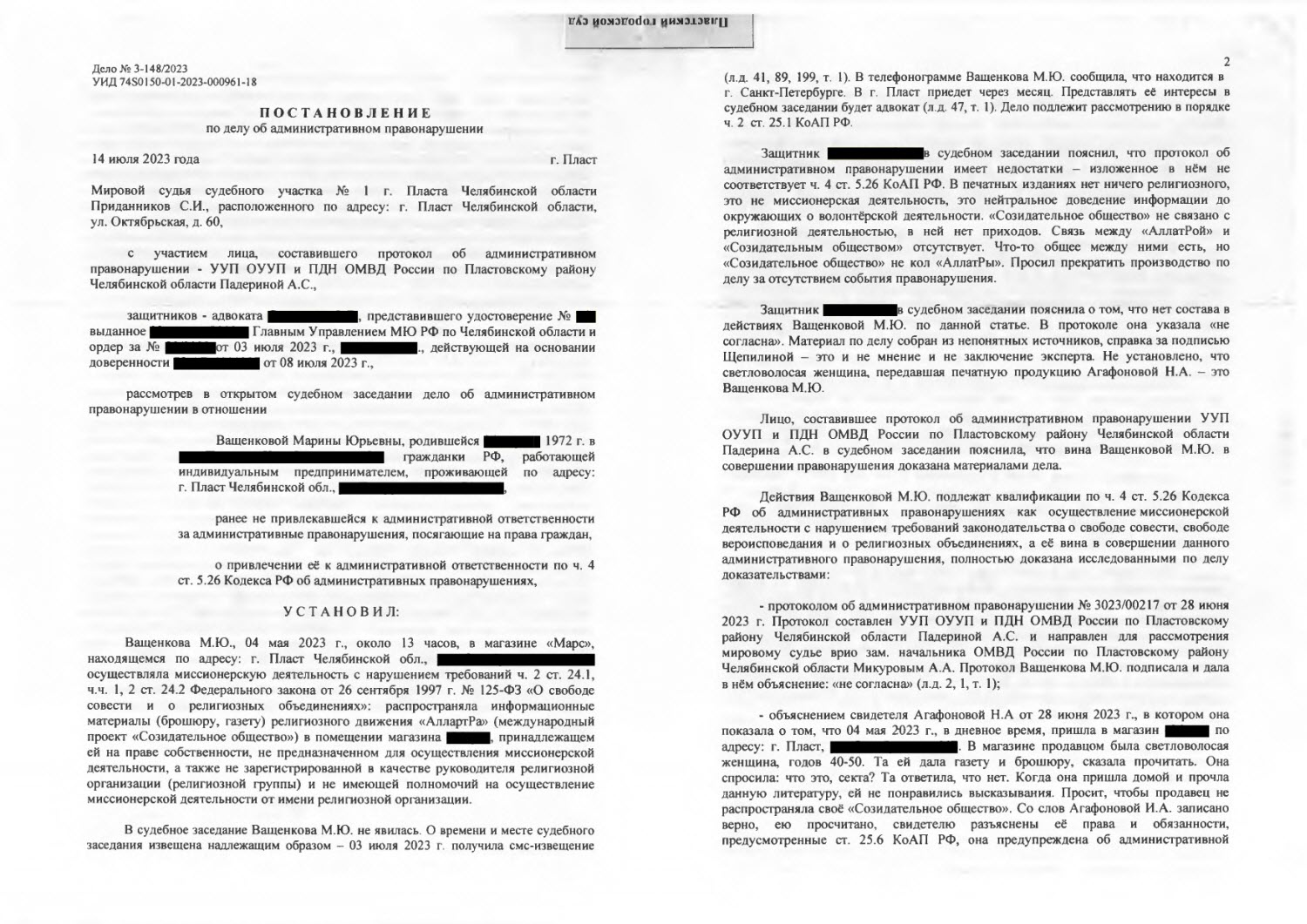
Photo 1: Court ruling on the administrative offense case, dated July 14, 2023, against M.Yu. Vashchenkova
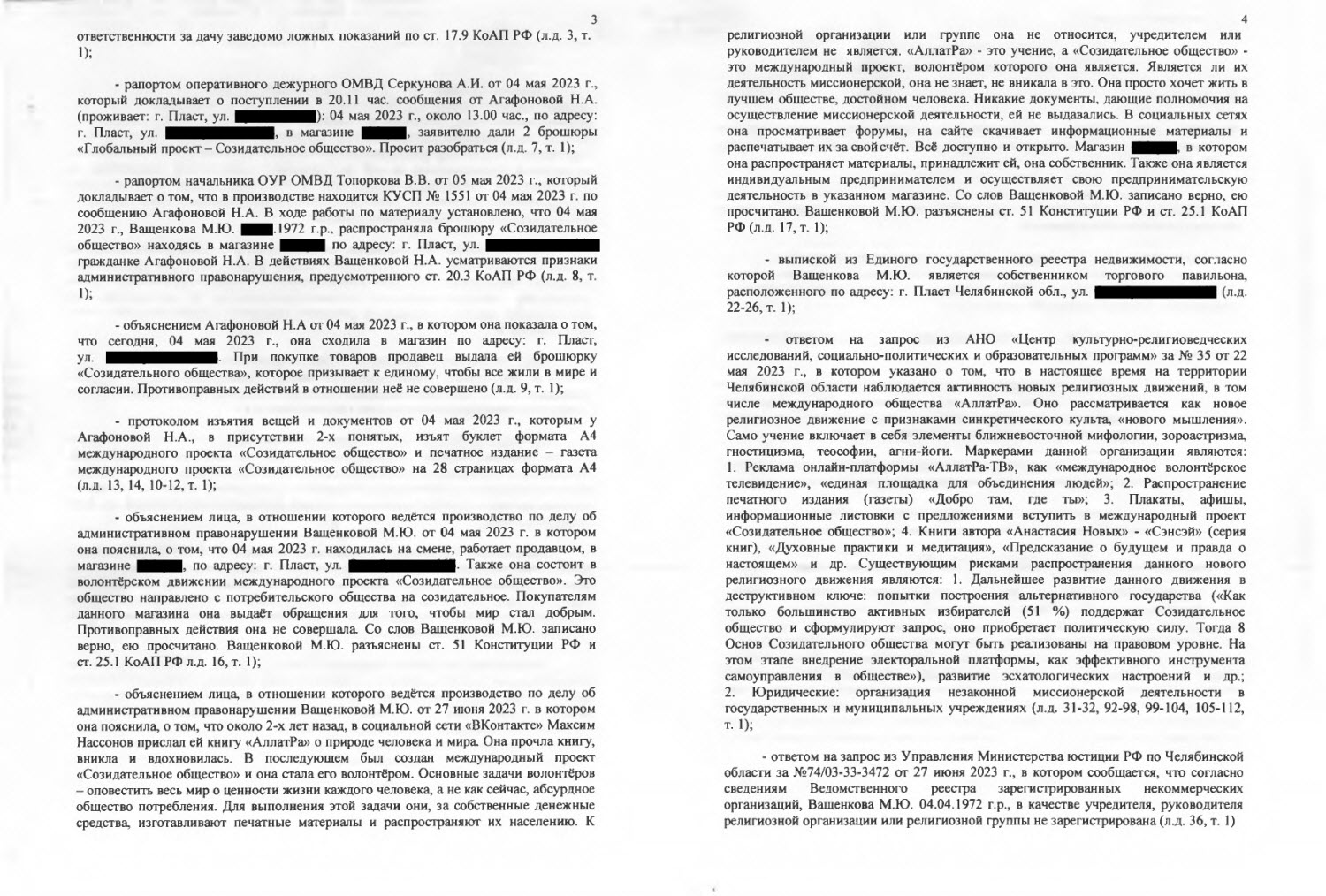
Photo 2: Court ruling on the administrative offense case, dated July 14, 2023, against M.Yu. Vashchenkova
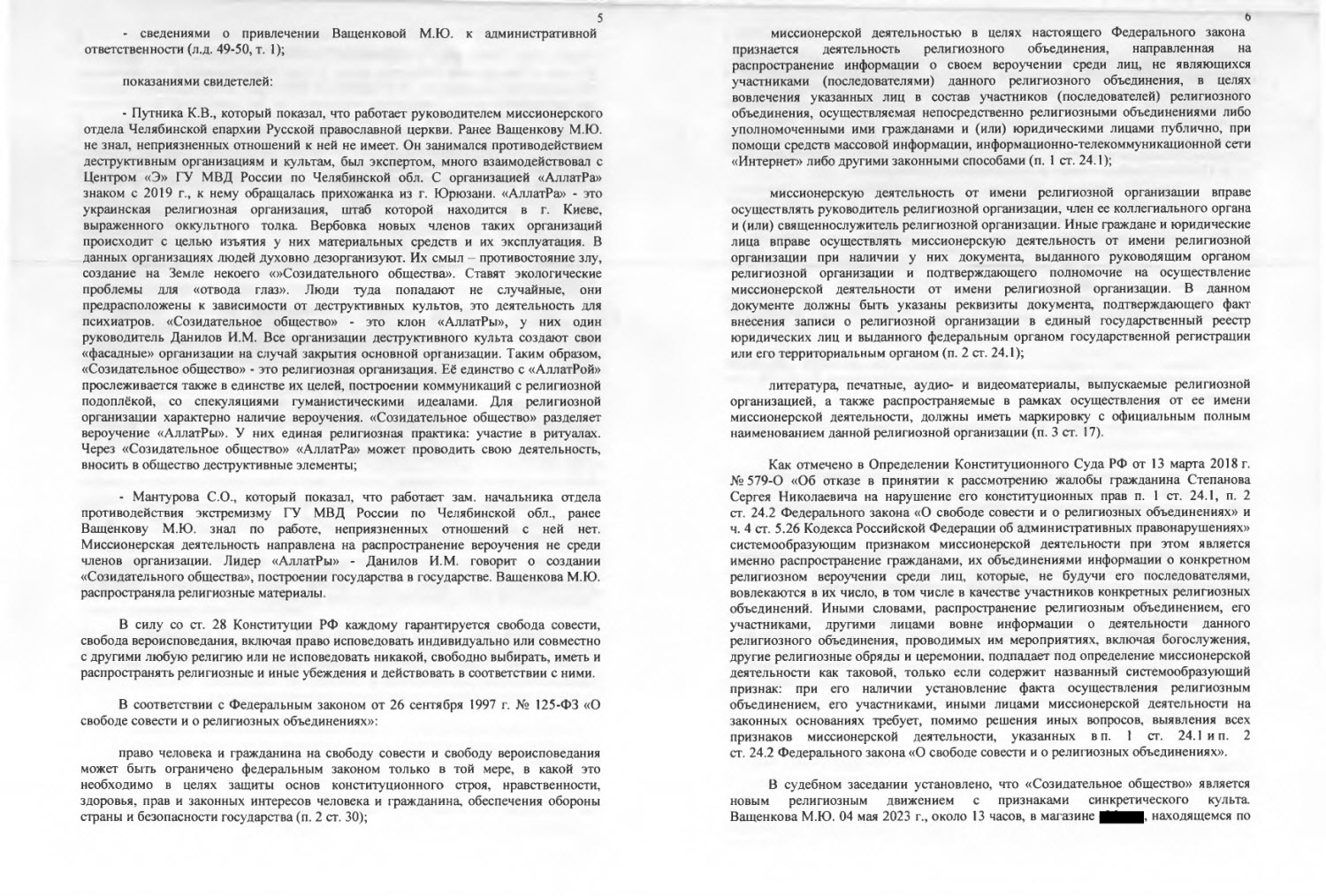
Photo 3: Court ruling on the administrative offense case, dated July 14, 2023, against M.Yu. Vashchenkova
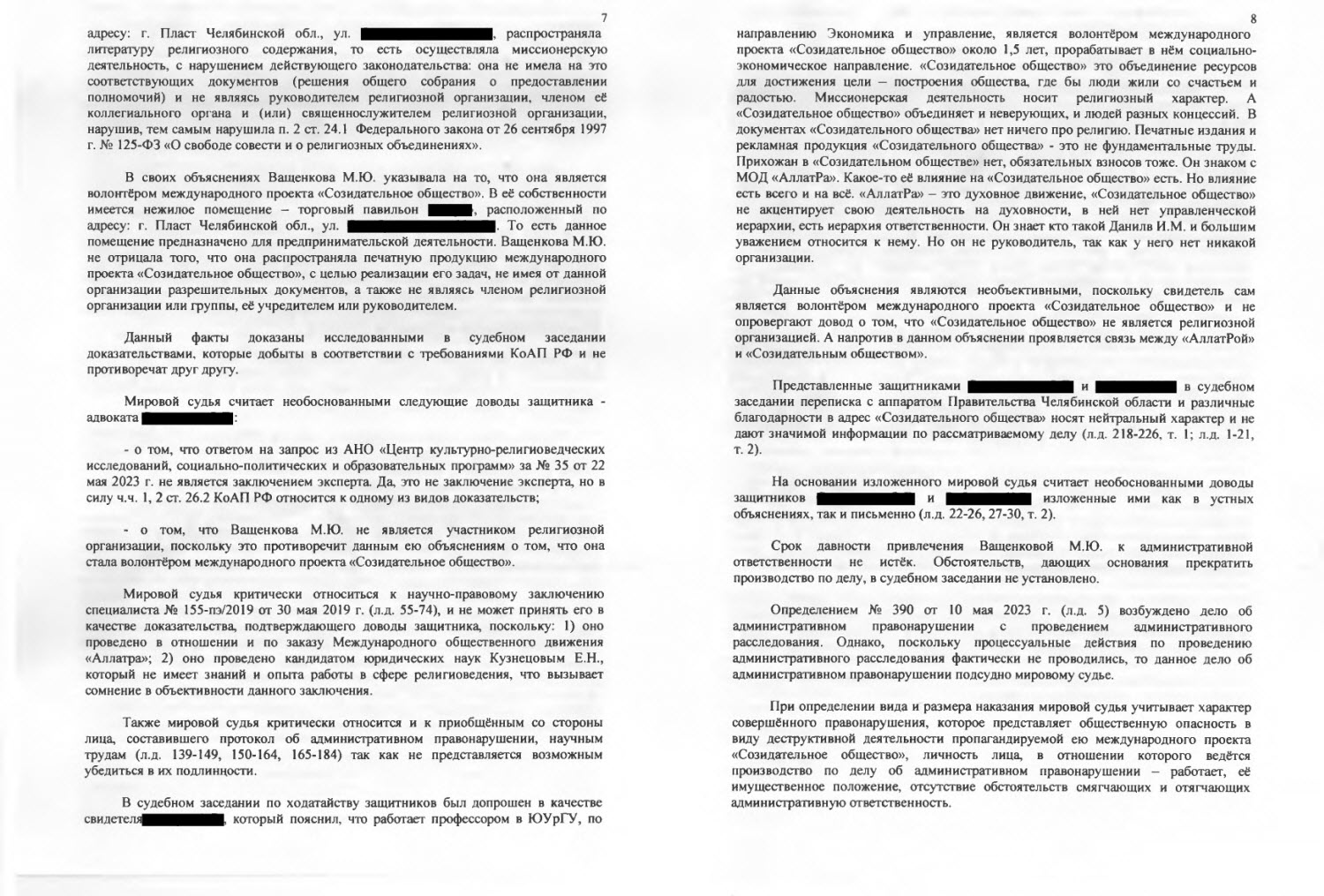
Photo 4: Court ruling on the administrative offense case, dated July 14, 2023, against M.Yu. Vashchenkova
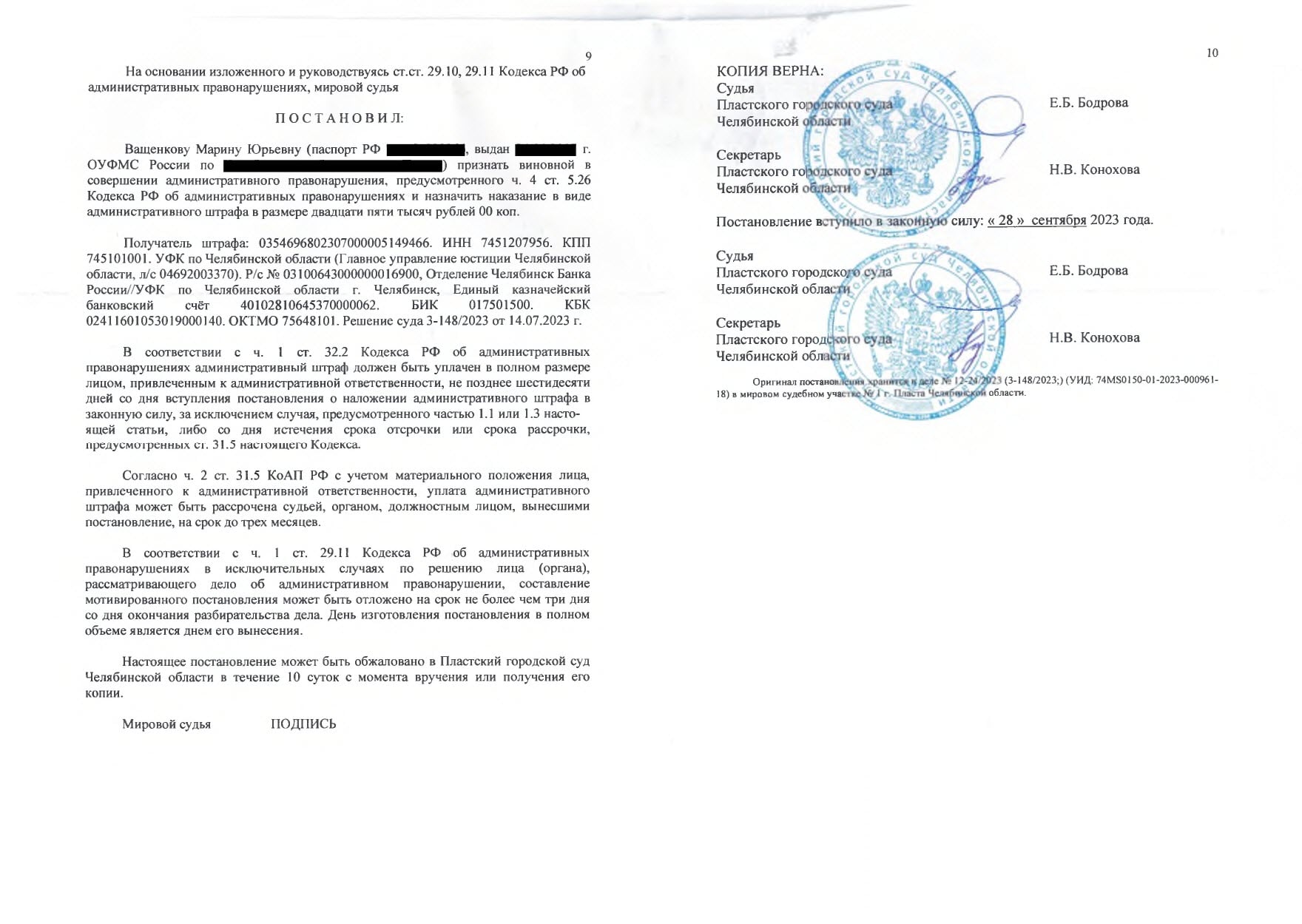
Photo 5: Court ruling on the administrative offense case, dated July 14, 2023, against M.Yu. Vashchenkova
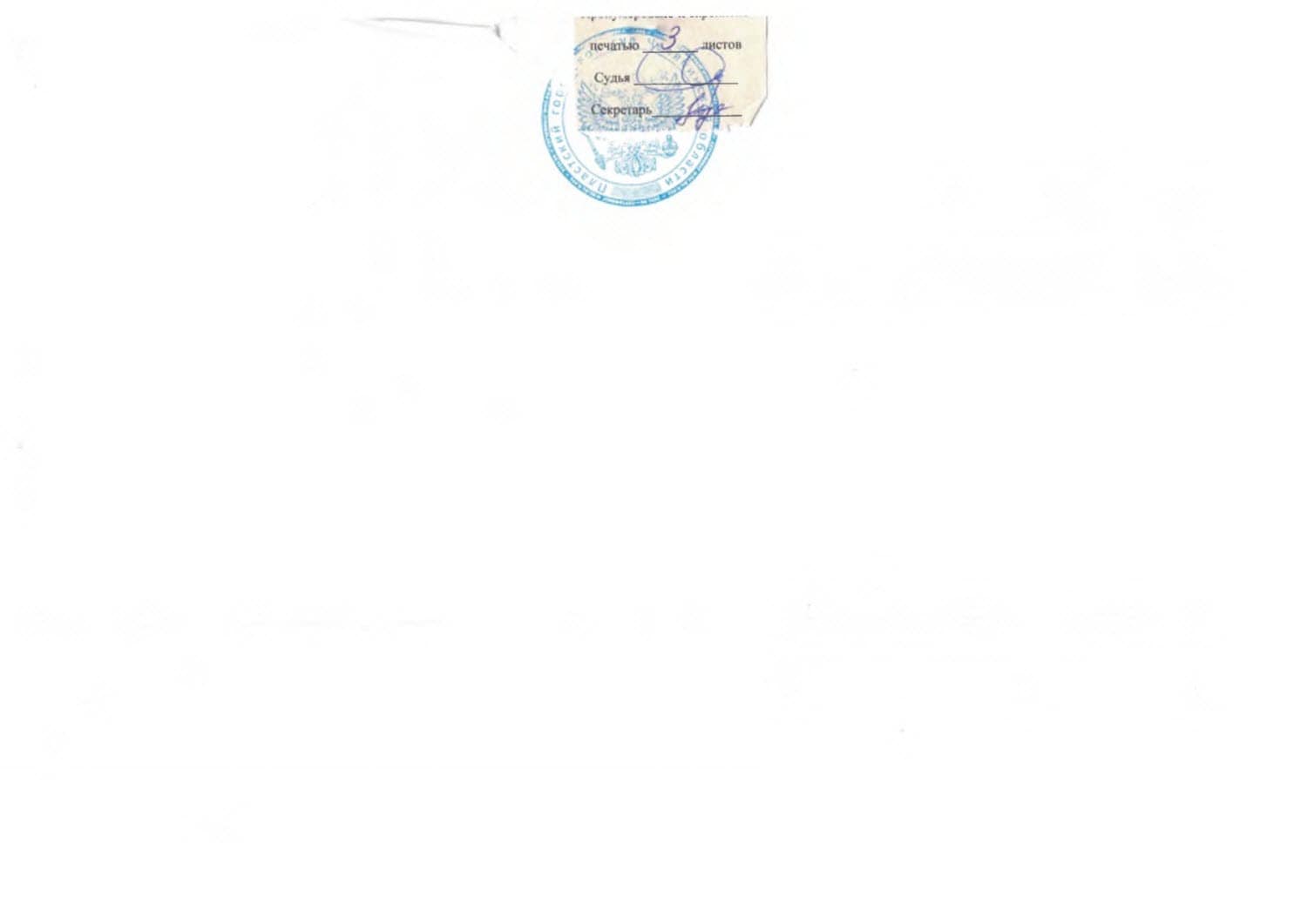
Photo 6: Court ruling on the administrative offense case, dated July 14, 2023, against M.Yu. Vashchenkova
HOWEVER, the above ruling is unlawful, unfounded, and violates the constitutional rights of M.Yu. Vashchenkova for the following reasons. In holding M.Yu. Vashchenkova administratively liable under the cited article, the justice of the peace based his decision on the allegation outlined in administrative offense protocol No. 3023/000217, dated June 28, 2023, that she was ALLEGEDLY engaged in missionary activity in violation of laws on freedom of conscience, freedom of religion, and religious associations.
According to paragraph 1, Article 6 of Federal Law No. 125-FZ of September 26, 1997 “On Freedom of Conscience and on Religious Associations,” a religious association in the Russian Federation is defined as activity carried out by a religious association and aimed at disseminating information about its religious doctrine among persons who are not participants (followers) of that religious association, for the purpose of involving such persons in the religious association of participants (followers). Such activity may be carried out by religious associations themselves or by individuals and/or legal entities authorized by such associations, publicly through mass media, the information and telecommunications network Internet, or by other lawful means.
Paragraph 1, Article 6 of the same law defines a religious association in the Russian Federation as a voluntary union of Russian citizens or other persons lawfully and permanently residing in the country, which is established for jointly professing and spreading faith and possesses characteristics consistent with that purpose, including:
- a religious doctrine;
- conducting worship services and other religious rites and ceremonies;
- teaching religion and providing religious instruction to its followers.
Paragraph 2, Article 6 of the Federal Law No. 125-FZ of September 26, 1997 “On Freedom of Conscience and on Religious Associations” states that religious associations may take the form of either religious groups or religious organizations.
It is important to emphasize that neither ALLATRA International Public Movement nor its partner project Creative Society are religious organizations or groups. They do NOT promote any religious religious, and their activities are NOT aimed at involving individuals in any religious association. ALLATRA IPM is not a religious organization either in form (its legal status is that of a public movement) or in purpose (its goals and objectives, as defined in its Charter, differ fundamentally from those of a religious association).
Specifically, ALLATRA IPM Charter states:
- goals and objectives: formation of qualitatively new relations between peoples, based on kindness, selfless mutual assistance, and creative interaction among people all over the globe, regardless of their place of residence, social, national, political, or religious affiliation (Clause 2.2.1 of ALLATRA IPM Charter);
- restoration of justice, order, and wellbeing in all spheres of human activity (Clause 2.2.2 of ALLATRA IPM Charter);
- creation of a happy, peaceful, and free world community (Clause 2.2.3 of ALLATRA IPM Charter);
- implementation of natural human freedoms and rights (Clause 2.2.4 of ALLATRA IPM Charter);
- creation of conditions for uniting peoples of the world on a spiritual basis, on the basis of friendship and mutual assistance (Clause 2.3.1 of ALLATRA IPM Charter);
- organization of interaction between peoples of the world to improve the wellbeing of the global community (Clause 2.3.2 of ALLATRA IPM Charter);
- creation of conditions for spiritual, cultural, moral, intellectual, and creative self-improvement of every individual and the global society as a whole (Clause 2.3.4 of ALLATRA IPM Charter);
- assistance to scientific and social progress (Clause 2.3.5 of ALLATRA IPM Charter).
Creative Society is an international initiative that voluntarily brings together people from more than 180 countries. Its goal is to transition — lawfully, peacefully, and as quickly as possible — to a new, constructive societal format worldwide, where human life would be of the highest value.
Both ALLATRA International Public Movement and the Creative Society project are built on principles of voluntary participation and openness. Their members are exclusively volunteers who adhere to a wide range of religious beliefs, including Christianity, Islam, Judaism, Hinduism, Buddhism, and others, as well as individuals who do not affiliate with any religion, including atheists. This clearly indicates the absence of any religious dominance or alignment with any specific religious tradition in the activities of the two associations, which in turn rules out the presence of any religious component in their structure or purpose.
Actions of a Group of Individuals (A.I. Serkunov, S.S. Kartsev, V.V. Toporkov, A.S. Paderina, A.A. Mikurov, A.A. Asadullin, Ye.V. Ospinnikov, S.O. Manturov, I.V. Yelesin, S.I. Pridannikov, K.V. Putnik, Ye.V. Shchetinina) Who Acted Within the Framework of a Premeditated Criminal Collusion and Under the Direction of RACIRS, to Fabricate Grounds for Recognizing ALLATRA International Public Movement and Its Partner Project Creative Society as a Single Religious Association
Statement by the Defendant M.Yu. Vashchenkova in the Administrative Offense Case No. 3-148/2023 considered by Justice of the Peace S.I. Pridannikov, Judicial District No. 1 of Plast, Chelyabinsk Region:
“On May 4, 2023, I was closing my owned store ‘****,’ located in Plast, Chelyabinsk Region. It was around 8:30 p.m. A man in a police uniform approached me; he didn’t introduce himself. I asked him, ‘What do you want?’ He replied that a complaint had been called in to the police alleging that I was distributing leaflets. I told him I didn’t distribute leaflets, but there were booklets about the Creative Society project lying on the desk in my store, and that I sometimes delicately tell visitors about the project, and if they show interest, I offer them a booklet to read, which is freely available on the desk. As I explained this to the man in uniform, he was writing it down on a statement form which he then gave me to sign. I signed it. He did not provide me with a copy. I just signed it and went home.
In the morning of June 27, 2023, I received a call on my mobile phone from a man who introduced himself as police chief Asadullin. He asked me to visit him that afternoon for a conversation at the Plast District Department of Internal Affairs. Suspecting nothing, I came there, assuming he needed clarification about something. But he took advantage of my lack of legal knowledge and didn’t explain my rights to me. We spoke for over an hour about the Creative Society. He asked me about ALLATRA. I told him I had taken a passing interest in ALLATRA, but explained that ALLATRA and the Creative Society project are not connected. The Creative Society project is simply an idea of ordinary people who want to make life better. However, not everything I said was reflected in the explanation Asadullin wrote down. I didn’t know he was drafting an official document. He was typing my answers into his computer. There were a lot of questions, but when he printed the document and asked me to sign it, I noticed that many of my responses had been taken out of context: there was no full account of his questions and my answers. He told me I had to sign the document he had prepared. So I did. Only afterwards did he inform me that my statement might be submitted to the court. I said, ‘How come? Are you serious? How is that even possible? What did I violate?’
The next day, the same police chief Asadullin called again and asked me to come to his office again. I told him, ‘I’m at work, I cannot come.’ He replied, ‘Fine, we’ll come to your workplace.’ I agreed. Then chief Asadullin and police officer Angelina Paderina came to my store and brought a protocol of administrative offense. I started reading the contents and told them, ‘You’re violating my constitutional right to distribute any information through lawful means.’ After that, the conversation from these officers became very harsh and rude towards me. When I read what was written in the record, I was outraged. Ultimately, I stated that I disagreed, that I did not consider myself an offender, and I refused to sign the record.
Additionally, I’d like to report that I learned that N. Agafonova complained about me only after the case had already been submitted to the court. We live in a very small town, and we all know each other. I know all my customers. But on May 4, 2023, citizen N. Agafonova did not visit my store.”
Violation by Justice of the Peace S.I. Pridannikov of the Mandatory Procedure for Preparing Hearings in the Administrative Offense Case
Article 24.1 of the CAO RF stipulates that the objectives of proceedings in administrative offense cases are comprehensive, complete, objective, and timely clarification of the circumstances of each case, its resolution in accordance with the law, enforcement of the issued ruling, as well as identification of causes and conditions that contributed to the commission of administrative offenses. Pursuant to Part 1 of Article 1.6 of the CAO RF, ensuring legality in the application of administrative coercive measures requires not only the existence of legal grounds for imposing administrative penalties, but also adherence to the legally prescribed procedure for holding an individual administratively liable.
In order to fulfill the objectives set forth in Article 24.1 of the CAO RF, when preparing an administrative offense case hearings, a judge must undertake procedural actions listed in Article 29.1 of the CAO RF (Section 2 of the Resolution No. 5 of the Plenum of the Russian Federation Supreme Court, dated March 24, 2005, “About some questions arising at courts in case of application of the Russian Federation Code of Administrative Offenses”). According to paragraph 5, Part 1, Article 29.1 of the CAO RF, those actions include resolving the question of whether materials available in the case are sufficient for consideration on the merits. If the materials submitted are insufficient, the judge must issue a ruling under Part 1 of Article 29.4 of the CAO RF, requesting the necessary additional materials.
In preparing this particular case for consideration, justice of the peace S.I. Pridannikov violated subparagraphs 3, 4, and 5 of Article 29.1 of the CAO RF which require the judge to determine whether the administrative offense protocol and other procedural documents have been correctly compiled in accordance with the CAO RF, whether other documents are properly executed, whether they are sufficient to consider the case on its merits, and whether there are any circumstances precluding the proceedings.
Despite identifying numerous violations committed by officials of the Russian Ministry of Internal Affairs for the Chelyabinsk Region when compiling the inspection materials and carrying out administrative proceedings against M.Yu. Vashchenkova, Justice of the Peace S.I. Pridannikov failed to perform the mandatory procedural action of returning the case materials to the Department of the MIA of Russia for the Chelyabinsk Region for correction of deficiencies. By failing to fulfill this obligation, Justice of the Peace S.I. Pridannikov himself violated provisions of the CAO RF. Furthermore, in breach of the CAO RF, Justice of the Peace S.I. Pridannikov took it upon himself to rectify the violations committed by MIA officers for the Chelyabinsk Region, thereby exceeding his official authority, which represents an act that constitutes grounds for criminal liability under Article 286 of the Criminal Code of the Russian Federation (hereinafter referred to as the CC RF). This unlawful conduct by Justice of the Peace S.I. Pridannikov led to him issuing a deliberately unjust court ruling against M.Yu. Vashchenkova, which in turn entails criminal liability for him under Article 305 of the CC RF.
Lack of Proper Grounds for Initiating Proceedings and Unverified Identity of the Alleged Victim
As follows from the materials in the administrative offense case No. 3-148/2023, on May 4, 2023, at 8:11 p.m., the Department of the MIA of Russia for the Plast District, Chelyabinsk Region received a report from Nina Alexandrovna Agafonova stating that on May 4, 2023, around 1:00 p.m., at the store “****” located at [redacted address], the complainant had been given two brochures titled “Global Project — Creative Society.” The police unit arrived at the scene at 8:25 p.m. on May 4, 2023 (Report by the duty officer of the duty unit of the Department of the MIA of Russia for the Plast District, Chelyabinsk Region, junior police lieutenant A.I. Serkunov, dated May 4, 2023) [Vol. 1, p. 7, Photo 7].
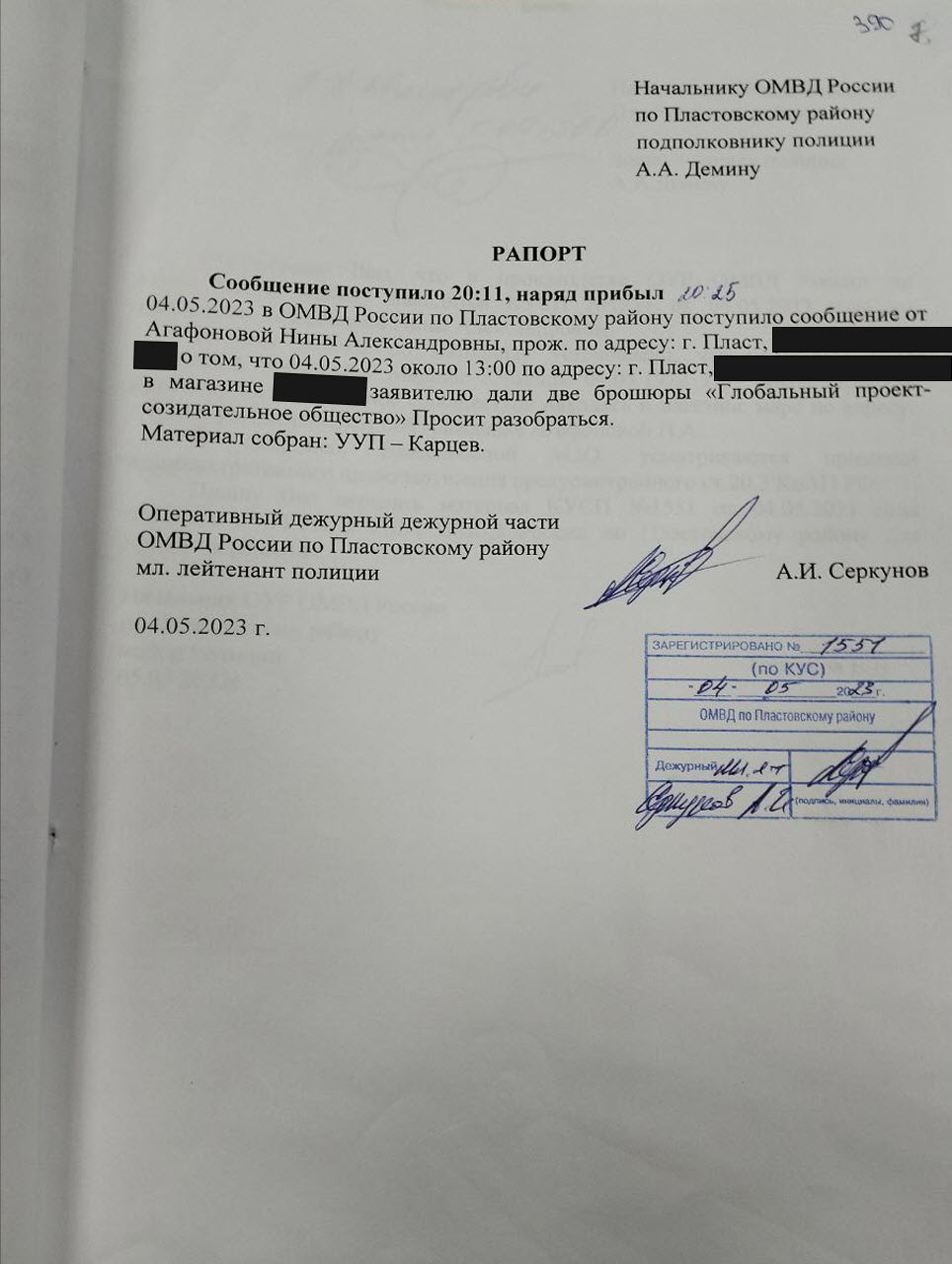
Photo 7: Report by the duty officer of the duty unit of the Department of the MIA of Russia for the Plast District, Chelyabinsk Region, junior police lieutenant A.I. Serkunov, dated May 4, 2023
This report is absurd. What exactly is N.A. Agafonova asking to investigate? Was she unsure of how to read the text: left to right or right to left? Was she unable to read it at all? Did the police fail to clarify the purpose of her complaint, or perhaps no such complaint ever occurred?
Thus, neither this report nor any other materials in the administrative case indicate how exactly the message from N.A. Agafonova was received, nor do they substantiate that M.Yu. Vashchenkova was disseminating information specifically about the doctrine of any religious association, or how that information was allegedly disseminated. Therefore, the contents of the complaint do not contain any ground for initiating an administrative case under Article 28.1 of the CAO RF.
Thus, the following deficiencies are evident in the report by the duty officer A.I. Serkunov, dated May 4, 2023 [Vol. 1, p. 7, Photo 7]:
- It does not specify how the message from N.A. Agafonova was submitted (by phone, in person, or by written statement).
- It does not cite any characteristics of an administrative offense or any facts suggesting one occurred.
- The report notes that the message was received at 8:11 p.m. and that the unit arrived at 8:25 p.m. Upon receiving the message, the duty officer dispatched a unit to investigate the complaint and facts that do not indicate the occurrence of any offense. The only information recorded is that at 1:00 p.m. N.A. Agafonova received two brochures titled “Global Project — Creative Society” in the store. Nothing in this account suggests any unlawful act. Not only does the report lack any indication of an offense, but the remarkably swift response from the Plast police is also suspicious. Just 14 minutes elapsed between receiving the message and the police unit arriving at the location of the alleged offense. Apparently, in the Plast District of Chelyabinsk Region, all criminals and violators have already been apprehended, leaving the police with nothing to do but fabricate cases against completely innocent individuals.
Moreover, during proceedings in the court of first instance, the case materials did not properly confirm the existence of such an individual as Nina Alexandrovna Agafonova born in 1947: there are no passport details or any other identity documents provided. According to the Decree of the Russian Federation President, No. 232 dated March 13, 1997, “On the Primary Document Certifying the Identity of a Citizen of the Russian Federation in the Territory of the Russian Federation,” the primary identity document is the passport. Hence, law enforcement authorities in the city of Plast, Chelyabinsk Region, failed to establish the identity of N.A. Agafonova, the alleged victim in the case, which is an obvious procedural violation on the part of the police. Nevertheless, Justice of the Peace S.I. Pridannikov failed to acknowledge this violation.
Violations During the Seizure of Printed Materials and Legal Inadmissibility of the Evidence Obtained
The protocols and statements compiled during the proceedings were drawn up with gross violations of the provisions of the CAO RF and were thus unreasonably accepted as evidence of M.Yu. Vashchenkova’s guilt by the justice of the peace.
In particular, on May 4, 2023, without specifying the time, a protocol of seizure of items and documents was drawn up by junior police lieutenant S.S. Kartsev, precinct police officer of OUUP and PDN of the Department of the MIA of Russia for the Plast District, Chelyabinsk Region. The protocol alleges participation of Nina Alexandrovna Agafonova born on ** **, 1947, but was executed in the absence of M.Yu. Vashchenkova, in office No. 5 of the Department of the MIA of Russia for the Plast District at 58 Oktyabrskaya St., Plast [Vol. 1, p. 13, Photo 8].
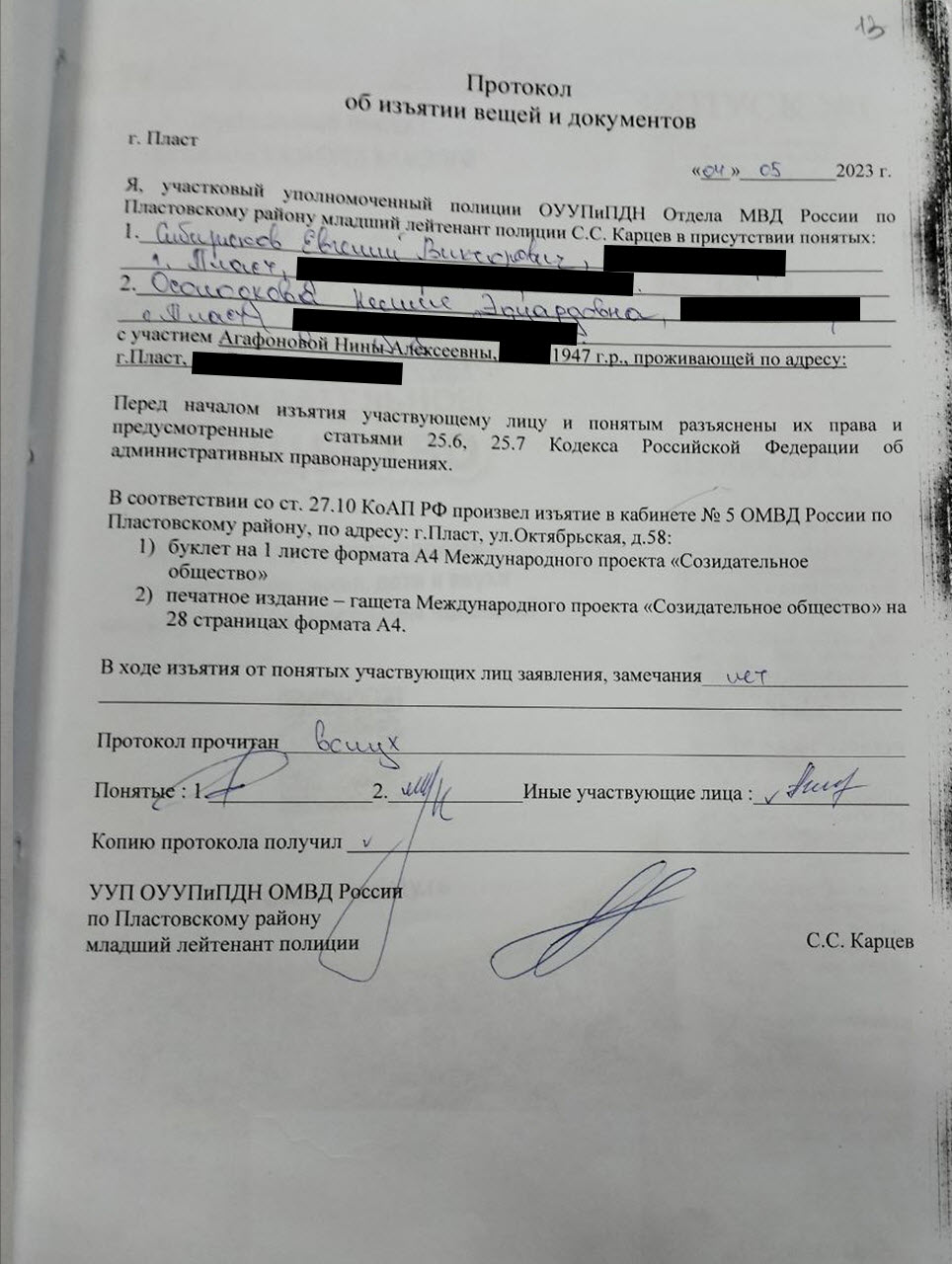
Photo 8: Protocol of seizure of items and documents, dated May 4, 2023, drawn up by junior police lieutenant S.S. Kartsev, precinct police officer of OUUP and PDN of the Department of the MIA of Russia for the Plast District, Chelyabinsk Region
This seizure protocol violates subparagraphs 6–9 of Article 27.10 of the CAO RF, as it lacks:
- The identity of the person from whom the items and documents were seized (it is unclear whether the junior lieutenant seized the items from himself, from witnesses, or simply found them on the floor);
- Details of identity documents of N.A. Agafonova and the witnesses;
- Details of the seized documents and other identifying characteristics of the items;
- A note on the use of photography as a means of documentation (all seized documents should have been photographed page-by-page), even though the protocol includes photographs of the seized items (violation of paragraph 7 of Article 27.10 of the CAO RF;
- Information on packaging and sealing of documents at the place of seizure.
The protocol indicates that the seizure occurred in the office of the Department of the MIA of Russia for the Plast District, Chelyabinsk Region, although such a seizure could have only taken place either at M.Yu. Vashchenkova’s store or during an examination of N.A. Agafonova’s belongings. However, the protocol contains no mention of an examination of N.A. Agafonova’s belongings, again in violation of Article 27.10 of the CAO RF.
The seizure could not have occurred in the office of the Department of the MIA of Russia for the Plast District, Chelyabinsk Region earlier than 9.00 p.m., since S.S. Kartsev arrived at the scene at 8:25 p.m. and was still recording M.Yu. Vashchenkova’s statement, which likely took at least half an hour. This gives grounds to believe that N.A. Agafonova was not actually present during the seizure, given her age of 76 years old (as inferred from the birth year provided, though neither identity document nor she personally were present) and the fact that she never appeared in court, allegedly due to poor health.
Given that the seizure protocol fails to specify the individual from whom the items and documents were confiscated (whether from the witnesses or another person present during the procedural action), and that this person did not sign the protocol and there is no confirmation that they or their legal representative were provided a copy of it (the line “I received a copy of the protocol” contains no signature), the officer merely documented the seizure not from a specific individual, but from the location — the office — into which, apparently, he had placed the materials himself.
The personal details of N.A. Agafonova were typed into the protocol, while the data for the two attesting witnesses were handwritten in full. This raises grounds to believe the witnesses were not present during the seizure (in violation of Article 27.10 of the CAO RF).
Thus, the protocol does not certify the seizure of materials from either M.Yu. Vashchenkova or N.A. Agafonova. The materials attached to the case cannot be regarded as physical evidence because their origin is unclear. The seizure protocol was drawn up with gross violations of the CAO RF and cannot be considered admissible evidence in the case.
It is also noteworthy that the protocol lists as confiscated: a one-page A4 booklet and a printed publication — “gaSHeta” (not gaZeta [i.e. newspaper, Translator’s note]) of the Creative Society international project, consisting of 28 A4 pages [Vol. 1, p. 13, Photo 8]. In cases of typographical or clerical errors, a specific correction procedure must be followed: a note must be made in the same procedural document about the correction and signed by the official, which was not done in this case.
These violations indicate a potential offense under Article 303 of the CC RF (Falsification of Evidence and Results of Operational and Search Activities) in the actions of precinct police officer S.S. Kartsev.
However, the printed materials described in the seizure protocol were not presented to the court and were therefore not examined as direct evidence of the alleged offense. As a result, no evaluation of this evidence was provided in the ruling issued on July 14, 2023, by justice of the peace S.I. Pridannikov, Judicial District No. 1 of Plast, Chelyabinsk Region, who found M.Yu. Vashchenkova administratively liable under Part 4 of Article 5.26 of the CAO RF.
The case materials include a package containing printed materials, including the Creative Society booklet [Vol. 1, p. 14, Photos 9-10].
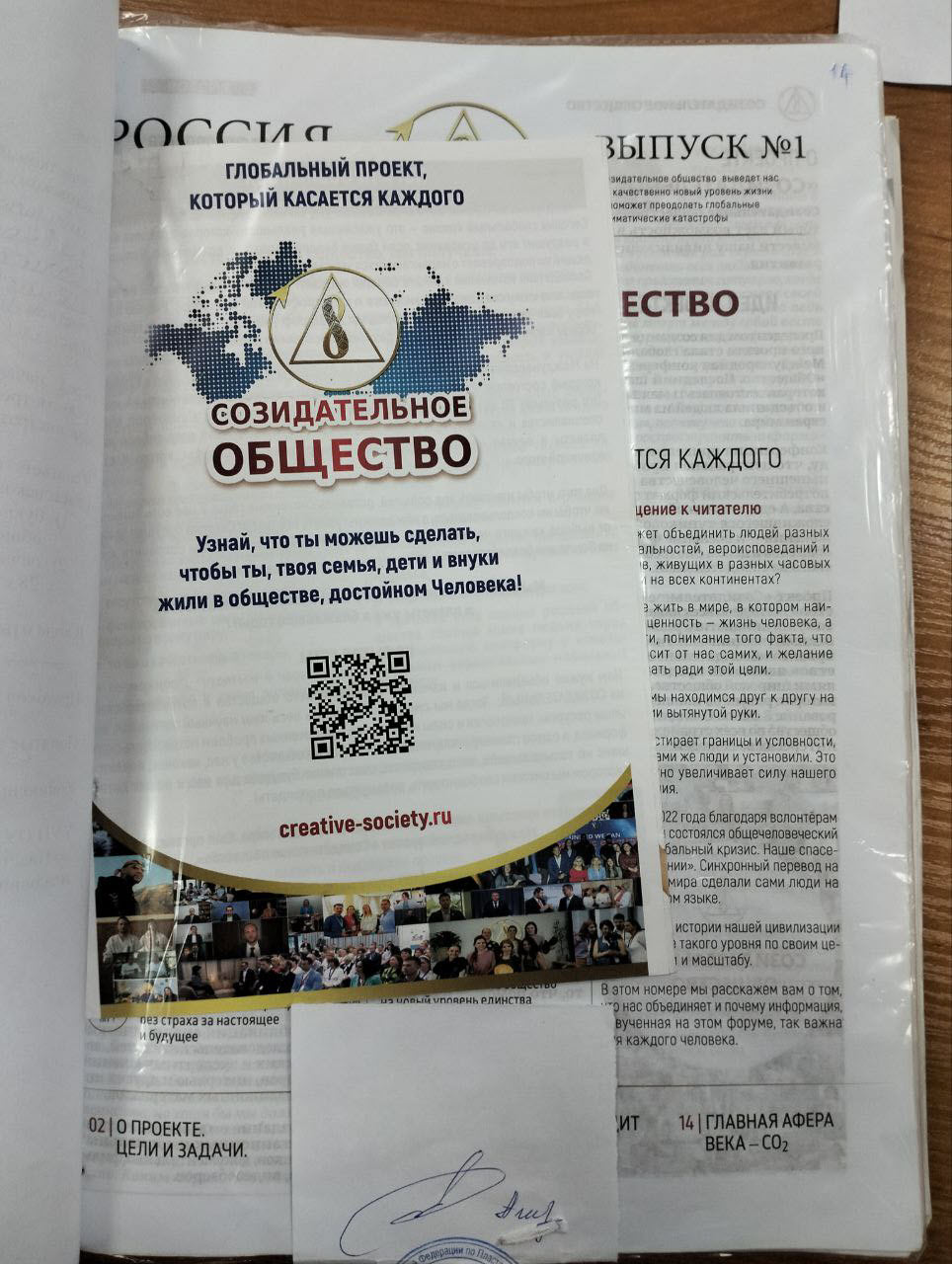
Photo 9: Creative Society booklet, part 1
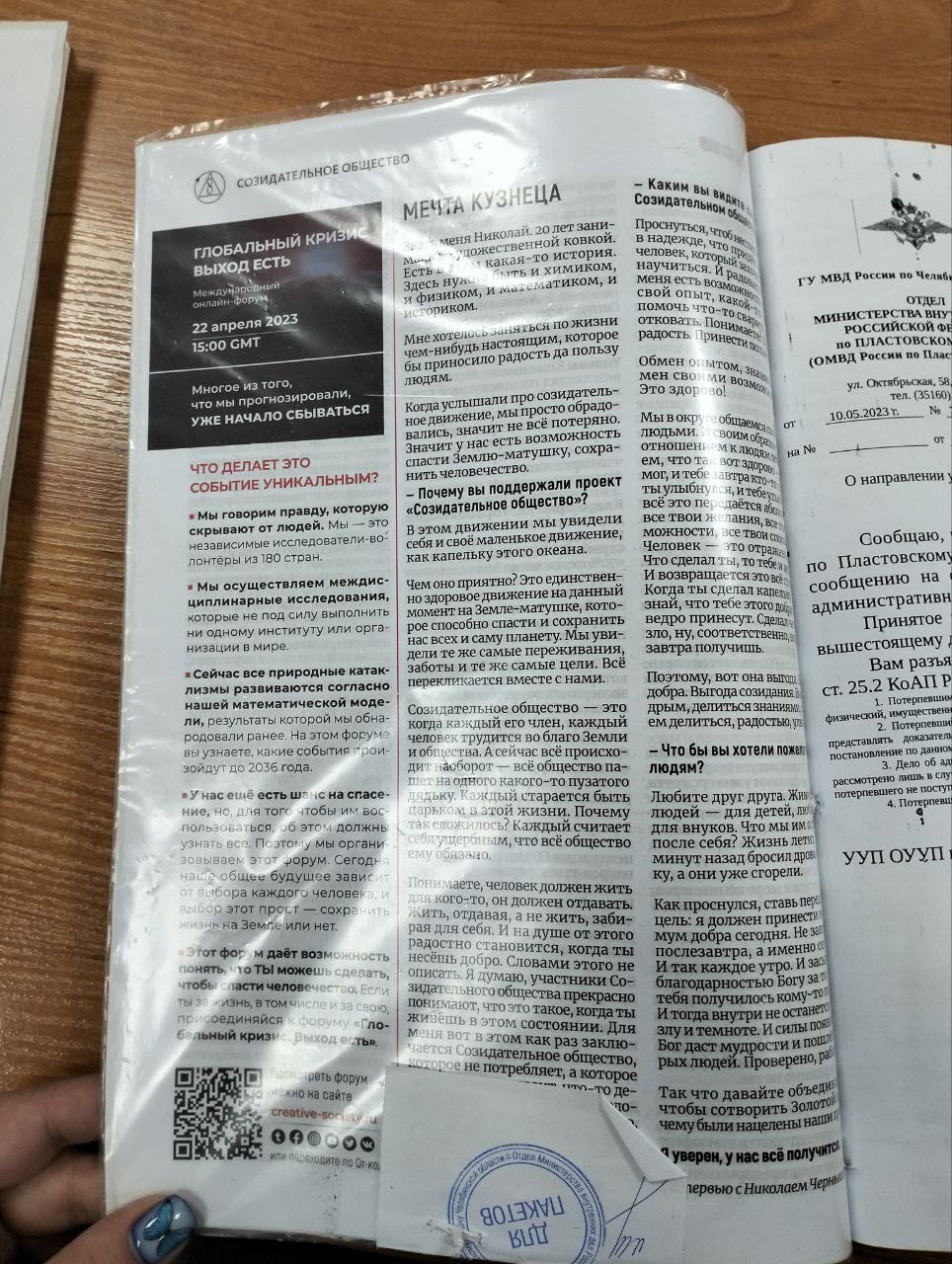
Photo 10: Creative Society booklet, part 2
However, during the court proceedings in the first instance, these printed materials were not examined by Justice of the Peace S.I. Pridannikov. The package containing the alleged items of offense was not even opened by the judge for examination. Consequently, the legally required assessment of the admissibility, relevance, and credibility of this evidence was not conducted by the judge, and no evaluation of such evidence was given.
Moreover, in N.A. Agafonova’s initial statement dated May 4, 2023, there is no mention of her receiving any newspaper (gaSHeta) or leaflet from M.Yu. Vashchenkova. She only refers to a booklet [Vol. 1, p. 9, Photos 11-12].
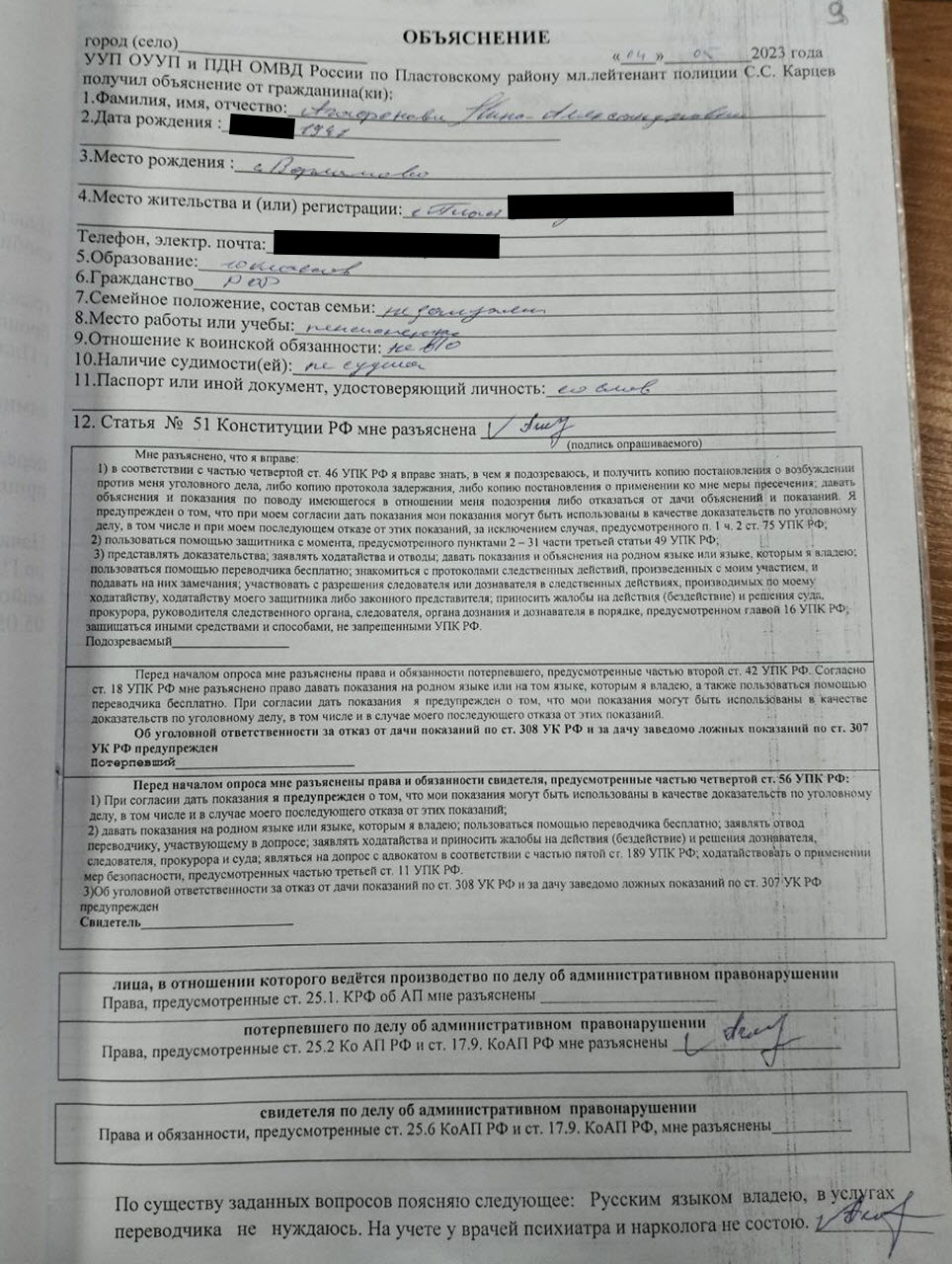
Photo 11: Statement by N.A. Agafonova, part 1
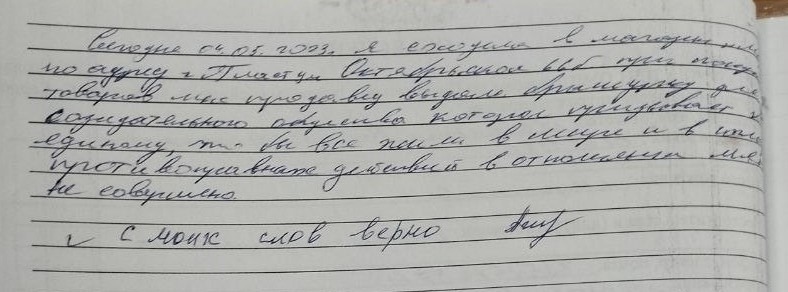
Photo 12: Statement by N.A. Agafonova, part 2
The above indicates that the means of committing the administrative offense were not established in the case materials.
This raises a question: what is the connection between Vashchenkova → printed materials → Agafonova? NO such connection was established.
Thus, the factual circumstances and evidence that would confirm the occurrence of an offense are absent in the case files.
Introduction of New Information in the Report, Not Supported by Previously Collected Materials
In the report on the transfer of materials to OUUP and PDN of the Department of the MIA of Russia for the Plast District, Chelyabinsk Region, dated May 5, 2023, authored by V.V. Toporkov, head of the Criminal Investigation Unit of the Department of the MIA of Russia for the Plast District, Chelyabinsk Region [Vol. 1, p. 8, Photo 13], it is stated that M.Yu. Vashchenkova’s actions show signs of an administrative offense under Article 20.3 of the CAO RF. This article covers propaganda or public display of Nazi paraphernalia or symbols, or those of extremist organizations, or other paraphernalia or symbols whose propaganda or public display is prohibited by federal law. However, in the original documents — the report dated May 4, 2023, and the statements by M.Yu. Vashchenkova and N.A. Agafonova, dated May 4, 2023 — there is no mention of such actions by M.Yu. Vashchenkova whatsoever.
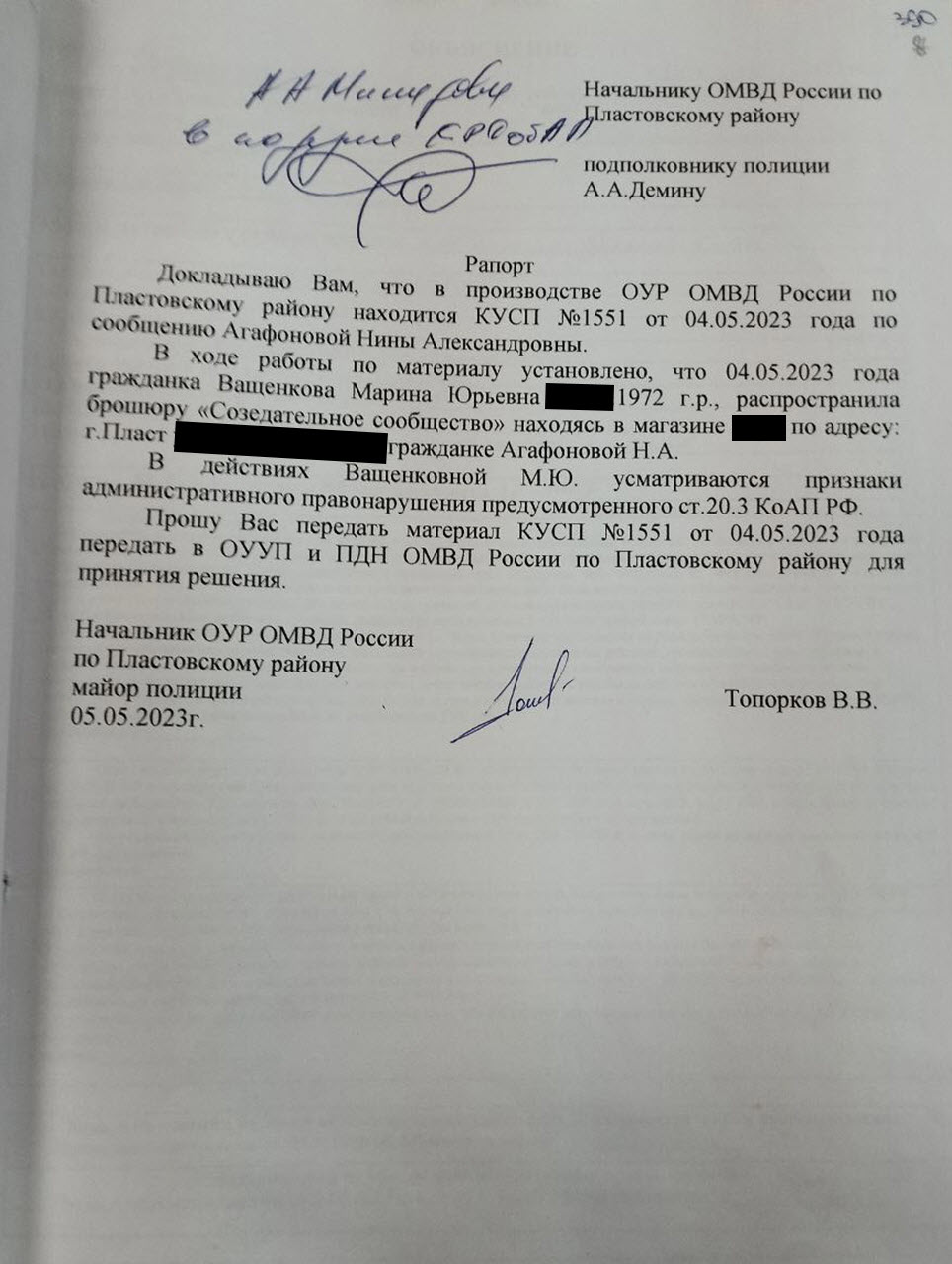
Photo 13: Report on the transfer of materials to OUUP and PDN of the Department of the MIA of Russia for the Plast District, Chelyabinsk Region, dated May 5, 2023, authored by V.V. Toporkov, head of the Criminal Investigation Unit of Department of the MIA of Russia for the Plast District, Chelyabinsk Region
Absence of Evidence of an Offense in N.A. Agafonova’s Statements
The statements made by N.A. Agafonova, first as a victim and later as a witness on May 4 and June 28, 2023, respectively, were also recorded by the police with gross procedural violations. As such, they carry no legal weight and cannot serve as evidence in the case under Part 3 of Article 26.2 of the CAO RF. For instance, N.A. Agafonova’s statement as a victim on May 4, 2023, allegedly recorded from her words, has not been signed by the official who recorded it, contains no indication of the time or place it was made, nor does it include passport or any other ID information certifying N.A. Agafonova’s identity [Vol. 1, p. 9, Photos 11-12].
In that statement, N.A. Agafonova declared: “Today, on May 4, 2023, I went to the store at the address: *********, Plast City. When I was buying goods, the saleswoman gave me a Creative Society brochure that called for unity and peaceful coexistence. No unlawful actions were committed against me.” It is particularly important to note that in this statement, N.A. Agafonova makes no reference to any offense being committed, nor does she perceive the content of the brochure as religious or associated with any belief system [Vol. 1, p. 9, reverse side, Photos 11-12].
Furthermore, N.A. Agafonova’s statement from May 4, 2023 [Vol. 1, p. 9, Photos 11-12] does not specify the LOCATION where it was made (which city or village, whether in a house, in the store, or at the police station, or perhaps even on another planet?). Moreover, in both N.A. Agafonova’s statements — from May 4, 2023 [Vol. 1, pp. 9, Photos 11-12] and June 28, 2023 [Vol. 1, pp. 16, Photos 21-22] — it is totally unclear who exactly was questioned. In particular, the first name and patronymic are illegible, and there is no signature of the official who conducted the interrogation.
Unlawful Initiation of the Case and the Fabricated Administrative Investigation Process
Nevertheless, on May 10, 2023, junior police lieutenant A.S. Paderina, precinct police officer of OUUP and PDN of the Department of the MIA of Russia for the Plast District, Chelyabinsk Region, issued a Ruling No. 390 to initiate an administrative offense case [Volume 1, p. 5, Photo 14] under Part 4, Article 5.26 of the CAO RF, “Implementation of missionary activities with violation of requirements of the legislation on liberty of conscience, religious liberty and about religious associations,” and to begin an administrative investigation to establish the circumstances and collect materials related to the alleged administrative offense, which was done with the following violations:
- There was no sufficient data to initiate an administrative offense case against M.Yu. Vashchenkova that would indicate the occurrence of an offense, which constitutes a violation of Part 3, Article 28.1 of the CAO RF. When issuing a Ruling No. 390 [Volume 1, p. 5, Photo 14], the statement made by N.A. Agafonova on May 4, 2023, wasn’t taken into account, where she wrote, “No unlawful actions were committed against me.” Given the absence of an offense, there were no legal grounds for initiating proceedings in the case (Article 24.5 of the CAO RF was violated). In other words, there were circumstances that precluded proceedings in the administrative offense case, i.e. allowed it to be terminated.
- Under paragraph 4, Part 4 of Article 28.1 of the CAO RF, the issuance of a decision to initiate the case was unlawful, as there was no necessity to conduct an administrative investigation under Article 28.7 of the CAO RF because offenses under Part 4 of Article 5.26 of the CAO RF do not provide for administrative investigation (according to Part 1 of Article 28.7 of the CAO RF). A case under Part 4 of Article 5.26 of the CAO RF, as charged against M.Yu. Vashchenkova, is considered initiated at the moment the administrative offense protocol is drawn up. In other words, the decision to initiate the case against M.Yu. Vashchenkova should not have been issued at all, and no investigation should have been launched, since the offense she was charged with under Article 5.26 of the CAO RF does not require investigation. Instead of a decision, only an administrative offense protocol should have been drawn up — a document which, according to the CAO RF, simultaneously serves as a procedural act marking the initiation of such a case. However, in violation of the CAO RF, A.S. Paderina prepared two procedural documents in relation to M.Yu. Vashchenkova: a decision to initiate the administrative case and an administrative offense protocol, while only the protocol should have been issued.
- The administrative investigation was unlawfully initiated. According to paragraph 2, subsection “a” of Section 3 of the Resolution No. 5 of the Plenum of the Supreme Court of the Russian Federation, dated March 24, 2005, “About some questions arising at courts in case of application of the Russian Federation Code of Administrative Offenses,” an administrative investigation is permitted only in cases involving administrative offenses in the fields of legislation listed in Part 1 of Article 28.7 of the CAO RF. The case category under consideration (Article 5.26 of the CAO RF, “Violation of the Laws on Freedom of Conscience and Freedom of Belief, as Well as on Religious Associations”) is not included in the specific list of administrative offenses provided by that article.
- Six days elapsed between the date the administrative offense was identified (May 4, 2023) and the date the Ruling No. 390 was issued (May 10, 2023), which violates Part 2 of Article 28.7 of the CAO RF. According to that provision, a decision to initiate an administrative offense case and to conduct an administrative investigation must be issued by an official authorized under Article 28.3 of the CAO RF to draw up an administrative offense protocol in the form of a ruling or by a prosecutor in the form of a decree, immediately after the administrative offense is identified.
- In paragraph 3 of the Ruling No. 390, it is stated: “A copy of the decision on the administrative offense shall be sent for review to the parties involved, with an explanation of their right to appeal against this decision. After identifying the individuals who caused the battery, a copy of the decision shall also be sent for review.” The title of the document referenced in this paragraph does not correspond with point 1 of the operative part. The descriptive part fails to specify what the violation consists in. Furthermore, the operative part of this decision provides an explanation of the right to appeal in connection with a different offense specified in Article 6.1.1 of the CAO RF (battery). In other words, the author of this decision made a gross error. The case was initiated under Part 4 of Article 5.26 of the CAO RF (illegal missionary activities), while the explanation of rights to the accused refers to Article 6.1.1 of the CAO RF (battery), which constitutes a severe violation. This means that, in violation of Part 3, Article 28.7 of the CAO RF, M.Yu. Vashchenkova was not informed of her right to appeal, rendering this piece of evidence inadmissible [Volume 1, p. 5, Photo 14]. Moreover, the document makes it impossible to determine who issued it — whether it was precinct police officer A.S. Paderina of the Department of the MIA of Russia for the Plast District or the deputy chief of public order police A.A. Mikurov of the same Department of the MIA of Russia for the Plast District, or both. (If A.A. Mikurov approved this procedural document, then why is the note “Approved” missing?)
- According to Part 3.1 of Article 28.7 of the CAO RF, a copy of the decision to conduct an administrative investigation must be delivered by hand with a signed acknowledgement or sent to the individual or the legal entity’s legal representative, as well as to the victim, within 24 hours. However, the case files lack any document confirming that the Ruling No. 390 was delivered to M.Yu. Vashchenkova within 24 hours or handed to her against signature. This violated M.Yu. Vashchenkova’s right to defense during the administrative proceedings and her right to appeal against the decision to initiate the case.
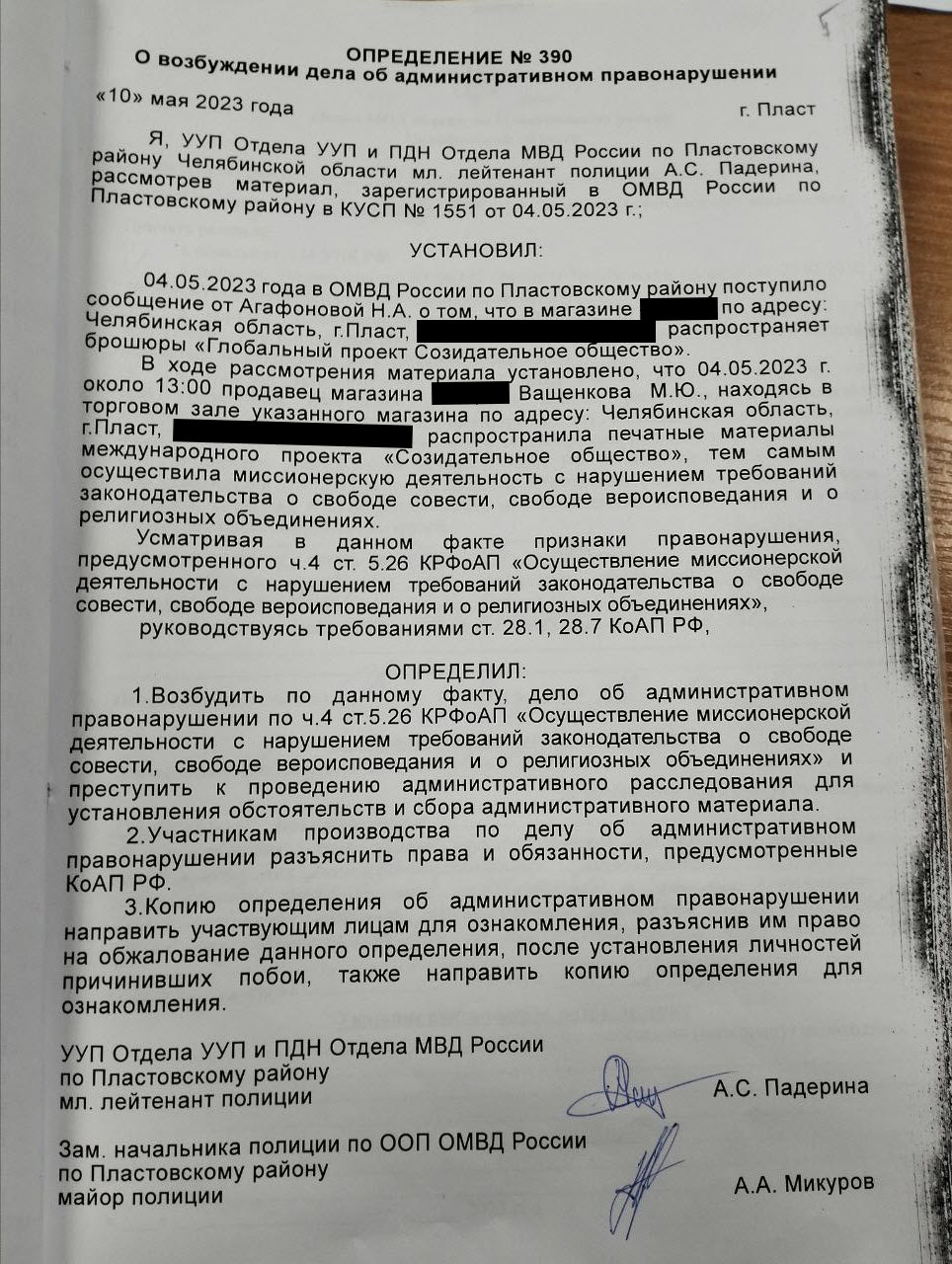
Photo 14: Ruling No. 390 dated May 10, 2023, on initiating administrative proceedings, issued by junior police lieutenant A.S. Paderina, precinct police officer of OUUP and PDN of the Department of the MIA of Russia for the Plast District, Chelyabinsk Region
Extension of Administrative Investigation in Violation of the Law and Without the Required Procedures
It is noteworthy that during the unlawful administrative investigation into the alleged administrative offense under Part 4 of Article 5.26 of the CAO RF, officials ALSO committed a number of serious procedural violations, which JP S.I. Pridannikov completely ignored:
On June 10, 2023, junior police lieutenant A.S. Paderina, precinct police officer of OUUP and PDN of the Department of the MIA of Russia for the Plast District, Chelyabinsk Region, issued a decision to extend the period of the administrative investigation [Volume 1, p. 4, Photo 15].
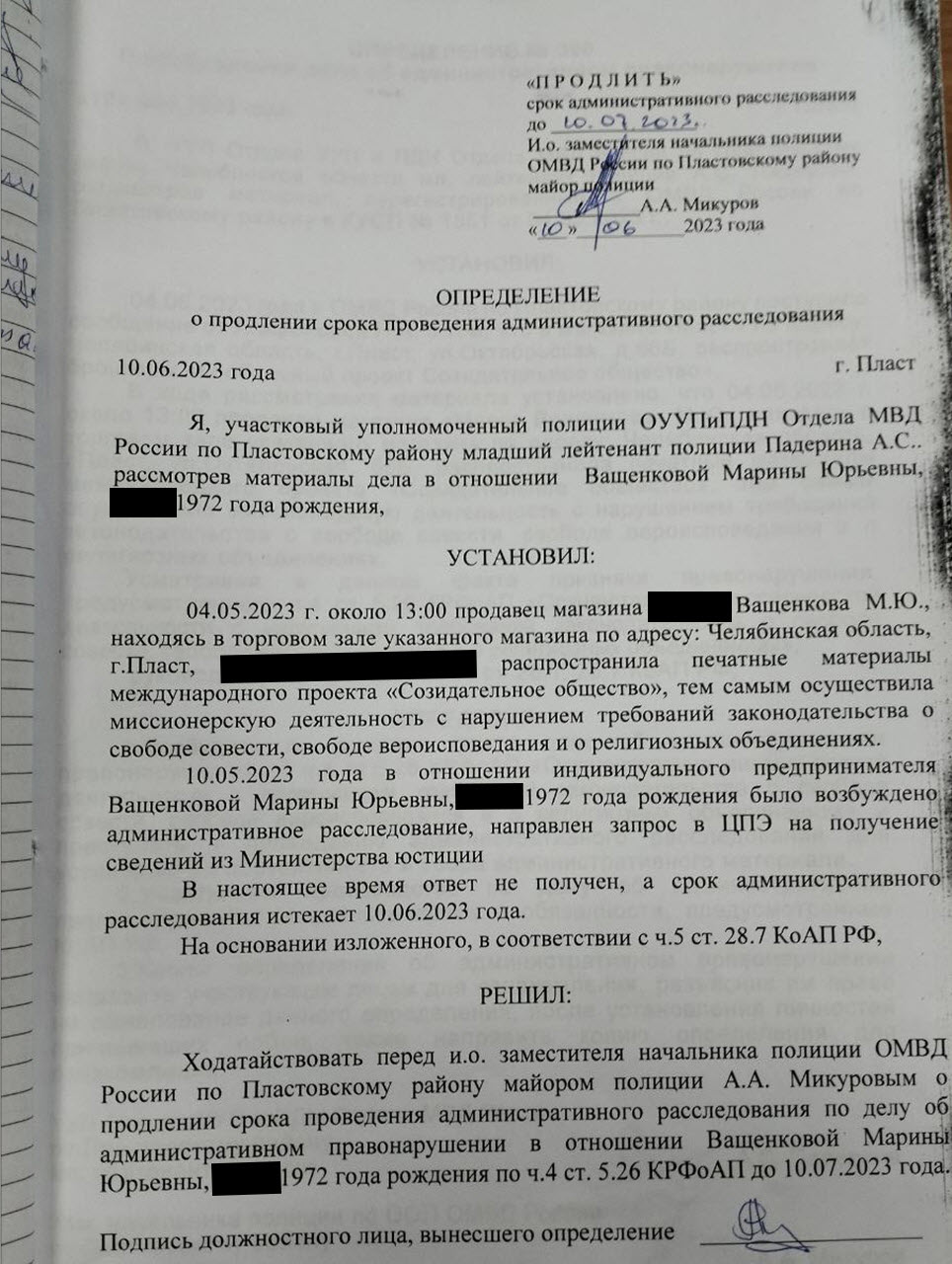
Photo 15: Decision to extend the administrative investigation period, dated June 10, 2023, issued by junior police lieutenant A.S. Paderina, precinct police officer of OUUP and PDN of the Department of the MIA of Russia for the Plast District, Chelyabinsk Region
The signature line marked “Signature of the official who issued the decision” bears the signature of A.S. Paderina. However, according to Part 5, Article 28.7 of the CAO RF, such an extension must be issued by the head of the authority handling the administrative case or their deputy, and only upon the PETITION of the official conducting the investigation. In other words, the CAO RF requires two documents to extend the administrative investigation period: a petition from the official in charge of the case and a decision issued by the head of the relevant authority or their deputy. Here, the case file contains only one document related to the extension of the administrative investigation, and by its form and content, it cannot be classified as the procedural document titled “Decision to extend the administrative investigation period.”
In violation of Part 5 of Article 28.7 of the CAO RF, the maximum allowable duration of the administrative investigation was exceeded. That duration may not exceed one month from the initiation of an administrative case and can only be extended in exceptional cases upon a written petition from the official conducting the investigation. No such exceptional circumstances are indicated in the case materials.
In fact, the procedural actions required by law during the investigation period were not carried out by precinct police officer A.S. Paderina and were possibly intentionally delayed, as the requests to the Center for Combating Extremism of MD MIA of Russia for the Chelyabinsk Region to obtain information from the Ministry of Justice were sent as follows:
- request for information on the organization Creative Society — May 20, 2023 — only after 10 days had passed since the initiation of the case (May 10, 2023) [Volume 1, p. 27, Photo 16].
This raises a question: Was A.S. Paderina not able to submit the request herself directly to the Ministry of Justice? Is she not literate?
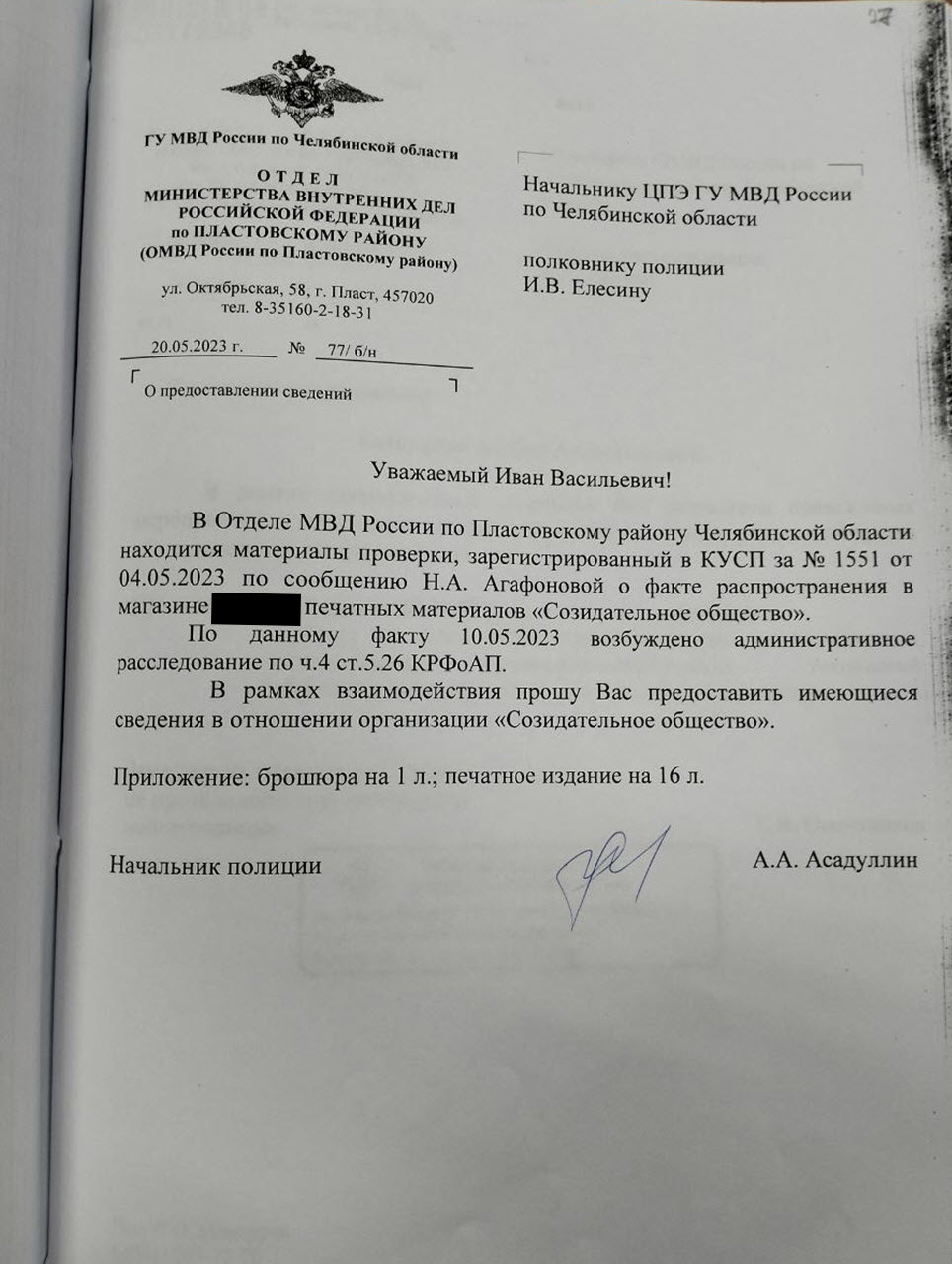
Photo 16: Request for information on the organization Creative Society, submitted to the Center for Combating Extremism of MD MIA of Russia for the Chelyabinsk Region, dated May 20, 2023, No. 77/b/n
- request for information regarding M.Yu. Vashchenkova as a founder or head of a religious organization — June 8, 2023 — only after 29 days had passed since the initiation of the case (May 10, 2023) [Volume 1, p. 33, Photo 17].
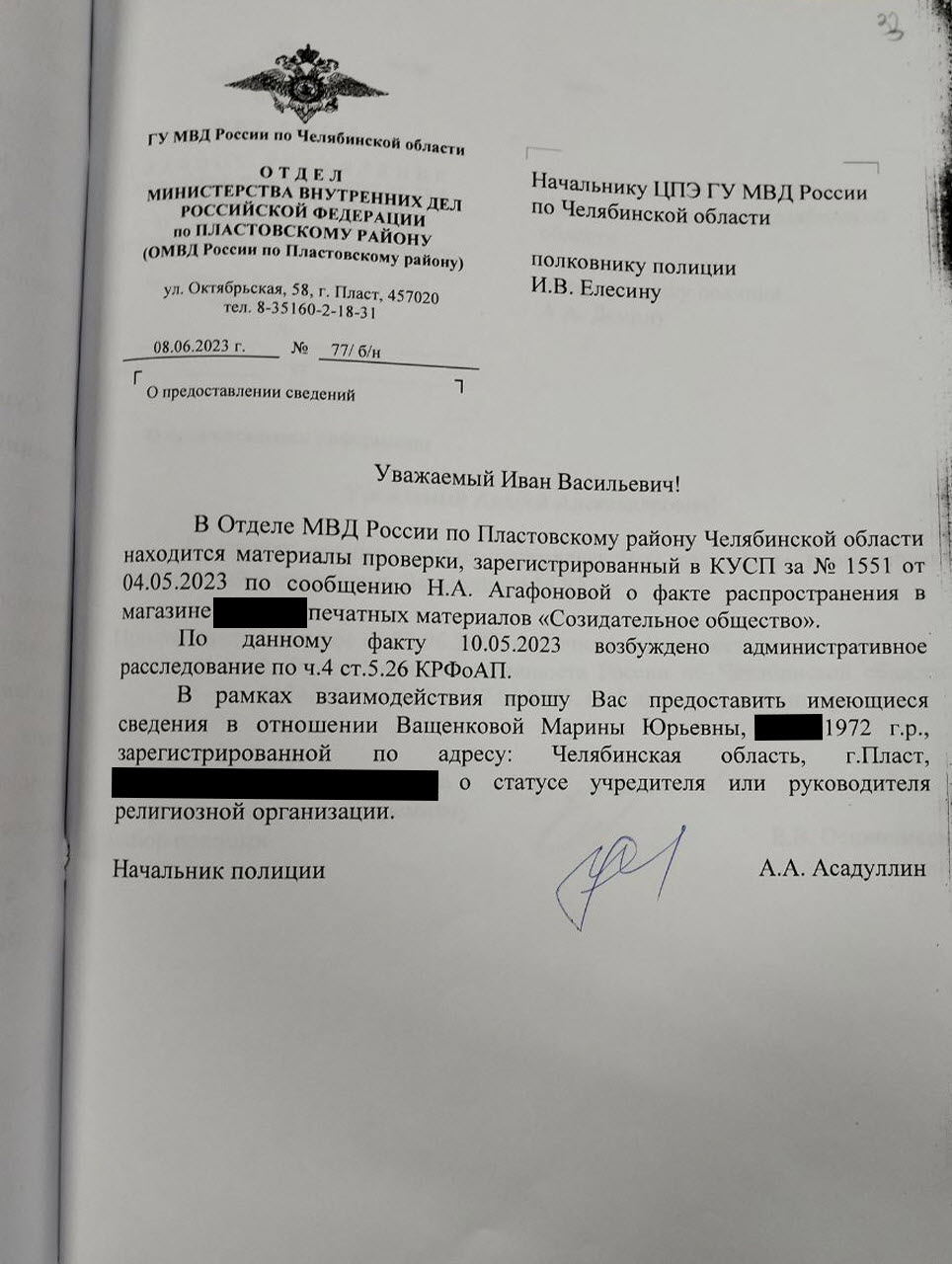
Photo 17: Request for information regarding M.Yu. Vashchenkova as a founder or head of a religious organization, dated June 8, 2023, No. 77/b/n
As stated in paragraph 3, subsection “a” of Section 3 of the Resolution No. 5 of the Plenum of the Supreme Court of the Russian Federation, dated March 24, 2005, “About some questions arising at courts in case of application of the Russian Federation Code of Administrative Offenses,” an administrative investigation constitutes a set of procedural actions carried out by the abovementioned officials, requiring significant time and aimed at establishing all the circumstances of an administrative offense, recording them, providing legal qualification, and formalizing them procedurally. The conduct of an administrative investigation must consist of real actions aimed at obtaining the necessary information, including through expert assessment, identification of victims or witnesses, and questioning of individuals who reside in other localities.
Given these circumstances, it may be concluded that there were no exceptional grounds for extending the administrative investigation period, and the decision dated June 10, 2023, to extend that period is unlawful and unfounded.
The case materials do NOT indicate that, in the course of proceedings in the administrative offense case, the Department of the MIA of Russia for the Plast District, Chelyabinsk Region, conducted an expert assessment or carried out a thorough examination or analysis of the content of the means by which the administrative offense had been allegedly committed (printed materials seized with the involvement of N.A. Agafonova). This constitutes a serious procedural violation in the legal qualification of the actions of M.Yu. Vashchenkova under Part 4 of Article 5.26 of the CAO RF. In other words, police officer A.S. Paderina failed to carry out the necessary procedural steps that would have made it possible to clearly establish that the actions of M.Yu. Vashchenkova bore elements of the offense she was charged with (illegal missionary activity).
Unlawful Collection of Statements by Police Chief Outside Procedural Framework and Violation of the Rights of the Accused
On June 27, 2023 (exact time not indicated), police chief A.A. Asadullin of the Department of the MIA of Russia for the Plast District, Chelyabinsk Region, collected a statement from M.Yu. Vashchenkova again [Vol. 1, p. 17, Photo 18].collected a statement from M.Yu. Vashchenkova again [Vol. 1, p. 17, Photo 18].
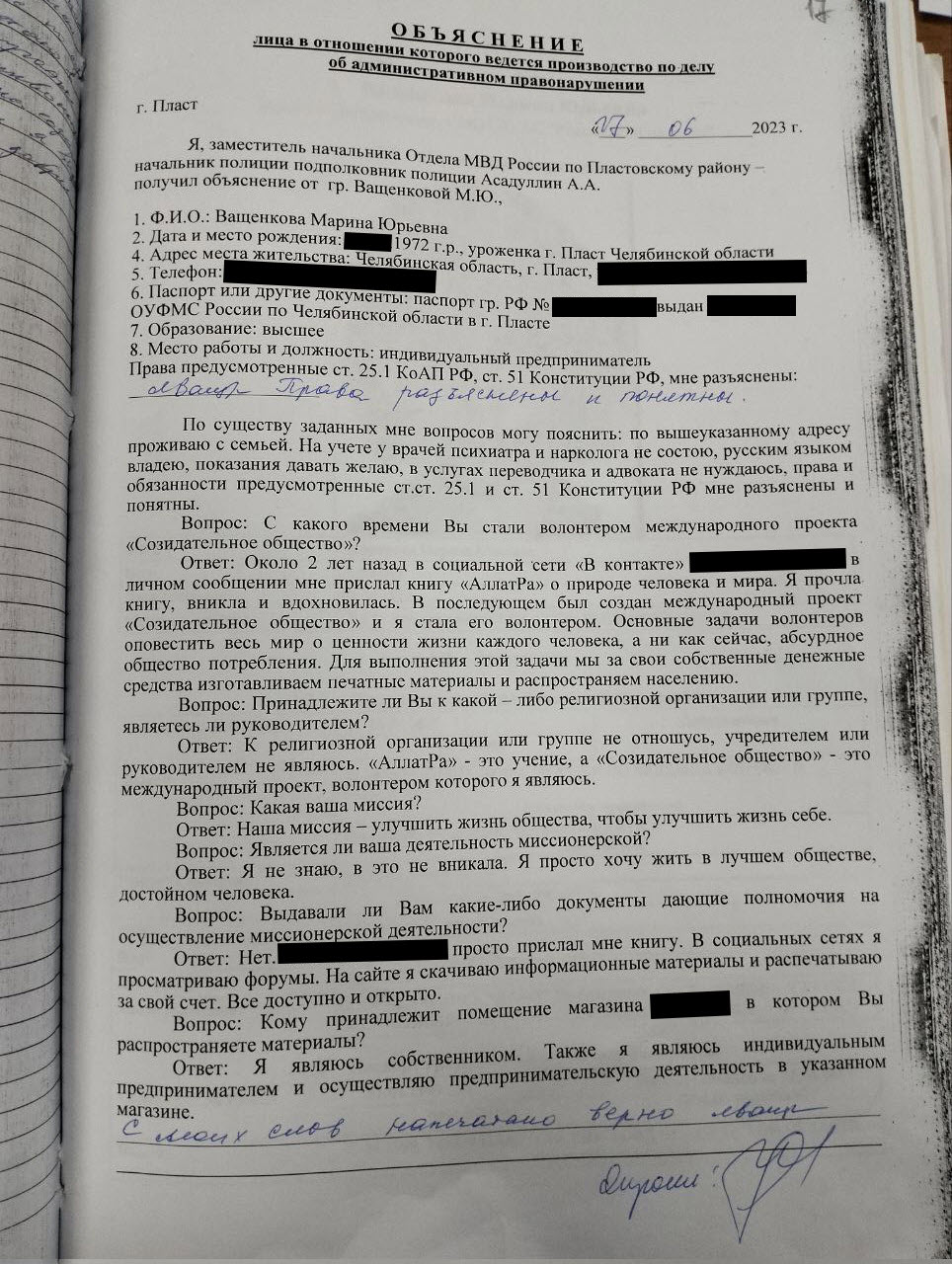
Photo 18: Statement from M.Yu. Vashchenkova, dated June 27, 2023, collected by A.A. Asadullin, police chief of the Department of the MIA of Russia for the Plast District, Chelyabinsk Region
The initial statement had been collected by precinct police officer S.S. Kartsev on May 4, 2023 [Vol. 1, p. 16, Photos 19-20].
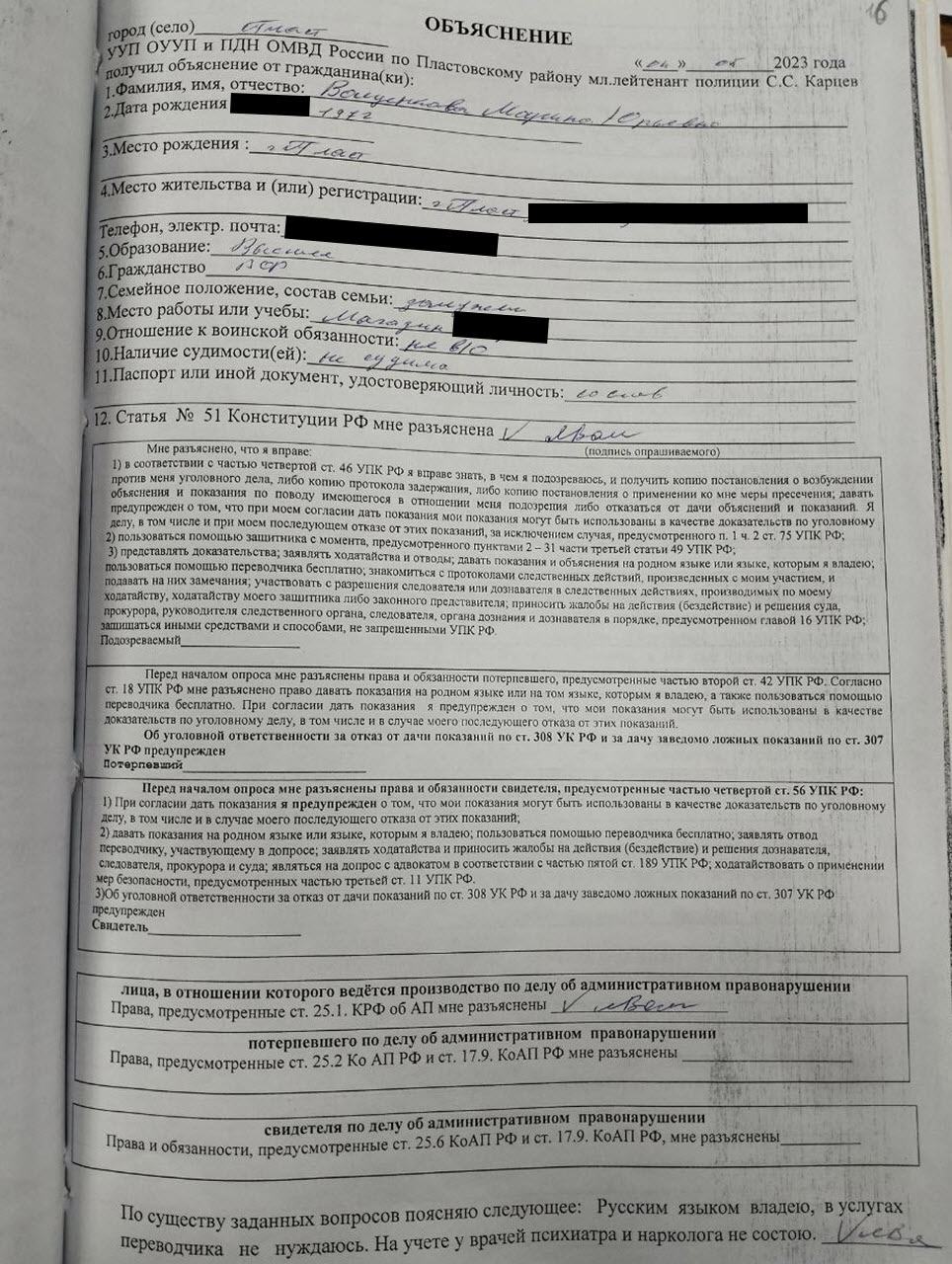
Photo 19: Statement from M.Yu. Vashchenkova, dated May 4, 2023, collected by precinct police officer S.S. Kartsev, part 1
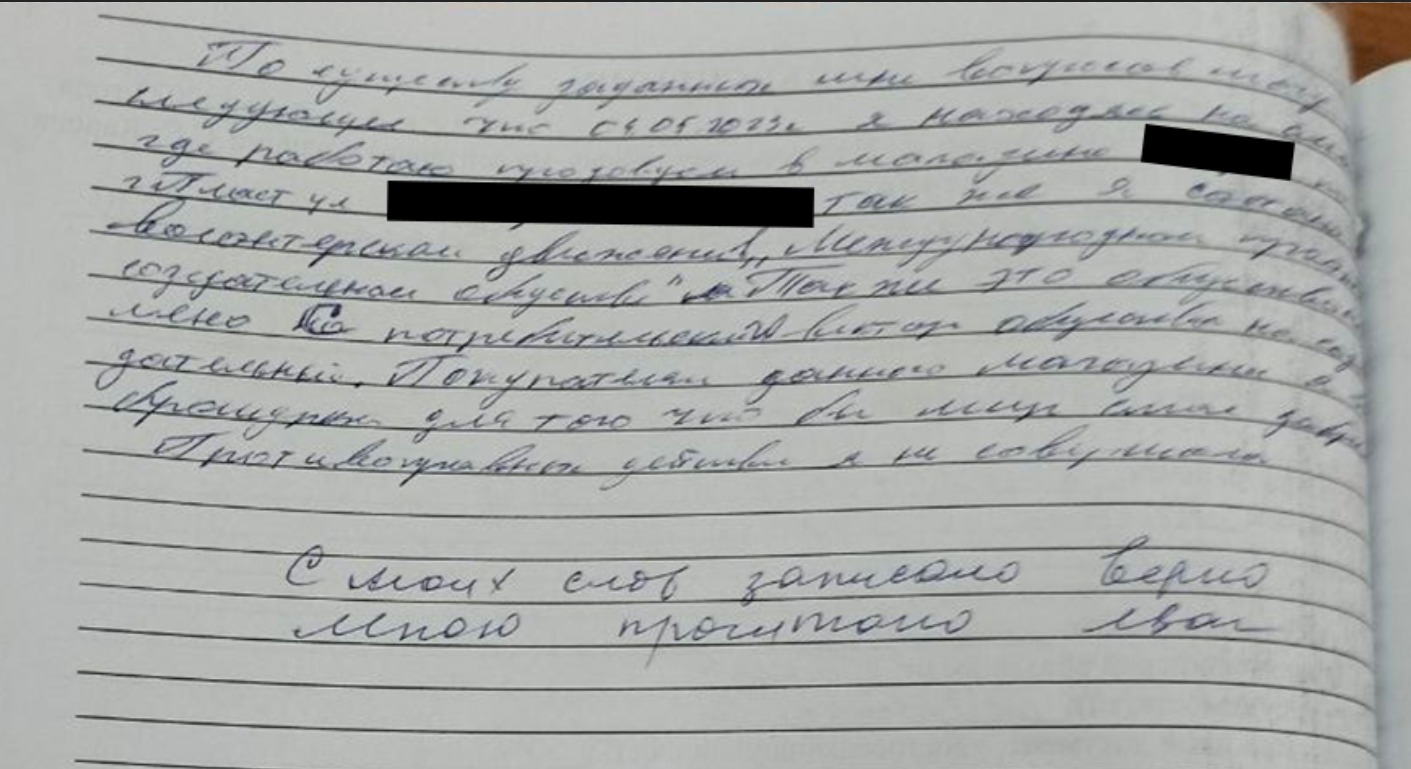
Photo 20: Statement from M.Yu. Vashchenkova, dated May 4, 2023, collected by precinct police officer S.S. Kartsev, part 2
- It is unclear on what legal grounds the police chief himself (A.A. Asadullin) and not the official who handled the case materials (A.S. Paderina) again collected the statement, or why a second statement was required at all. It should be noted that the CAO RF does not contain any provision for reinterrogation of an individual subject to administrative liability. In other words, police chief Asadullin police chief Asadullin of the Department of the MIA of Russia for the Plast District, Chelyabinsk Region, had no authority to question M.Yu. Vashchenkova a second time. Moreover, he had NO legal grounds to collect a statement from her in ANY capacity, as the case was under the jurisdiction of precinct police officer A.S. Paderina.
- On June 27, 2023, A.A. Asadullin invited M.Yu. Vashchenkova to the Plast District Department of MIA for a conversation, without specifying her procedural status or indicating in what capacity or for what purpose she was being summoned. By doing so, he misled her and violated the requirements of the CAO RF.
- While reinterrogating M.Yu. Vashchenkova, Asadullin did not explain the nature of the procedural action being conducted, nor did he inform her of her rights prior to initiating the procedure, which is another obvious violation of the CAO RF requirements.
- The answers provided by M.Yu. Vashchenkova, recorded in the statement dated June 27, 2023, were taken out of context and not fully or accurately reflected by Asadullin.
- Only after she signed the statement did Asadullin tell M.Yu. Vashchenkova that the statement would be submitted to the court. She reacted with indignation, not understanding how such a thing could happen or how she could be considered a violator. But it appears that Asadullin needed to fulfill a task assigned by RACIRS, which is likely why he committed such a blatant violation of the law.
Second Statement by the Alleged Victim — Now a Witness — Lacked Identity Verification and Officer Signature, but Was Admitted as Evidence by the Court
On June 28, 2023 (exact time not indicated), a second statement was taken from N.A. Agafonova, born in 1947, by precinct police officer A.S. Paderina from the OUUP and PDN of the Department of the MIA of Russia for the Plast District, Chelyabinsk Region. This time, Agafonova was questioned not as a victim, but as a witness. The statement contains neither her passport information nor any other form of identification. In other words, the witness was not properly identified. Though signed by Agafonova, the statement does not bear the signature of officer Paderina, which invalidates it as admissible evidence. This second statement also presents a new version of the incident: “... When I entered the store, there was a fair-haired woman, about 40 to 50 years old, who was the salesperson. She gave me a newspaper and a brochure and told me to read them. I asked if it was a sect. She said no. When I got home and read the materials, I didn’t like the statements there. I ask that they stop spreading their rules of the ‘Creative Society’.” [Vol. 1, p. 3, Photos 21-22]
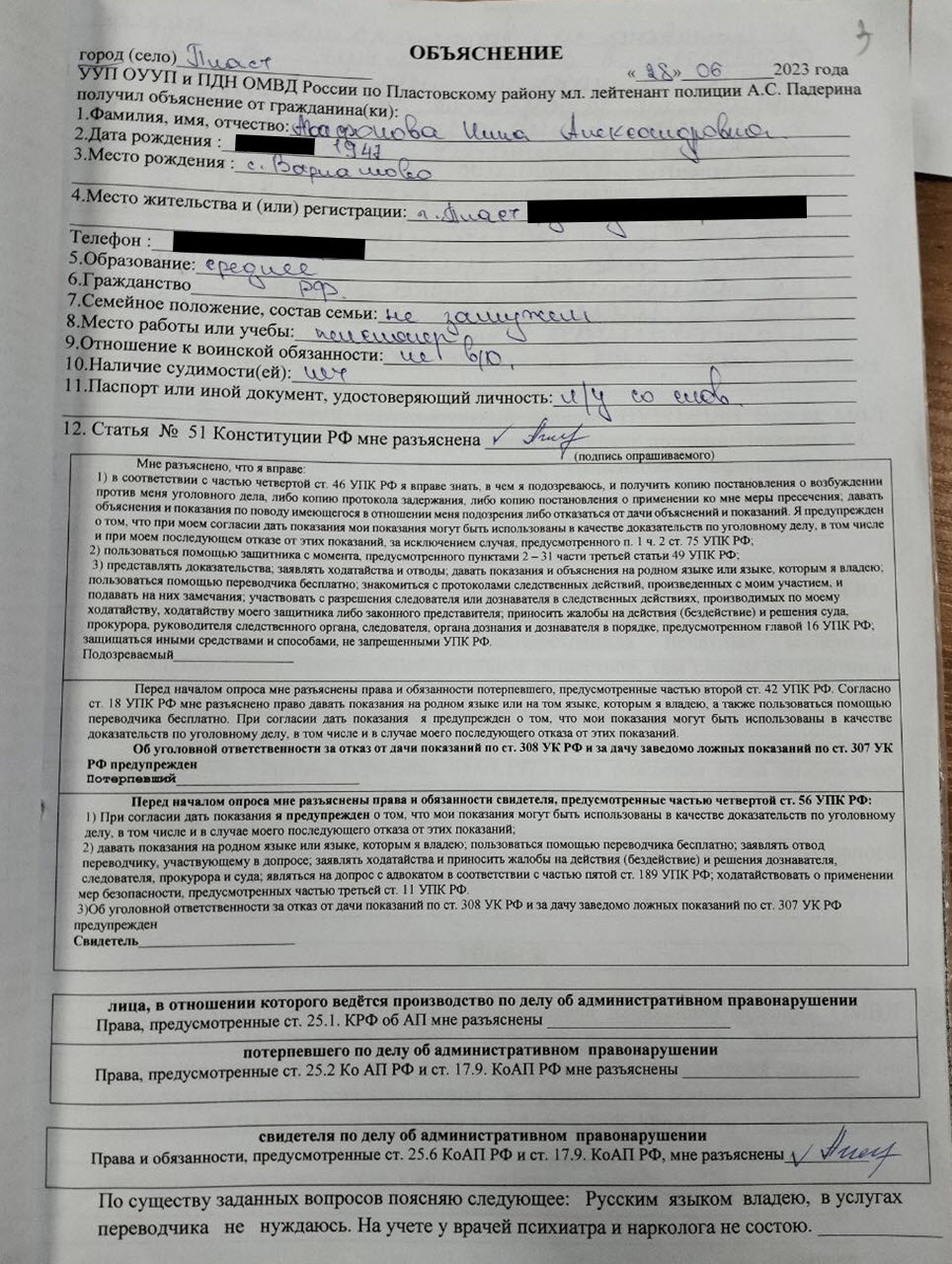
Photo 21: Statement from N.A. Agafonova, dated June 28, 2023, collected by precinct police officer A.S. Paderina from OUUP and PDN of the Department of the MIA of Russia for the Plast District, Chelyabinsk Region, part 1

Photo 22: Statement from N.A. Agafonova, dated June 28, 2023, collected by precinct police officer A.S. Paderina from OUUP and PDN of the Department of the MIA of Russia for the Plast District, Chelyabinsk Region, part 2
There is no information in this statement that connects specifically M.Yu. Vashchenkova to the case. The phrase “a fair-haired woman, about 40 to 50 years old, who was the salesperson” provides no meaningful detail. It could easily describe a random woman who, at some unspecified time and place — possibly on another planet — acted as a salesperson, and even that is merely Agafonova’s subjective impression. Nor is it clear from the statement what exactly Agafonova found objectionable in the printed materials: structure of sentences, style, images, layout, or actual content.
Despite the aforesaid inconsistencies and the new version presented in the second statement, the court failed to assess the evident discrepancies between this document and Agafonova’s original statement dated May 4, 2023. Ultimately, the court unjustifiably admitted both the initial and the second statement as valid evidence of M.Yu. Vashchenkova’s guilt, in violation of Article 26.2 of the CAO RF.
Gross Violations in the Preparation of the Administrative Offense Protocol Invalidate All Subsequent Actions of the Police
On June 28, 2023, junior police lieutenant A.S. Paderina, precinct police officer at OUUP and PDN of the Department of the MIA of Russia for the Plast District, Chelyabinsk Region, drew up the administrative offense protocol No. 3023/000217 [Volume 1, p. 2, Photo 23].
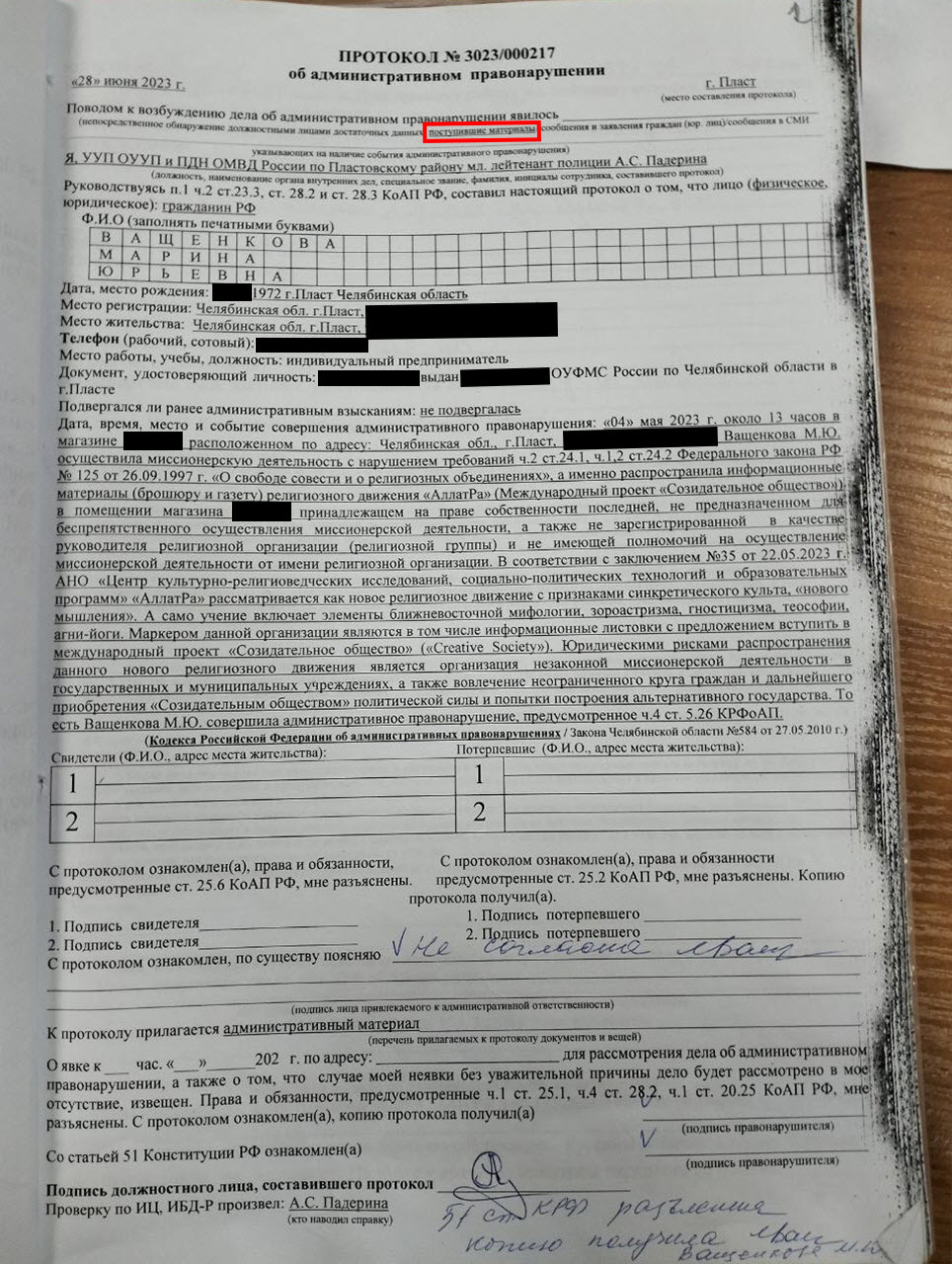
Photo 23: Administrative offense protocol No. 3023/000217 dated June 28, 2023, prepared by precinct police officer and junior lieutenant A.S. Paderina from OUUP and PDN of the Department of the MIA of Russia for the Plast District, Chelyabinsk Region
In drawing up the protocol, multiple egregious violations of the CAO RF were committed, including:
- The protocol dated June 28, 2023, does not indicate the grounds for initiating an administrative offense case (this section is left blank), which confirms the absence of the complaint regarding the offence and the unlawfulness of drafting the protocol. Moreover, instead of citing “citizens’ reports or statements,” the protocol refers to “submitted materials,” further confirming the absence of a valid complaint and the illegitimacy of the protocol. According to Part 2, Article 28.3 of the CAO RF, police officers are authorized to draw up protocols under Article 5.26 of the CAO RF only when there is a report from a citizen or organization. Thus, officer A.S. Paderina was not legally authorized to draw up this protocol (in violation of Paragraph 1, Part 2, Article 28.3 of the CAO RF).
- Upon reviewing the documents drawn up by Paderina, the defense side noted glaring legal and professional incompetence on her part, evident even in basic matters, such as the abbreviation for the code under which M.Yu. Vashchenkova was charged. Russian legislation establishes the proper abbreviation for the Code of Administrative Offenses of the Russian Federation as the CAO RF. According to Section 1 of the Ruling No. 5 of the Plenary Session of the Supreme Court of the Russian Federation, dated March 24, 2005, “About some questions arising at courts in case of application of the Russian Federation Code of Administrative Offences,” the legislative framework that must be applied in such cases is the Code of Administrative Offenses of the Russian Federation (hereinafter referred to as the CAO RF). However, Paderina invented her own abbreviation: CRFoAP — an apparent mockery of Russian law by a law enforcement officer. Consequently, the accusation against M.Yu. Vashchenkova was based on a nonexistent law, effectively charging her under a phantom statute.
- In the administrative offense protocol No. 3023/000217, dated June 28, 2023, the description of the offense nature fails to specify the method by which the newspaper and brochure were distributed, i.e. how the alleged missionary activity was carried out. (What exactly did M.Yu. Vashchenkova do? Did she stuff them into pockets or paste them on the foreheads of store visitors?) There is no indication of any concrete connection between the alleged act and Vashchenkova’s behavior. Police officer A.S. Paderina must have specified something like: “by handing the newspaper and brochure from citizen M.Yu. Vashchenkova directly to citizen N.A. Agafonova” and/or “she talked about…” As for the “newspaper,” nothing in the case files points to the existence of such an item. Instead, there is a reference to an unidentified object labeled “gaSHeta” — a nonsensical term that refers to something unknown to modern civilization and clearly unrelated to the case. Therefore, even the mention of a newspaper in the protocol is legally baseless. The protocol fails to specify what exactly in Vashchenkova’s actions was illegal. Identifying the unlawful element in the behavior of the accused is essential to establishing the occurrence of an administrative offense.
- When describing the alleged offense in the protocol No. 3023/000217, A.S. Paderina refers to Conclusion No. 35 dated May 22, 2023, from ANO “Center for Cultural and Religious Studies, Socio-Political Technologies, and Educational Programs.” But what kind of conclusion is this — personal or expert? If it is implied to be expert, no official expert assessment was assigned in this case as required under Article 26.4 of the CAO RF. The CAO RF does not recognize any other types of conclusions, which makes the reference to this so-called expert conclusion unlawful, invalidating the entire evidentiary chain that follows. The case files only include a memo from this organization, which, in both its form and content, does not meet the legal criteria for an expert opinion.
- Attached to the protocol is a mysterious “administrative material” (some sort of a new know-how paper) instead of the required investigative case materials for an administrative offense.
- In violation of Part 3, Article 28.2 of the CAO RF, the rights and responsibilities of M.Yu. Vashchenkova as the accused were not explained to her. This is confirmed by the absence of a corresponding notation or any indication of a refusal to sign in the appropriate sections of the protocol, in violation of Part 5, Article 28.2 of the the CAO RF. Simply handing over a copy of the protocol for signing does not absolve the official of the duty to explain the accused’s rights. This is a severe procedural violation!
- The protocol further lacks personal data of any witnesses or victims (names and residential addresses), while N.A. Agafonova is listed in the case materials as a witness in some documents and a victim in others. This violates Part 2, Article 28.2 of the CAO RF. According to paragraph 2, Section 4 of Ruling No. 5 of the Plenary Session of the Supreme Court of the Russian Federation, dated March 24, 2005 (as amended on December 23, 2021), “About some questions arising at courts in case of application of the Russian Federation Code of Administrative Offences,” the absence of the information expressly required by Part 2, Article 28.2 of the CAO RF constitutes a material deficiency in the protocol.
- In addition, N.A. Agafonova was not informed of her rights or duties as either a victim or witness as required under the CAO RF. This is evident from the absence of her signature in relevant sections of the protocol, constituting a violation of Part 3, Article 28.2 of the CAO RF. Therefore, without a witness or a victim, there is no offense. (Or did law enforcement establish the fact of the violation through a séance?)
- The protocol also fails to state whether M.Yu. Vashchenkova speaks the language in which the case proceedings were conducted. As noted in paragraph 2, Section 4 of Ruling No. 5 of the Plenary Session of the Supreme Court of the Russian Federation, dated March 24, 2005 “About some questions arising at courts in case of application of the Russian Federation Code of Administrative Offences,” the absence of data listed in Part 2, Article 28.2 of the CAO RF and other relevant details depending on their significance for a particular case of administrative offense (such as whether the accused understands the language of the proceedings, or whether an interpreter was provided, etc.) constitutes a material deficiency in the protocol.
- There were also gross violations of the deadline for executing the administrative offense protocol. Under Article 28.5 of the CAO RF, an administrative offense protocol must be drawn up immediately upon identification of an administrative offense. If additional fact-finding or personal data verification of the individual or information on the legal entity in respect of which the administrative offense case is being initiated is required, the protocol must be executed within two days of the offense being discovered. Given that the alleged administrative offense was identified on May 4, 2023, and that Article 28.7 of CAO RF does not allow for administrative investigations in cases under Part 4, Article 5.26 of the CAO RF, the administrative offense protocol must have been executed no later than May 6, 2023.
The administrative offense protocol was issued more than a month and a half past the legal deadline. For offenses under Part 4, Article 5.26 of the CAO RF, the case is considered initiated at the time the protocol is executed and does not allow for an administrative investigation. Therefore, by May 11, 2023, acting on the instructions of A.A. Asadullin, the responsible officer must have determined whether the actions of M.Yu. Vashchenkova constituted illegal missionary activity. Based on that determination, the officer must have either drawn up a protocol or refused to initiate the case. Instead, on May 10, 2023, A.S. Paderina unlawfully issued a ruling to initiate an administrative offense case and launched an administrative investigation. As a result, all procedural actions carried out by the police after May 10, 2023, have been unlawful.
- The circumstances of the alleged administrative offense as stated in the protocol are not supported by the materials collected. Moreover, those materials contain numerous inconsistencies. This confirms that officer A.S. Paderina unlawfully issued the protocol, as the case files do not establish that any offense occurred on the part of M.Yu. Vashchenkova.
Violation of the Right to Defense: The Case Was Illegally Considered Despite Procedural and Factual Errors
On June 29, 2023, acting police chief (deputy chief of the public order police) major A.A. Mikurov from the Department of the MIA of Russia for the Plast District, Chelyabinsk Region, issued a resolution to transfer the administrative offense case to Judicial District No. 1 of Plast, Chelyabinsk Region, against “ashchenkova ...,” born on ** **, 1974. However, the actual surname of the accused is Vashchenkova, while her actual year of birth is 1972. In other words, the case was forwarded to court for consideration against an entirely different person, with a different surname and date of birth [Vol. 1, p. 1, Photo 24].
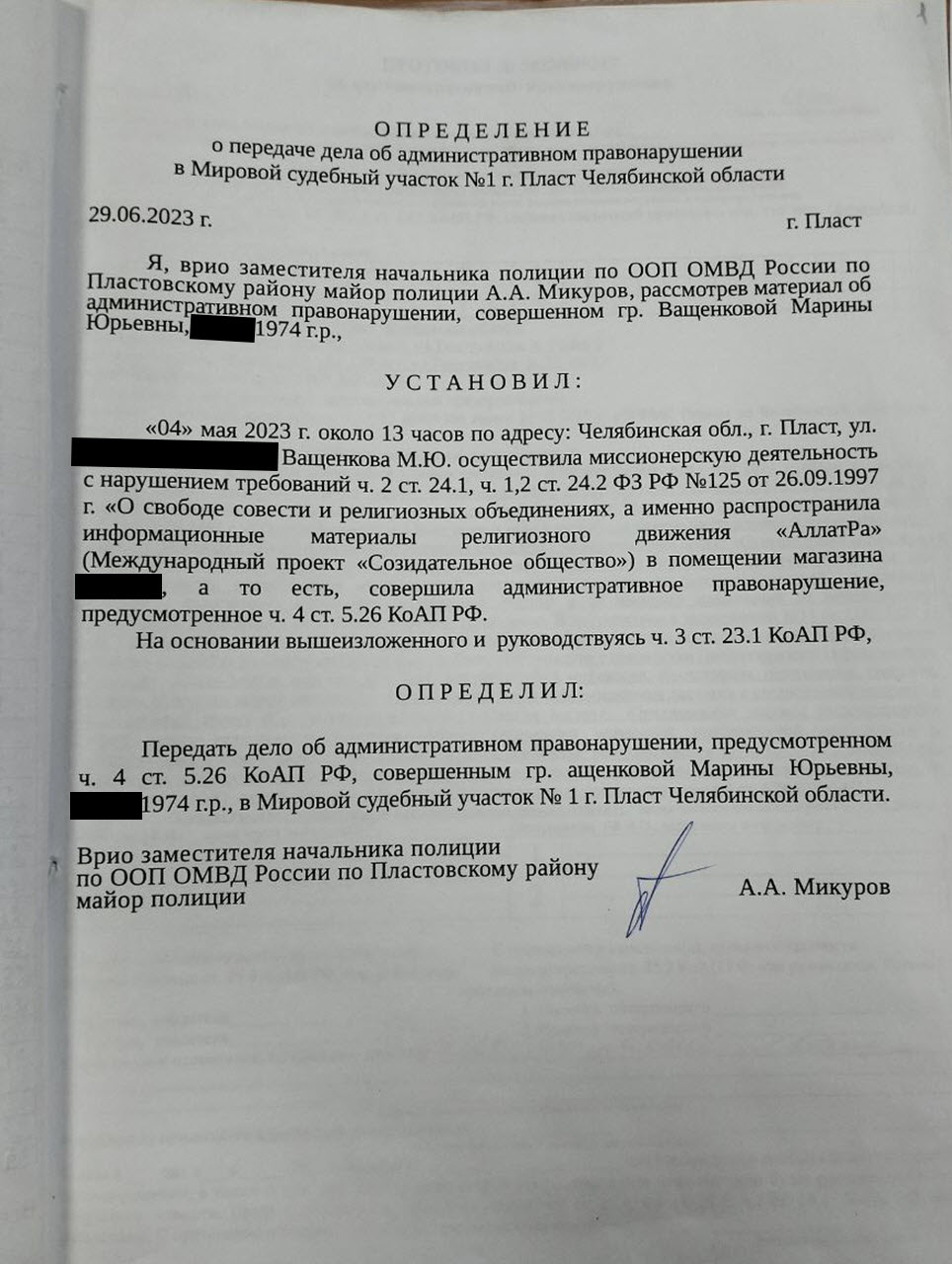
Photo 24: Resolution on the transfer of the administrative offense case to Judicial District No. 1 of Plast, Chelyabinsk Region, dated June 29, 2023, issued by acting police chief (deputy chief of the public order police) major A.A. Mikurov from the Department of the MIA of Russia for the Plast District, Chelyabinsk Region.
Furthermore, this resolution states that M. Yu. Vashchenkova distributed informational materials of the religious movement AllatRa. However, the case files do not confirm that the printed materials seized in the presence of N.A. Agafonova contain any mention of AllatRa or of any religious organization whatsoever.
On July 3, 2023, justice of the peace S.I. Pridannikov of Judicial District No. 1 of the city of Plast, Chelyabinsk Region, issued a resolution to schedule the hearing of the administrative offense case for July 6, 2023 [Vol. 1, p. 40, Photo 25]. However, according to Article 29.4 of the CAO RF, the judge must have issued a resolution on returning the protocol and the case materials to the agency or official who had executed the protocol.
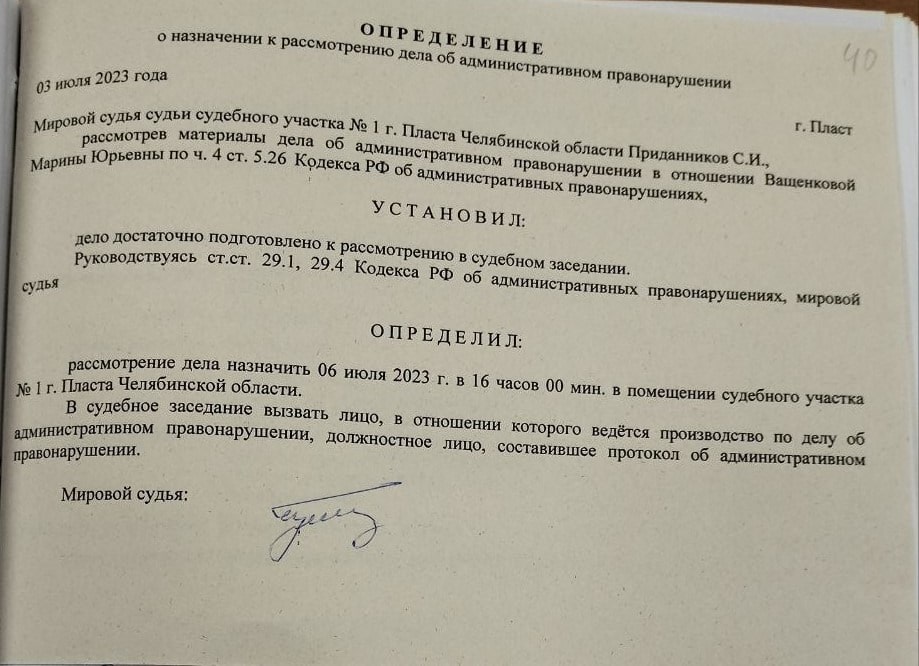
Photo 25: Resolution dated July 3, 2023, issued by Justice of the Peace S.I. Pridannikov of Judicial District No. 1 of Plast, Chelyabinsk Region, scheduling the hearing of the administrative offense case for July 6, 2023
According to paragraph 4, Part 1, Article 29.4 of the the CAO RF and the legal position set forth in Section 4 of Ruling No. 5 of the Plenary Session of the Supreme Court of the Russian Federation, dated March 24, 2005, “About some questions arising at courts in case of application of the Russian Federation Code of Administrative Offences,” if an administrative offense protocol is executed by an unauthorized person, or if the protocol or other materials are improperly executed or incomplete, the judge must issue a ruling to return the protocol and case materials to the agency or official that executed them.
In the case discussed, the aforesaid substantial violations in the execution of protocols and other case materials, as well as the lack of a properly conducted expert assessment of the printed materials seized in the presence of N.A. Agafonova, represented sufficient grounds for Justice of the Peace S.I. Pridannikov to return the materials for correction to the official who issued the protocol. In fact, this was a direct obligation of the judge under Clause 4, Part 1, Article 29.4 of the the CAO RF — an obligation he failed to fulfill. Despite the above-listed procedural violations in how the administrative offense case was conducted and documented, i.e. violations that resulted in a breach of the right to defense of the person subject to the proceedings, the justice of the peace failed to address them and unlawfully accepted the case for review.
Furthermore, Article 47, Part 1 of the Constitution of the Russian Federation states: “Nobody may be deprived of the right to have his (her) case heard in the court and by the judge within whose competence the case is placed by law.” Under Article 23.1, Part 1 of the the CAO RF, judges are authorized to consider cases involving administrative offenses, including those under Article 5.26 of the CAO RF.
According to Section 3 of Ruling No. 5 of the Plenary Session of the Supreme Court of the Russian Federation, dated March 24, 2005, “About some questions arising at courts in case of application of the Russian Federation Code of Administrative Offences,” during the preparation phase of a case, the judge must determine whether the case falls within their jurisdiction. When addressing the issue of subject-matter and territorial jurisdiction, judges must refer to Chapter 23 of the CAO RF which outlines cases that fall under the jurisdiction of judges as per Article 23.1, Part 1 of the CAO RF. It must also be taken into account that judges of district courts handle administrative offense cases listed in Parts 1 and 2 of Article 23.1 of the CAO RF if an administrative investigation was conducted under Article 28.7 of CAO RF.
In this case, both Article 23.1 of the CAO RF and Section 63 of Order No. 736 of the Russian Ministry of Internal Affairs, dated August 29, 2014, "On approving the Instruction on the procedure for receiving, registering and authorizing, in the territorial bodies of the Ministry of Internal Affairs of the Russian Federation, applications and reports on crimes, administrative offenses, and incidents, approved by Order of the Ministry of Internal Affairs," have been violated.
The case files clearly show that the administrative investigation was actually carried out, which means the case must have been considered by a district court judge. Therefore, according to paragraph 5, Part 1, Article 29.4 of the CAO RF, the justice of the peace was required to issue a ruling to transfer the protocol and other case materials to the appropriate court by jurisdiction — namely, the Plast City Court of Chelyabinsk Region.
Reasonable Doubts Regarding the Authenticity of the Witness’s Signature and Signs of Possible Document Forgery
During the analysis of the case materials, the defense identified substantial doubts regarding the authenticity of the signature of the witness (alleged victim) N.A. Agafonova, as it appears in the following files:
- The protocol of seizure of items and documents, dated May 4, 2023, and the statement by N.A. Agafonova, dated May 4, 2023, both executed by junior police lieutenant S.S. Kartsev, precinct police officer of OUUP and PDN of the Department of the MIA of Russia for the Plast District, Chelyabinsk Region [Photos 26-27].
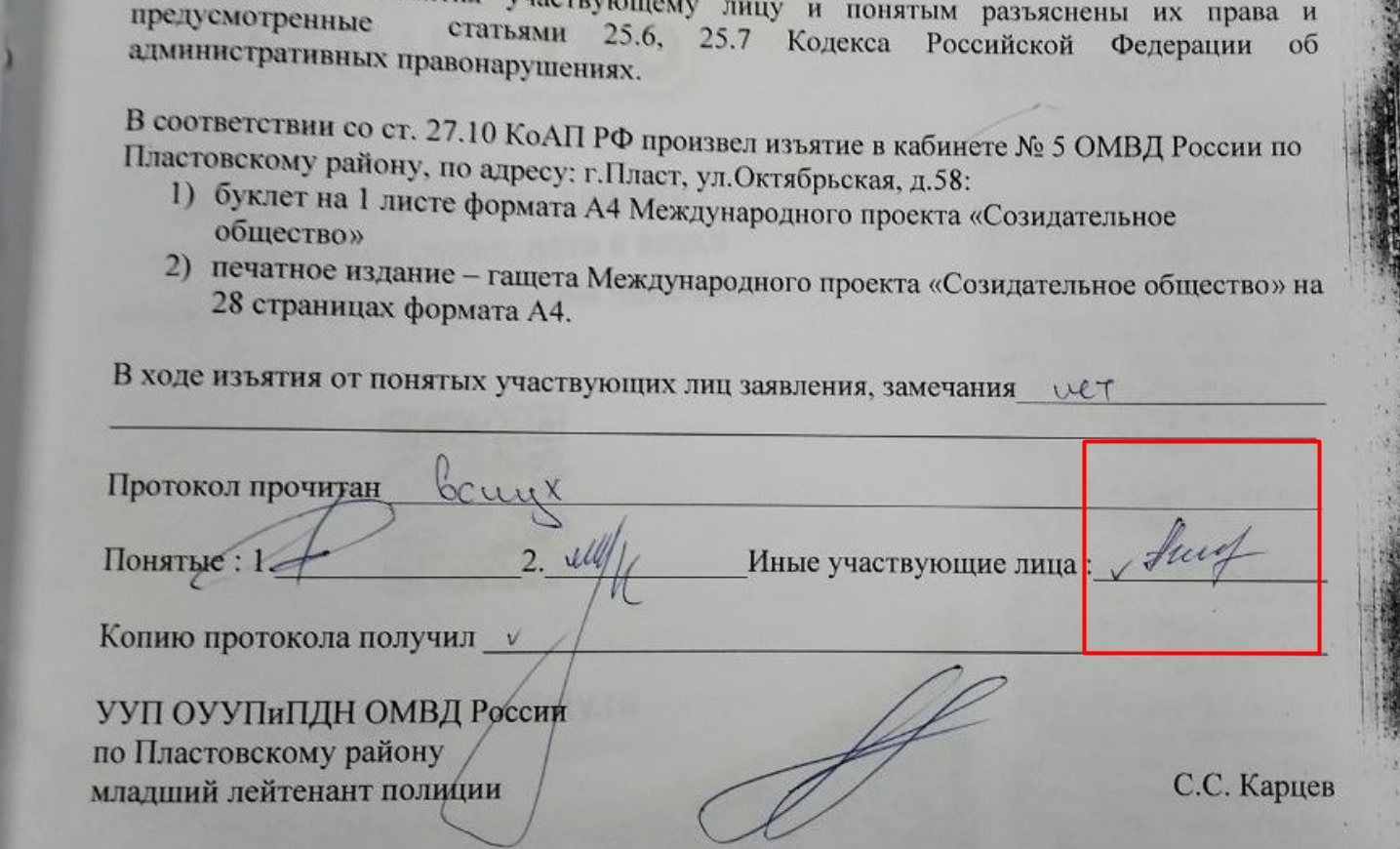
Photo 26: Protocol of seizure of items and documents, dated May 4, 2023
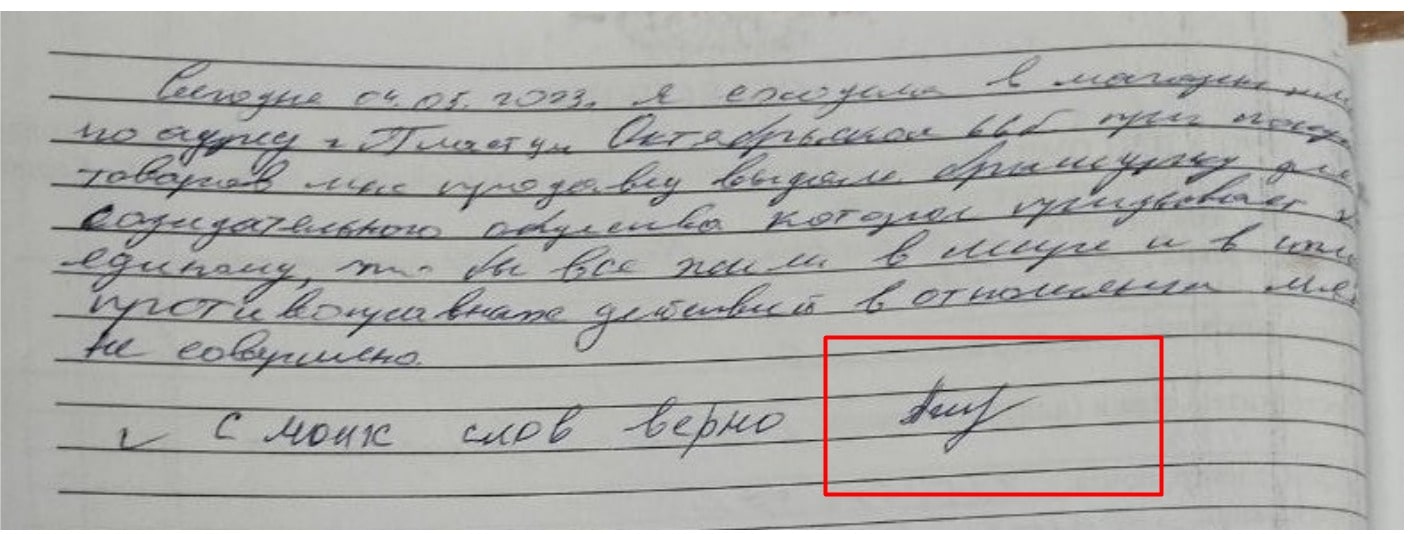
Photo 27: Statement by N.A. Agafonova, dated May 4, 2023, drawn up by junior police lieutenant S.S. Kartsev, precinct police officer of OUUP and PDN of the Department of the MIA of Russia for the Plast District, Chelyabinsk Region
- The statement by N.A. Agafonova, dated June 28, 2023 [Photo 28], drawn up by A.S. Paderina, precinct police officer of OUUP and PDN of the Department of the MIA of Russia for the Plast District, Chelyabinsk Region
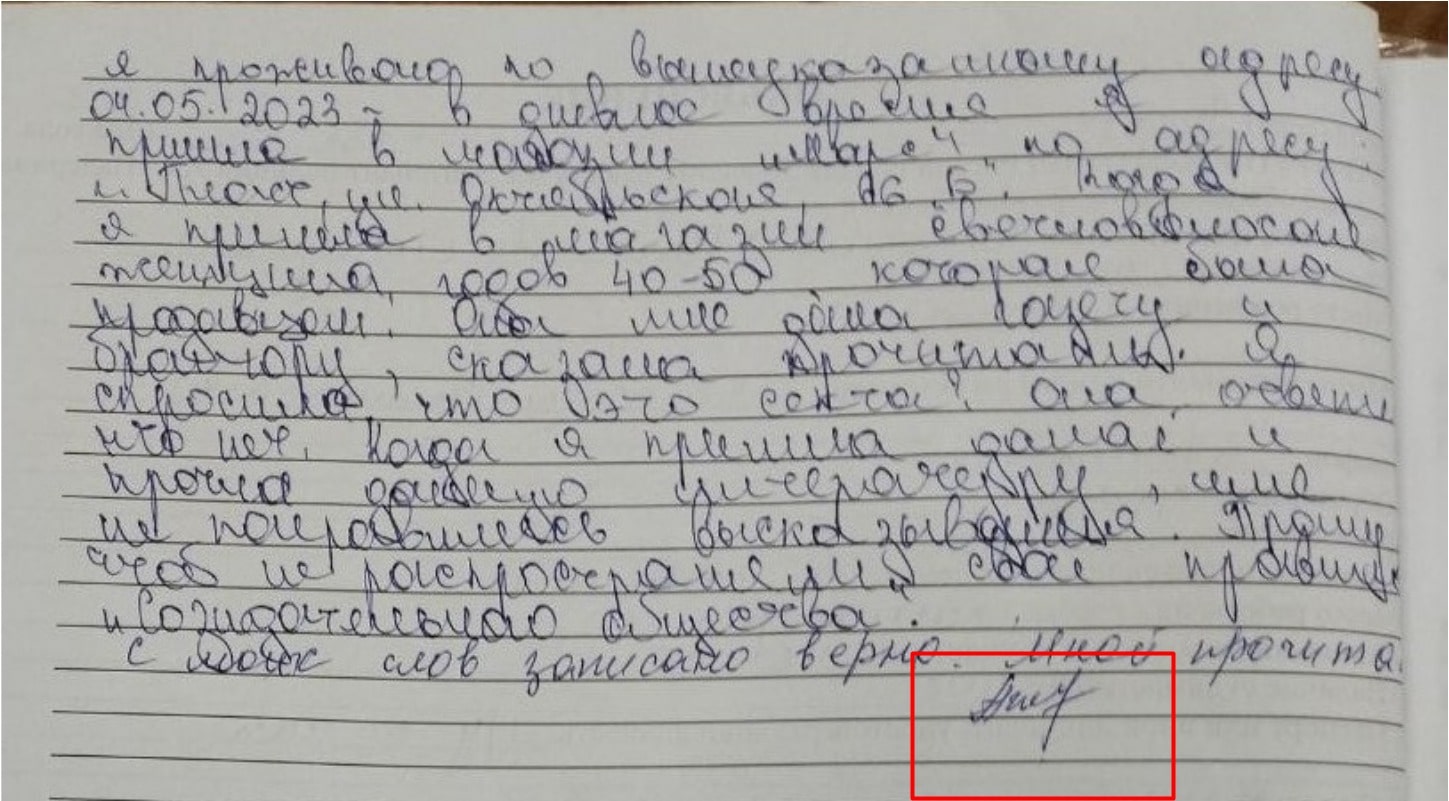
Photo 28: Statement by N.A. Agafonova, dated June 28, 2023
The signatures in question differ significantly in their visual and handwriting characteristics. Considering N.A. Agafonova’s age (76 at the time the documents were executed), visual features of the signatures do not match the expected motor skills of an elderly individual. On the contrary, the signatures appear more consistent with those of a younger person (with even, sharp lines and strong pen pressure). This gives rise to reasonable suspicion that the signatures might not have been made by N.A. Agafonova herself, but rather by another person, specifically the police officer who drew up the documents. Although a forensic handwriting examination has not yet been conducted, it is expected to be performed.
Given the lack of a forensic handwriting examination report in the case files and the possibility that evidence was falsified by someone signing the documents in place of N.A. Agafonova, the defense considers it impossible to recognize the signatures as reliable and admissible evidence without a proper expert analysis to determine whether the signatures in the procedural documents were indeed made by N.A. Agafonova. Should the signs of evidence falsification in the administrative case materials be confirmed, those responsible for the forgery will be subject to criminal liability under Article 303 of the CC RF (Falsification of Evidence and Results of Operational and Search Activities).
Violations Committed by Justice of the Peace S.I. Pridannikov During the Case Consideration
In the course of reviewing the administrative offense case, Justice of the Peace Sergey Ilyich Pridannikov also committed a substantial violation of procedural law, as outlined below.
1. Hearing of the case without the participation of the person whose report triggered the administrative offense proceedings
Justice of the peace S.I. Pridannikov reviewed the case without the participation of N.A. Agafonova whose report led to the inspection conducted from May 4, 2023, to May 10, 2023, and to the initiation of the administrative offense case. Based on the case materials, N.A. Agafonova is either a victim — as indicated in her statement dated May 4, 2023 [Volume 1, p. 9, Photos 11-12] and in the letter dated May 10, 2023, No. 77/3961 [Volume 1, p. 15, Photo 29] — or a witness, as follows from Agafonova’s statement dated June 28, 2023 [Volume 1, p. 3, Photos 21-22].
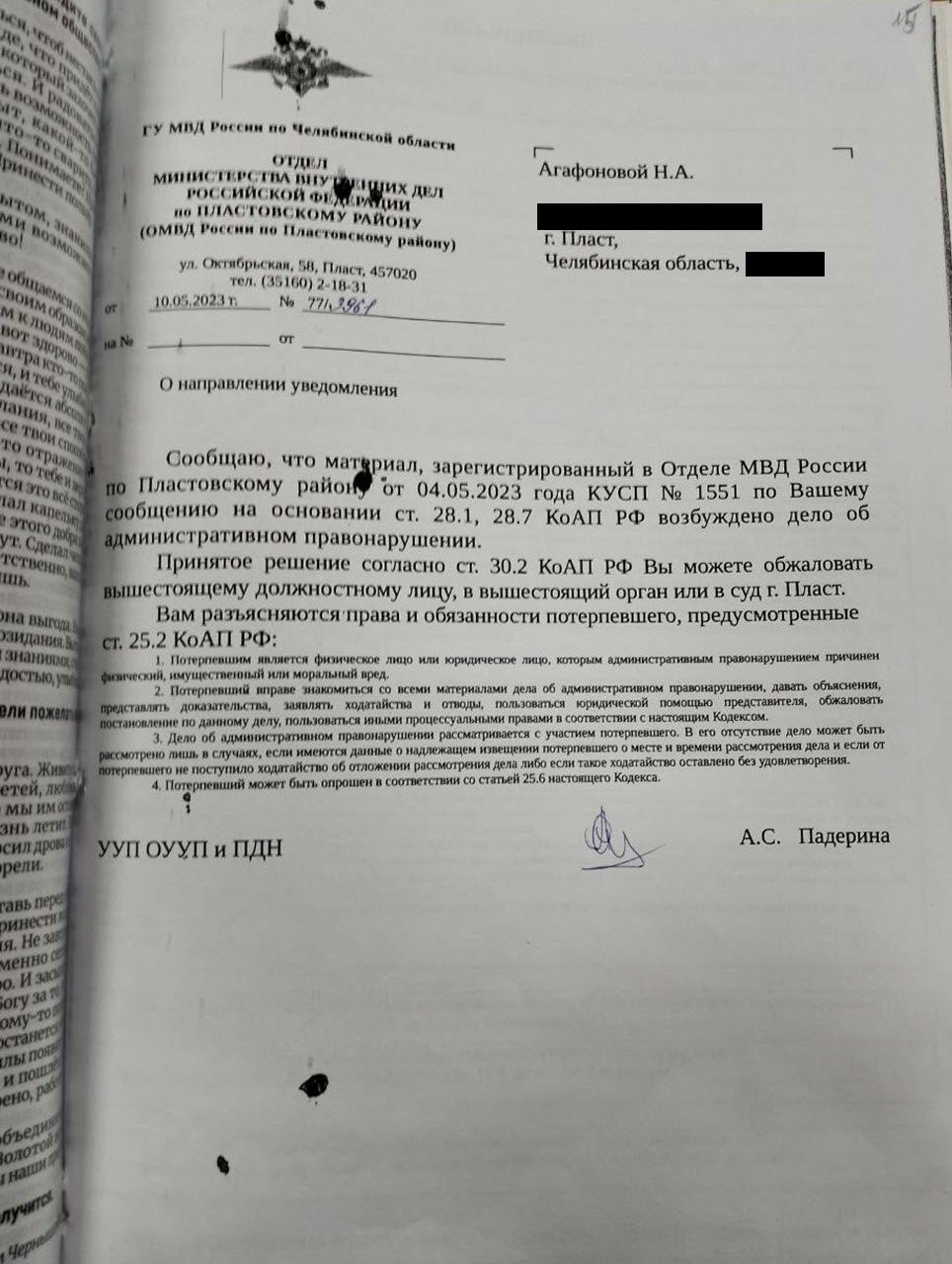
Photo 29: Letter regarding the dispatch of notification No. 77/3961 dated May 10, 2023, signed by precinct police officer A.S. Paderina, OUUP and PDN of the Department of the MIA of Russia for the Plast District, Chelyabinsk Region
It should be noted that, in accordance with Article 25.2 of the CAO RF, an administrative offense case is to be heard with the participation of the victim. In the victim’s absence, the case may only be considered if there is evidence that the victim was duly notified of the time and place of the hearing, and if no motion to postpone the hearing was filed by the victim, or if such a motion was denied. In this case, there is no information indicating that N.A. Agafonova was present during the hearing of the case by Justice of the Peace S.I. Pridannikov, nor is there any record of a motion from N.A. Agafonova requesting a postponement of the hearing.
In any event, the presence of N.A. Agafonova at the hearing was necessary to establish the factual circumstances of the administrative offense allegedly committed by M.Yu. Vashchenkova.
Since the defense had grounds to believe that citizen N.A. Agafonova had never submitted a complaint regarding the alleged unlawful actions of M.Yu. Vashchenkova under Part 4 of Article 5.26 of the CAO RF which provides for liability for illegal missionary activity, the attorney representing M.Yu. Vashchenkova submitted a motion to summon the victim, N.A. Agafonova, to appear in court [Volume 1, p. 85, Photo 30].
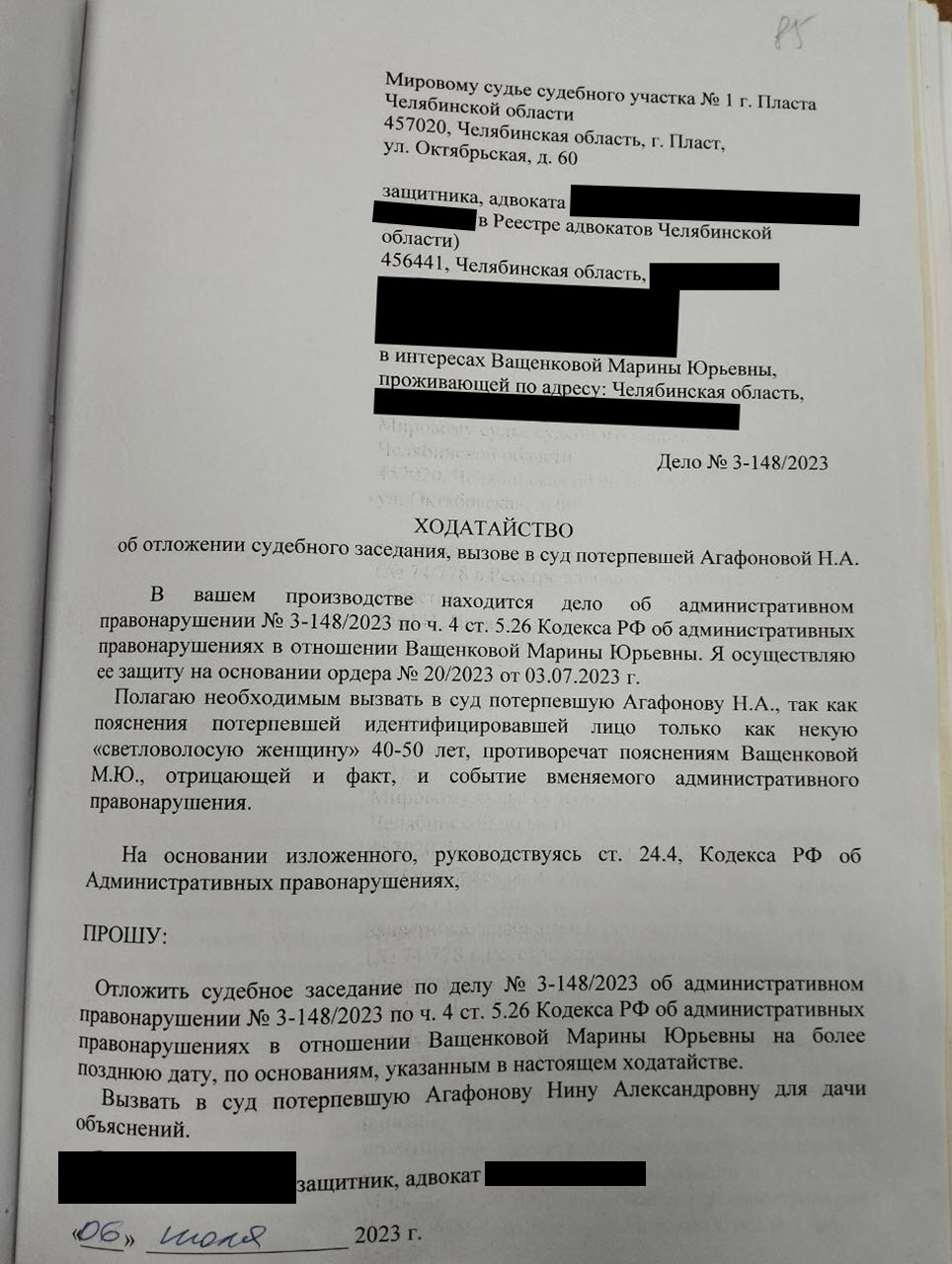
Photo 30: Motion to postpone the court hearing and to summon the victim, N.A. Agafonova, dated July 6, 2023
However, in a ruling dated July 10, 2023, the judge denied the motion to summon and question the witness on the grounds that, according to the individual who compiled the administrative offense protocol, N.A. Agafonova’s health had deteriorated [Volume 1, p. 113, Photo 31].
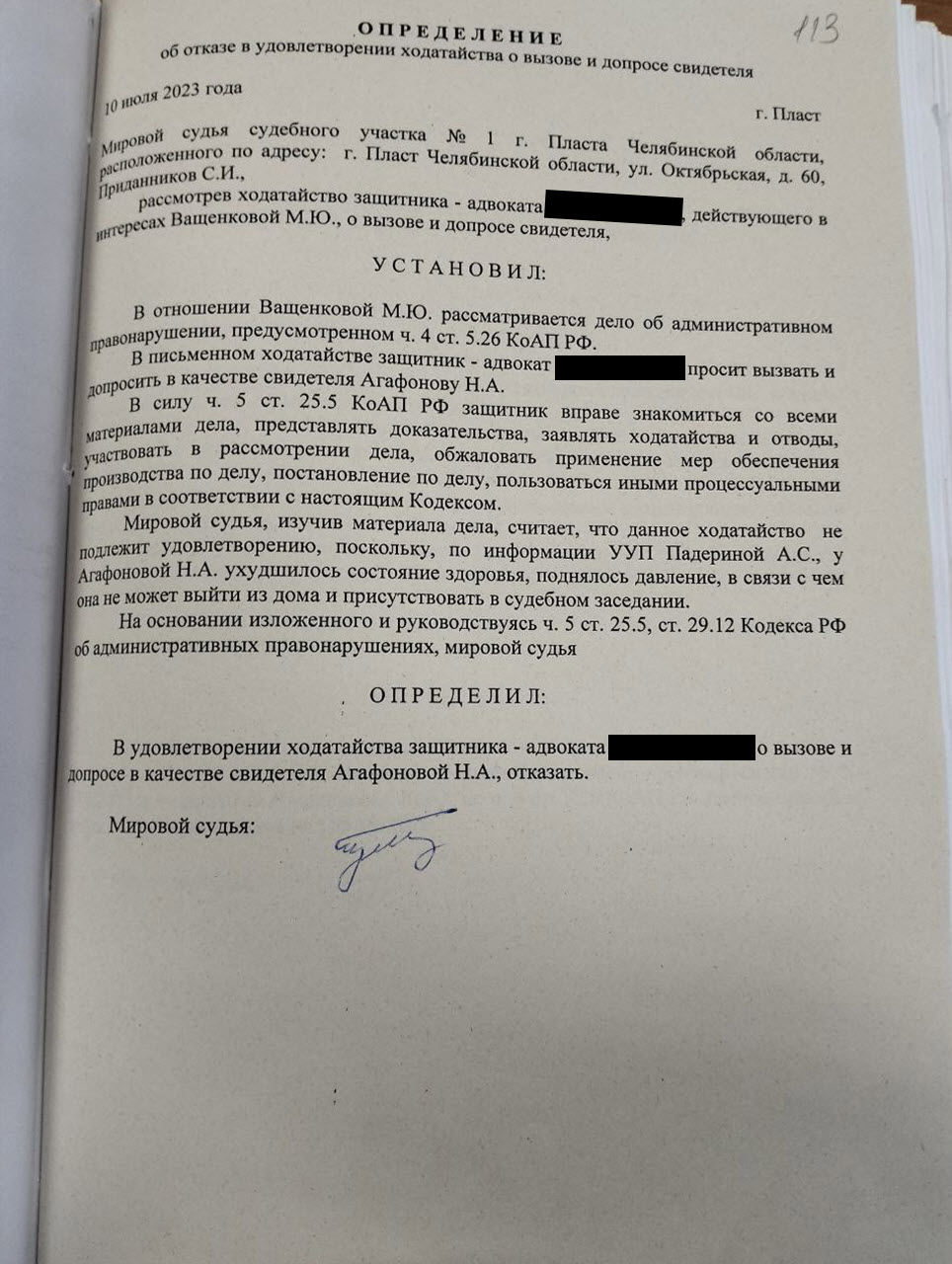
Photo 31: Ruling denying the motion to summon and question the witness, dated July 10, 2023, issued by Justice of the Peace S.I. Pridannikov
It should be noted that the case file contains neither a motion from N.A. Agafonova herself nor any evidence confirming her poor health. One might wonder: does precinct police officer A.S. Paderina also serve as a medical professional? And was it really sufficient for justice of the peace S.I. Pridannikov to rely solely on the words of district police officer A.S. Paderina, in lieu of a medical certificate regarding N.A. Agafonova’s health, to justify denying the motion to summon and question her? This means that the words of the precinct police officer became the “evidence” that served as a basis for Justice of the Peace S.I. Pridannikov’s ruling to deny the motion to summon and question the witness — a practice that is unacceptable for those who serve the law.
Thus, during the review of the administrative offense case by Justice of the Peace S.I. Pridannikov, there was no proper confirmation of the existence of such a person as Nina Alexandrovna Agafonova born ** **, 1947, nor of the fact that it was specifically she who received printed materials from M.Yu. Vashchenkova that contained information about the Creative Society project. Therefore, in violation of the provisions of the CAO RF, Justice of the Peace S.I. Pridannikov failed to ensure a comprehensive, complete, and objective examination of the circumstances of the case, which resulted in an unlawful ruling — that is, he failed to fulfill the objectives of administrative offense proceedings as established in Article 24.1 of the CAO RF.
2. Use of inadmissible evidence by the justice of the peace to establish the guilt of M. Yu. Vashchenkova when issuing the ruling
According to Article 26.2 of the CAO RF, evidence in an administrative offense case includes any factual data on the basis of which the existence or absence of an administrative offense, the guilt of the person held administratively liable, and other circumstances relevant to the proper resolution of the case are established. At the same time, it is necessary to consider that evidence must be both admissible and relevant. Admissible — meaning obtained in compliance with the law. Relevant — meaning directly related to the facts of the administrative offense under consideration.
Evidence may be deemed inadmissible if obtained during the pretrial stage of administrative proceedings. This includes any documents and/or information obtained without observing the procedural requirements established by the CAO RF, e.g., obtaining an expert opinion outside the framework of the administrative offense case and in violation of the procedural rules established for such actions (Decision of the Supreme Court of the Republic of Tatarstan dated March 18, 2020, in case No. 77-480/2020; this decision was upheld by the ruling of the Sixth Cassation Court of General Jurisdiction dated September 2, 2020, No. 16-5567/2020).
2.1. Justice of the peace S.I. Pridannikov unlawfully based the guilt of M.Yu. Vashchenkova on inadmissible evidence collected during an unlawful administrative investigation, as well as on testimonies from improperly involved witnesses
As noted above, the administrative investigation was carried out with gross violations and overreach of the powers established in Article 28.7 of the CAO RF. Therefore, under Part 3 of Article 26.2 of the CAO RF, which prohibits the use of evidence in an administrative offense case if it was obtained in violation of the law, all evidence collected during that administrative investigation must be deemed inadmissible in this case. Nevertheless, in issuing the ruling No. 3-148/2023 on July 14, 2023, under Part 4 of Article 5.26 of the CAO RF, in the case against M.Yu. Vashchenkova, the justice of the peace of Judicial District No. 1 of Plast, Chelyabinsk Region — justice of the peace S.I. Pridannikov — unlawfully relied on the following pieces of evidence obtained during the unlawful administrative investigation as grounds for her supposed guilt:
- Administrative offense protocol No. 3023/000217 dated June 28, 2023 [Volume 1, p. 2, Photo 18];
- Testimony of witness N.A. Agafonova, dated June 28, 2023 [Volume 1, p. 3, Photos 16-17];
- Statement by the person subject to administrative proceedings, M.Yu. Vashchenkova, dated June 27, 2023 [Volume 1, p. 17, Photos 13-14];
- Response to the inquiry No. 35 dated May 22, 2023, from ANO “Center for Cultural and Religious Studies, Socio-Political Technologies, and Educational Programs” [Volume 1, pp. 31–32, Photos 32-33];
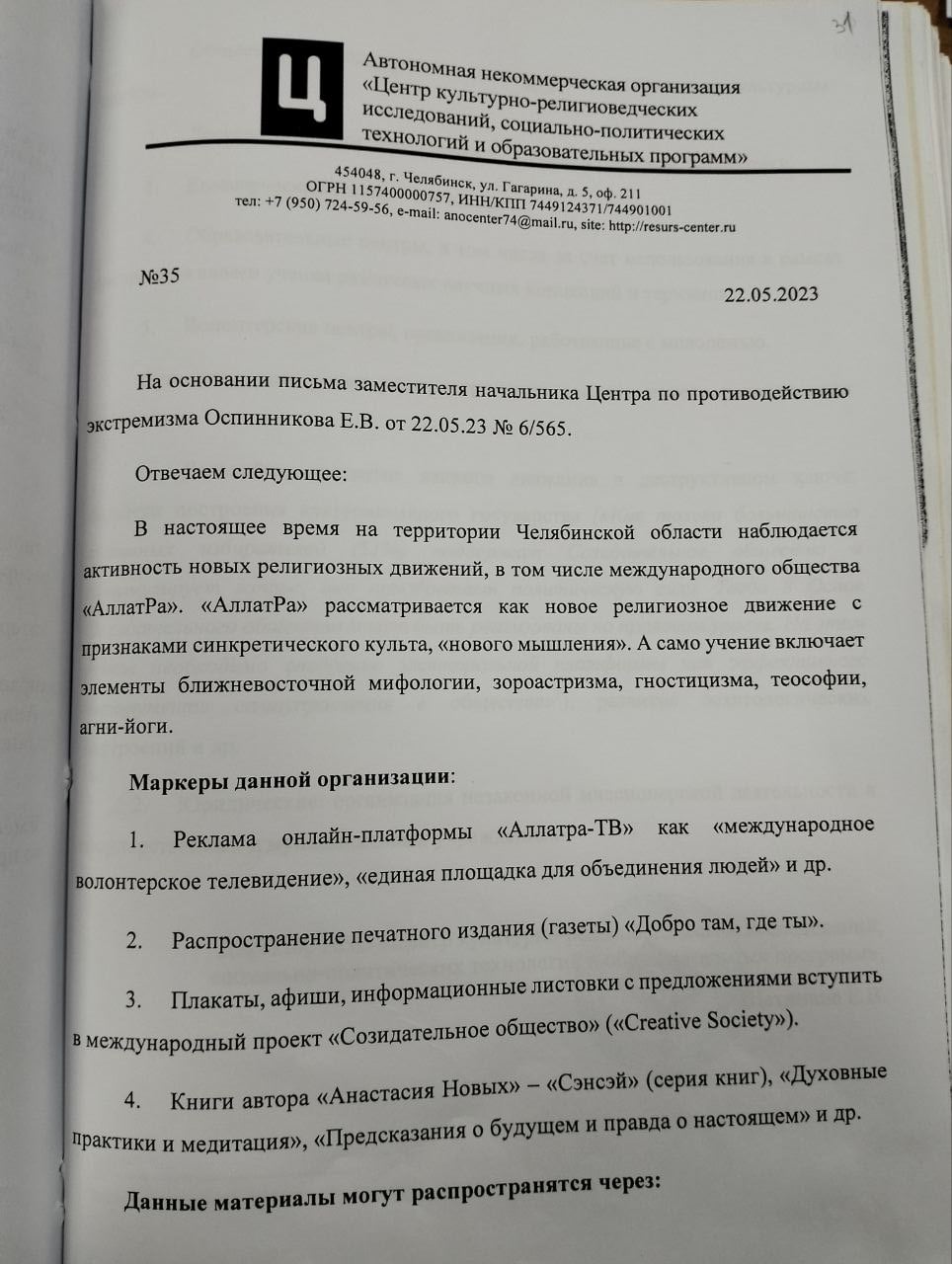
Photo 32: Response to the inquiry No. 35 dated May 22, 2023, from ANO “Center for Cultural and Religious Studies, Socio-Political Technologies, and Educational Programs,” part 1
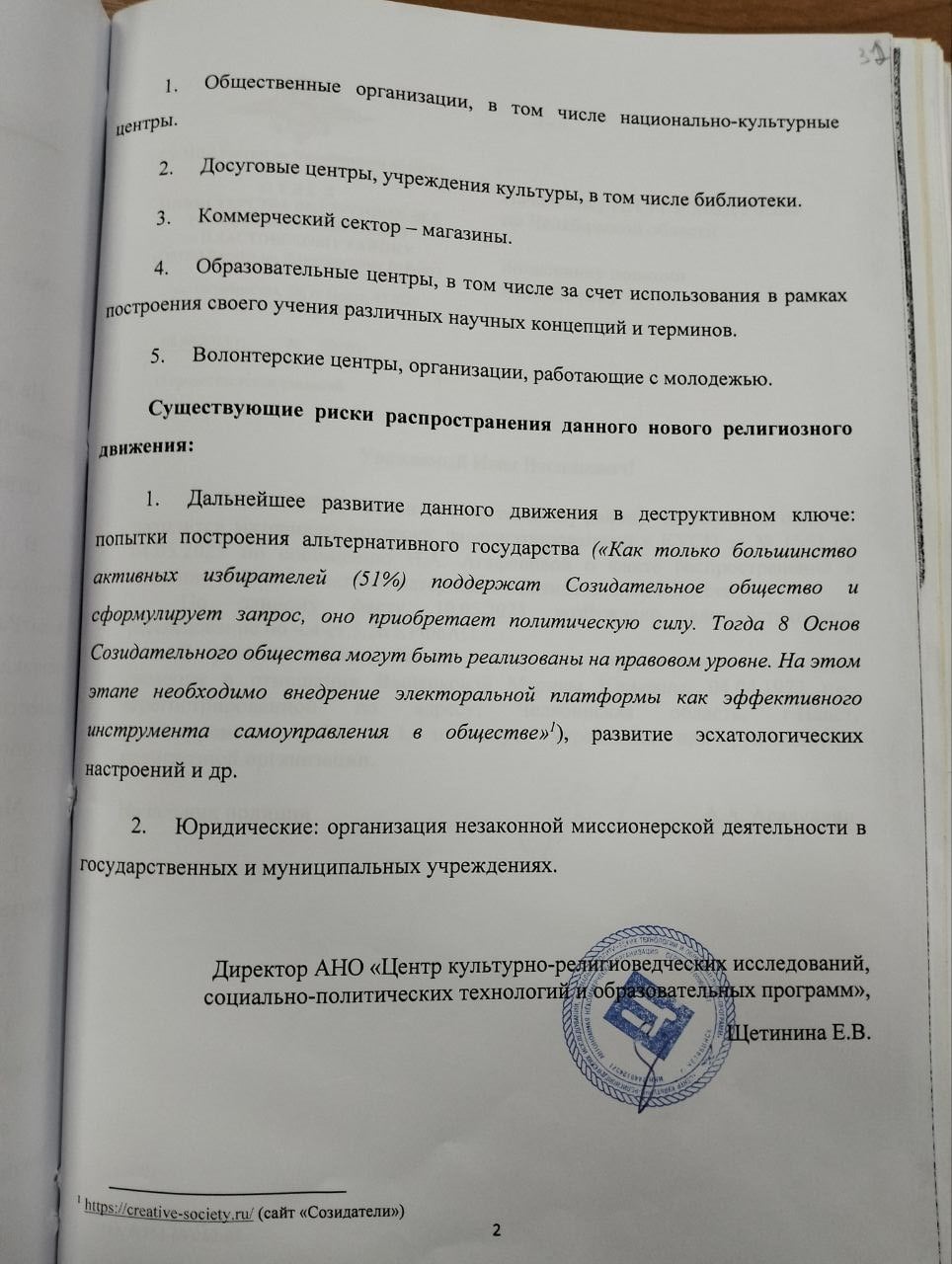
Photo 33: Response to the inquiry No. 35 dated May 22, 2023, from ANO “Center for Cultural and Religious Studies, Socio-Political Technologies, and Educational Programs,” part 2
- Response to an inquiry from the Department of the Ministry of Justice of the Russian Federation for the Chelyabinsk Region, No. 74/03-33-3472 dated June 27, 2023 [Volume 1, p. 36, Photo 34].
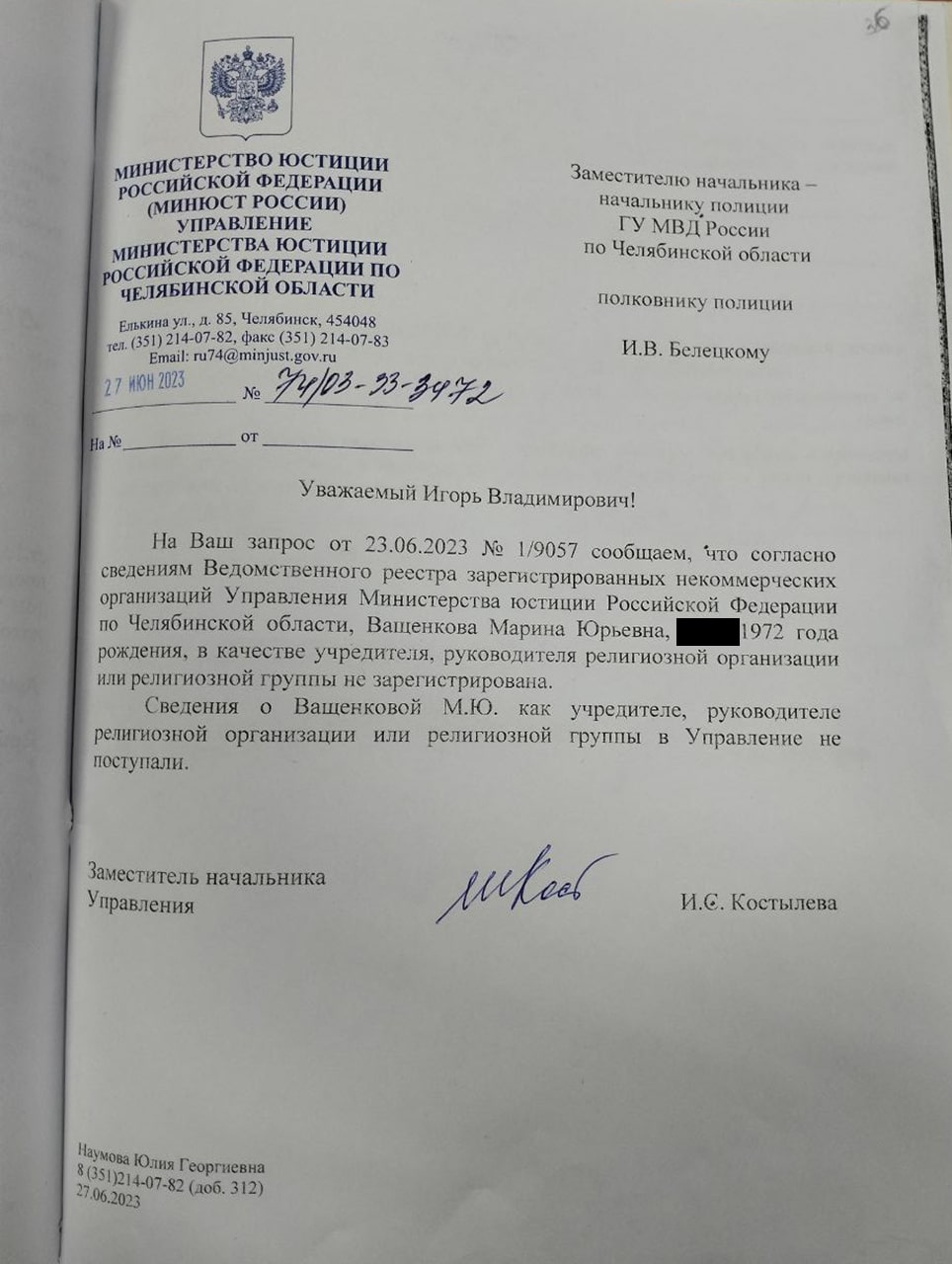
Photo 34: Response to an inquiry from the Department of the Ministry of Justice of the Russian Federation for the Chelyabinsk Region, No. 74/03-33-3472 dated June 27, 2023
2.2. Testimonies of witnesses K.V. Putnik and S.O. Manturov are also inadmissible evidence in the administrative offense case
During the court hearing on July 10, 2023, precinct police officer A.S. Paderina from OUUP and PDN of the Department of the MIA of Russia for the Plast District, Chelyabinsk Region — the same official who prepared the administrative offense protocol against M.Yu. Vashchenkova and who is not a participant in the court proceedings in the administrative offense case — filed a motion to question Konstantin Vladimirovich Putnik (head of the missionary department of Chelyabinsk Diocese of the Russian Orthodox Church — a member of RACIRS) and Sergey Olegovich Manturov (deputy head of the department of the Center for Combating Extremism of the MD MIA of Russia, Chelyabinsk Region, police major) [Volume 2, pp. 35, 37, Photos 35-36].
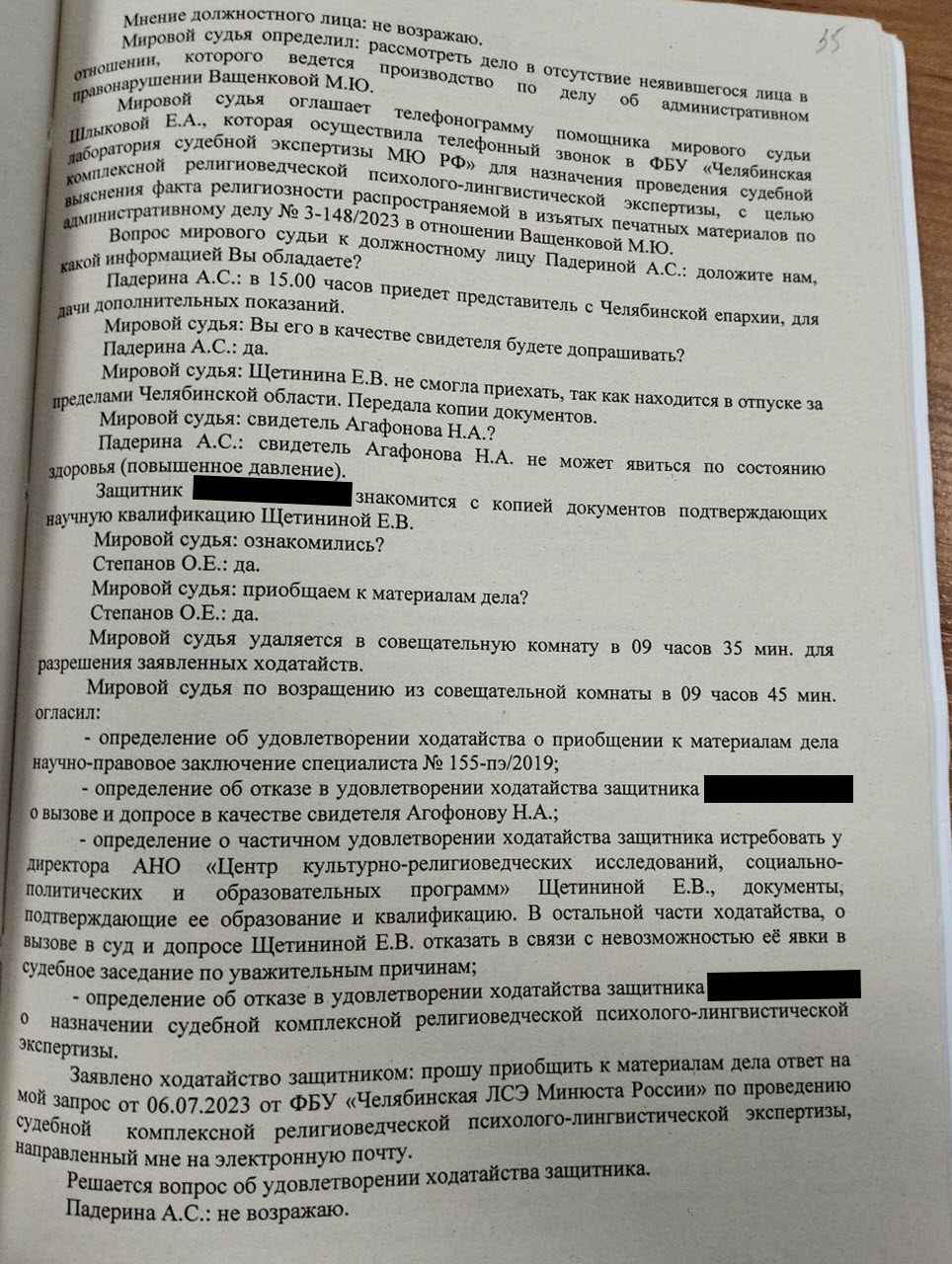
Photo 35: Excerpts from the court hearing transcript dated July 10, 2023, part 1
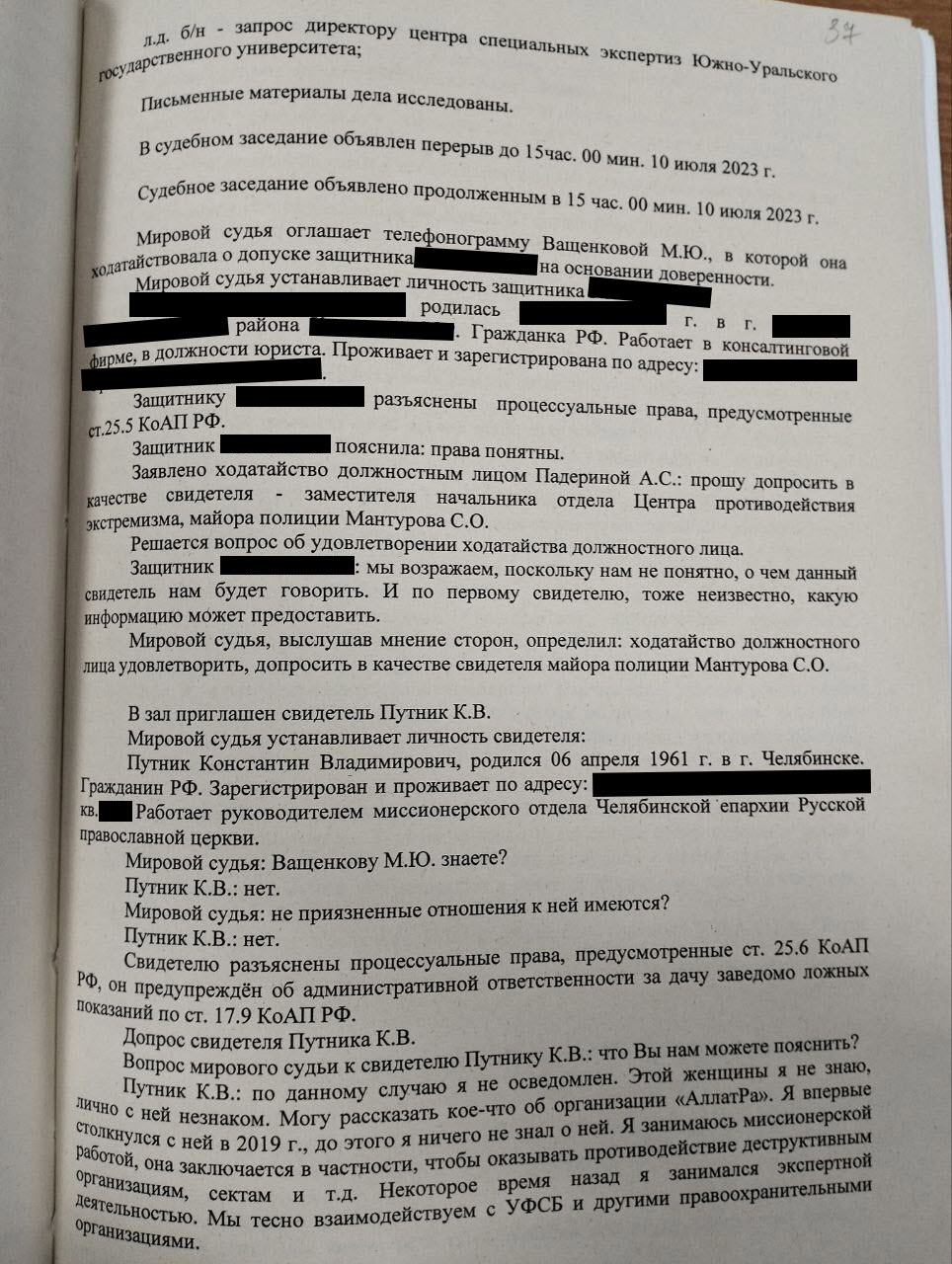
Photo 36: Excerpts from the court hearing transcript dated July 10, 2023, part 2
According to Part 1 of Article 25.6 of the CAO RF, a witness in an administrative offense case may be any person who may be aware of circumstances relevant to the case that are subject to establishment. Thus, the CAO RF establishes a specific category of individuals who may serve as witnesses in an administrative offense case. Namely, these are people who possess knowledge relevant to the particular case. However, if an official participated in the investigation of an administrative offense case, such individual may not act as a witness, as this would lead to subjectivity, interference in the judicial process, and distortion of facts.
When necessary, in administrative proceedings involving individuals accused of an administrative offense, it is permissible to summon the official who prepared the administrative offense protocol, to clarify specific questions (Section 10 of Ruling No. 5 of the Plenary Session of the Supreme Court of the Russian Federation, dated March 24, 2005, “About some questions arising at courts in case of application of the Russian Federation Code of Administrative Offences”). As explained in paragraph 1 of Section 10 of the above-mentioned Ruling of the Plenary Session of the Supreme Court, since the officials who prepare administrative offense protocols, as well as bodies and officials who issue rulings in administrative offense cases, are not considered participants in proceedings on administrative offenses (as defined in Chapter 25 of the CAO RF), they do not have the right to file motions or challenges.
Nonetheless, in violation of Article 25.6 of the CAO RF and the legal interpretations by the Supreme Court of the Russian Federation as set forth in the above-mentioned Plenary Session Ruling, Justice of the Peace S.I. Pridannikov granted the oral motion of the official (A.S. Paderina) who had prepared the administrative offense protocol to question individuals who were not present at the legally significant event on May 4, 2023, and who were not personally acquainted with the accused, M.Yu. Vashchenkova. Those individuals — K.V. Putnik, head of the missionary department of Chelyabinsk Diocese of the Russian Orthodox Church, which serves as a representative body of RACIRS, and S.O. Manturov, deputy head of the Department for Countering Extremism of the Center for Combating Extremism of the MD MIA of Russia, Chelyabinsk Region — were questioned as WITNESSES, as confirmed by the judge’s advisement of their rights as witnesses and their corresponding signatures [Volume 1, p. 136, Photo 37].
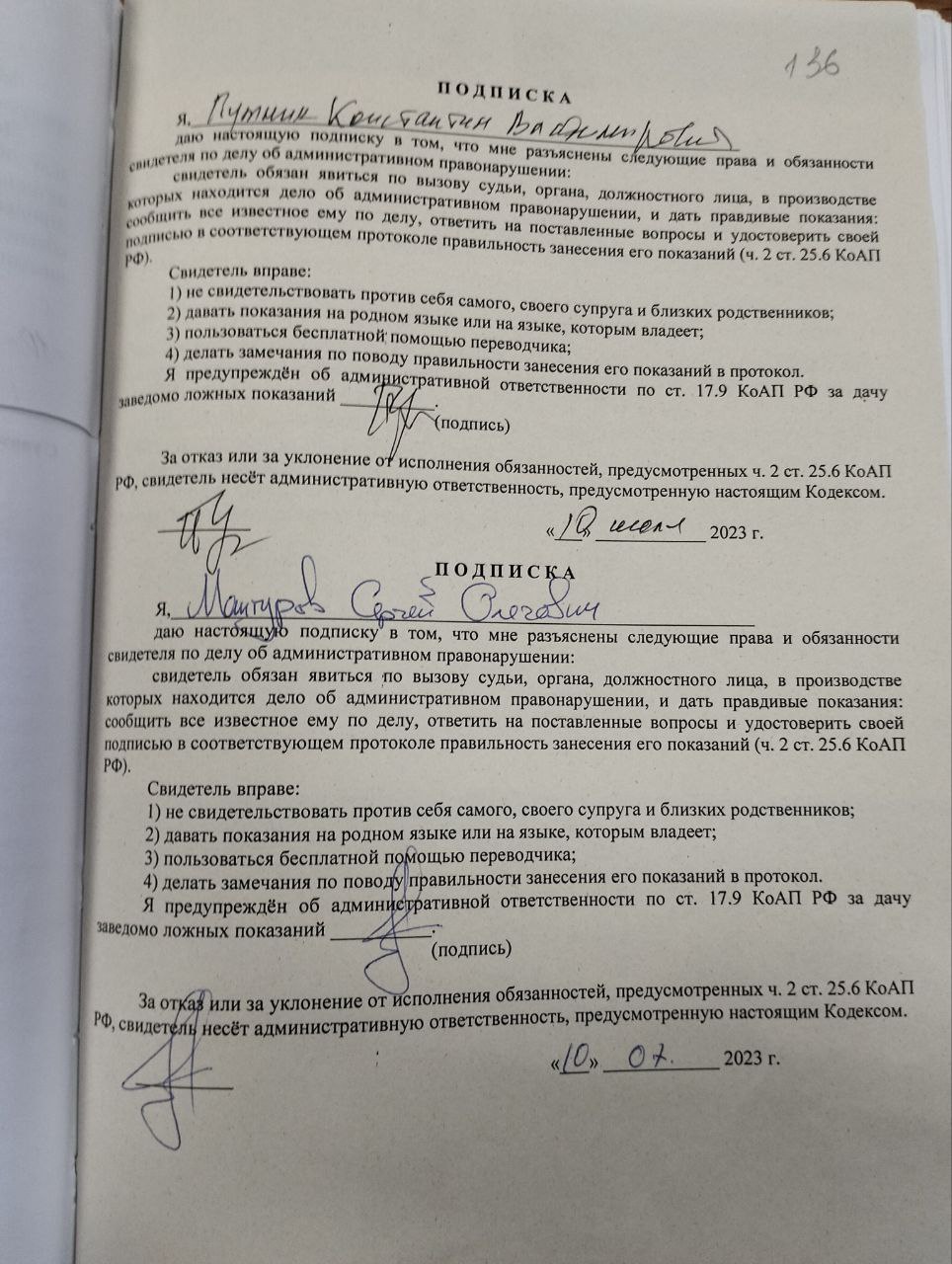
Photo 37: Acknowledgement signed by witnesses K.V. Putnik and S.O. Manturov, confirming that the judge explained their rights to them, dated July 10, 2023
Meanwhile, the official who executed the administrative offense protocol on June 28, 2023 (A.S. Paderina, precinct police officer of OUUP and PDN of the Department of the MIA of Russia for the Plast District, Chelyabinsk Region) wasn’t questioned by Justice of the Peace S.I. Pridannikov during the hearing.
At the same time, during the administrative offense hearing, witness S.O. Manturov stated that he knew M.Yu. Vashchenkova because he had been providing support in matters concerning religious violations related to missionary activity (court hearing transcript dated July 10, 2023 [Vol. 2, p. 42, Photo 38; p. 5 of the ruling by Justice of the Peace S.I. Pridannikov, Photo 39]).
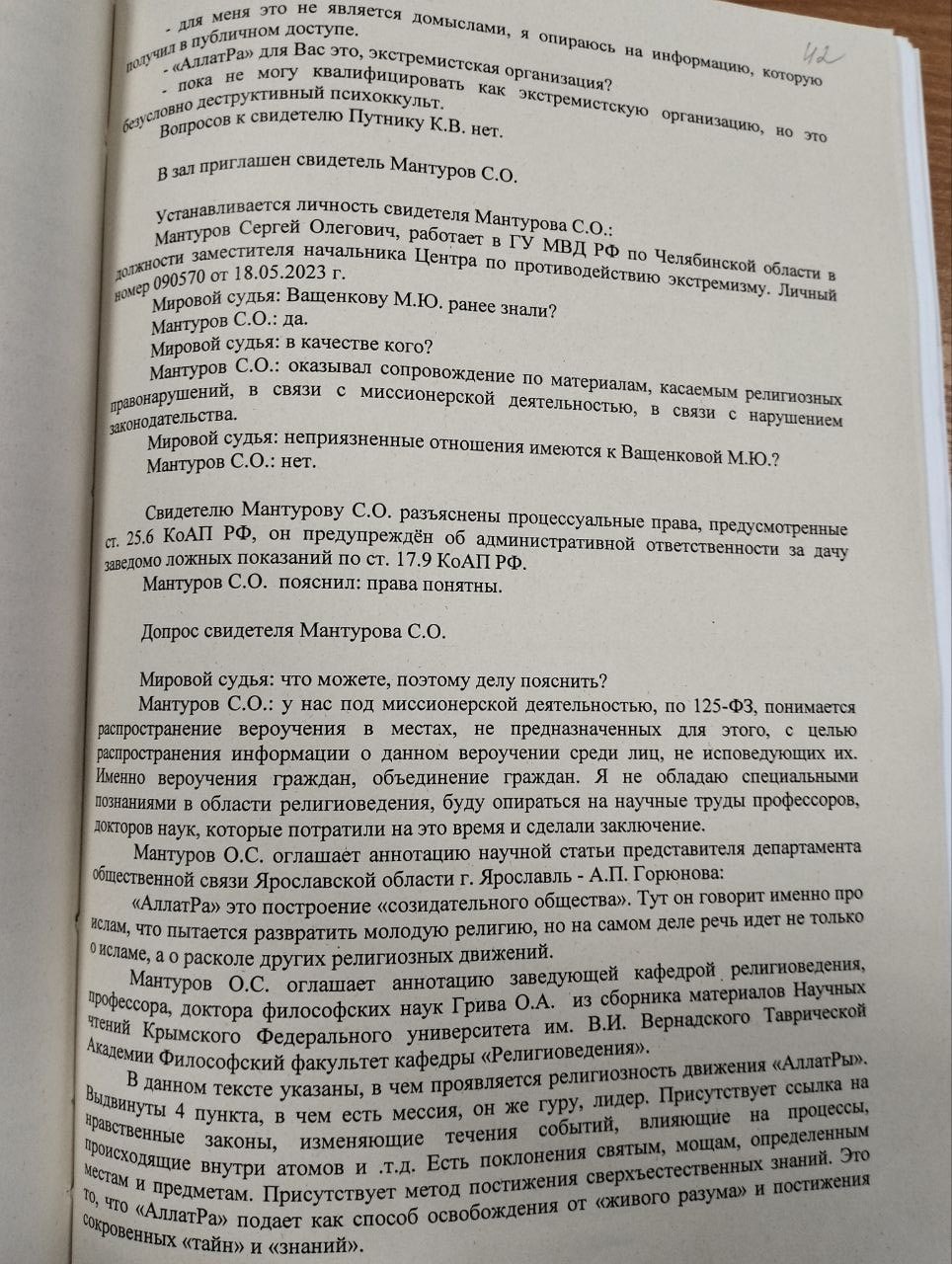
Photo 38: Excerpts from the court hearing transcript dated July 10, 2023
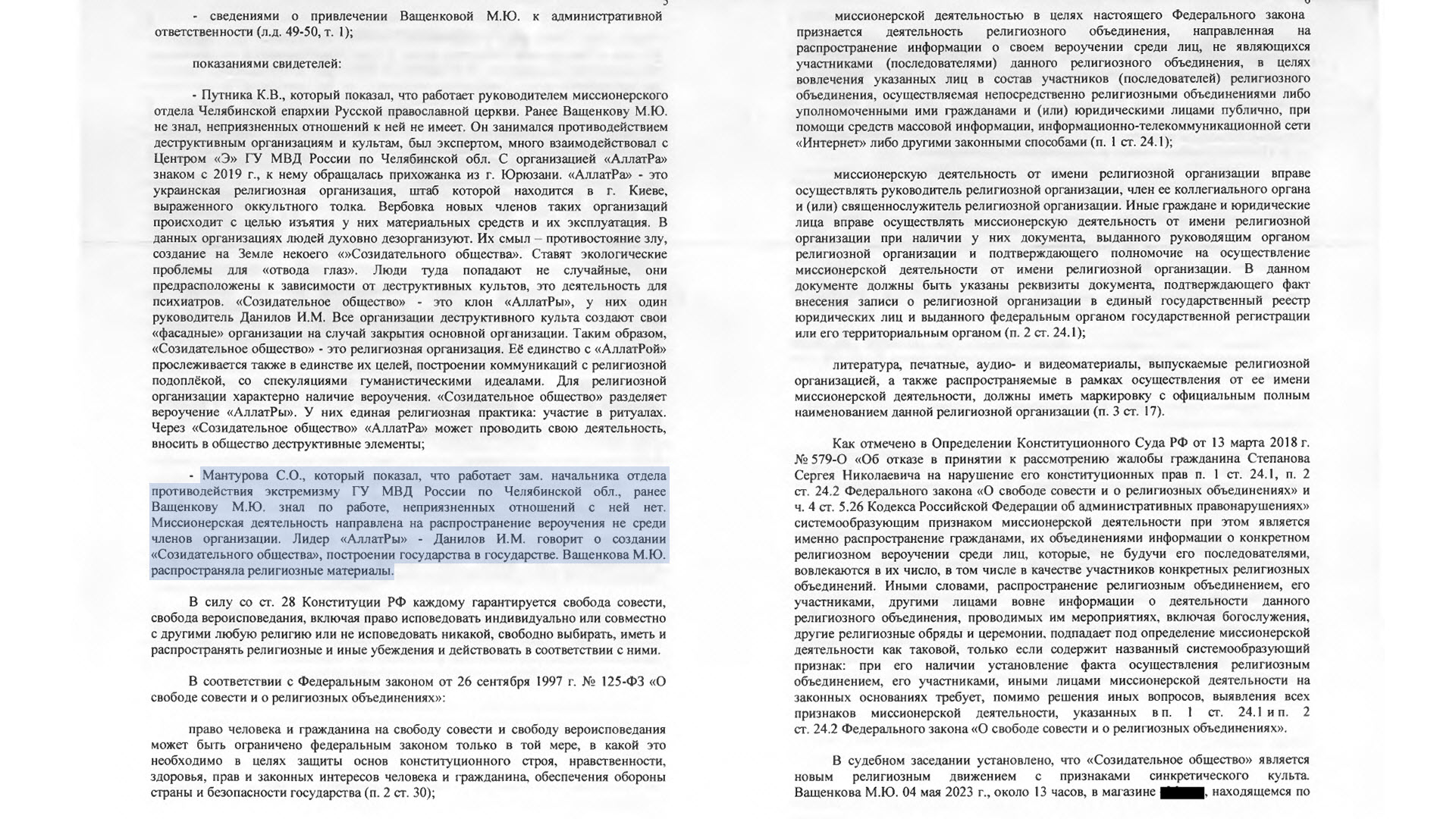
Photo 39: Page 5 of the ruling by Justice of the Peace S.I. Pridannikov
Manturov’s involvement in executing documents for the investigation materials is confirmed by the note “Prepared by S.O. Manturov” on a letter from the MD MIA of Russia, Chelyabinsk Region, regarding the provision of information, dated May 23, 2023, No. 6/575 [Vol. 1, p. 28, Photo 40].
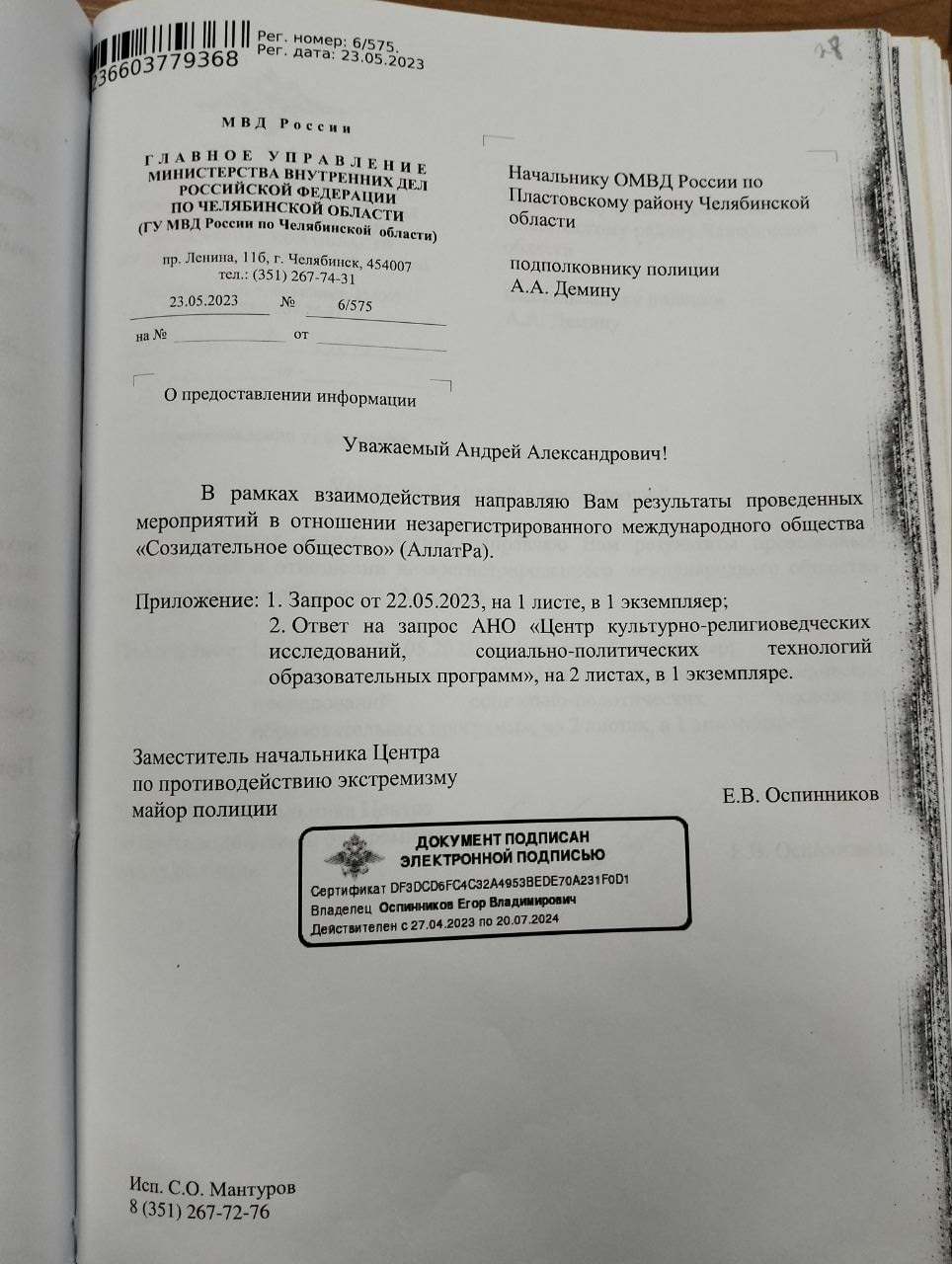
Photo 40: Letter from the MD MIA of Russia, Chelyabinsk Region, regarding the provision of information, dated May 23, 2023, No. 6/575
Meanwhile, S.O. Manturov wasn’t personally acquainted with M.Yu. Vashchenkova and wasn’t present at the store where she worked on May 4, 2023 — the date of the legally significant event. Accordingly, the statements made by Manturov during the administrative hearing cannot be considered objective or free from interest in the outcome of the case. In addition, S.O. Manturov brought photocopies of negative articles about ALLATRA IPM to the court and read excerpts from them out loud. However, a witness reading any text out loud during testimony is inadmissible.
Attention should be drawn to the articles S.O. Manturov brought to court:
- Goryunov, A.P. Radicalism of “AllatRa” in the Paradigm of Islam. Scientific Bulletin of the Omsk Academy of the Ministry of Internal Affairs. No. 3 (82), 2021 [Photos 41-42]
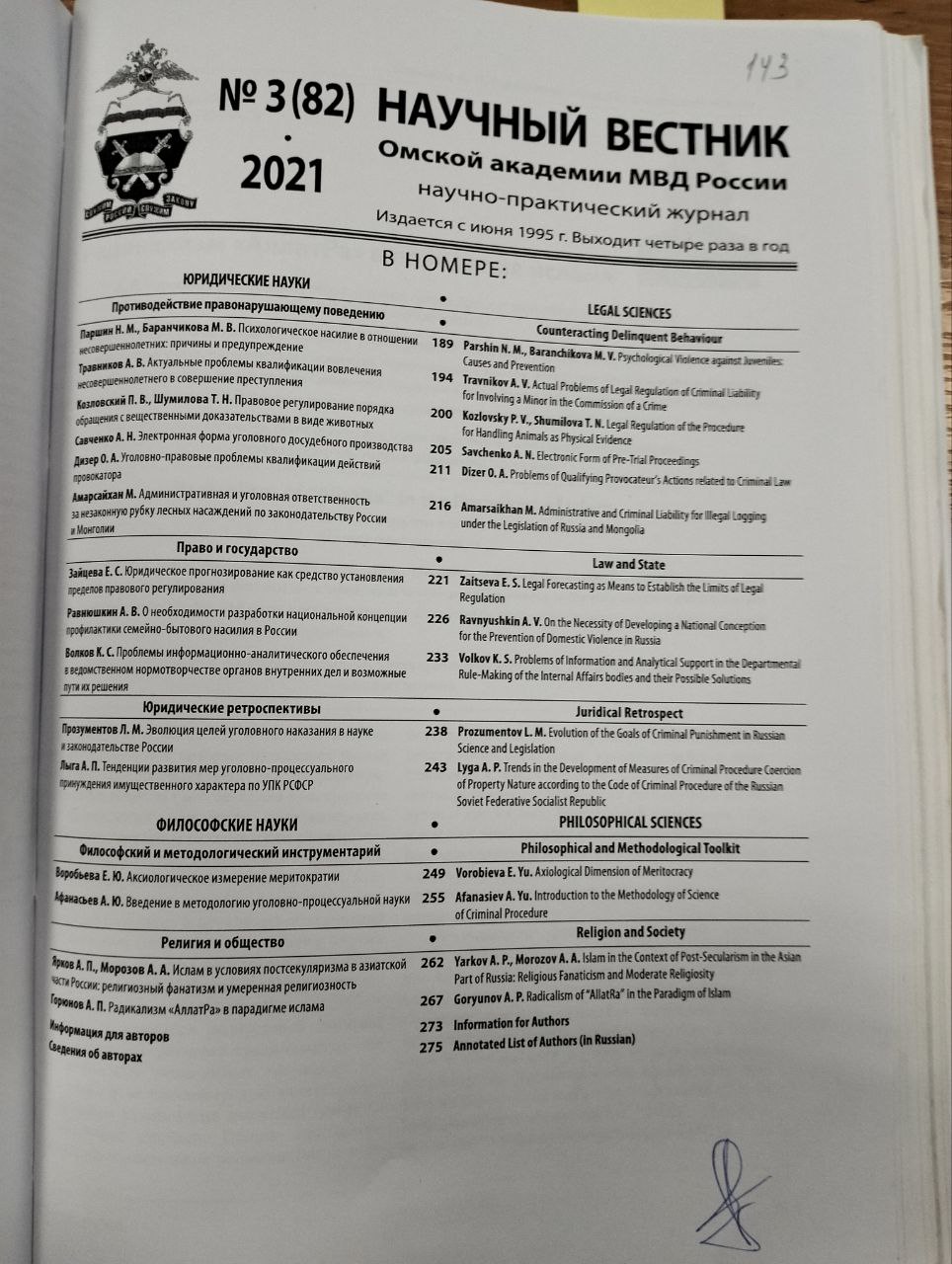
Photo 41: Goryunov, A.P. Radicalism of “AllatRa” in the Paradigm of Islam. Scientific Bulletin of the Omsk Academy of the Ministry of Internal Affairs. No. 3 (82), 2021
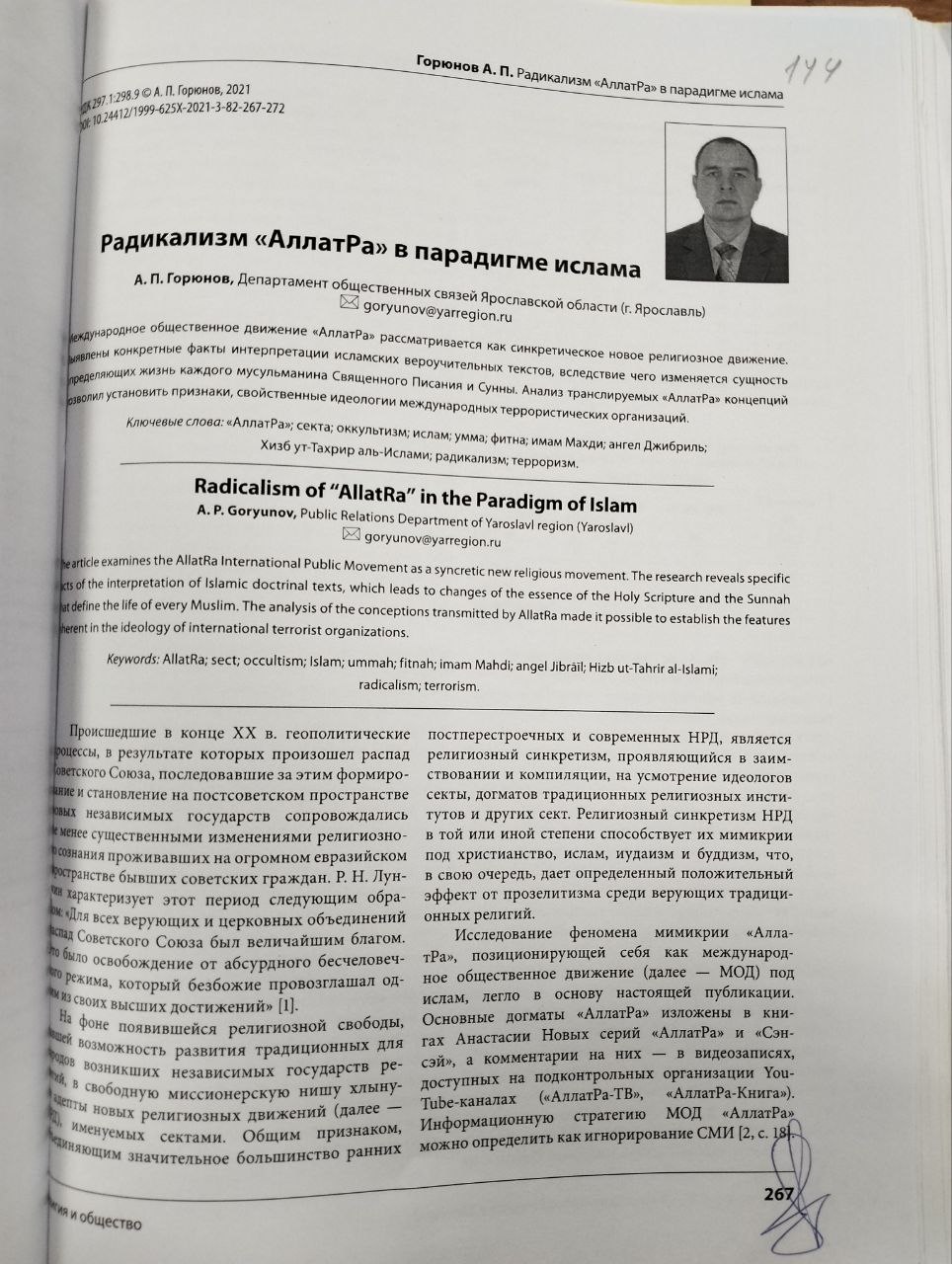
Photo 42: Goryunov, A.P. Radicalism of “AllatRa” in the Paradigm of Islam. Scientific Bulletin of the Omsk Academy of the Ministry of Internal Affairs. No. 3 (82), 2021
- Griva, O.A. About Illegal Missionary Activities of New Religious Movements (on the example of ALLATRA IPM). Religion. Society. Human.: Academic Collection / compiled by Yu.V. Normanskaya. — Simferopol: IT Arial, 2019. — 157 pp. [Photos 43-45]
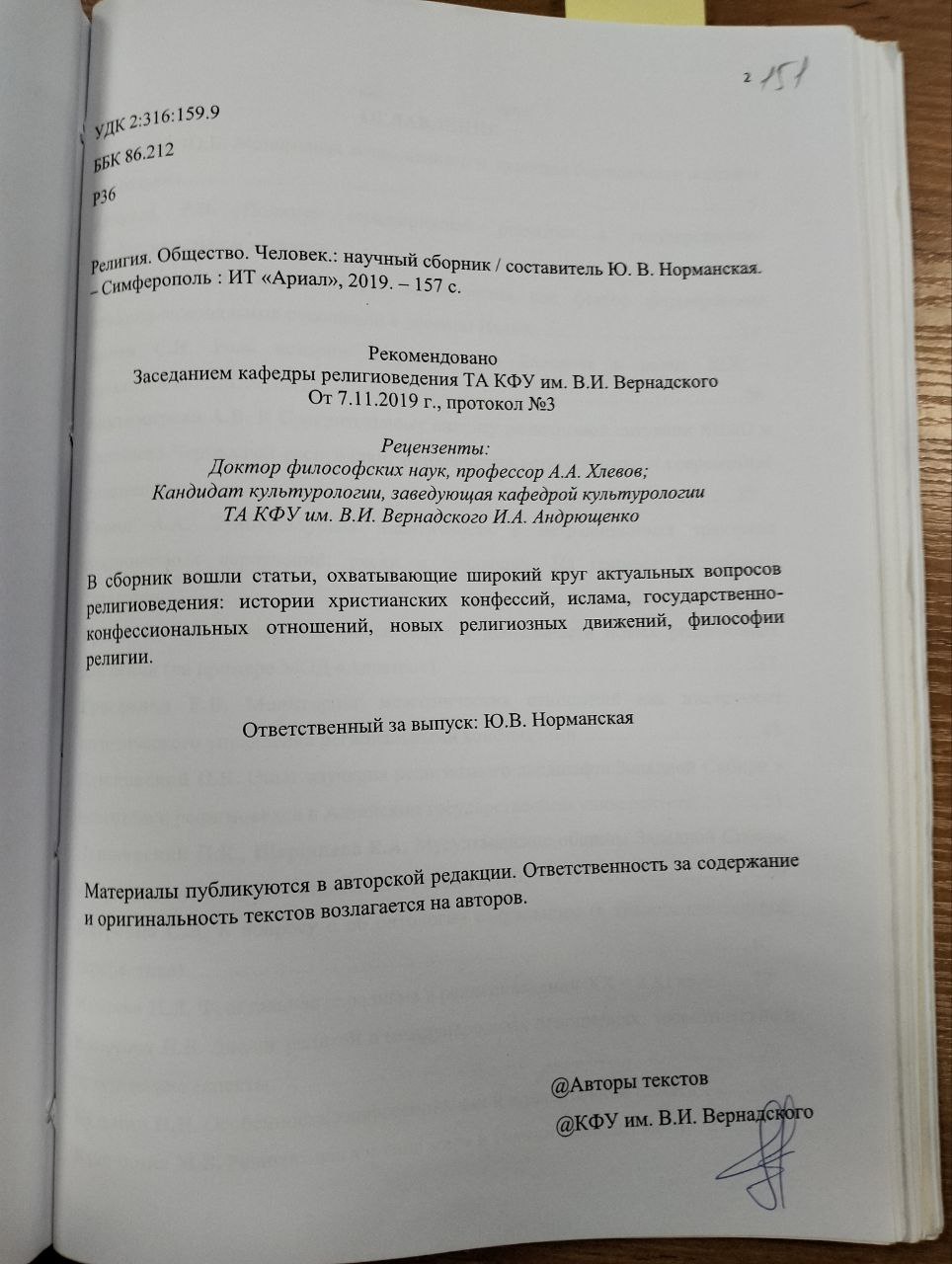
Photo 43: Griva, O.A. About Illegal Missionary Activities of New Religious Movements (on the example of ALLATRA IPM). Religion. Society. Human.: Academic Collection / compiled by Yu.V. Normanskaya. — Simferopol: IT Arial, 2019, part 1
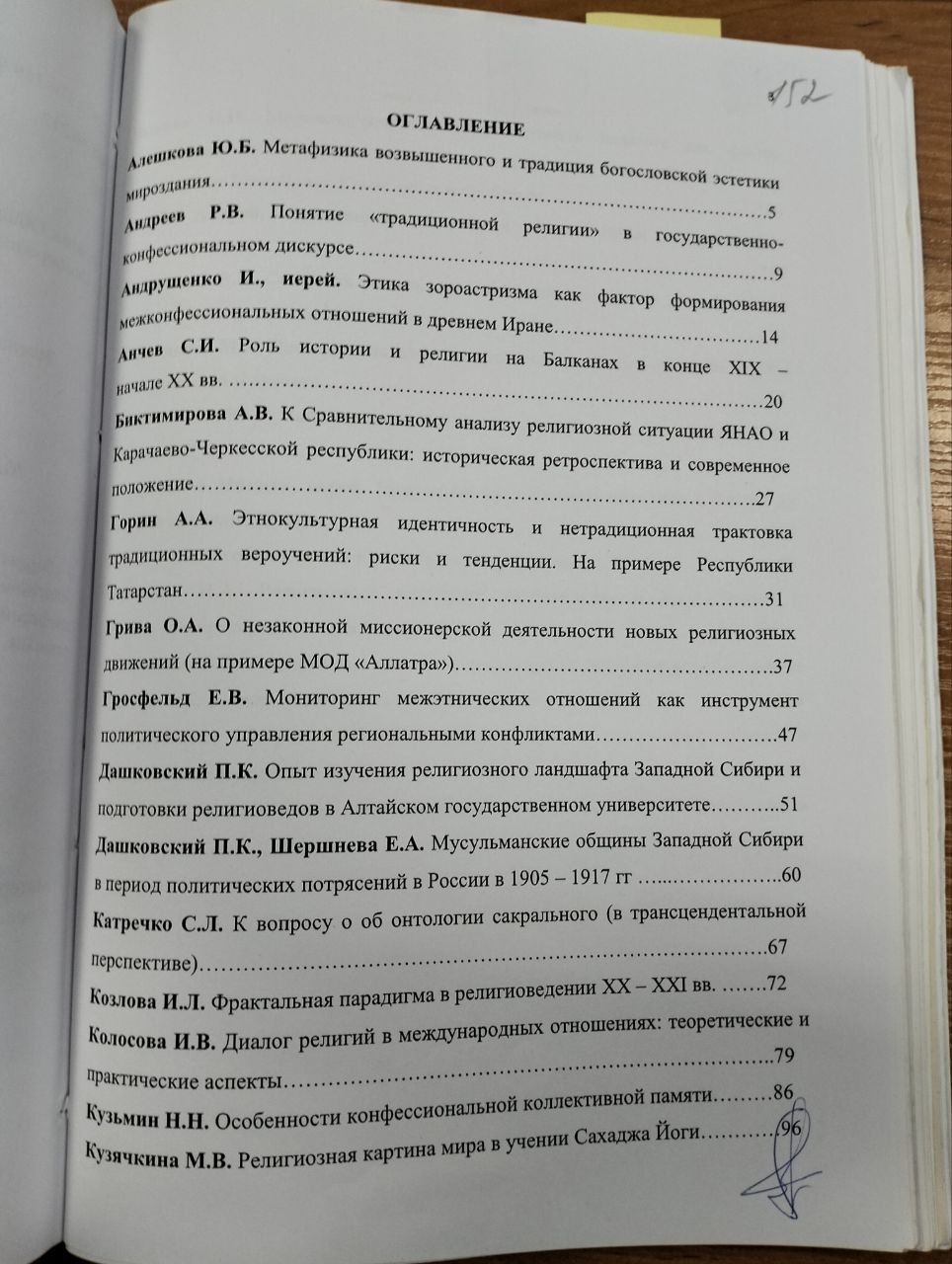
Photo 44: Griva, O.A. About Illegal Missionary Activities of New Religious Movements (on the example of ALLATRA IPM). Religion. Society. Human.: Academic Collection / compiled by Yu.V. Normanskaya. — Simferopol: IT Arial, 2019, part 2
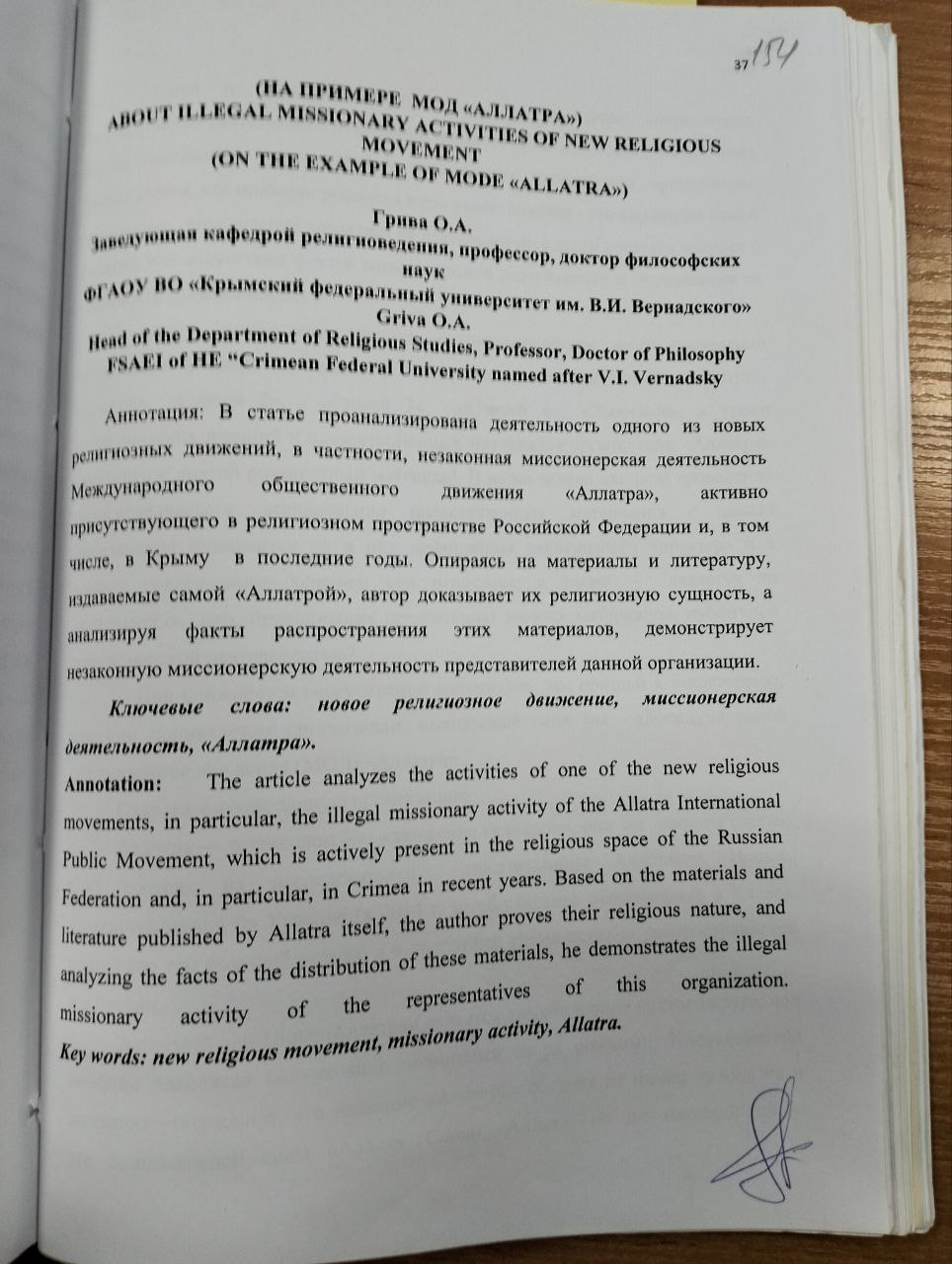
Photo 45: Griva, O.A. About Illegal Missionary Activities of New Religious Movements (on the example of ALLATRA IPM). Religion. Society. Human.: Academic Collection / compiled by Yu.V. Normanskaya. — Simferopol: IT Arial, 2019, part 3
- Bersenev, I.S., Starostin, A.N. The International Public Movement “ALLATRA” as the Religious Movement of a New Type. International Cooperation of Eurasian States: Politics, Economy, Law. No. 1, 2023 [Photo 46]
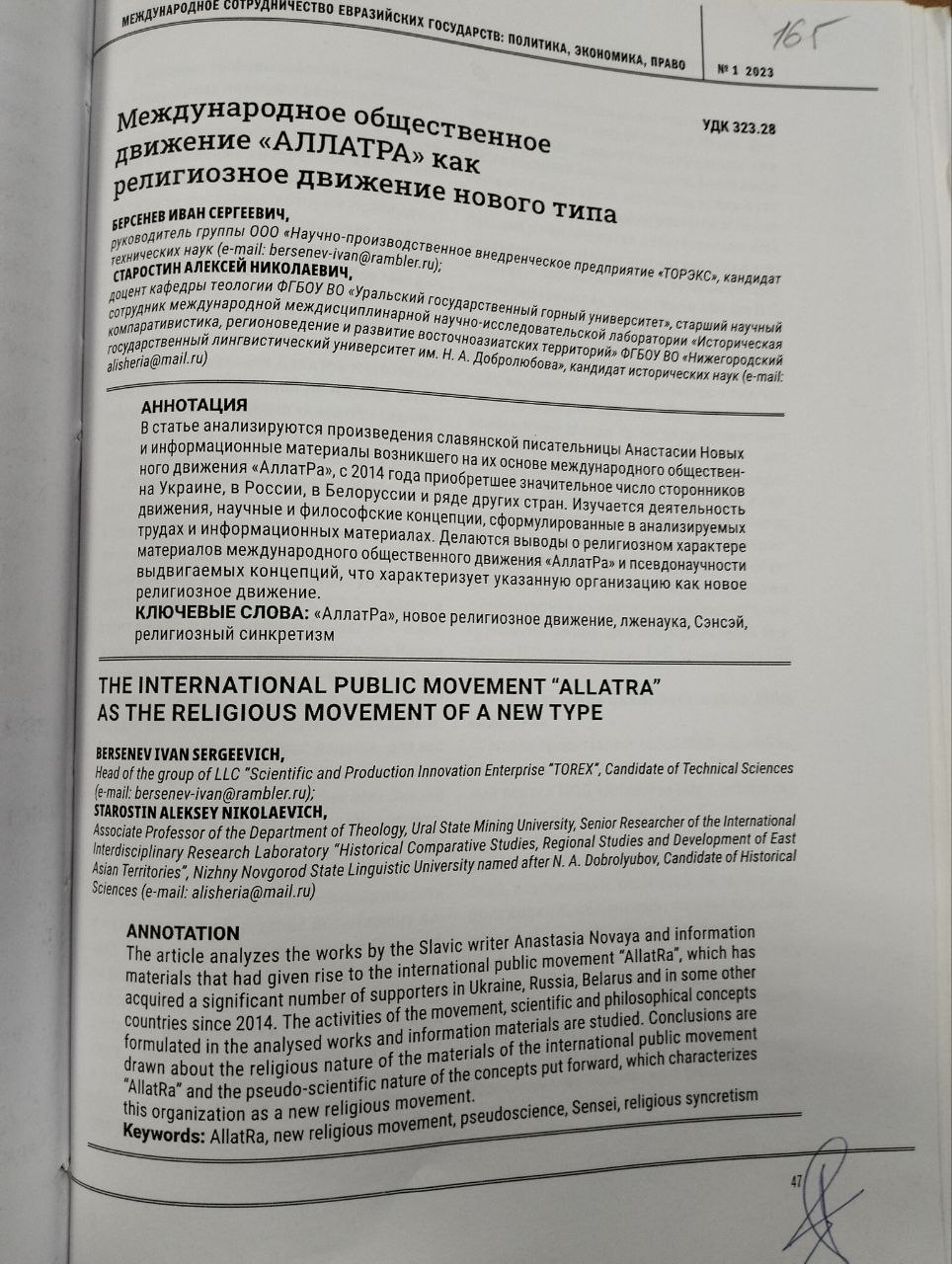
Photo 46: Bersenev, I.S., Starostin, A.N. The International Public Movement “ALLATRA” as the Religious Movement of a New Type. International Cooperation of Eurasian States: Politics, Economy, Law. No. 1, 2023
Moreover, while testifying in court as a witness and without having the procedural right to do so, S.O. Manturov submitted a motion to attach these photocopies to the case file. All of the actions by S.O. Manturov, as well as Justice of the Peace S.I. Pridannikov’s agreement to them, constituted a violation of judicial procedure in the administrative offense case, since a witness may only testify, and nothing more.
It is also noteworthy that, since a witness is not among the parties to the case who are entitled to request that evidence be added to the case files (Chapter 25 of the CAO RF), he or she has no right to submit any materials for inclusion as independent evidence.
Furthermore, neither the person subject to the administrative proceedings nor the victim or the defense submitted any motion to attach the articles S.O. Manturov brought to court. Nevertheless, in violation of the established procedural rules, Justice of the Peace S.I. Pridannikov personally asked S.O. Manturov to hand over the articles from which the witness had read excerpts in order to include them in the case files, despite the defense’s lawful objection. Still, Justice of the Peace S.I. Pridannikov showed some measure of prudence by taking a critical view of the photocopied journal articles. In his ruling of July 14, 2023, he noted that “it is impossible to verify their authenticity.” However, instead of returning them to S.O. Manturov during the court session, as required by law, Justice of the Peace S.I. Pridannikov attached those so-called “academic works” to the case files. This raises a logical question: for what purpose? Who had an interest in retaining those pseudoscientific articles in the case files, and why? The names of the pseudo-scholars who authored the commissioned pseudoscientific articles seem all too familiar, and they all share the same sponsor: RACIRS.
These circumstances suggest an existence of a criminal collusion involving police major S.O. Manturov, justice of the peace S.I. Pridannikov, pseudo-scholars A.P. Goryunov, O.A. Griva, I.S. Bersenev, A.N. Starostin, and the head of RACIRS, Alexander Dvorkin. This will be discussed in more detail at the conclusion of Part I of this legal investigation.
As recorded in the court hearing transcript dated July 10, 2023, witness K.V. Putnik had no specific knowledge of this particular incident. He does not know M.Yu. Vashchenkova. Moreover, he stated, “We work closely with the FSB and other law enforcement agencies” [Vol. 2, p. 37, Photo 36]. This fact points to bias and a vested interest on the part of this individual in favor of law enforcement. He had been invited to say something about the activities of ALLATRA [Vol. 2, pp. 38–39, Photos 47-48].
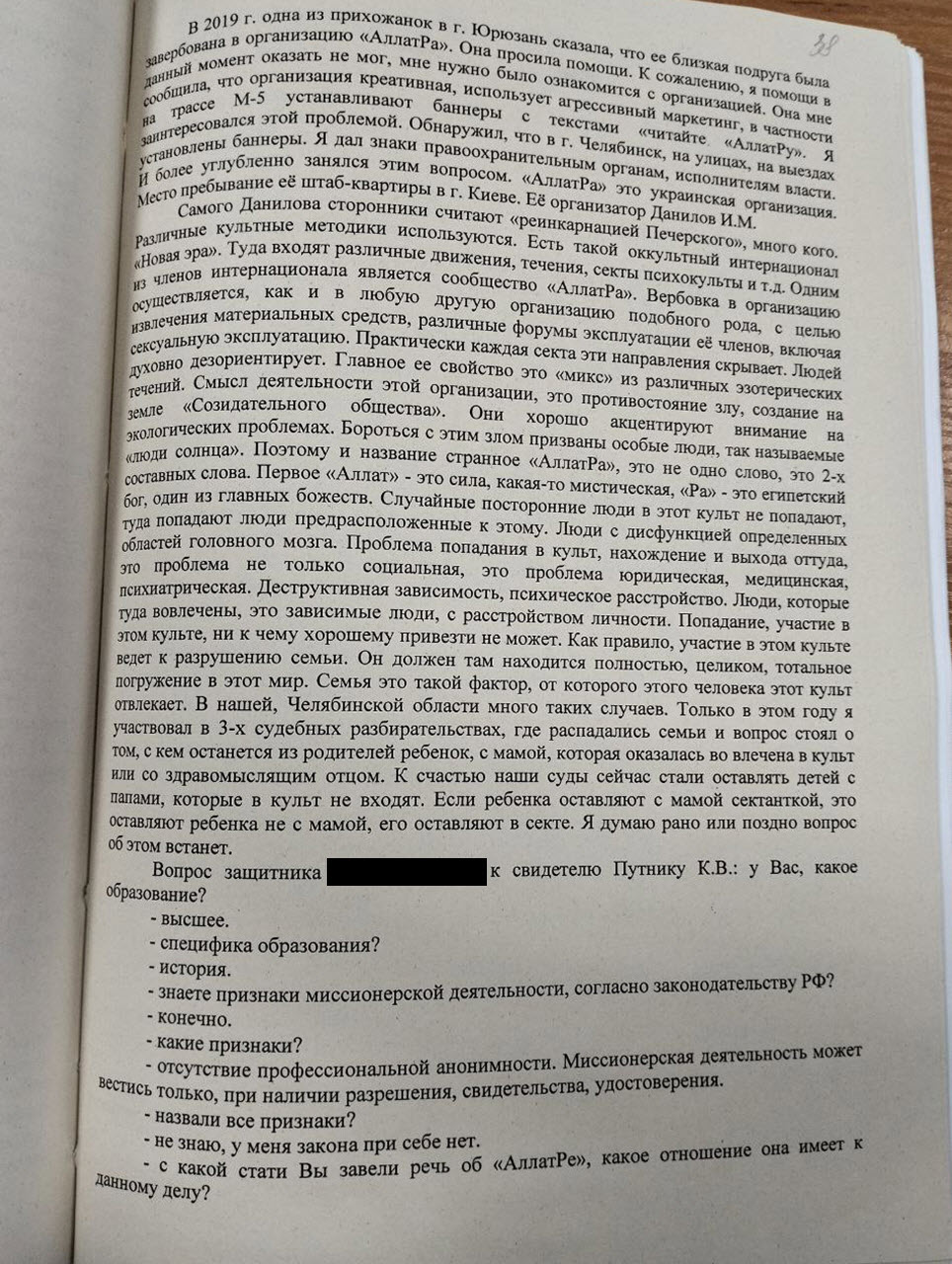
Photo 47: Excerpts from the court hearing transcript dated July 10, 2023
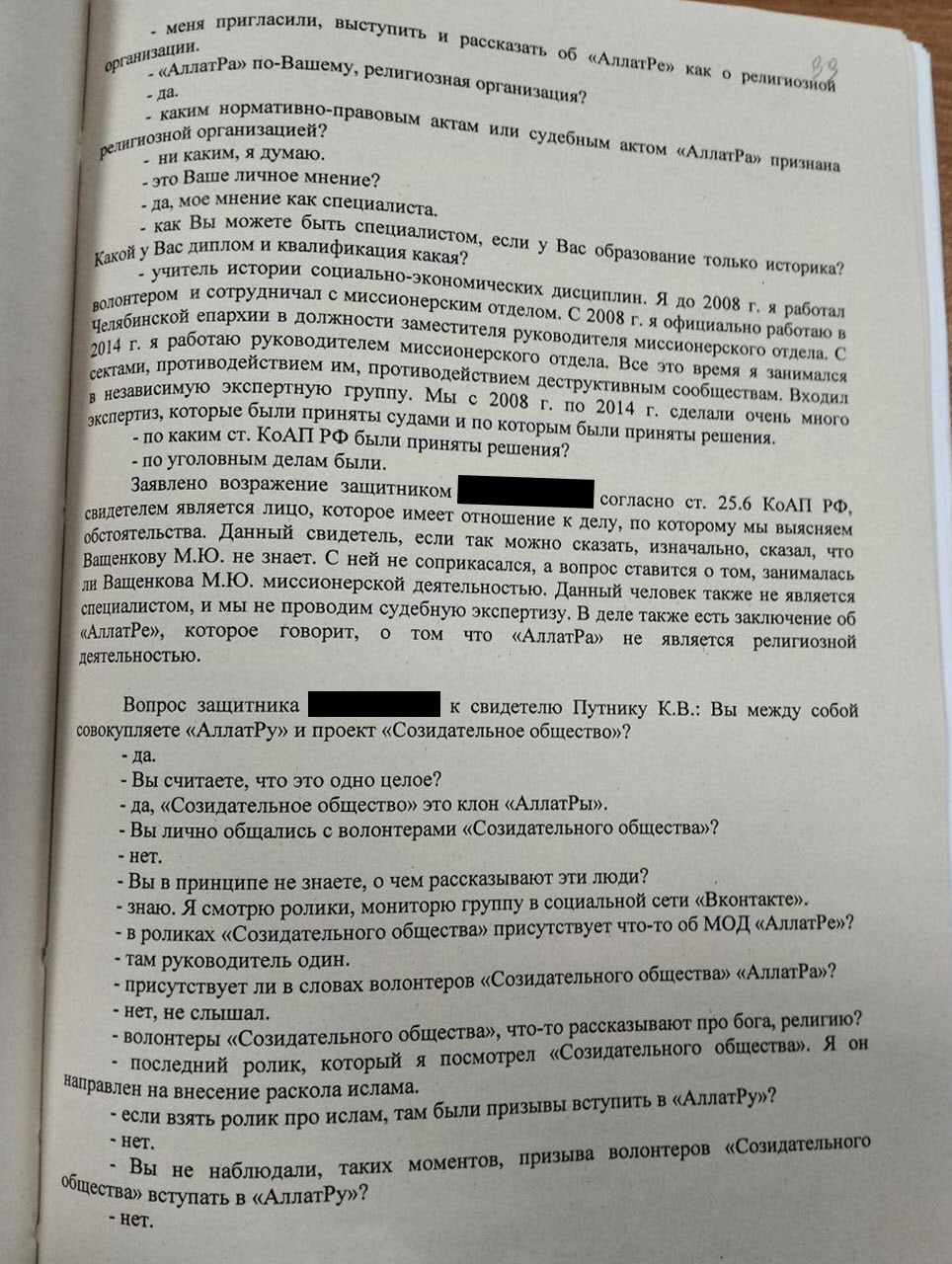
Photo 48: Excerpts from the court hearing transcript dated July 10, 2023
This so-called witness, this supposed expert, is in fact a graduate of a pedagogical institute and a teacher of history. Nevertheless, he gave the following characterization of ALLATRA IPM participants: “Random outsiders don’t end up in this cult. People who get in are predisposed to it. Those are people with dysfunction in certain regions of their brain. The problem of entering a cult, being in one, and leaving it is not just a social problem — it’s a legal, medical, and psychiatric one. There’s destructive dependency and mental disorder. People who get involved are addicted and have personality disorders. Being drawn into and involved in this cult leads to nothing good. As a rule, involvement in this cult results in destruction of one’s family.”
This so-called expert also made the following affirmative statement about ALLATRA IPM: “I was invited to speak and describe ALLATRA as a religious organization.” When asked by M.Yu. Vashchenkova’s attorney, “Do you consider ALLATRA a religious organization?” Putnik answered: “I do.” When asked, “Which legal or judicial act designates ALLATRA as a religious organization?” he replied: “None, I believe.” When Vashchenkova’s attorney asked him, “Is this your personal opinion?” Putnik responded. “Yes, it’s my opinion as an expert.”
Yet, K.V. Putnik was summoned by the court as a witness, not as an expert. It is also important to note that no documents certifying his alleged qualifications were presented to the court, nor has anyone seen them. Moreover, Putnik himself told the court that he’s no longer engaged in expert activity.
Attention must also be drawn to the printed materials allegedly seized from witness N.A. Agafonova, which contain only information about the Creative Society project and make no mention of ALLATRA. In the meantime, the prosecution’s witnesses who were unlawfully involved in the case were unfamiliar with activities of the Creative Society project. They offered no objective arguments establishing any connection between Creative Society and ALLATRA IPM, which is also confirmed by the court hearing transcript dated July 10, 2023. When asked by the defense, “Who told you that one organization is a clone of the other?” Putnik responded, “I said so.” [Vol. 2, p. 40, Photo 49].
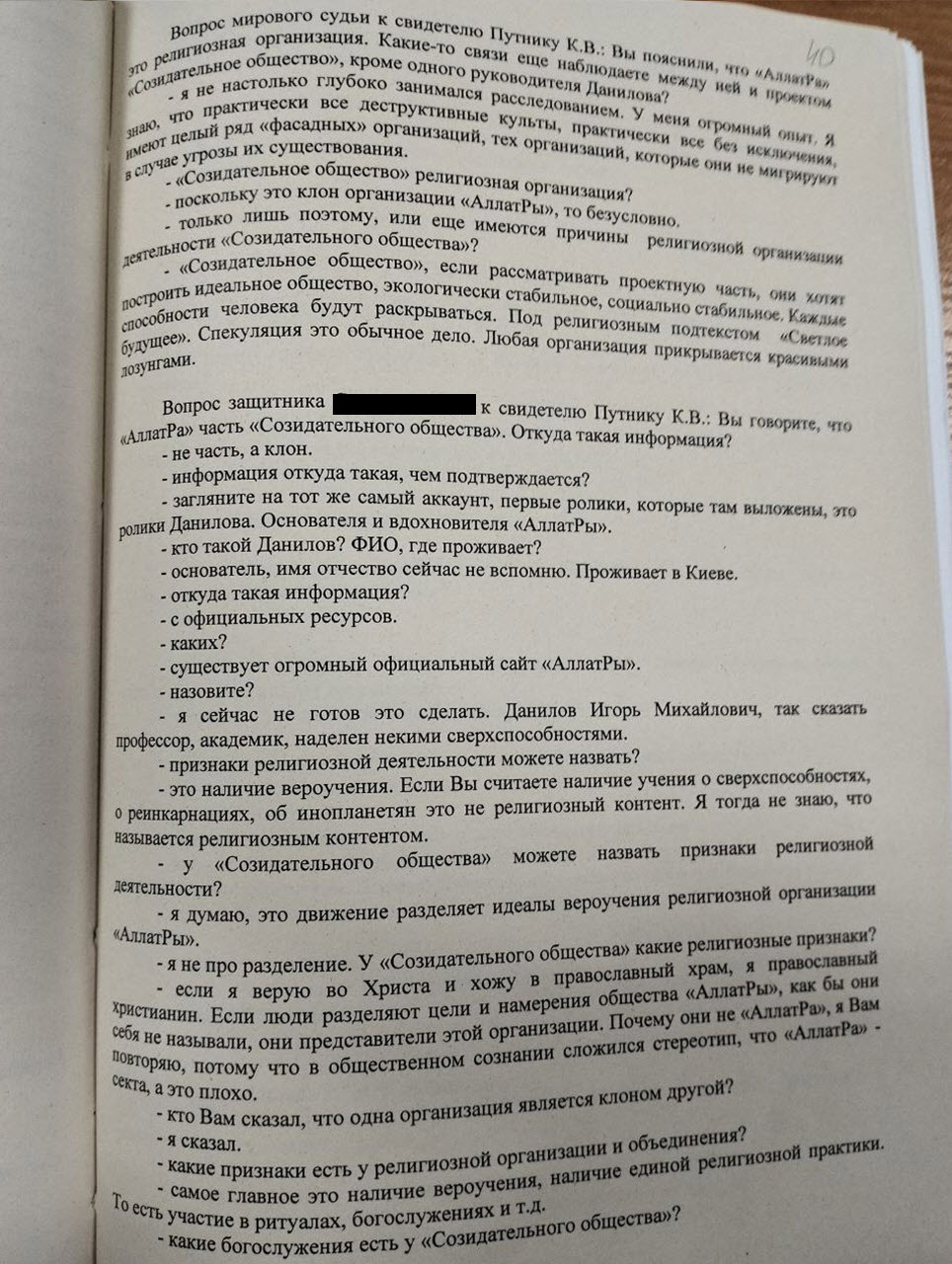
Photo 49: Excerpts from the court hearing transcript dated July 10, 2023
This raises a logical question: Is K.V. Putnik a religious scholar, a psychiatrist, and apparently also a legal expert, all rolled into one? Not only did Justice of the Peace S.I. Pridannikov listen to his nonsense, but he didn’t stop it. He actually relied on it in rendering his ruling, thereby deciding the fate not only of one individual, but effectively of an entire international public movement and a global public volunteer project.
The above indicates that the assumption that ALLATRA IPM is merely a clone of the Creative Society project, which is the premise underlying the ruling issued by Justice of the Peace S.I. Pridannikov, is not supported by credible evidence and is therefore inadmissible. It is based on the speculation and reasoning of private citizen K.V. Putnik who, under the CAO RF, doesn’t even qualify as a proper witness.
Based on clarifications provided by the Plenary Session of the Supreme Court of the Russian Federation in Section 18 of its Ruling No. 5 dated March 24, 2005, “About some questions arising at courts in case of application of the Russian Federation Code of Administrative Offences,” all evidence in an administrative offense case must be assessed according to Article 26.11 of the CAO RF and with due regard for the lawfulness of its collection (Part 3 of Article 26.2 of the CAO RF). Under Article 26.11 of the CAO RF, the judge presiding over an administrative offense case must evaluate the evidence based on his or her own inner conviction formed by a comprehensive, full, and objective review of all circumstances of the case in their totality. No piece of evidence may be given predetermined weight.
According to Part 3 of Article 26.2 of the CAO RF, the judge considering or reconsidering an administrative offense case must assess evidence not only for its relevance and admissibility, but also for its reliability (Constitutional Court Rulings No. 1086-О-О of July 6, 2010, No. 884-О of May 29, 2012, No. 1817-О of September 18, 2014, and No. 1731-О of July 19, 2016). In accordance with Article 26.2 of the CAO RF, any evidence in an administrative offense case obtained in violation of the law is inadmissible.
Therefore, based on the aforesaid, it follows that K.V. Putnik and S.O. Manturov were unlawfully summoned by justice of the peace S.I. Pridannikov as witnesses, and their testimonies could not have been taken into account as admissible evidence because it was obtained in violation of the law and thus could not have served as a valid basis for the court ruling.
Furthermore, K.V. Putnik and S.O. Manturov who were questioned during the July 10, 2023 hearing had not been eyewitnesses to the alleged offense described in the administrative offense protocol, nor were they the officials who had executed that protocol. It is also noteworthy that neither K.V. Putnik nor S.O. Manturov were involved as witnesses during the stages of the investigation and evidence collection. Materials submitted to the justice of the peace contain no statements from either of these individuals, further confirming that Justice of the Peace S.I. Pridannikov involved them in the case as witnesses unlawfully.
It should also be emphasized that during the proceedings on the administrative offense case, a procedural action was undertaken: seizure of the items of offense (a booklet and a newspaper (gaSHeta), according to the seizure protocol dated May 4, 2023 [Vol. 1, p. 13, Photo 8]) in the presence of two attesting witnesses who, if necessary, could have been questioned in accordance with Article 25.6 and Part 5 of Article 25.7 of the CAO RF. However, Justice of the Peace S.I. Pridannikov did not summon those individuals to testify in court, thus violating the principle of comprehensive, complete, and objective consideration of the case as established by Article 26.11 of the CAO RF. This, in turn, constitutes grounds for overturning the ruling issued by this judge.
3. In issuing the ruling on case No. 3-148/2023 on July 14, 2023, justice of the peace S.I. Pridannikov committed gross violations of the evidence evaluation
In accordance with Article 26.11 of the CAO RF, a judge handling an administrative offense case must evaluate the evidence based on their inner conviction, which is founded on a comprehensive, thorough, and objective examination of all the circumstances of the case in their entirety. No evidence may have predetermined weight. Information about facts can serve as evidence only if it has been obtained in accordance with the requirements of current legislation, that is, without any violations of the law.
- The request No. 77/b/n dated 20.05.2023, from A.A. Asadullin, police chief of the Department of the MIA of Russia for the Plast District, Chelyabinsk Region, addressed to police colonel I.V. Yelesin, head of the Center for Combating Extremism of the MD MIA of Russia, Chelyabinsk Region, concerned the provision of information about the Creative Society organization. The request included an attached brochure (1 page) and a printed publication (16 pages) [Vol. 1, p. 27, Photo 16].
- This request did not contain an instruction to perform specific actions or to take any additional measures. It only requested the provision of any available information. Also, the request didn't include any references to ALLATRA IPM or to materials related to ALLATRA IPM. In other words, the initial materials (the report of the offense, statements, protocol of seizure, and printed materials) collected by the Department of the MIA of Russia for the Plast District and sent to the Center for Combating Extremism of the MD MIA of Russia, Chelyabinsk Region, — as well as the request itself — refer only to the Creative Society.
At the same time, colonel I.V. Yelesin, head of the Center for Combating Extremism of the MD MIA of Russia, Chelyabinsk Region, did not delegate the execution of the request to his deputy, E.V. Ospinnikov, which is confirmed by the absence of a resolution by colonel Yelesin on the given request. Nonetheless, E.V. Ospinnikov independently took the request into his own proceedings and carried out procedural actions without having legal authority to do so, since no one had assigned him this task. Therefore, in this respect, he exceeded his official authority, which constitutes a violation.
E.V. Ospinnikov, deputy head of the Center for Combating Extremism of the MD MIA of Russia, Chelyabinsk Region, should have simply provided available information about the Creative Society or responded that no such information existed. Instead, he carried out measures not requested by A.A. Asadullin [Vol. 1, p. 27, Photo 16], namely, he issued a research assignment No. 6/526 dated May 22, 2023, to ANO "Center for Cultural and Religious Studies, Socio-Political Technologies, and Educational Programs" [Vol. 1, p. 30, Photo 50].
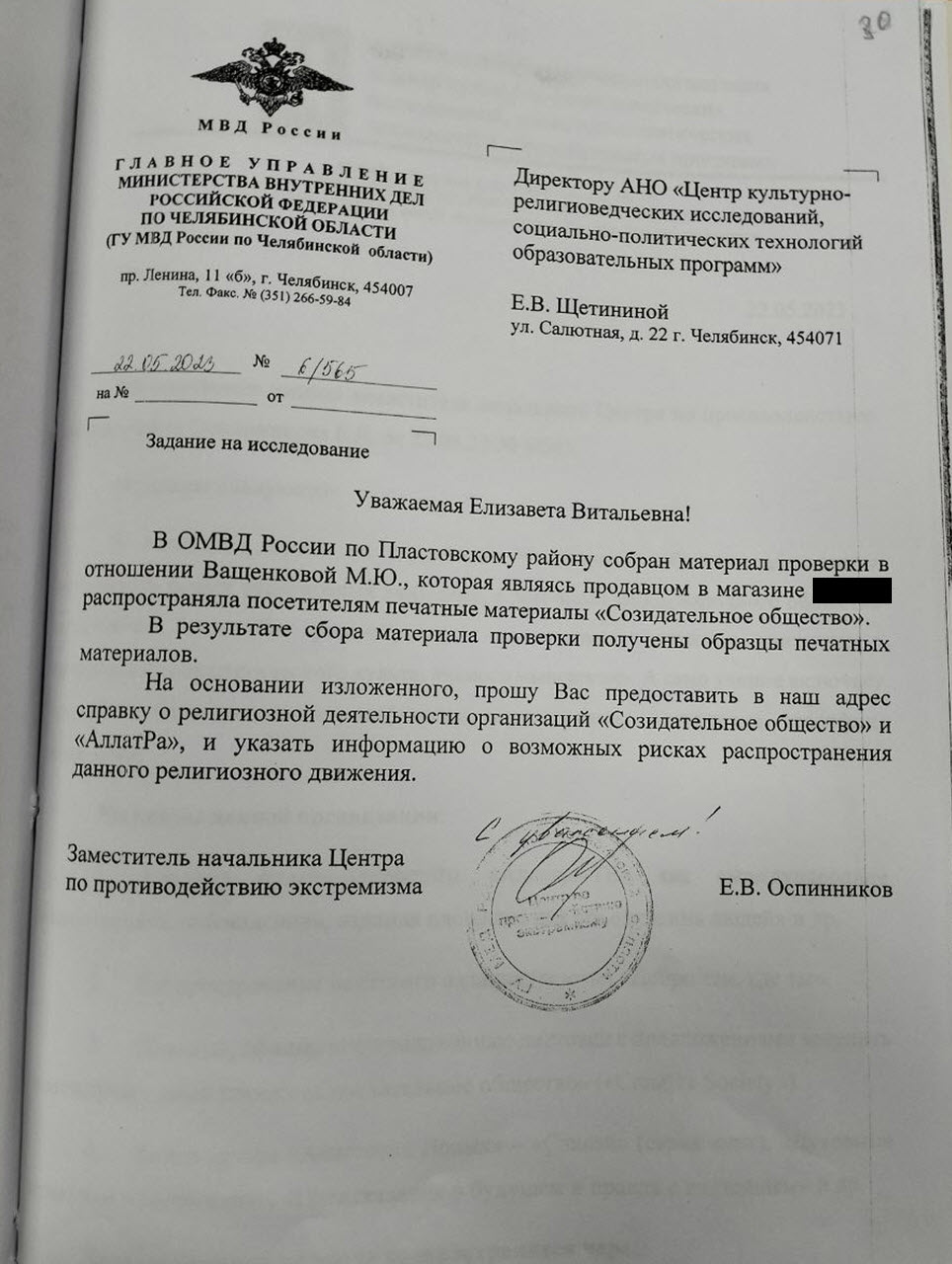
Photo 50: Research assignment No. 6/526 dated May 22, 2023, to ANO "Center for Cultural and Religious Studies, Socio-Political Technologies, and Educational Programs"
This constitutes a violation of Part 1, Article 26.9 of the CAO RF, which states that, in order to obtain evidence in a case of administrative offense, the official who handles the case has the right to send requests to relevant territorial bodies or assign the performance of specific actions provided for by the CAO RF to an official of the appropriate territorial body. Thus, without being instructed by the official in charge of the case or their superior to perform specific actions, E.V. Ospinnikov acted outside the scope of the original request from the Department of the MIA of Russia for the Plast District regarding the provision of information.
Furthermore, the authority to issue a ruling to assign an expert assessment is vested in the person handling the case, according to Article 26.4 of the CAO RF. Not being the official in charge of the case, E.V. Ospinnikov had no right to issue a ruling on the assignment of an expert assessment, yet he essentially assigned such an assessment. Moreover, he did it not by ruling, but in the form of a "research assignment," which also violated Article 26.4 of the CAO RF. Accordingly, the research assignment No. 6/526 dated May 22, 2023, signed by E.V. Ospinnikov, was issued in excess of his authority, as the case was under the jurisdiction of the precinct police officer A.S. Paderina from OUUP and PDN of the Department of the MIA of Russia for the Plast District. Furthermore, it was documented improperly: instead of a ruling, a research assignment was issued, which constitutes a violation of Article 26.4 of the CAO RF (indicating signs of abuse of official powers [Article 285 of the CC RF] and exceeding official powers [Article 286 of the CC RF]).
Also, under Part 2, Article 26.4 of the CAO RF, a ruling on carrying out an expert assessment must indicate the grounds for its conduct; the full name of the expert or the name of the institution where the assessment will be conducted; questions posed to the expert; a list of materials provided to the expert, and notes confirming that the expert was informed of their rights and duties, as well as warned of administrative liability for perjury in providing a false conclusion.
In addition to issuing an unlawful "research assignment" instead of a formal ruling, E.V. Ospinnikov also failed to include any questions to the expert as well as a list of materials provided for assessment, and made no indication that the expert had been informed of their rights and responsibilities or warned of liability for providing a deliberately false expert opinion. This is a direct violation of Article 26.4 of the CAO RF.
Instead, his "research assignment" contains an assertion regarding religious activities of the Creative Society and ALLATRA even before any research had been carried out, with a request to issue a certificate confirming that. This indicates an intent to obtain a predetermined conclusion and document from the expert in relation to the named organizations. This is also supported by the request to provide information on potential risks posed by the spread of this religious movement. With such wording, E.V. Ospinnikov unjustifiably conflated the Creative Society and ALLATRA IPM into a single movement and attributed religious activities to it. These actions demonstrate signs of abuse of official powers (Article 285 of the CC RF), exceeding official powers (Article 286 of the CC RF), and official forgery. They may also indicate a criminal collusion between E.V. Ospinnikov and E.V. Shchetinina (the supposed expert who authored the certificate later submitted by police officers as an alleged expert opinion, and which was then recognized as such by justice of the peace S.I. Pridannikov in his ruling of July 14, 2023), which is yet another violation.
The research assignment signed by E.V. Ospinnikov is the first instance where ALLATRA is mentioned as an alleged religious movement and where the Creative Society is described as engaged in religious activities. In doing so, E.V. Ospinnikov not only exceeded the scope of the request from the Department of the MIA of Russia for the Plast District, Chelyabinsk Region which made no mention of any religious activity by the Creative Society, but also went beyond the scope of the event and elements of the administrative offense, introducing the additional organization, ALLATRA, which had not been mentioned in the case files and against which no offenses had been alleged by M.Yu. Vashchenkova. In effect, E.V. Ospinnikov independently introduced an organization that wasn’t named in the administrative case, the request, or submitted materials, thereby unjustifiably expanding the list of organizations allegedly involved in unlawful missionary activity by M.Yu. Vashchenkova in order to obtain additional evidence. This is at the very least a disciplinary offense and may also indicate signs of official forgery (Article 292 of the CC RF), abuse of powers (Article 285), or exceeding official powers (Article 286), which are subject to criminal liability.
Moreover, the research assignment itself does not include any attached printed materials submitted for examination, despite those having been sent as attachments to the request from the Department of the MIA of Russia for the Plast District, Chelyabinsk Region, to the Center for Combating Extremism of the MD MIA of Russia, Chelyabinsk Region. This indicates that E.V. Ospinnikov did not forward those materials to the Center for Cultural and Religious Studies, Socio-Political Technologies, and Educational Programs for assessment. This violates Part 2 of Article 26.4 of the CAO RF, which requires that the list of materials forwarded to an expert for assessment be specified, and it may indicate that the materials were not sent to the expert at all, making the assessment impossible to conduct (again violating Article 26.4 of the CAO RF and suggesting an intent to obtain a predetermined conclusion without submitting the materials for actual review). This shows signs of official forgery (Article 292 of the CC RF), neglect of duty (Article 293 of the CC RF), or abuse of official powers (Article 285 of the CC RF), all of which entail criminal liability.
At the same time, the response (letter No. 35 dated May 22, 2023) from the Center for Cultural and Religious Studies, Socio-Political Technologies, and Educational Programs likewise makes no mention of reviewing the materials or returning them to E.V. Ospinnikov, which further indicates that the brochure and printed materials about the Creative Society were neither forwarded to the center nor reviewed by it (this may point to official forgery [Article 292 of the CC RF] committed through prior criminal collusion by a group of individuals: E.V. Ospinnikov, E.V. Shchetinina, and possibly S.O. Manturov).
It is worth noting that, according to Article 25.9 of the CAO RF and Section 12 of Ruling No. 5 of the Plenary Session of the Supreme Court of the Russian Federation, dated March 24, 2005 (as amended on December 23, 2021) "About some questions arising at courts in case of application of the Russian Federation Code of Administrative Offences," experts are not entitled to demand evidence for the purpose of conducting assessments or to inquire with the parties to a case about any circumstances.
Thus, the following conclusions can be drawn:
- The research assignment did not pose any questions to the expert; no list of materials was provided, and there is no indication that the expert was informed of their rights and responsibilities or warned about administrative liability for a false conclusion. This is a direct violation of Article 26.4 of the CAO RF, which requires that the grounds for an expert assessment, the full name of the expert or the name of the institution, questions posed to the expert, and the list of materials made available, and a note about the expert's rights and responsibilities, including a warning about administrative liability for a false conclusion, be included in the ruling.
- The research assignment includes a claim regarding religious activities of the Creative Society and ALLATRA prior to any examination, with a request to issue a certificate on this matter. This indicates an intent to obtain a specific conclusion and document from the expert about these organizations. This is further confirmed by the request for information on potential risks posed by the spread of this allegedly religious movement. In fact, the research assignment unjustifiably conflates the Creative Society and ALLATRA IPM into a single movement attributed with religious activities.
- The research assignment is the first instance in which ALLATRA is mentioned as an alleged religious movement and the Creative Society as conducting religious activities. By doing so, E.V. Ospinnikov went beyond not only the scope of the request from the Department of the MIA of Russia for the Plast District, which contained no mention of religious activity of the Creative Society, but also beyond the scope of the event and composition of the administrative offense. He introduced an additional organization, ALLATRA, which wasn't mentioned in the case files and in relation to which M.Yu. Vashchenkova had not been accused of any violations. In essence, the research assignment attributes to the case an organization not present in the administrative proceedings, thereby unjustifiably expanding the list of organizations allegedly involved in unlawful missionary activity by M.Yu. Vashchenkova for the purpose of obtaining additional evidence that is not relevant to the case.
- The research assignment does not include any attached printed materials submitted for review, even though such materials were sent as an attachment to the request from the Department of the MIA of Russia for the Plast District to the Center for Combating Extremism of the MD MIA of Russia, Chelyabinsk Region. This indicates that the Center for Combating Extremism of the MD MIA of Russia, Chelyabinsk Region, didn’t forward those materials to the Center for Cultural and Religious Studies, Socio-Political Technologies, and Educational Programs for assessment. This constitutes a violation of Part 2 of Article 26.4 of the CAO RF regarding the obligation to specify the list of materials submitted to the expert for assessment and may indicate that the materials were never submitted to the expert, without which conducting the assessment would be impossible. Moreover, the response (letter No. 35 dated May 22, 2023) from the Center for Cultural and Religious Studies, Socio-Political Technologies, and Educational Programs likewise makes no mention of reviewing any materials or returning them to the Center for Combating Extremism of the MD MIA of Russia, Chelyabinsk Region, which indicates that the materials (the brochure and printed materials) about the Creative Society were not submitted to the center and were not studied by it.
Additionally, the response from ANO "Center for Cultural and Religious Studies, Socio-Political Technologies, and Educational Programs" was issued on the same day the research assignment was sent by E.V. Ospinnikov — May 22, 2023 — which points to possible prior preparation of the response and coordination of actions by E.V. Ospinnikov, E.V. Shchetinina, and possibly S.O. Manturov, suggesting a potential premeditated criminal collusion between them. It may also be concluded that no actual assessment was carried out, as it would have been impossible to do that within such a short period of time.
In his response to the Department of the MIA of Russia for the Plast District, Chelyabinsk Region, dated May 23, 2023 No. 6/575, E.V. Ospinnikov "forwards the results of checks done on the unregistered international group Creative Society (ALLATRA)," thereby asserting that the Creative Society and ALLATRA are the same entity. In doing so, Ospinnikov introduced into the administrative case information about ALLATRA, which had not been previously mentioned, thus creating a pretext for Justice of the Peace S.I. Pridannikov to later establish as a legal fact something that didn't pertain to the offense and wasn't supported by the case materials. Furthermore, Ospinnikov’s response does not include any information about the return to the Department of the MIA of Russia for the Plast District, Chelyabinsk Region of the materials (the brochure and printed publications) that had been sent to the Center for Combating Extremism of the MD MIA of Russia, Chelyabinsk Region. This suggests that E.V. Ospinnikov did not return the printed materials to the Department of the MIA of Russia for the Plast District, raising the question of which materials were actually submitted as evidence in court.
Thus, on his own initiative and without legal authority, E.V. Ospinnikov unlawfully implicated ALLATRA in the alleged offense and failed to return the case materials. The fact that the Department of the MIA of Russia for the Plast District, Chelyabinsk Region received a response from the Center for Cultural and Religious Studies, Socio-Political Technologies, and Educational Programs, which had been obtained in gross violation of the CAO RF and under criminal collusion among certain individuals in an unusually short time, may indicate the submission of falsified evidence in the case (showing signs of official forgery [Art. 292 of the CC RF], committed by a group of persons acting in prior criminal collusion [Part 2 of Art. 35 of the CC RF]).
The document No. 35 dated May 22, 2023, from the Center for Cultural and Religious Studies, Socio-Political Technologies, and Educational Programs, signed by Director E.V. Shchetinina, which served as a basis for the court ruling, was obtained without legal grounds. As evidenced by the case materials, no expert assessment was ever appointed or conducted in the course of administrative proceedings. The document No. 35 was issued in response to a request from the deputy head of the Center for Combating Extremism, E.V. Ospinnikov, with a predetermined conclusion. Moreover, this request with the research assignment No. 6/565 dated May 22, 2023 [Vol. 1, p. 30, Photo 50] contains no attached printed materials submitted for assessment.
It remains unclear why E.V. Ospinnikov asserts a connection between the gaSHeta Creative Society and ALLATRA IPM, what relationship M.Yu. Vashchenkova has to ALLATRA IPM, why he included a question on the supposed expert assessment concerning ALLATRA IPM at all, and why he definitively claims that the Creative Society and ALLATRA have a religious orientation.
The aforesaid request and research assignment violate the presumption of innocence (Art. 49 of the Constitution of the Russian Federation), as it preemptively takes an accusatory stance and displays unilateral bias in framing the issue around ALLATRA's activities. The submitted document (memo) No. 35 [Vol. 1, pp. 31–32, Photos 32-33], introduced into the case files as an alleged expert conclusion, consists of just two incomplete pages. From the content of this document, it follows that:
- no questions were posed to the individual providing the response to the research assignment;
- there is no mention whatsoever of the actual subject of the research;
- E.V. Shchetinina did not review materials related to the administrative offense case at all. The response contains no conclusions about the contested printed materials and offers no evaluation of those; the conclusions are not based on an assessment of the disputable materials but on unrelated sources and E.V. Shchetinina's personal opinion;
- conclusions have been made without proper analysis and have not been substantiated;
- there is no indication of the research methodology used, nor of the legal norms that guided E.V. Shchetinina in issuing her response;
- the response is not accompanied by any documents certifying E.V. Shchetinina's qualifications or authorization to sign the document on behalf of the Center for Cultural and Religious Studies, Socio-Political Technologies, and Educational Programs.
Therefore, this certificate from E.V. Shchetinina cannot be considered admissible evidence in the case.
The text in the so-called expert certificate by E.V. Shchetinina appears to be directly copied from Wikipedia [Photo 51].
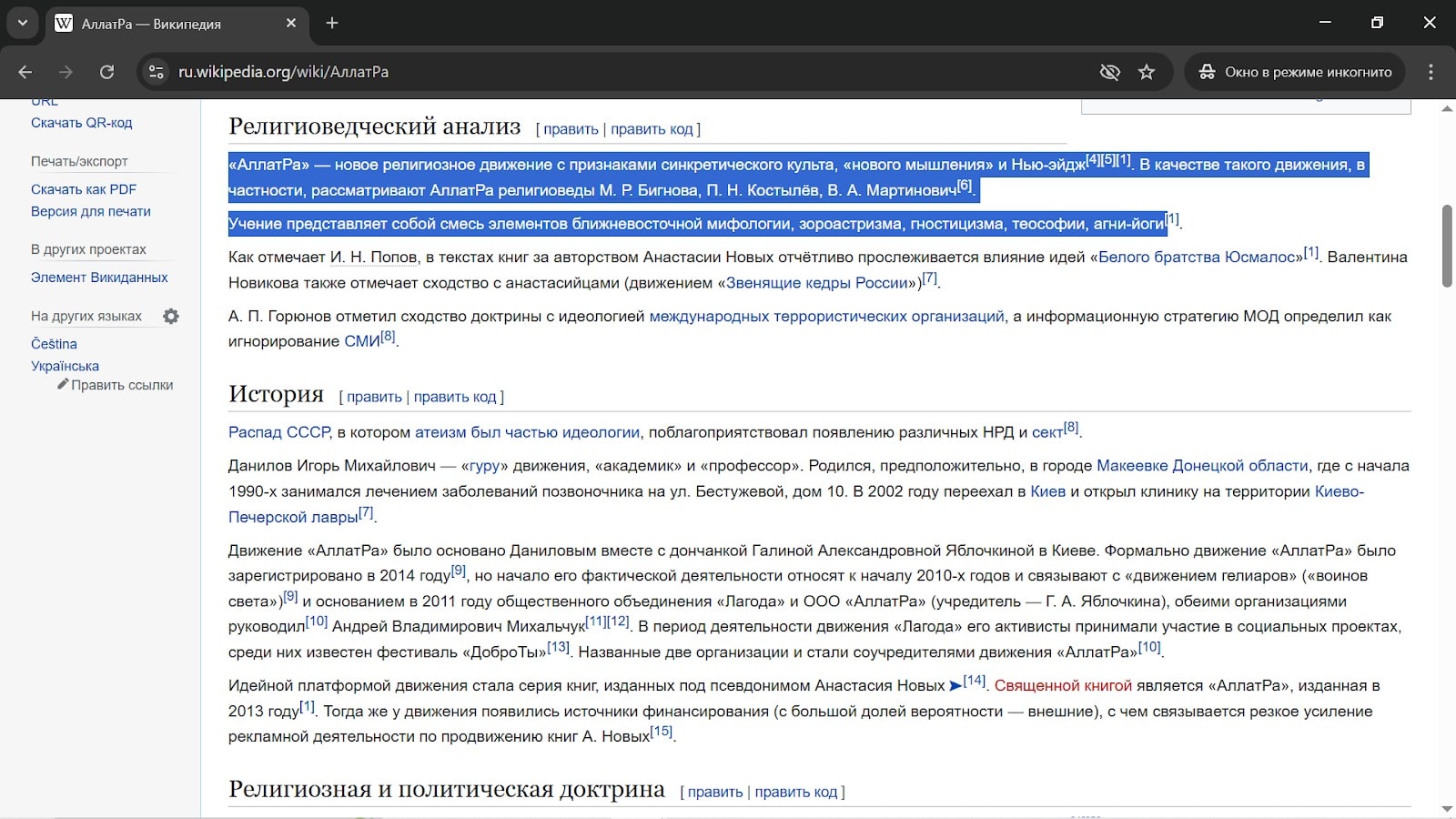
Photo 51: Screenshot of a Wikipedia page about ALLATRA IPM
This PIECE OF PAPER replaced an expert research and was used by Justice of the Peace S.I. Sergey Pridannikov as a basis for the court ruling! The Wikipedia information about ALLATRA IPM, reproduced in the memo provided by E.V. Shchetinina, cannot be considered admissible or credible evidence. According to Clause 3.5.6 of the Informational Memo prepared based on a summary of judicial practice by the Intellectual Property Court as a court of first instance and cassation, with reference to the practice of the Supreme Court of the Russian Federation regarding certain issues related to evaluating evidence found on the Internet, as approved by the resolution of the Presidium of the Intellectual Property Court No. SP-23/24 dated September 14, 2017, courts must take into account that information from user-edited websites (such as Wikipedia) is not considered to substantiate the facts stated therein, as such information can be edited by anyone and is therefore not objective.
Moreover, it should be noted that the printed materials seized in the presence of N.A. Agafonova (the booklet and "gaSHeta") were not reviewed in any way by ANO "Center for Cultural and Religious Studies, Socio-Political Technologies, and Educational Programs," including for religious content: there is no evidence of that in the administrative case files. Nor was the activity of the Creative Society project properly examined. Therefore, the response also cannot be deemed relevant evidence in the case against M.Yu. Vashchenkova.
The court was likewise not presented with original or properly certified copies of documents confirming E.V. Shchetinina's qualifications or work experience in the relevant field, which is an additional reason to deem this statement (opinion by expert E.V. Shchetinina) No. 35 dated May 22, 2023 inadmissible evidence. Consequently, under Article 26.2 of the CAO RF, this should also have been classified by the court as evidence obtained in violation of the law.
In its letter dated July 7, 2023, ref. No. 6/749 [Vol. 1, p. 91, Photo 52], the Center for Combating Extremism of the MD MIA of Russia, Chelyabinsk Region, provided the head of Plast District Department of MIA of Russia in Chelyabinsk Region, A.A. Demin, with photocopies of documents supposedly confirming E.V. Shchetinina's academic qualifications, in addition to the certificate from ANO "Center for Cultural and Religious Studies, Socio-Political Technologies, and Educational Programs," No. 35 dated May 22, 2023.
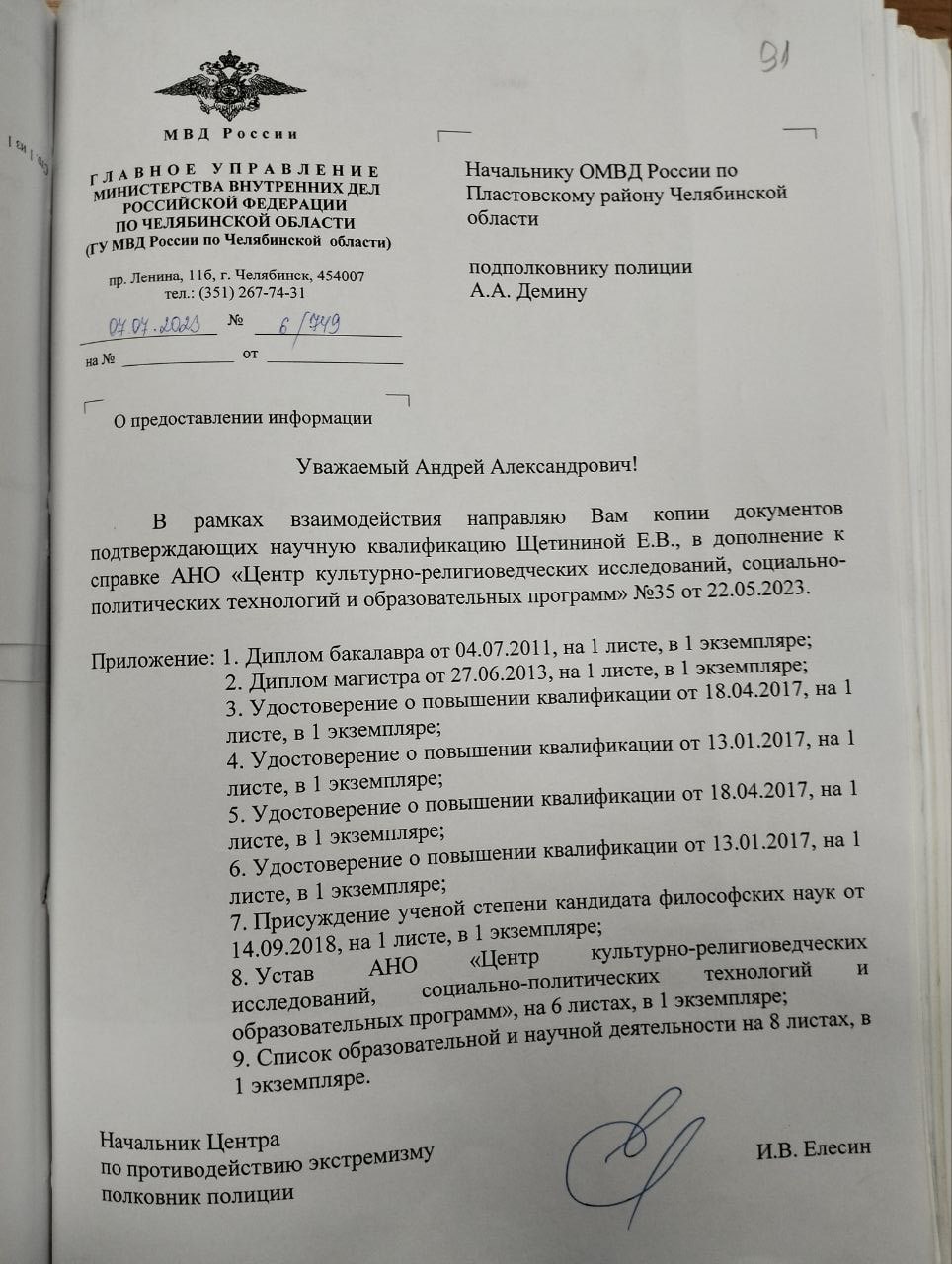
Photo 52: Letter from the Center for Combating Extremism of the MD MIA of Russia, Chelyabinsk Region, No. 6/749 dated July 7, 2023, “On the Provision of Information”
Among the submitted copies were nine documents, including the Charter of this autonomous nonprofit organization and various papers claiming to confirm E.V. Shchetinina's academic qualifications.
The following points should be noted:
- The information was provided without any formal request from Plast District Department of MIA of Russia in Chelyabinsk Region, in whose jurisdiction the administrative offense case was originally being handled.
- The information wasn’t submitted by Plast District Department of MIA of Russia in Chelyabinsk Region along with the memo from the Center for Cultural and Religious Studies, Socio-Political Technologies, and Educational Programs, No. 35 dated May 22, 2023, but was actually provided during the court proceedings before Justice of the Peace S.I. Pridannikov after the first hearing that took place on July 6, 2023.
- Given that officers from the Center for Combating Extremism were not present at the court hearing on July 6, 2023, they could not have known that Vashchenkova's defense attorney had questioned E.V. Shchetinina's qualifications. Neither the justice of the peace nor Plast District Department of MIA of Russia in Chelyabinsk Region had sent a request to the Center for Combating Extremism, yet a response with supporting documents was submitted the day after the hearing in which the defense raised objections about Shchetinina’s certificate.
- It is unclear how the Center for Combating Extremism of the MD MIA of Russia, Chelyabinsk Region, obtained this information (the document copies), especially since the case materials indicate that the Center for Cultural and Religious Studies, Socio-Political Technologies, and Educational Programs had not provided any such documents to the Center for Combating Extremism.
- The response was submitted on July 7, 2023, while the instruction from Justice of the Peace S.I. Pridannikov was only given to Plast District Department of MIA of Russia in Chelyabinsk Region on July 10, 2023, as per the court order dated that same day [Vol. 1, p. 115, Photo 53]. This means that Plast District Department of MIA of Russia received the documents before being instructed to do so by the court.
- Plast District Department of MIA of Russia in Chelyabinsk Region received the documents not from ANO "Center for Cultural and Religious Studies, Socio-Political TechPlast District Department of MIA of Russia in Chelyabinsk Region received the documents not from ANO “Center for Cultural and Religious Studies, Socio-Political Technologies, and Educational Programs” as Justice of the Peace S.I. Pridannikov had indicated in his court ruling of July 10, 2023 [Vol. 1, p. 115, Photo 53], but from the Center for Combating Extremism of the MD MIA of Russia, Chelyabinsk Region.
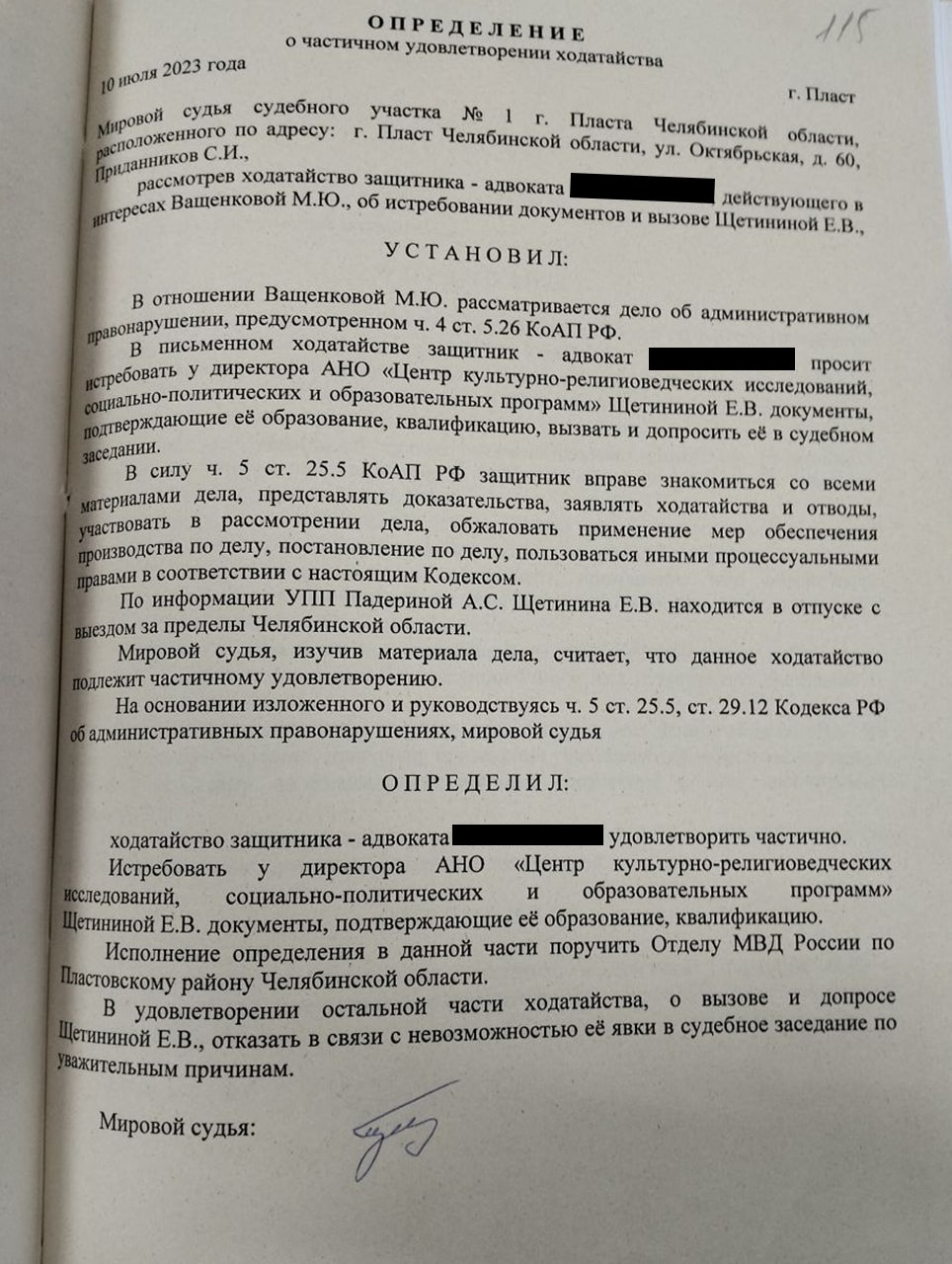
Photo 53: Order by Justice of the Peace S.I. Pridannikov on partial satisfaction of the motion, dated July 10, 2023
- Copies of the documents attached to the response were not certified in any way (neither stamped nor signed). One of the documents, titled "List of Educational and Academic Activities" and consisting of eight pages, was composed by an unidentified author and bears no signature. Moreover, no documents were presented confirming E.V. Shchetinina's length or experience in expert work. Hence, the documents attached to the response were obtained unlawfully and do not constitute admissible evidence in the case.
Based on clarifications provided by the Supreme Court of the Russian Federation as specified in paragraph 4, Section 4 of its Ruling No. 5 of the Plenary Session, dated March 24, 2005 (as amended on December 23, 2021) “About some questions arising at courts in case of application of the Russian Federation Code of Administrative Offences,” if an administrative offense protocol is drawn up by an unauthorized person, or if the protocol or other case materials are improperly executed or incomplete, the judge must, pursuant to paragraph 4, Part 1, Article 29.4 of the CAO RF, issue a ruling to return the administrative offense protocol and case materials to the authority or official that prepared the protocol. The judge’s ruling must be substantiated and indicate deficiencies in the protocol and other materials that require correction. Moreover, justice of the peace S.I. Pridannikov had no right to remedy the violations committed by the police in preparing the inspection materials and was obligated to return the case to Plast District Department of MIA of Russia in Chelyabinsk Region.
In addition, the memo was signed by E.V. Shchetinina as director of the Center for Cultural and Religious Studies, Socio-Political Technologies, and Educational Programs. However, no proof of E.V. Shchetinina's authority was attached. It should also be taken into account that the case materials state that Shchetinina has held the position of director since March 16, 2017 [certificate from the center, dated July 10, 2023 — Vol. 1, p. 197, Photo 64], and that the director's term of office is three years [Clause 8.3 of the center's Charter — Vol. 1, p. 102, Photo 54].
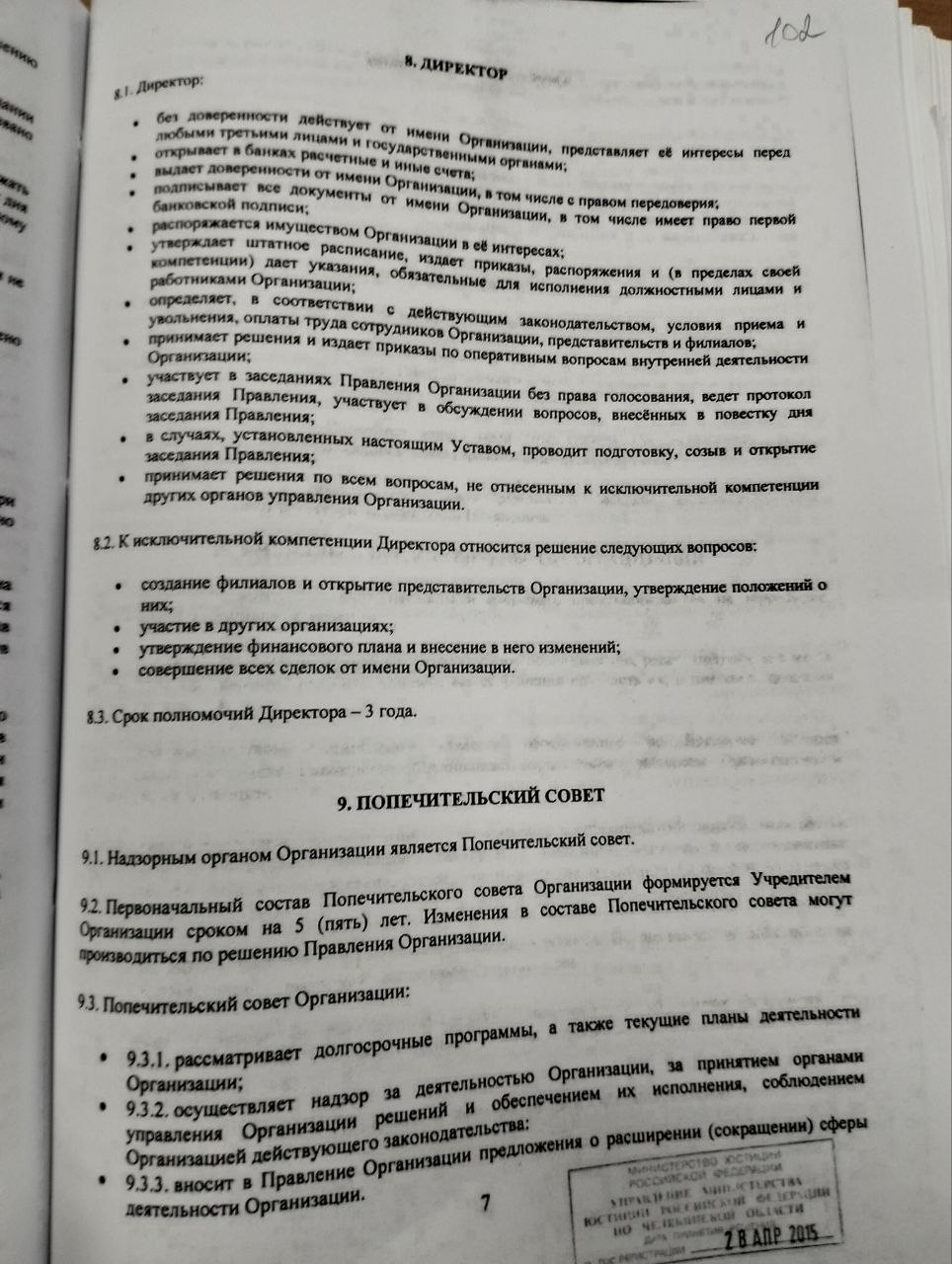
Photo 54: Excerpts from the Charter of ANO "Center for Cultural and Religious Studies, Socio-Political Technologies, and Educational Programs"
According to clause 5.3.5 of the center's Charter, the appointment of its director lies within the competence of its founder [Vol. 1, p. 100 reverse side, Photo 55].
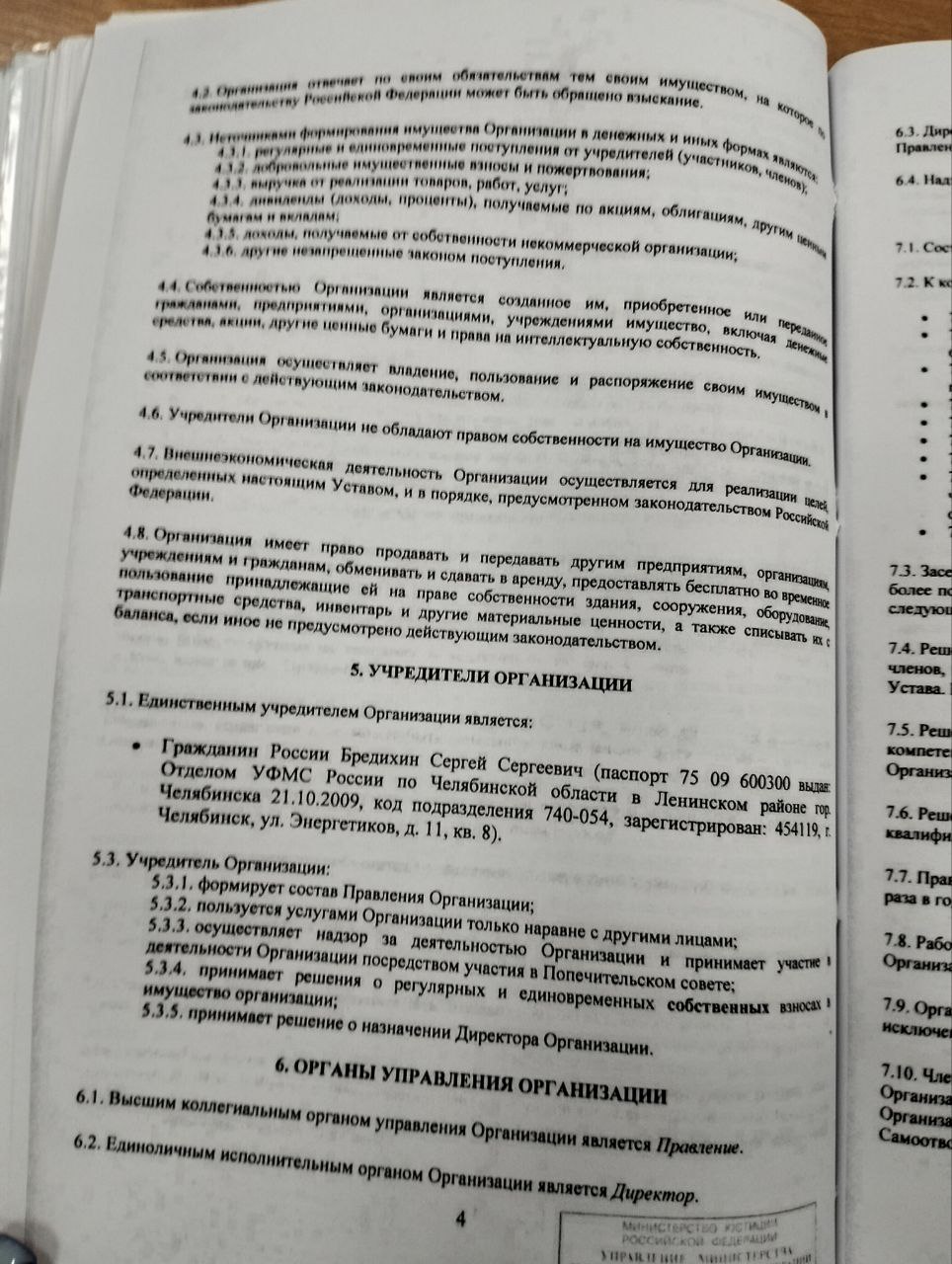
Photo 55: Excerpts from the Charter of ANO "Center for Cultural and Religious Studies, Socio-Political Technologies, and Educational Programs"
Thus, in both March 2020 and March 2023, E.V. Shchetinina's three-year term of office expired. Consequently, confirmation of E.V. Shchetinina's authority should have consisted of a current resolution by the center's founder appointing her to a new term (as of March 2023), but such a resolution wasn't attached to the response and isn't found in the case files.
It should also be noted that ANO "Center for Cultural and Religious Studies, Socio-Political Technologies, and Educational Programs" does not list "forensic expert activity" among its types of economic activity under the All-Russian Classifier of Economic Activities (OKVED), as indicated in its Charter and the Unified State Register of Legal Entities [Photo 56].
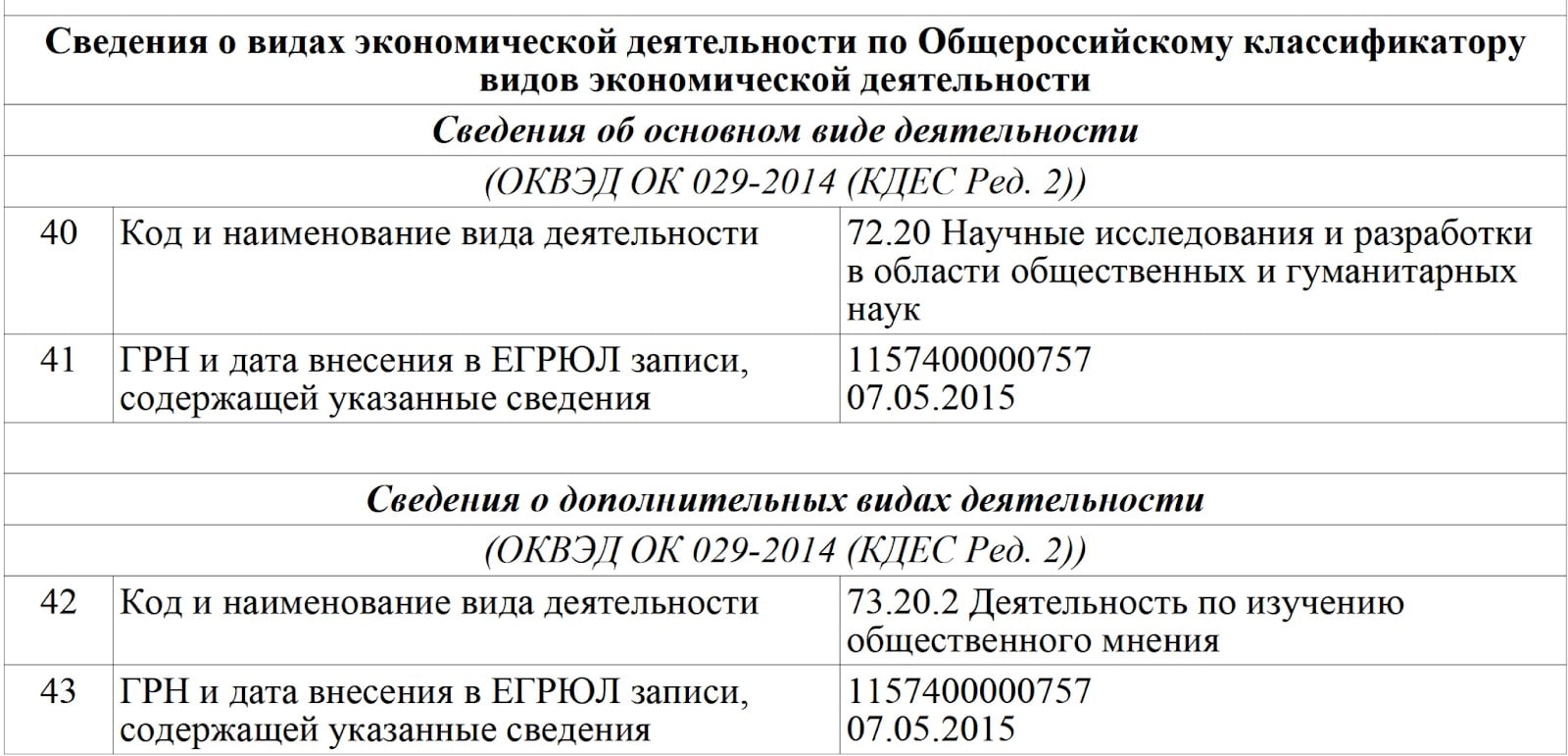
Photo 56: Data on economic activity types under All-Russian Classifier of Economic Activities (OKVED) for ANO "Center for Cultural and Religious Studies, Socio-Political Technologies, and Educational Programs," as per the excerpt from the Unified State Register of Legal Entities
Therefore, the request by E.V. Ospinnikov was sent to an organization not authorized to assess or provide any conclusion regarding the presence of religious features in the activities of the Creative Society project in the context of the administrative offense case initiated against M.Yu. Vashchenkova.
It must also be emphasized that in her response, E.V. Shchetinina makes a legal conclusion which falls outside her competence, as she does not hold legal qualifications. According to Section 18 of Ruling No. 5 of the Plenary Session of the Supreme Court of the Russian Federation, dated March 24, 2005 (as amended on December 23, 2021) “About some questions arising at courts in case of application of the Russian Federation Code of Administrative Offences,” when an administrative offense case is considered, the evidence collected must be evaluated according to Article 26.11 of the CAO RF, also in terms of whether the legal requirements for its collection have been met (Part 3 of Article 26.2 of the CAO RF). Violations that may render evidence inadmissible include, in particular, obtaining explanations from a victim, witness, or individual subject to administrative proceedings who was not first informed of their rights and obligations under Part 1 of Article 25.1, Part 2 of Article 25.2, and Part 3 of Article 25.6 of the CAO RF, and Article 51 of the Constitution of the Russian Federation, while witnesses, specialists, and experts were not warned of administrative liability for perjury, statements, or conclusions under Article 17.9 of the CAO RF, or where there is a significant violation of the procedure for appointing and conducting an expert assessment.
Thus, in violation of the aforesaid legal norms, the memo issued by E.V. Shchetinina cannot be used as evidence in the case, as it was obtained unlawfully, without warning the specialist of administrative liability for knowingly providing false statements or conclusions.
Meanwhile, the legal expert opinion No. 155-pe/2019 submitted by the defense and issued by the Nongovernmental Private Educational Institution (NPEI) of Supplementary Education "Institute of Forensic Expertise and Criminalistics," dated May 30, 2019 [Vol. 1, pp. 55–74, Photos 57-58], was critically assessed by Justice of the Peace S.I. Pridannikov because this legal opinion had been prepared by a candidate of legal sciences. Based on the analysis performed, the specialist of NPEI of Supplementary Education "Institute of Forensic Expertise and Criminalistics," Evgeny Nikolaevich Kuznetsov, provided the following conclusion in his legal expert opinion No. 155-pe/2019 dated May 30, 2019:
"On the question: 'Does the Public Association "ALLATRA International Public Movement" qualify as an extremist or religious organization?'
Conclusion: The Public Association 'ALLATRA International Public Movement' does not qualify as an extremist organization. The Public Association 'ALLATRA International Public Movement' is not a religious organization under Russian law."
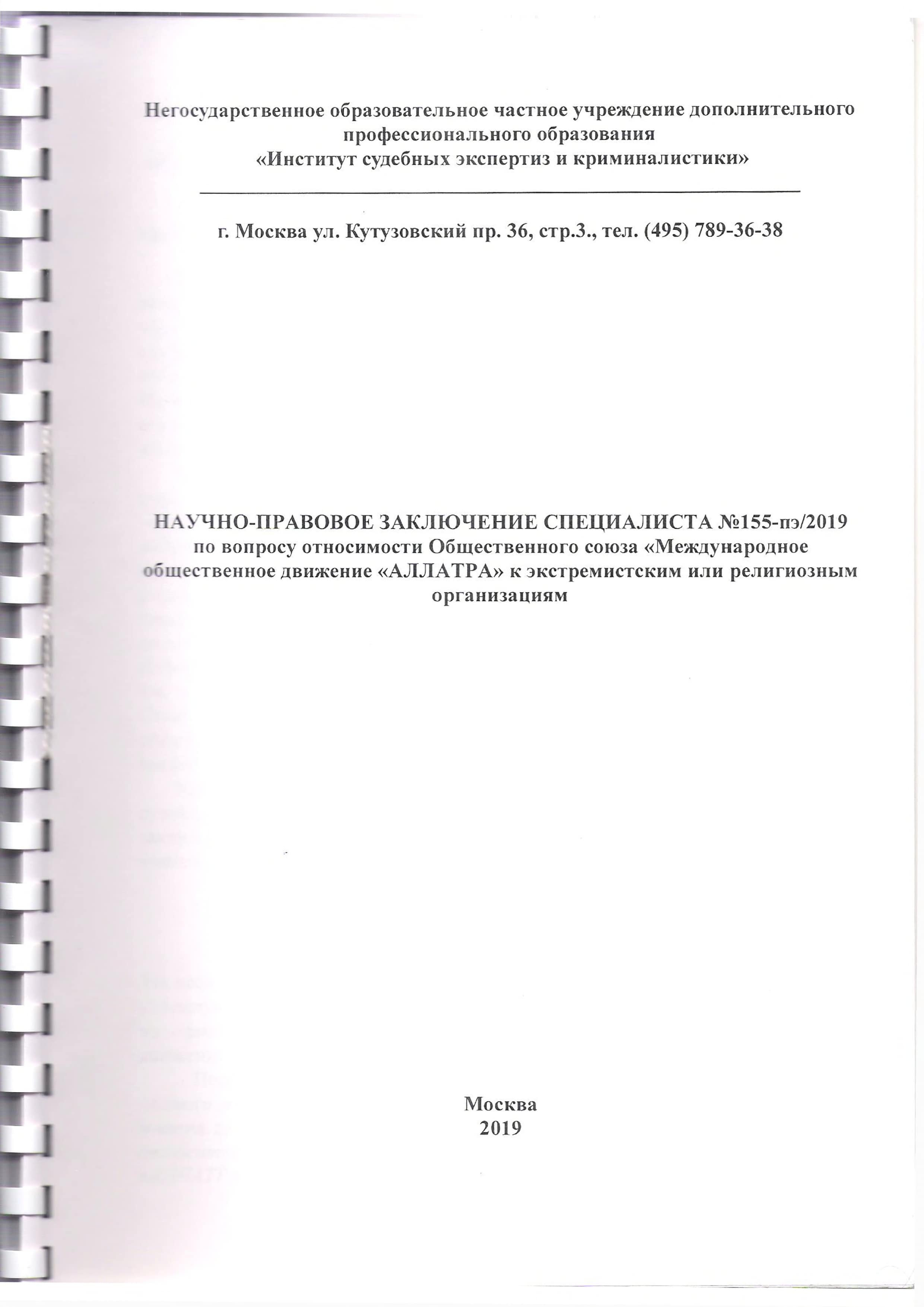
Photo 57: Legal expert opinion No. 155-pe/2019 issued by the Nongovernmental Private Educational Institution of Supplementary Education "Institute of Forensic Expertise and Criminalistics," dated May 30, 2019, part 1
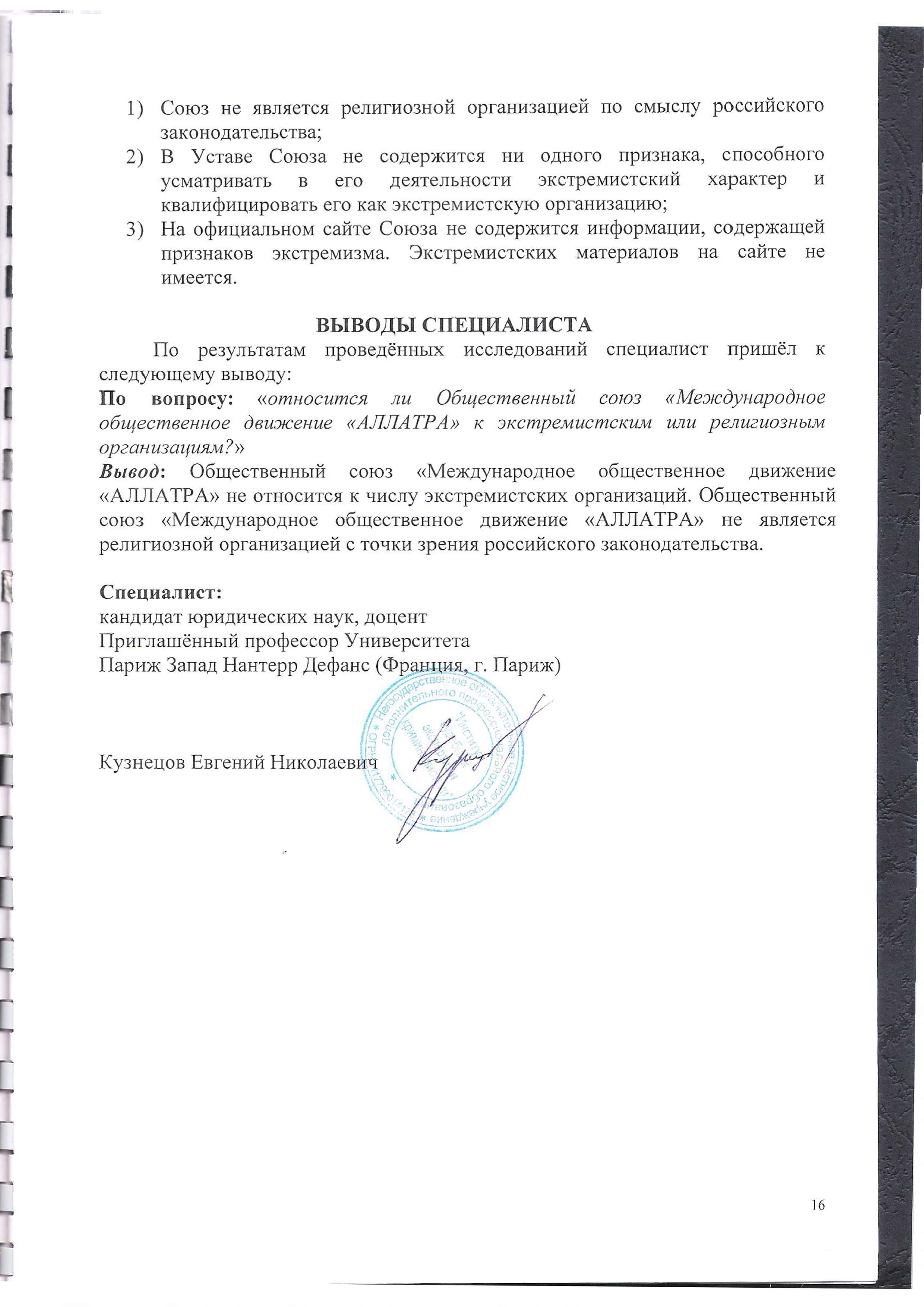
Photo 58: Legal expert opinion No. 155-pe/2019 issued by the Nongovernmental Private Educational Institution of Supplementary Education "Institute of Forensic Expertise and Criminalistics," dated May 30, 2019, part 2
- As noted earlier, testimonies of witnesses K.V. Putnik and S.O. Manturov likewise cannot be regarded as admissible evidence confirming the religious nature of the Creative Society project, as they are based on personal assumptions and conjectures by individuals who are not experts in the relevant scientific field and who express their subjective opinions about the international movement ALLATRA and the Creative Society project, which they have not studied in depth. This is confirmed by the court hearing transcript dated July 10, 2023.
Additionally, on July 7, 2023, along with the cover letter “On the Provision of Information,” No. 6/779 dated July 7, 2023, signed by the head of the Center for Combating Extremism of the MD MIA of Russia, Chelyabinsk Region, I.V. Yelesin, the prosecution submitted to the court a list of academic and educational activities of the expert E.V. Shchetinina, which includes two methodological publications co-authored by K.V. Putnik and B.K. Putnik [Vol. 1, p. 108, Photo 59].
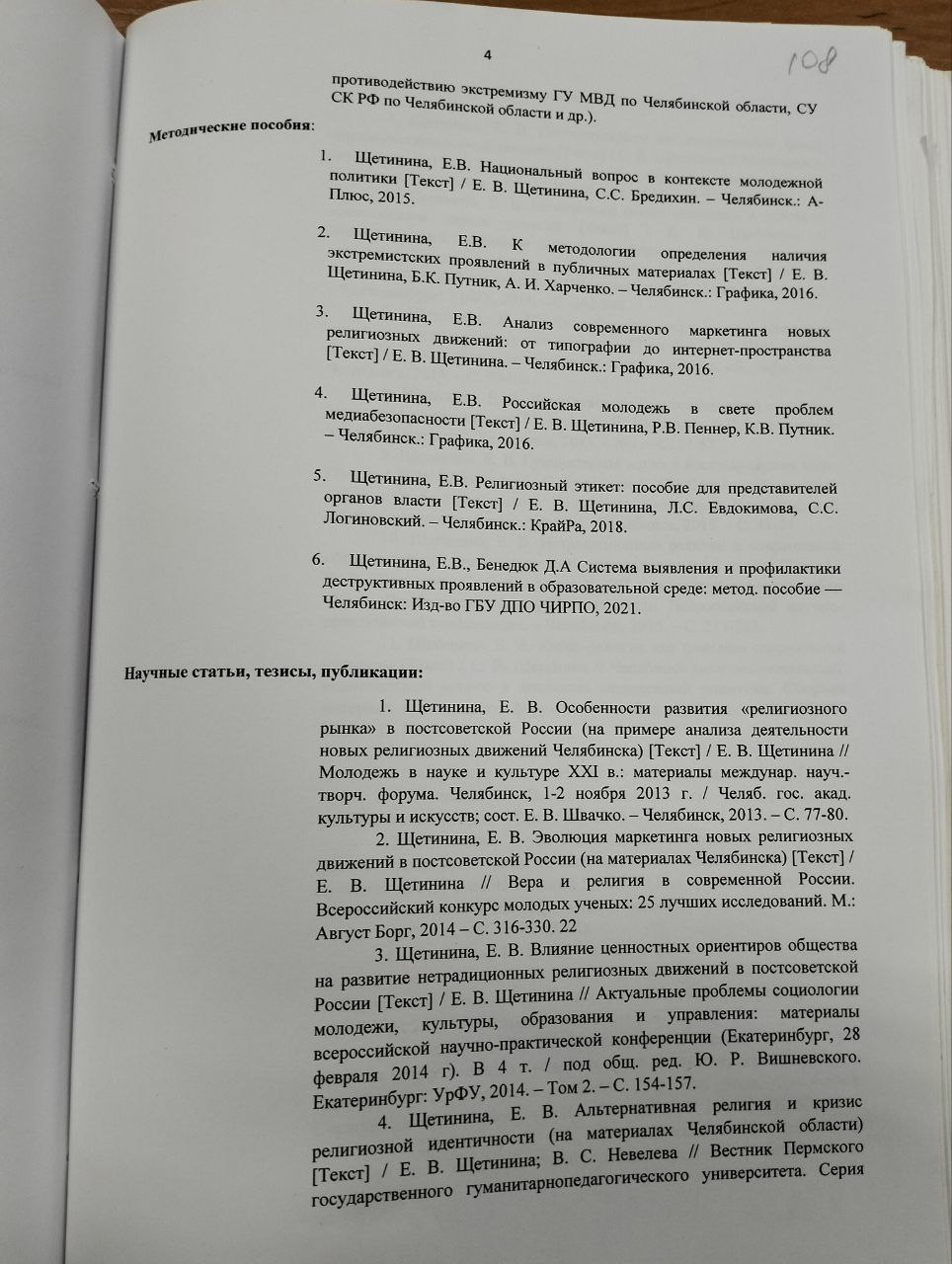
Photo 59: List of educational and academic activities of expert E.V. Shchetinina, including two methodological publications co-authored by K.V. Putnik and B.K. Putnik
This fact indicates that the prosecution submitted a statement by expert E.V. Shchetinina which reflected her personal opinion "On religious activities of the organizations Creative Society and ALLATRA" and then introduced her academic co-author as a witness, which points to a lack of impartiality and a conflict of interest among the individuals involved.
Therefore, Justice of the Peace S.I. Pridannikov's conclusion that the Creative Society is a new religious movement with elements of a syncretic cult is not objectively substantiated and is based on subjective assumptions made without full and thorough examination of the case circumstances, in violation of Article 26.11 of the CAO RF. Moreover, in violation of Article 26.11 of the CAO RF, Justice of the Peace S.I. Pridannikov avoided conducting a comprehensive examination of the submitted case materials, including those concerning the activities of the Creative Society project, and based his ruling of July 14, 2023, on the arguments of the prosecution that:
- merely presumed a direct connection between the Creative Society project and the ALLATRA International Public Movement;
- and merely assumed the religious nature of their activities.
It is noteworthy that, in considering the administrative offense case, Justice of the Peace S.I. Pridannikov failed to take into account that missionary activity is directly linked to religious activity and involves dissemination of a specific religious doctrine (as defined in Federal Law No. 125-FZ of September 26, 1997 "On Freedom of Conscience and on Religious Associations").
Thus, a legally significant element in this offense is, among other things, establishing the fact that a particular doctrine is disseminated. "A doctrine is a set of dogmas and tenets of a given religion," as per Ozhegov's Explanatory Dictionary (S.I. Ozhegov, N.Yu. Shvedova). At M.Yu. Vashchenkova's store, informational materials were available, aimed at familiarizing the public with the Creative Society project where she was a volunteer. Those informational materials are not religious in content and are not aimed at promoting any religious doctrine. Moreover, establishing whether the printed materials distributed by M.Yu. Vashchenkova contain religious content, or whether the information therein is neutral or includes persuasive messaging intended to draw individuals into a belief system, isn't possible without special expertise. It is assumed that resolving this legally significant issue requires expert assessment by respective qualified specialists.
However, Justice of the Peace S.I. Pridannikov did not even attempt to establish this key element, whether the subject matter of the printed materials confiscated from M.Yu. Vashchenkova was religious in nature, and denied the motion to conduct a judicial comprehensive expert assessment on the matter. Although initially Justice of the Peace S.I. Pridannikov understood that without conducting such an expert assessment, it would be impossible to determine all facts essential to the case, and even postponed the hearing to July 14, 2023 [Vol. 1, p. 204, Photo 60] for the purpose of issuing requests to expert institutions and coordinating minimum feasible timeframes for such an assessment, he ultimately denied the defense's motion.
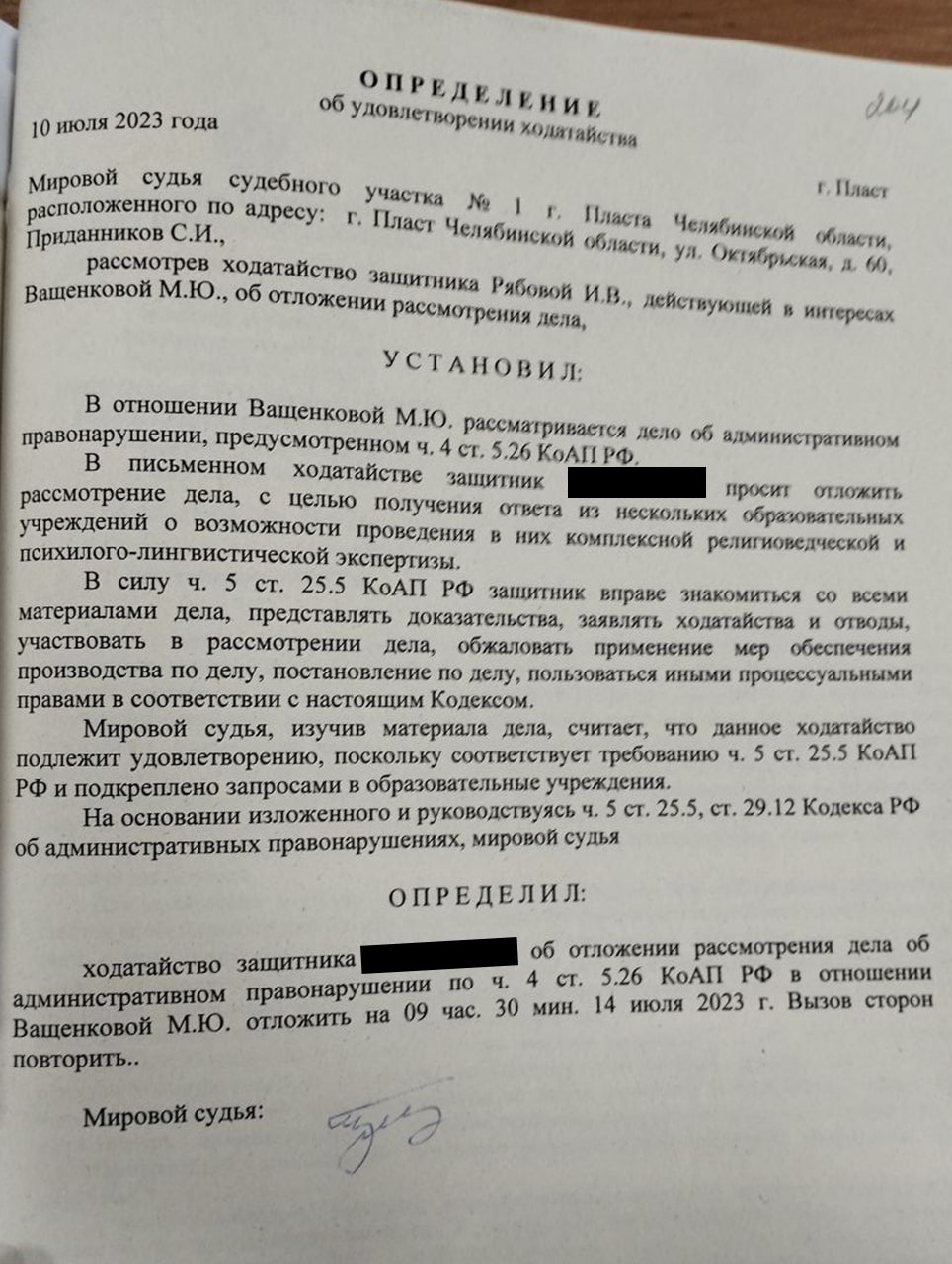
Photo 60: Ruling on granting of the motion, dated July 10, 2023, issued by Justice of the Peace S.I. Pridannikov of Judicial District No. 1 in Plast, Chelyabinsk Region
Justice of the Peace S.I. Pridannikov denied the defense's request for a comprehensive religious, psychological and linguistic expert assessment, solely on the grounds that carrying out such an examination might exceed the statutory limitation period for holding M.Yu. Vashchenkova administratively liable. This was despite the fact that the expert institution had confirmed its readiness to carry out a comprehensive religious, psychological and linguistic assessment within the permitted timeframe, in time for the court session scheduled for July 14, 2023. The defense submitted a response from ANO "Forensic Expert Agency" confirming this readiness. Thus, Justice of the Peace S.I. Pridannikov evaded the collection of judicial evidence, failing to fulfill his obligation to conduct a complete and thorough examination of the case, which resulted in a ruling that doesn't meet the criteria of legality and good reason (see Supreme Court rulings dated April 4, 2023 No. 18-KG22-163-K4; February 7, 2023 No. 22-KG22-18-K5; January 31, 2023 No. 18-KG22-136-K4, etc.). This circumstance indicates a premeditated criminal collusion aimed at issuing a knowingly predetermined (commissioned) court ruling.
It should also be noted that the delay in conducting the review of N.A. Agafonova's statement was caused by law enforcement authorities themselves, who unjustifiably prolonged the process through an unlawful administrative investigation. From the date of the incident (May 4, 2023) to the date the administrative offense protocol was executed (June 28, 2023), almost two months had passed. This delay effectively shortened the time available for the court to consider the case and hindered the appointment of a court-ordered expert assessment, which in turn led to a violation of M.Yu. Vashchenkova's constitutional right to judicial defense (Part 1 of Article 46 of the Constitution of the Russian Federation).
In the ruling on the administrative offense case, Justice of the Peace S.I. Pridannikov concludes that the Creative Society project is of a destructive nature. However, this conclusion isn't supported objectively or reliably by the case materials, as the project's activities were not even examined by the judge, nor was any expert analysis conducted on this issue.
Furthermore, the protocol of seizure of items and documents, dated May 4, 2023 [Vol. 1, p. 13, Photo 8], states that a "printed publication — gaSHeta of the Creative Society international project, consisting of 28 A4 pages" was confiscated. However, the judge did not even notice that no such newspaper exists in the case file, which also indicates that the judge failed to properly review the materials submitted in the case. At the stage of reviewing case materials, Justice of the Peace S.I. Pridannikov did not open the sealed packet containing this informational material.
Meanwhile, under Article 26.6 of the CAO RF, physical evidence in an administrative offense case includes instruments or items of administrative offense, including items of administrative offense that bear traces of the administrative offense. If necessary, physical evidence must be photographed or otherwise documented in the prescribed manner and attached to the case files. A note about the existence of physical evidence must be made in the administrative offense protocol or another applicable protocol under the CAO RF.
The printed materials allegedly seized in the presence of N.A. Agafonova [Vol. 1, p. 13, Photo 8] acquired the status of physical evidence and had to be examined by the court as independent evidence in accordance with the procedure established by Article 26.6 of the CAO RF.
4. In the ruling on the administrative offense case, dated July 14, 2023, Justice of the Peace S.I. Pridannikov charged M.Yu. Vashchenkova with distributing informational materials (brochures and newspapers) of alleged religious movement ALLATRA
However, the case files contain no evidence proving the existence of a religious movement by that name, no identifying characteristics of such a religious movement are provided, and there is no evidence whatsoever that M.Yu. Vashchenkova distributed any materials related to the alleged religious movement ALLATRA.
The materials prepared by Plast District Department of MIA of Russia in Chelyabinsk Region and submitted to Justice of the Peace S.I. Pridannikov for review contain significant inconsistencies regarding the full name and legal organizational form of ALLATRA, specifically:
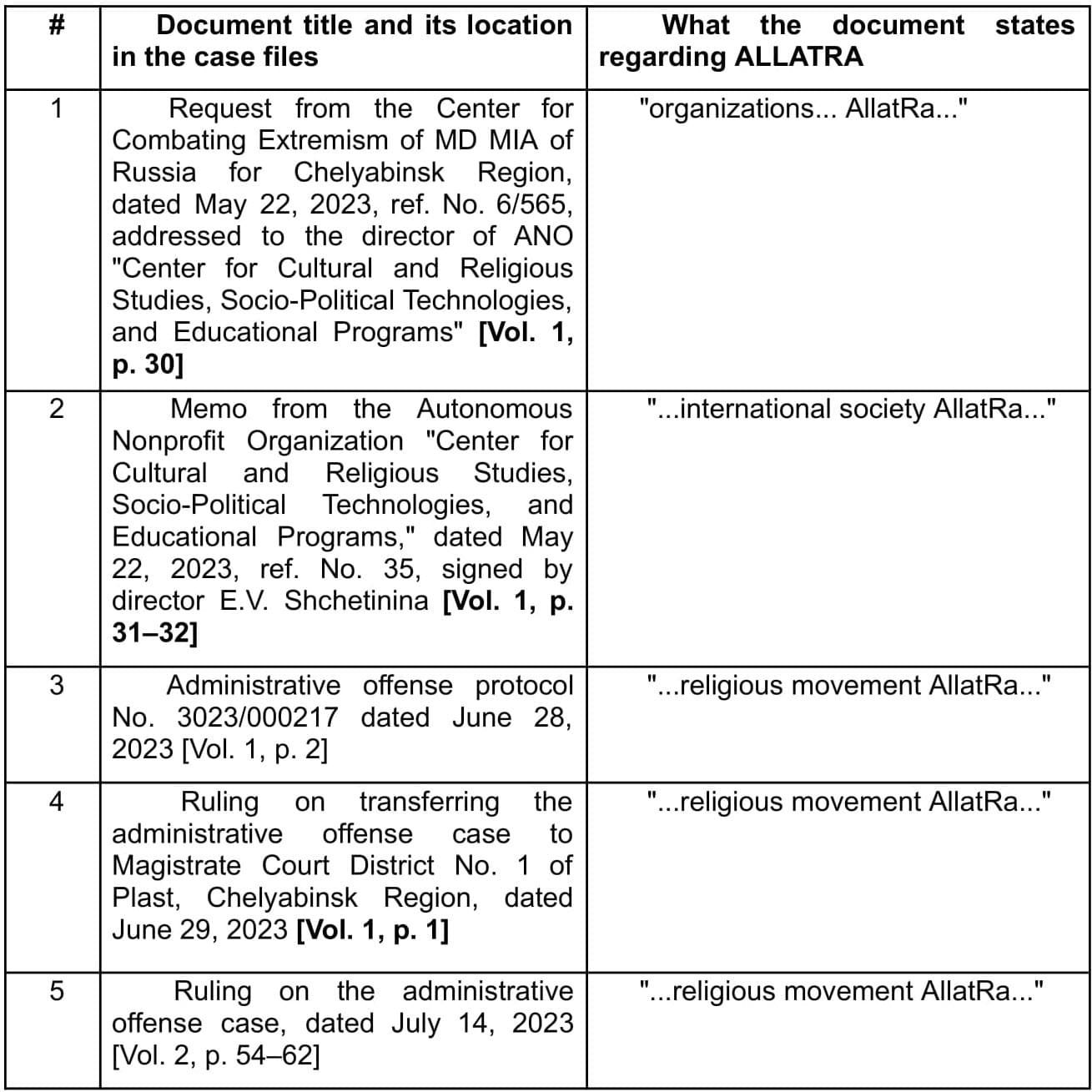
It is noteworthy that aside from the said substantial inconsistencies in ALLATRA's full name and legal form, the above-mentioned documents contain no other identifying characteristics of ALLATRA, nor any evidence of the existence of an organization by that name.
Moreover, other materials in the case, prepared by Plast District Department of MIA of Russia in Chelyabinsk Region (in particular, the report dated May 4, 2023, the protocol of seizure of items and documents, dated May 4, 2023, statements of M.Yu. Vashchenkova, statements of N.A. Agafonova, and the ruling No. 390 on initiating an administrative offense case, dated May 10, 2023) contain no mention whatsoever of the organization or alleged religious movement AllatRa.
Furthermore, attention should be paid to the following:
- In the research assignment No. 6/526 dated May 22, 2023, from the Center for Combating Extremism of the MD MIA of Russia, Chelyabinsk Region, addressed to ANO "Center for Cultural and Religious Studies, Socio-Political Technologies, and Educational Programs" [Vol. 1, p. 30, Photo 50], a request is made for a reference regarding religious activities of the organizations Creative Society and AllatRa;
- In the memo from ANO "Center for Cultural and Religious Studies, Socio-Political Technologies, and Educational Programs," dated May 22, 2023, ref. No. 35, signed by director E.V. Shchetinina [Vol. 1, p. 31–32, Photos 32-33], a mention is made about the international society ALLATRA and the international project Creative Society.
Meanwhile, it remains unclear how the Autonomous Nonprofit Organization "Center for Cultural and Religious Studies, Socio-Political Technologies, and Educational Programs" determined which specific organization named AllatRa the memo was meant to refer to. The request from the Center for Combating Extremism of the MD MIA of Russia, Chelyabinsk Region, did not specify the legal form, full name, or any identifying characteristics of this organization (such as the primary state registration number [OGRN] or registered legal address). The Unified State Register of Legal Entities contains no extract on this organization in the case materials. Moreover, no organization bearing the name "International Society AllatRa" exists at all. Furthermore, ANO "Center for Cultural and Religious Studies, Socio-Political Technologies, and Educational Programs" issued a memo regarding the Creative Society international project, even though the request from the Center for Combating Extremism of MD MIA of Russia for Chelyabinsk Region requested information about an organization titled Creative Society.
Thus, taking into account all of the above, the certificate issued by the ANO "Center for Cultural and Religious Studies, Socio-Political Technologies, and Educational Programs" on May 22, 2023, ref. No. 35, signed by director E.V. Shchetinina [Vol. 1, pp. 31–32, Photos 32-33], cannot be regarded as relevant or admissible evidence in the case.
5. Justice of the peace S.I. Pridannikov failed to examine the items of offense
Upon thorough review of the case materials, the defense identified facts that are crucial for proper consideration of the case. Various documents in the administrative offense case reference entirely different types of printed materials that M.Yu. Vashchenkova is accused of distributing:
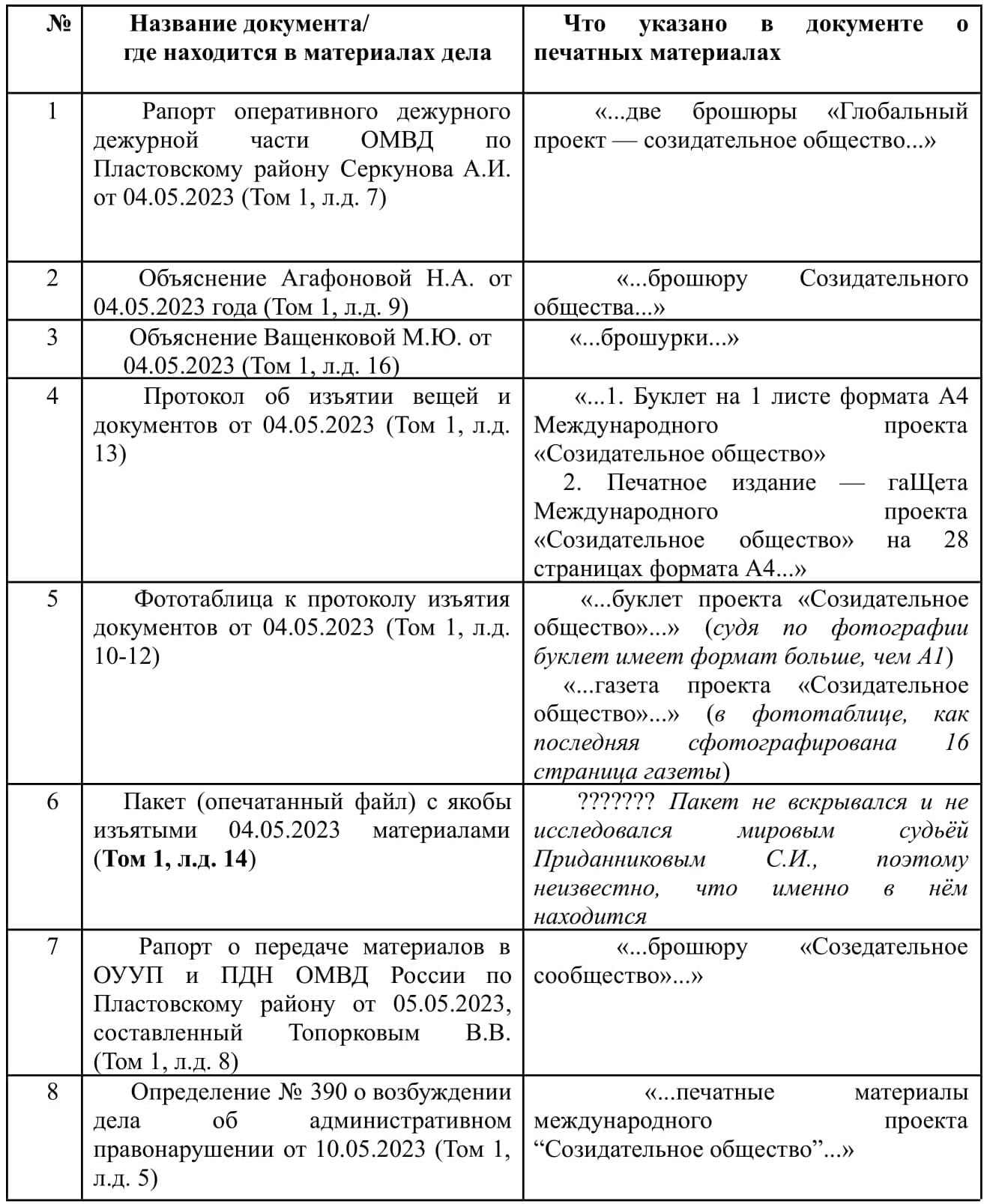
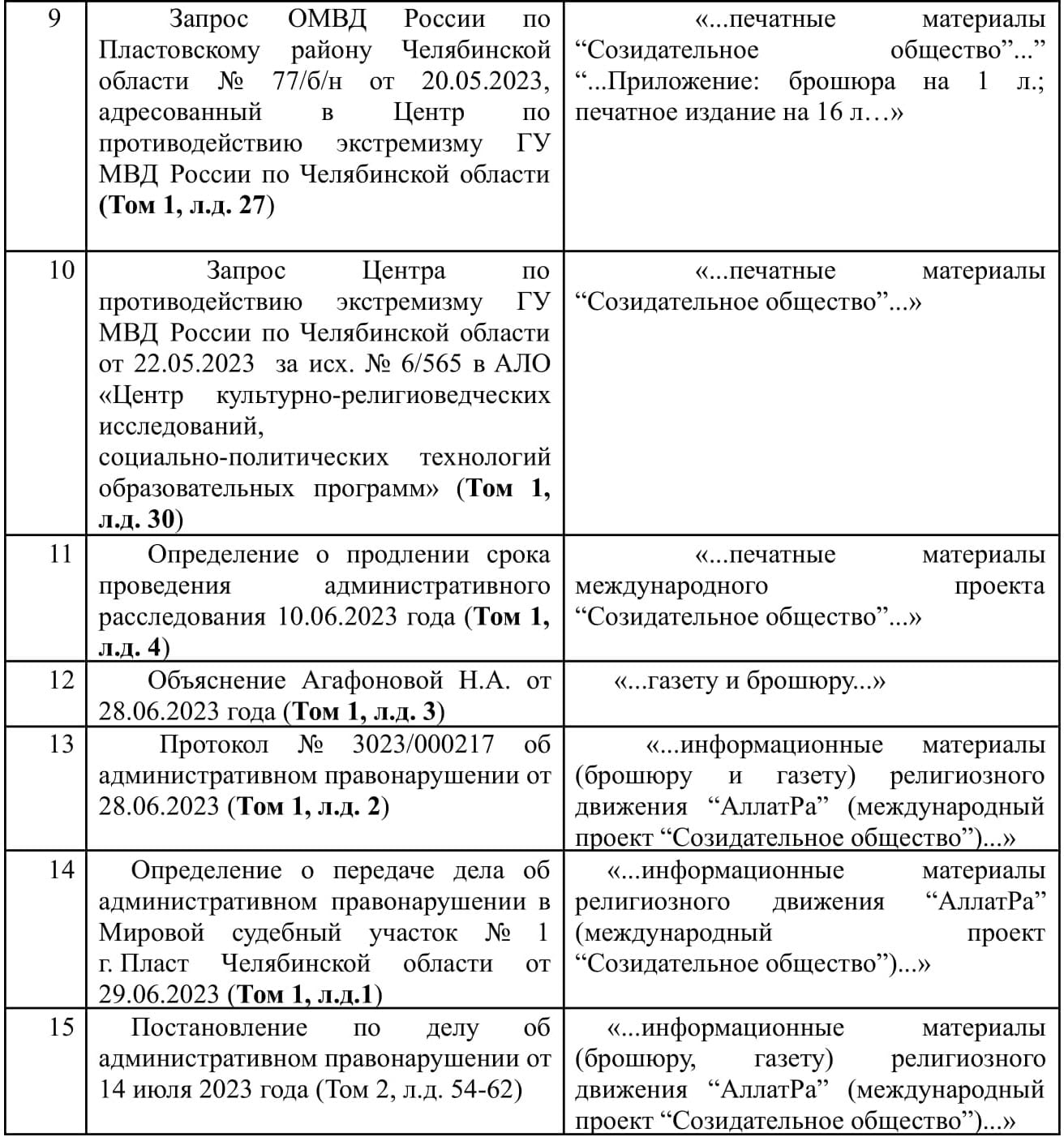
Thus, based on the case materials, it's impossible to determine precisely which specific materials M.Yu. Vashchenkova distributed:
- There are discrepancies regarding the number of materials distributed. Some documents state that M.Yu. Vashchenkova distributed a single (one) item (a brochure), while others mention multiple items (two brochures, a booklet and a newspaper, a booklet and gaSHeta, a booklet and a newspaper, and a brochure, a newspaper and a brochure, a brochure and a printed publication).
- There are significant inconsistencies in the names of those materials: various documents refer to a booklet, brochure, newspaper, gaSheta, printed publication, printed materials, and informational materials;
- There are major discrepancies in the number of pages of the printed publication (newspaper or gaSheta): different documents mention 28 pages, 16 pages, or 16 sheets;
- There are inconsistencies in what those materials were related to: different documents mention Creative Society under different names; and starting from the administrative offense protocol, the materials are attributed to the religious movement AllatRa which hadn't been previously mentioned in relation to the materials distributed by M.Yu. Vashchenkova.
Attention should also be paid to the following: In the photo table attached to the seizure protocol dated May 4, 2023 [Vol. 1, pp. 10–12, Photos 61–63], there’s a signature of S.S. Kartsev, precinct police officer of OUUP and PDN of the Department of the MIA of Russia for the Plast District, Chelyabinsk Region.
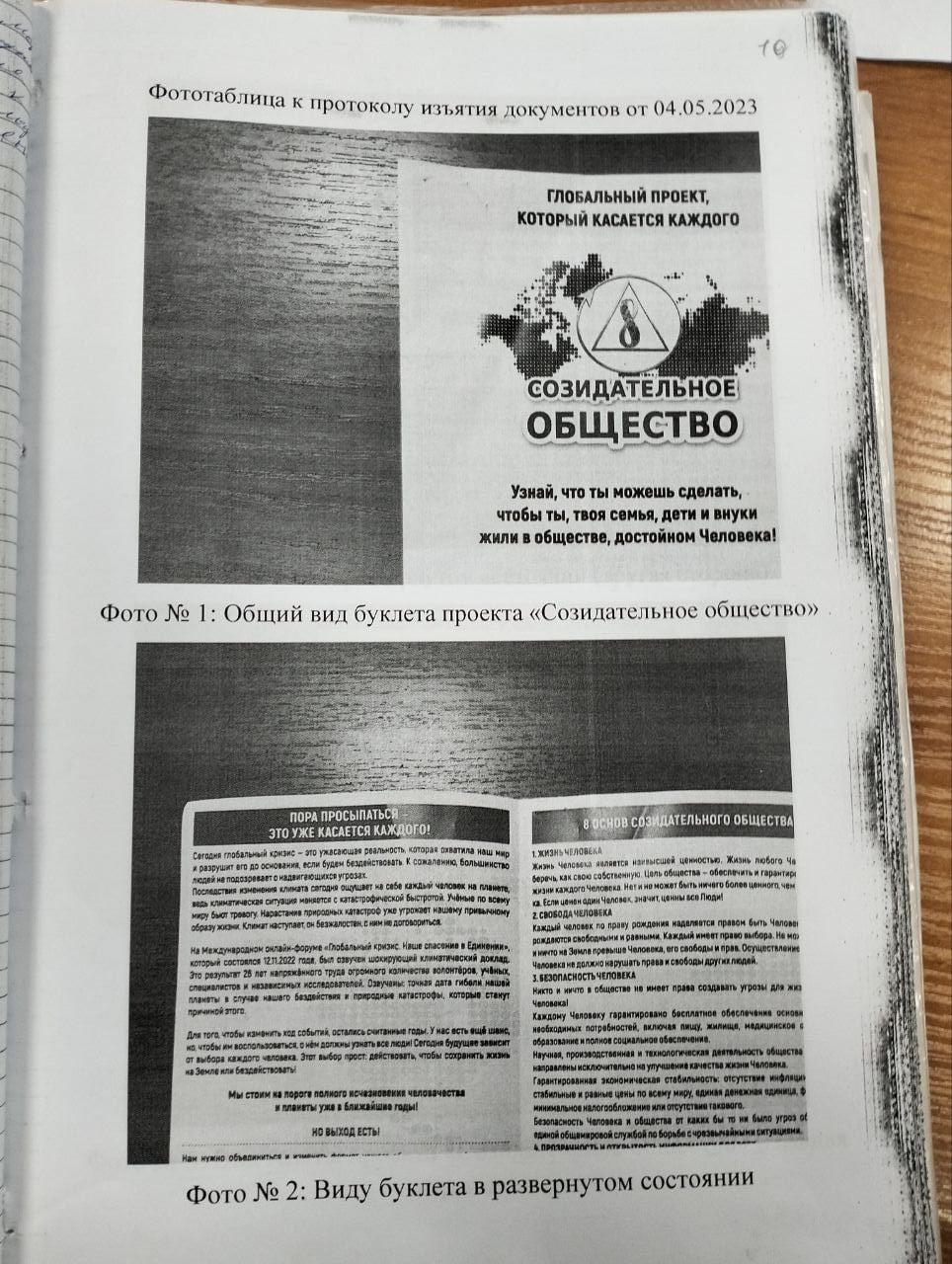
Photo 61: Photo table attached to the seizure protocol, dated May 4, 2023, part 1
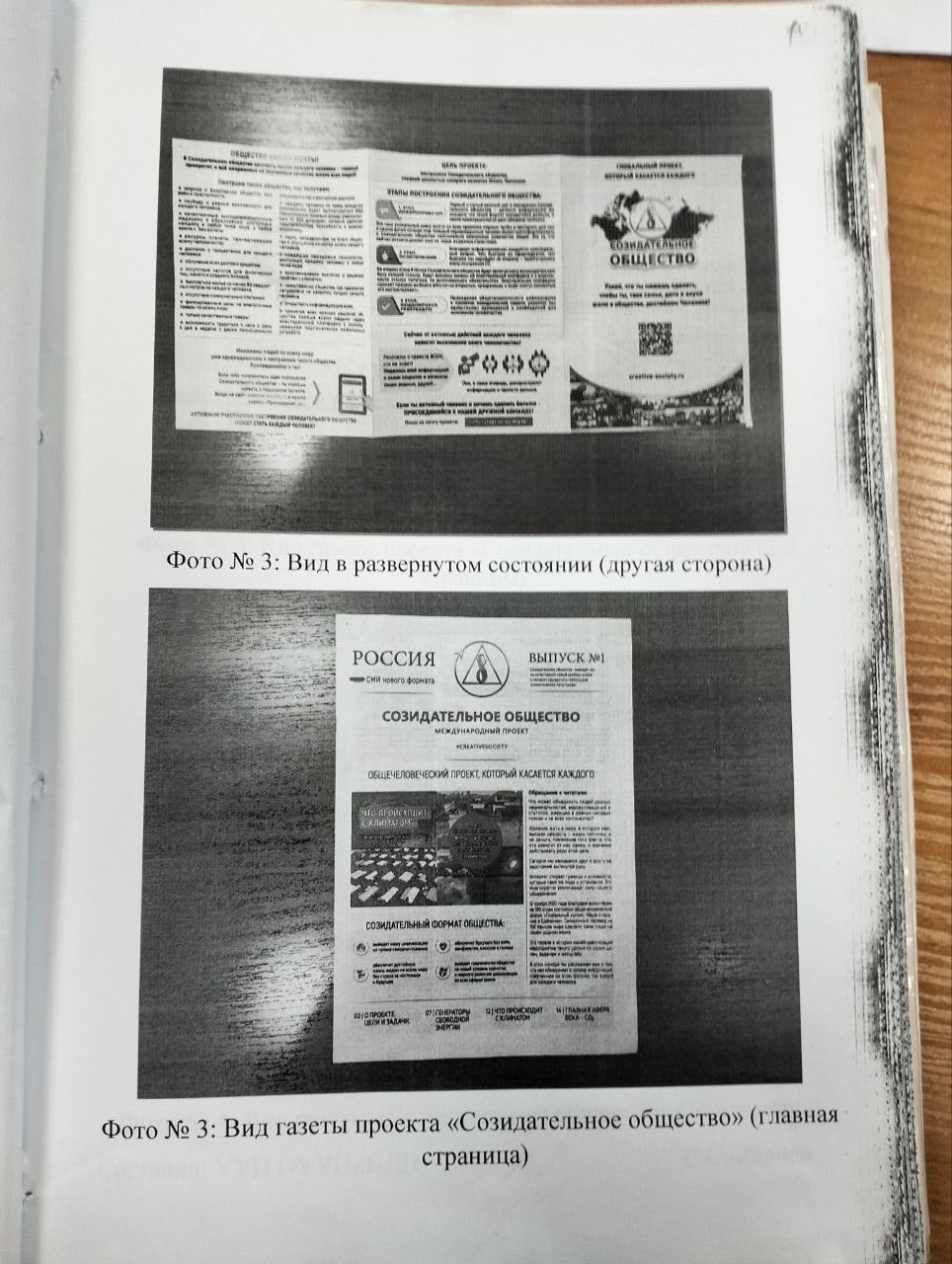
Photo 62: Photo table attached to the seizure protocol, dated May 4, 2023, part 2
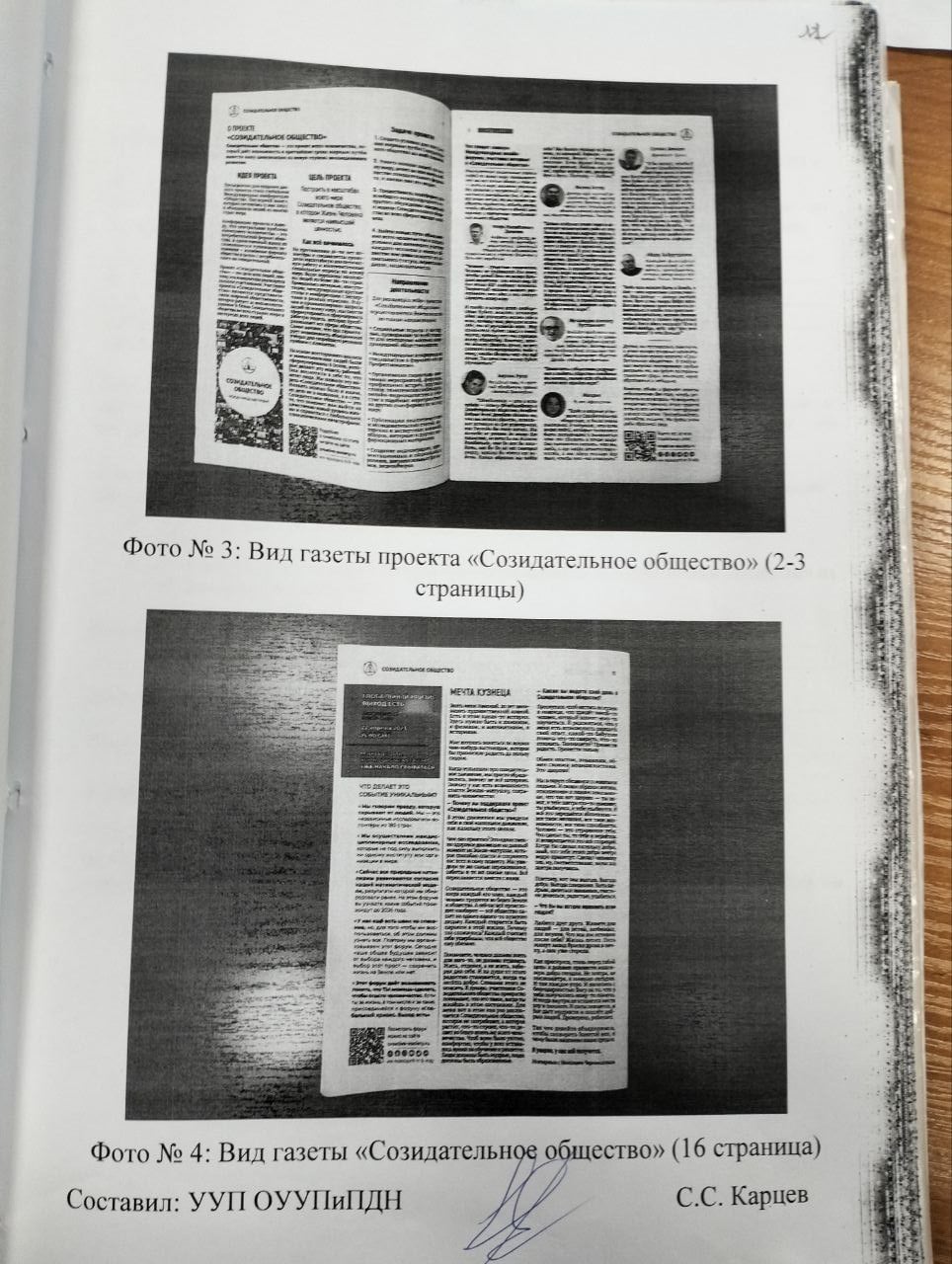
Photo 63: Photo table attached to the seizure protocol, dated May 4, 2023, part 3
At the same time, his signature is present only under one photograph on the last page, and there are no signatures from the witnesses or from N.A. Agafonova on the photo table at all. Considering this as well as the fact that the protocol of seizure of items and documents, dated May 4, 2023 [Vol. 1, p. 13, Photo 8], violates paragraph 7, Article 27.10 of the CAO RF by failing to indicate the use of photography as a method of document recording, the photo table attached to the seizure protocol dated May 4, 2023 constitutes inadmissible and irrelevant evidence.
Additionally:
- The materials seized on May 4, 2023 [Vol. 1, p. 14, Photos 9-10] remained sealed in the administrative offense case files against M.Yu. Vashchenkova until the end of the trial in the court of first instance. The seal bears the signature of S.S. Kartsev who conducted the seizure on May 4, 2023, as well as signatures from only two other persons present during the seizure (the signature of one of the witnesses is missing). Moreover, the protocol does not mention any attachment listing the seized items / materials, which means either there were none or they were not recognized as such.
- The attachment to Request No. 77/b/n dated May 20, 2023, from the Department of the MIA of Russia for the Plast District, Chelyabinsk Region, addressed to the Center for Combating Extremism of the MD MIA of Russia, Chelyabinsk Region, [Vol. 1, p. 27, Photo 16], lists a one-page brochure and a 16-sheet printed publication (i.e., 32 pages, not 28);
- In its response letter No. 6/575 dated May 23, 2023, [Vol. 1, p. 28, Photo 40] to the Department of the MIA of Russia for the Plast District, Chelyabinsk Region, the Center for Combating Extremism of the MD MIA of Russia, Chelyabinsk Region, did not indicate in the attachment whether the materials (the brochure and printed materials) that had been previously sent the Center for Combating Extremism of the MD MIA of Russia, Chelyabinsk Region, were returned to the Department of the MIA of Russia for the Plast District, Chelyabinsk Region. The reply merely states that the Center for Combating Extremism of the MD MIA of Russia, Chelyabinsk Region, forwarded the results of the measures carried out in relation to the unregistered international society Creative Society (AllatRa), i.e. it asserts that Creative Society and ALLATRA are the same entity. Consequently, the administrative offense case now contains information about the AllatRa organization, which had not been previously mentioned, thereby introducing into the case facts that are unrelated to the event of the offense and unsupported by any materials in the case files.
Based on the above, legitimate questions arise:
- How could A.A. Asadullin, police chief of the Department of the MIA of Russia for the Plast District, Chelyabinsk Region, have sent any printed materials to I.V. Yelesin, head of the Center for Combating Extremism of the MD MIA of Russia, Chelyabinsk Region, on May 20, 2023, if the materials had already been sealed on May 4, 2023, and the package containing them had not been opened by anyone up to the end of the case hearing by the court of first instance, presided over by Justice of the Peace S.I. Pridannikov, justice of the peace of Judicial District No. 1 of Plast, Chelyabinsk Region?
- What printed materials were actually sent on May 20, 2023, by A.A. Asadullin, police chief of the Department of the MIA of Russia for the Plast District, Chelyabinsk Region, to I.V. Yelesin, head of the Center for Combating Extremism of the MD MIA of Russia, Chelyabinsk Region?
- What printed materials are currently in the case files if the Center for Combating Extremism of the MD MIA of Russia, Chelyabinsk Region, never returned the printed materials to the Department of the MIA of Russia for the Plast District, Chelyabinsk Region?
Based on the above-mentioned, the defense had reasonable doubts as to whether the materials seized on May 4, 2023, sealed and currently in the case files [Vol. 1, p. 14, Photos 9-10], are in fact the same materials that M.Yu. Vashchenkova allegedly distributed. There is also a well-founded suspicion that the printed materials present in the case files do not correspond to those listed in the seizure protocol of May 4, 2023. Moreover, in her initial statement dated May 4, 2023 [Vol. 1, p. 9, reverse side, Photos 11-12], N.A. Agafonova stated that she was handed only a single brochure (!) by a saleswoman. So where did the newspaper ("gaSHeta") present in the case materials and later in the administrative offense case files even come from? Considering that the sealed package containing the printed material was never opened by Justice of the Peace S.I. Pridannikov, and the allegedly seized materials were never examined in the courtroom, the trial court had no means of comparing the contents of the package with the rest of the case files to determine their relevance to the case.
6. Violation of the principle of adversarial proceedings and equality of the parties by Justice of the Peace S.I. Pridannikov while considering the administrative offense case
According to Part 1 of Article 46 of the Constitution of the Russian Federation, everyone is guaranteed judicial protection of their rights and freedoms. As a rule-of-law state, the Russian Federation is obligated to ensure an effective system for protecting human and civil rights and freedoms through a system of justice that meets the demands of fairness. In accordance with Part 2 of Article 118 of the Constitution of the Russian Federation, judicial authority is exercised through constitutional, civil, arbitration, administrative, and criminal proceedings. Pursuant to Part 3 of Article 123 of the Constitution, court proceedings are conducted based on the principles of adversarial process and equality of the parties. Therefore, the principle of equality and adversarial proceedings applies to the review of administrative offense cases.
However, in violation of the constitutional principle of equality of the parties, justice of the peace S.I. Pridannikov took into account only arguments of the prosecution while entirely disregarding the arguments and evidence presented by the defense, including those concerning the activities of the Creative Society project. The defense submitted several awards and commendations [Vol. 2, pp. 1–21, Photos 1–21] received by the Creative Society project, attesting to its social orientation, public recognition, and lack of any religious nature. Those include:
1. DIPLOMA of the All-Russian Award "Best People of Russia 2023" in the "PROJECT OF THE YEAR (For Uniting All Humanity)" category (April 20, 2023);
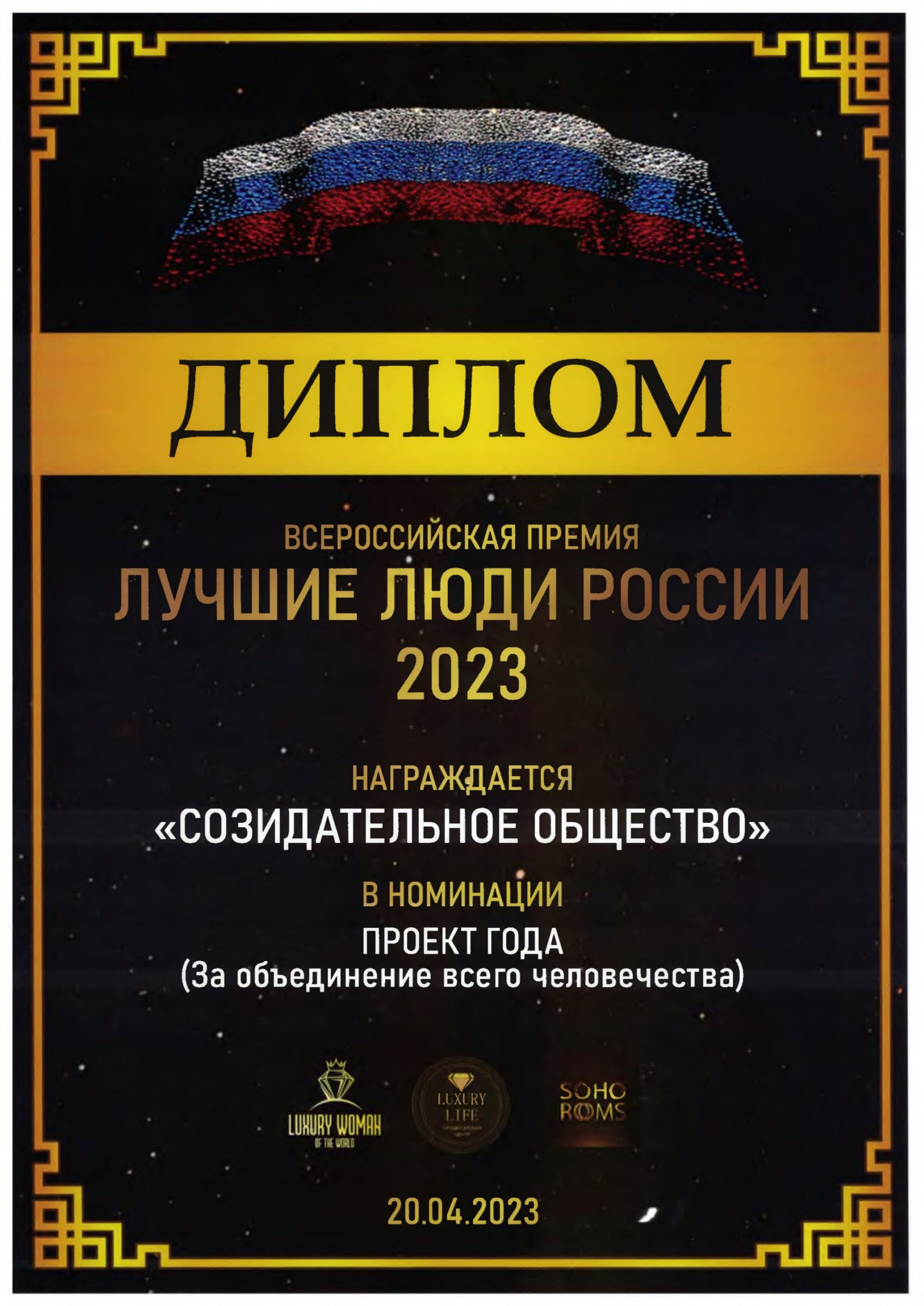
2. DIPLOMA OF AWARD PARTNER of the Annual TOP 100 Award in the "MOST UNIFYING PROJECT OF HUMANITY" category (Moscow, 2023);
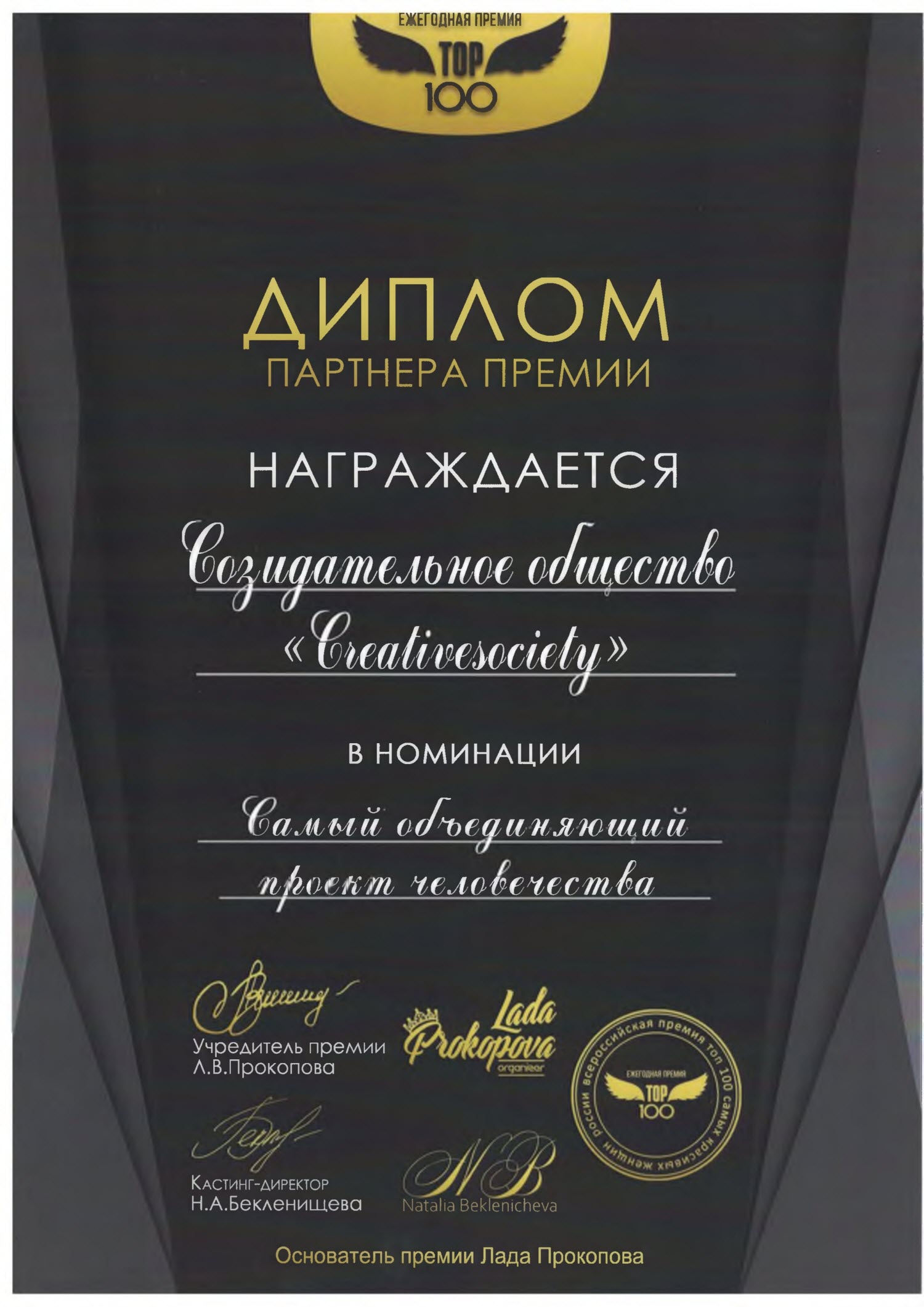
3. DIPLOMA of the annual business forum and award "Fair Business Awards 2022" in the "BEST SOCIAL PROJECT" category (Moscow, 2022);
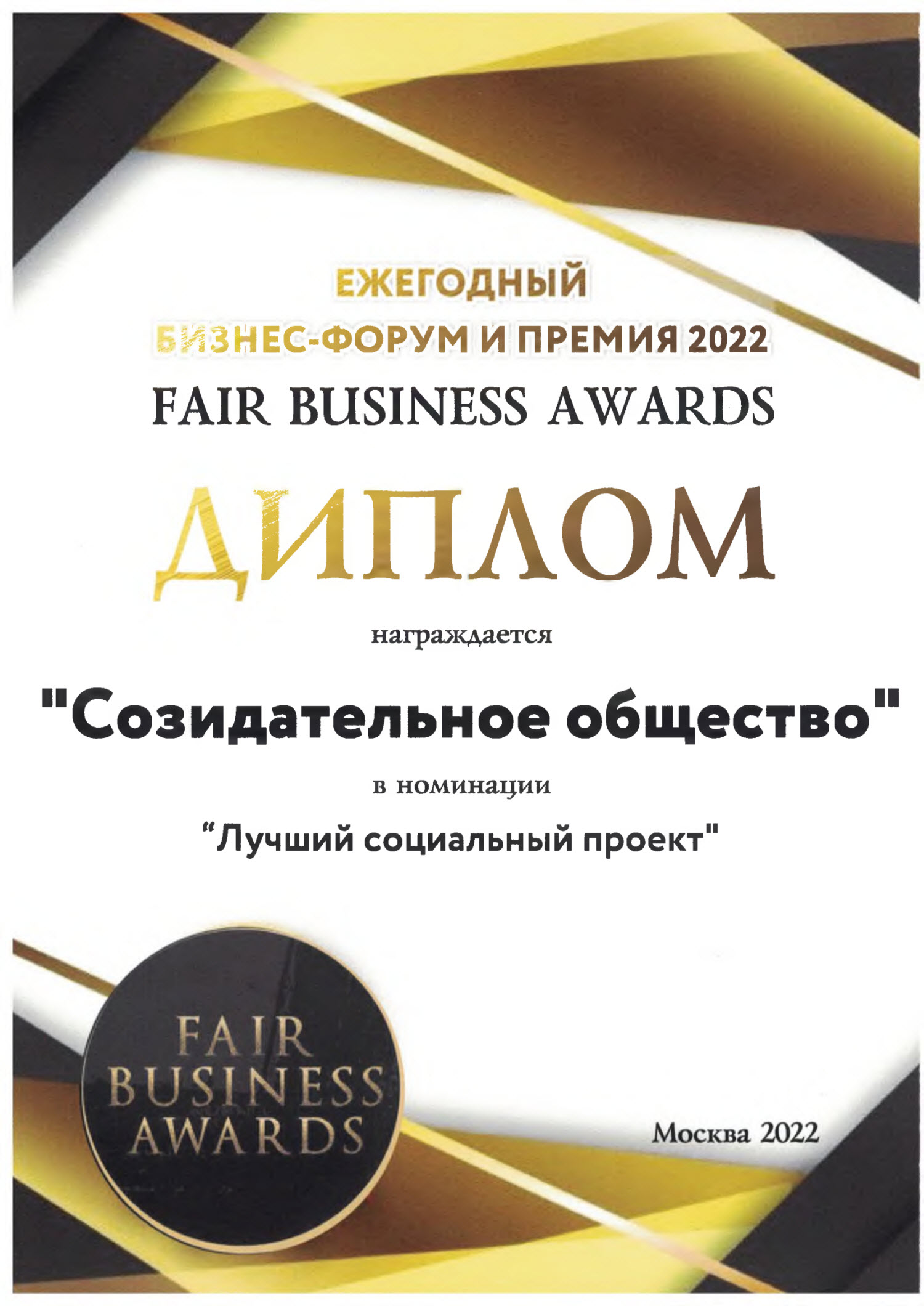
4. DIPLOMA of the Winner of the People's Award "Achievement of Russia 2022" in the "PROJECT OF THE YEAR 2022" category (Moscow, October 11, 2022);
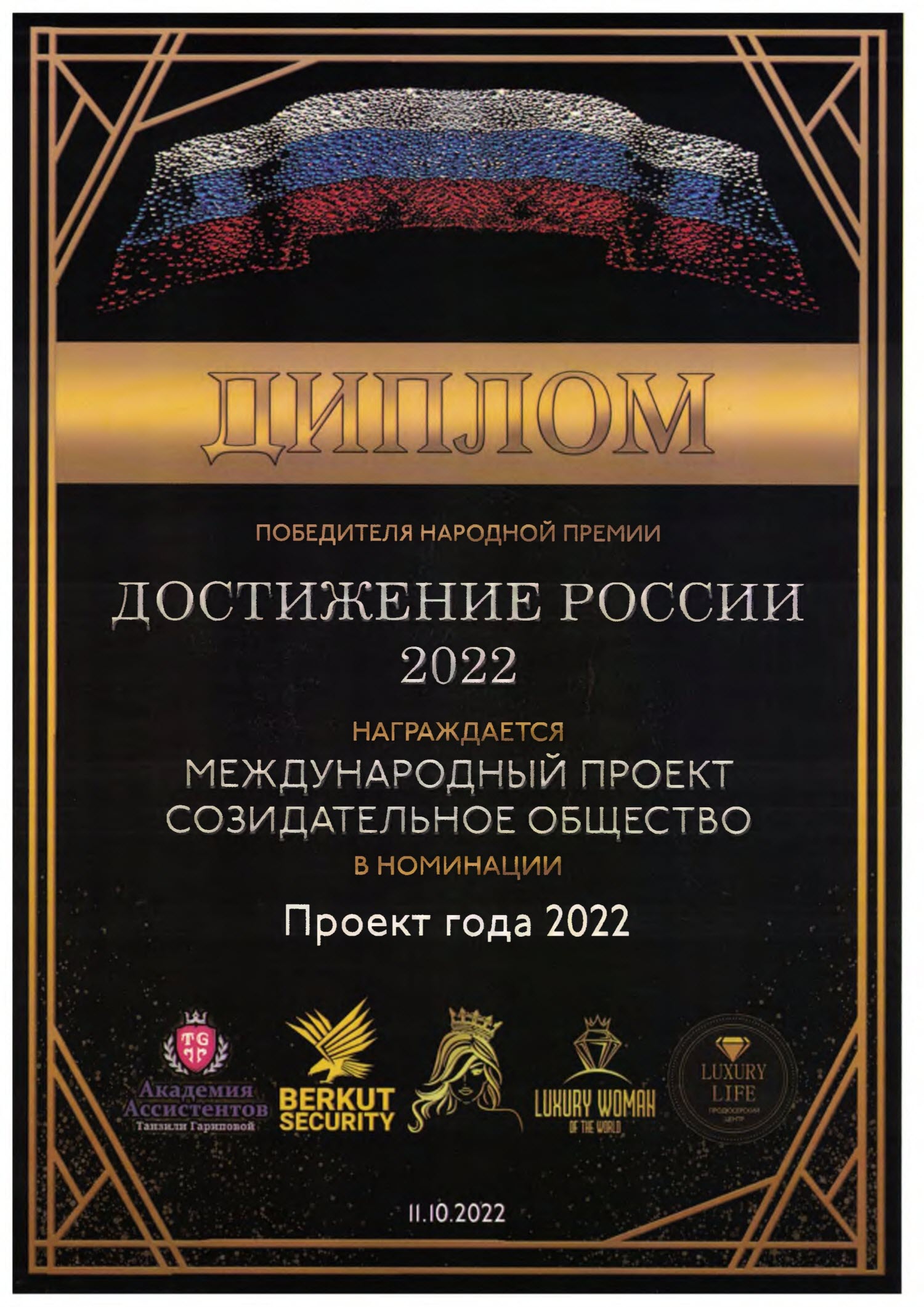
5. DIPLOMA of the International Award "SUCCESS–2022" by the All-Russian Public Organization "Businesswomen of Russia" in the "MOST GLOBAL PROJECT OF HUMANITY" category (Moscow, 2022);
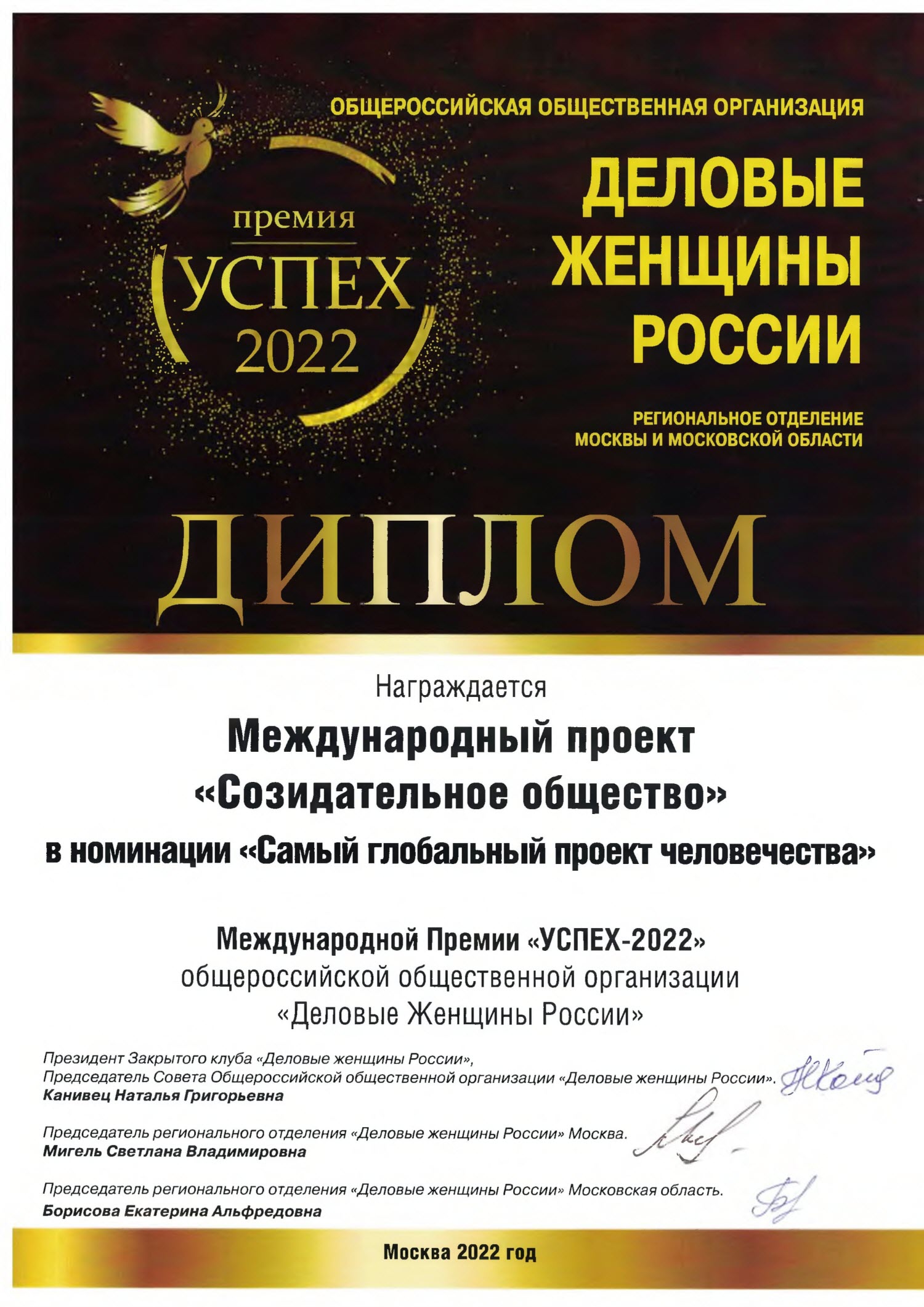
6. DIPLOMA OF AWARD PARTNER of the Annual TOP 100 Award in the "BEST MEDIA ALLIANCE OF SIBERIA" category, from the award's founder L.V. Prokopova (Novosibirsk, 2022);
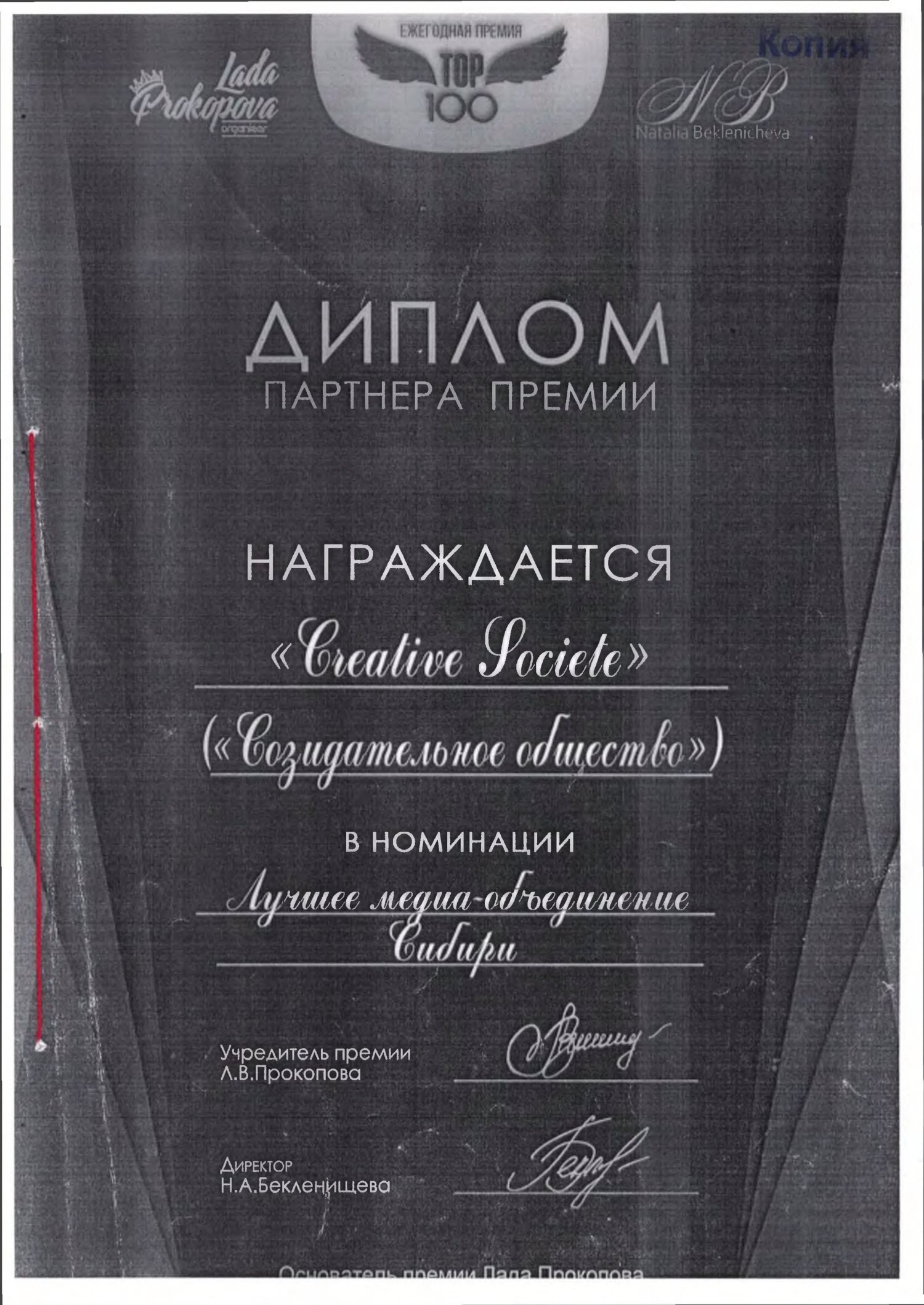
7. Letter of Appreciation from the Association of Cosmonautics Museums of Russia (AMKOS) and the company "Alternativa 777" — organizers of the international festival "Time to Go to Space," held on April 9–10 and 12, 2022, at VDNH and the Moscow Planetarium (Moscow, 2022);
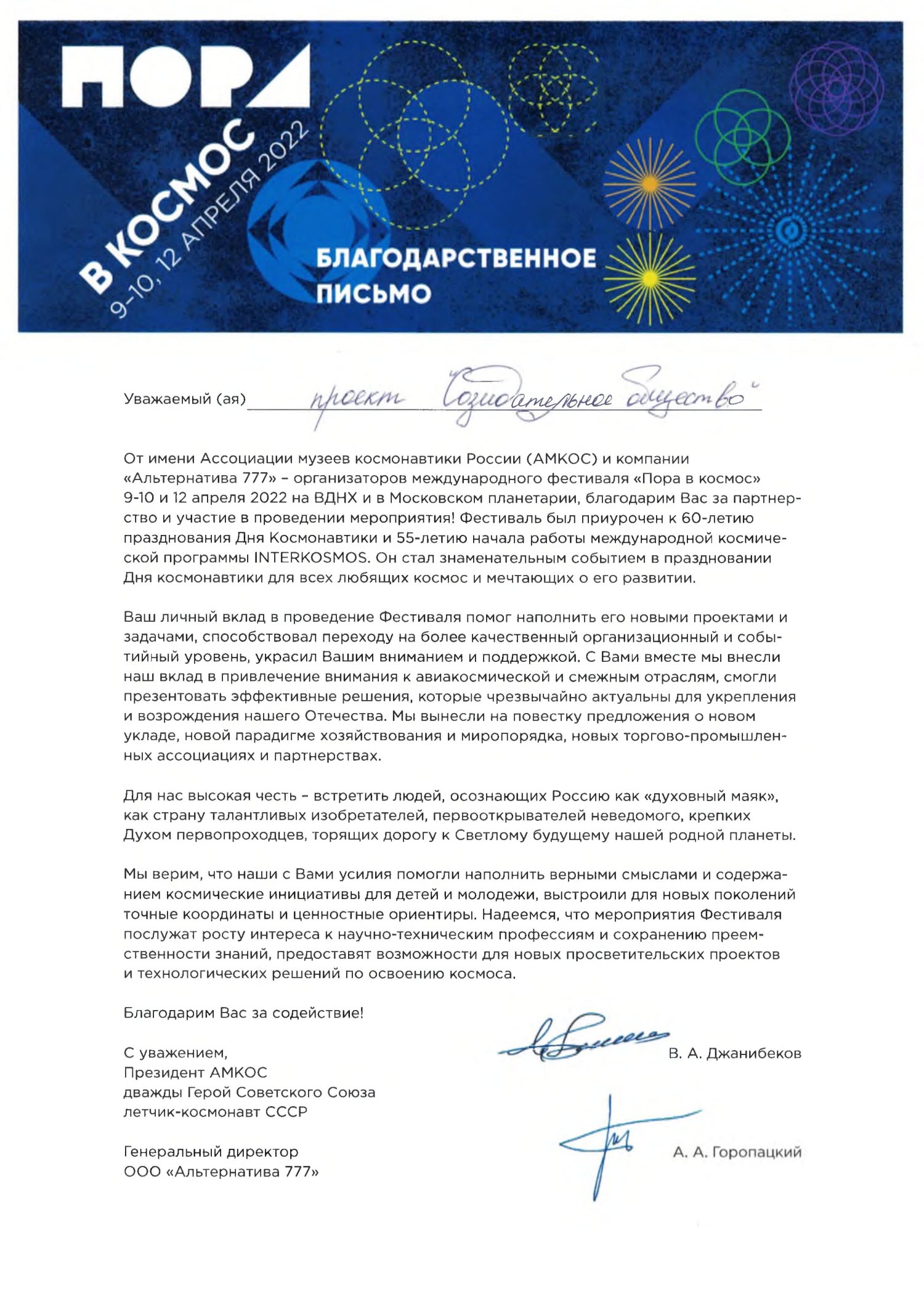
8. Letter of Appreciation for supporting and developing the youth fashion industry in Siberia from FASHION DAY NOVOSIBIRSK (Novosibirsk, February 11, 2023);
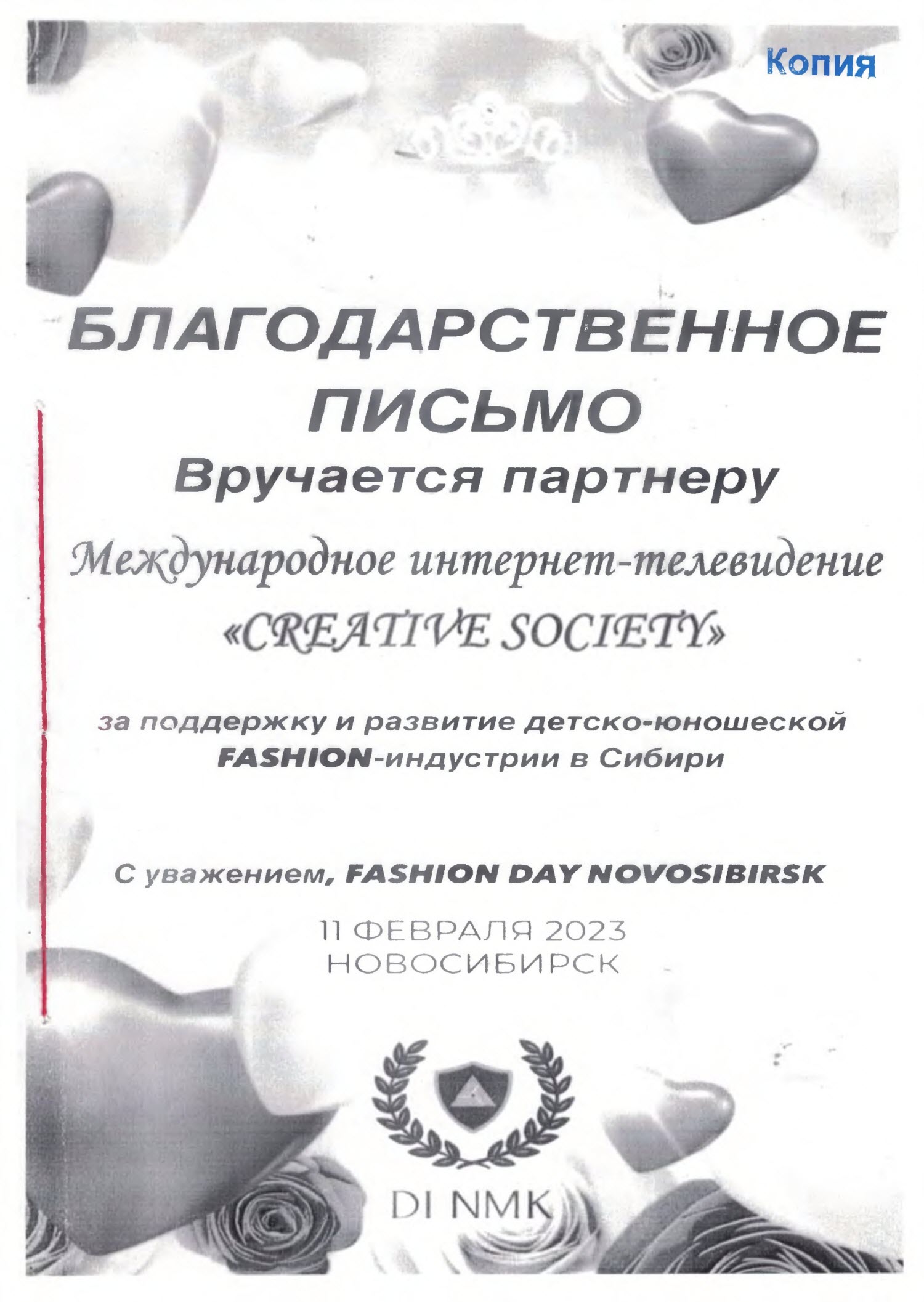
9. Letter of Appreciation for supporting and developing the youth fashion industry in Siberia from the Director of the Agency "STAR CHILDHOOD" (Novosibirsk, 2023);
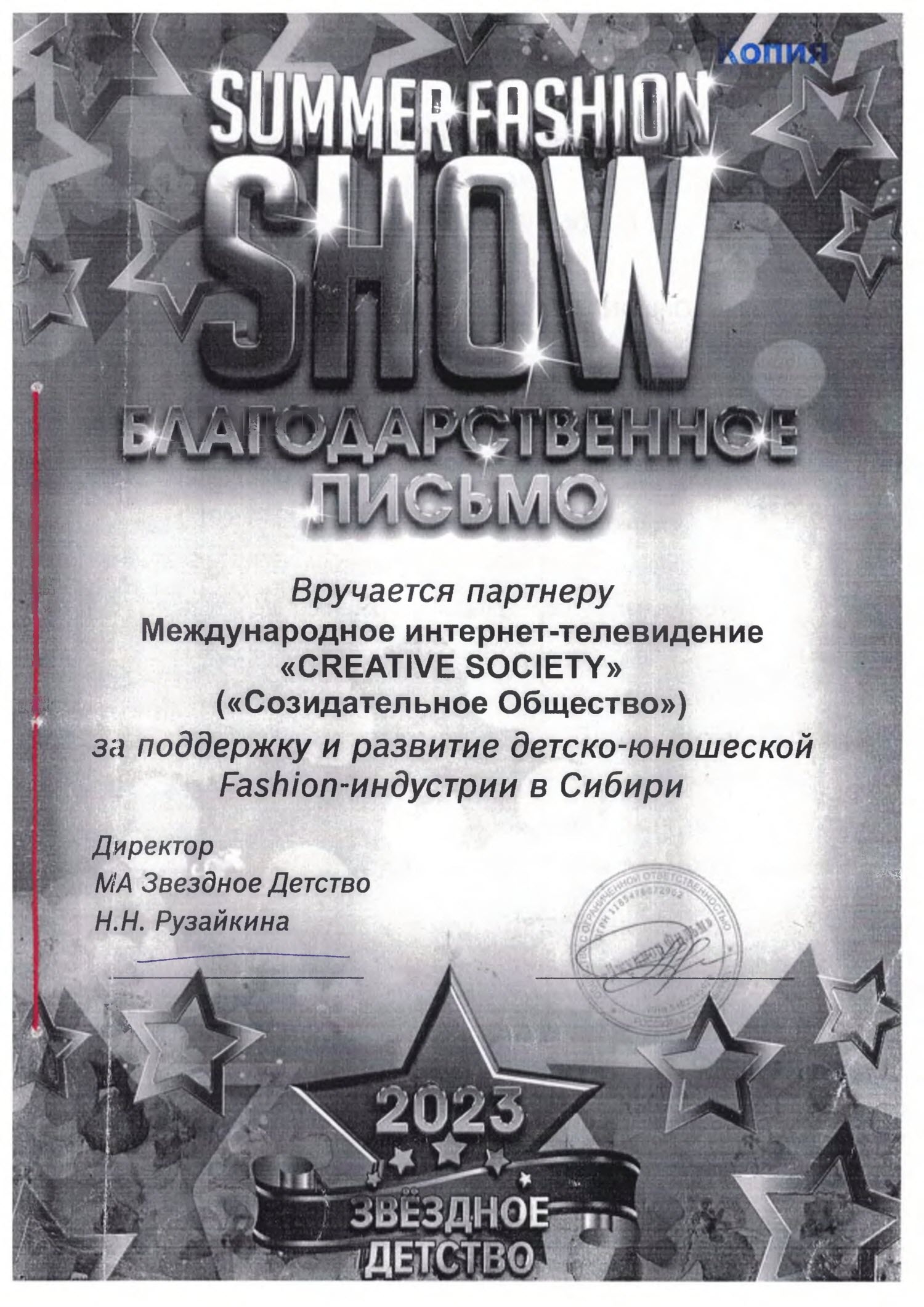
10. Letter of Appreciation for participating as a PARTNER in the Lady Novosibirsk 2023 project. "We consider it an honor to cooperate with you and express hope for continued collaboration," from the director of Lady Novosibirsk (Novosibirsk, 2023);
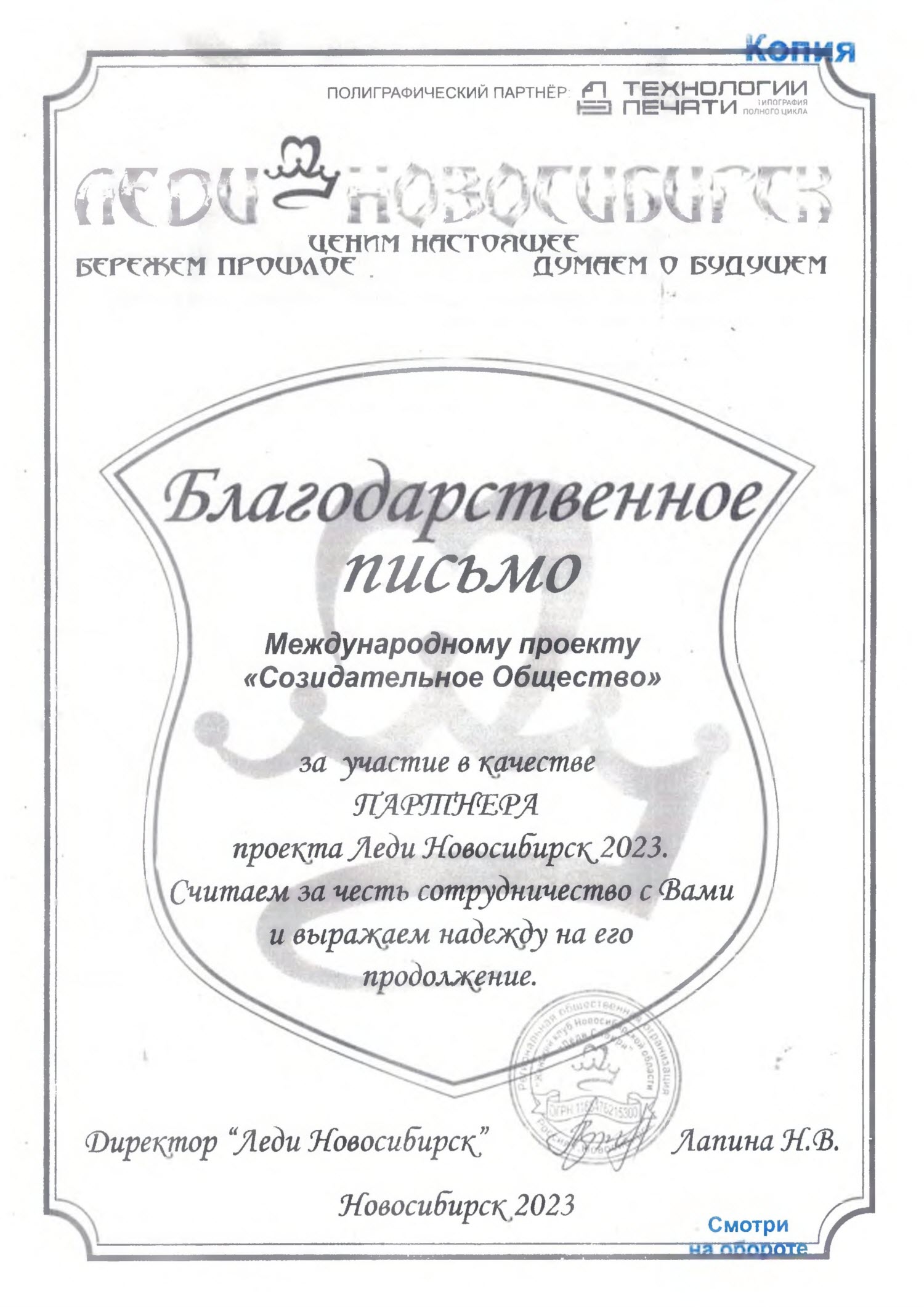
11. Letter of Appreciation for assisting in organizing the music festival "PROWomen — Music of Our Hearts" from the International Community PROWomen (January 22, 2023);
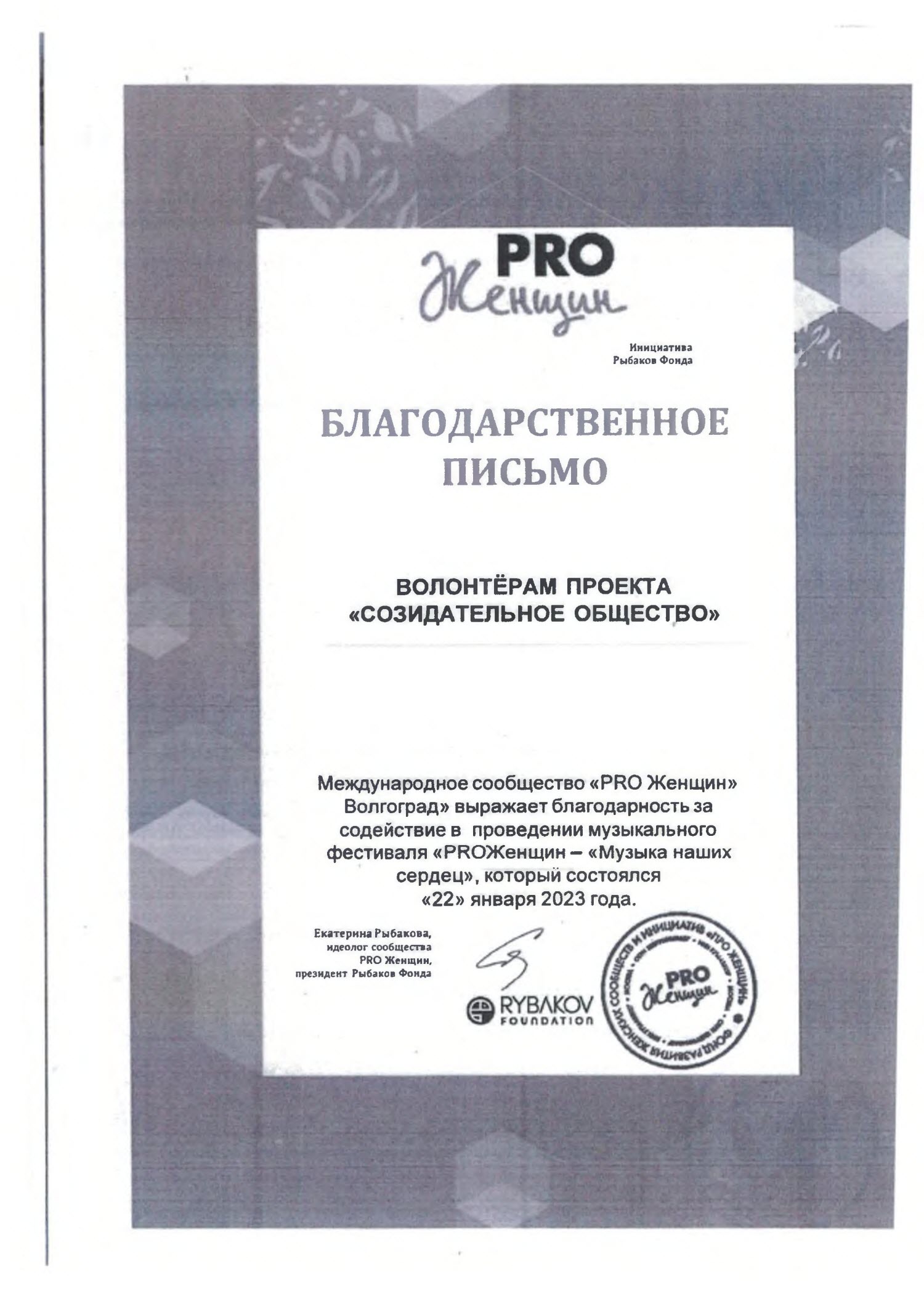
12. Letter of Gratitude for support and work as part of the first children's project "Mom's Princess" from the executive director of the Autonomous Nonprofit Organization for Cultural and Educational Activities "Creative Association MAMA" (2022);

13. Letter of Gratitude for contribution to the development of the "PROWomen Volgograd" community and active support for women's leadership (2023);
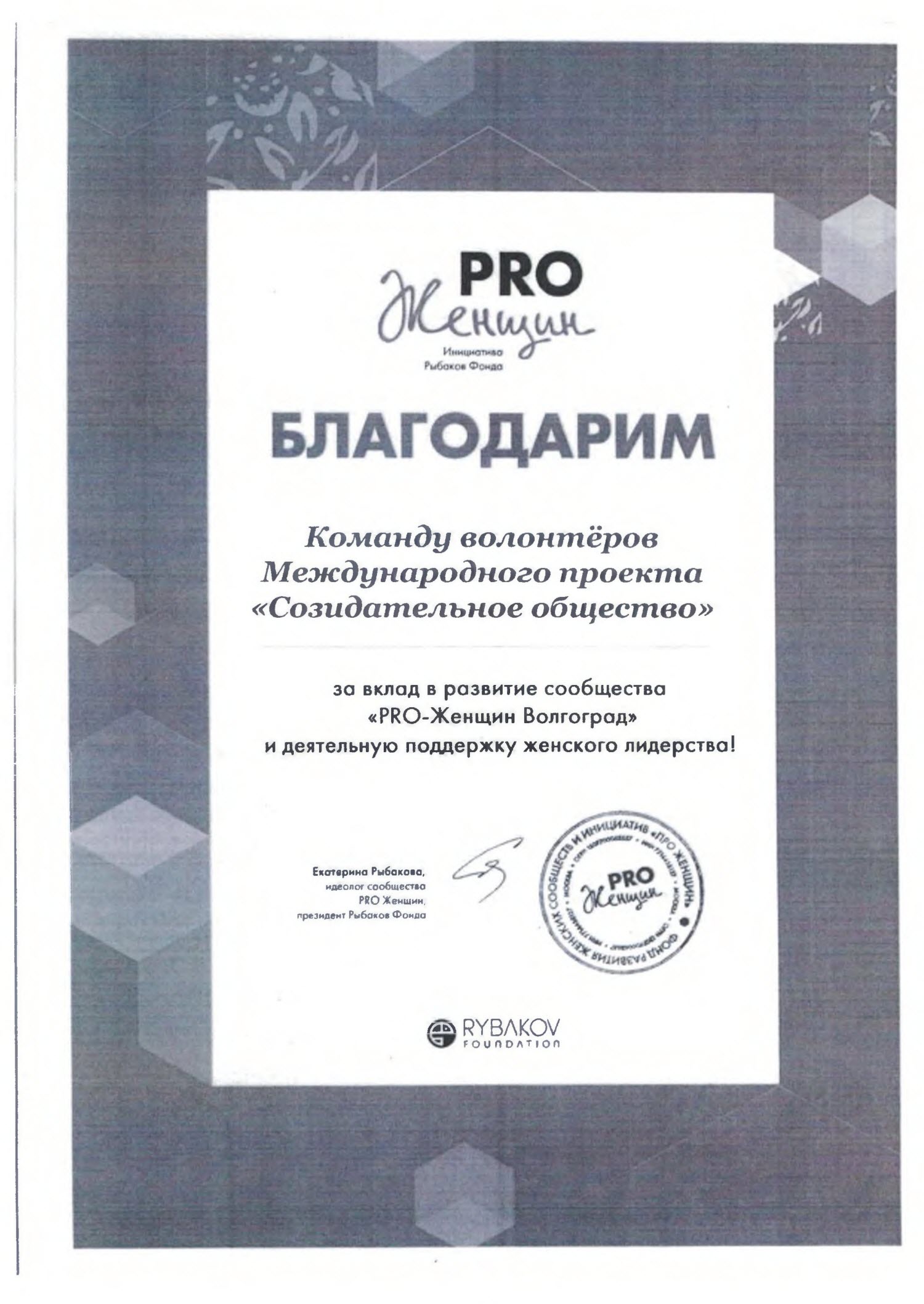
14. Letter of Gratitude for providing sponsorship and assistance in organizing the "PERSONO of the Year" award (Moscow, April 26, 2023);
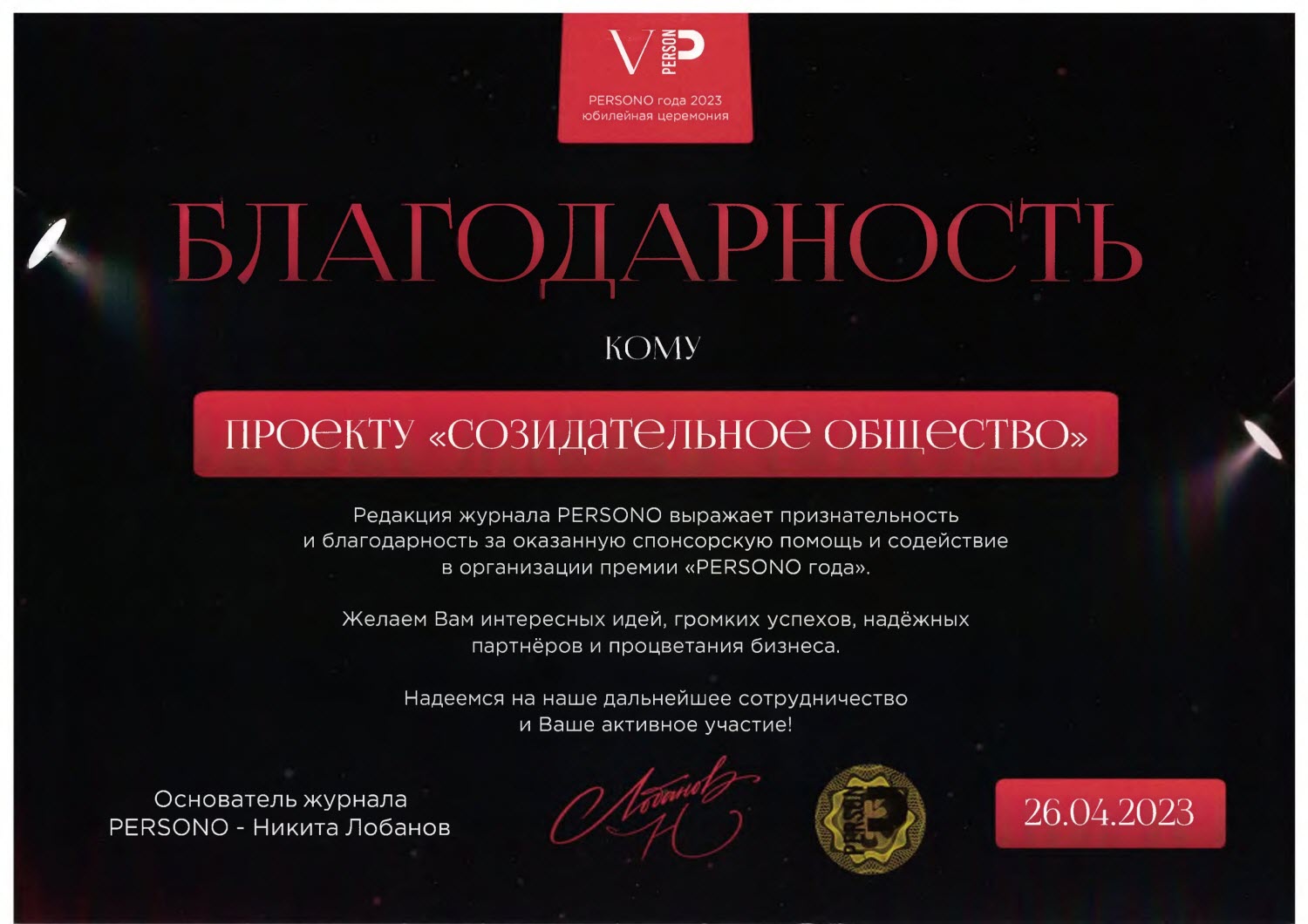
15. Letter of Appreciation for cooperation, partnership, and support in organizing the FINALS of the "Our Beautiful MOM-2021" project (January 22, 2022);
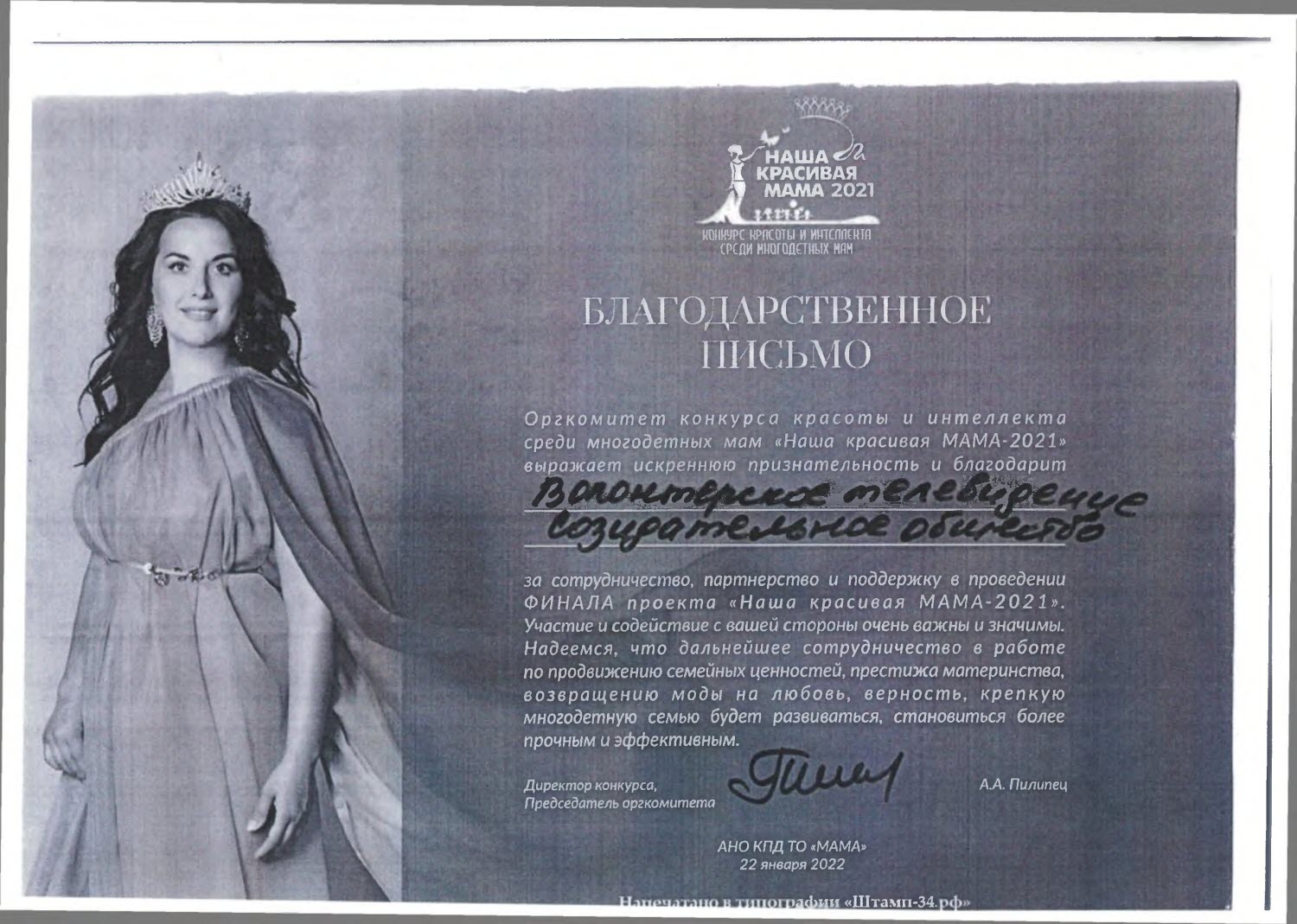
16. Letter of Gratitude for support and assistance in holding the international award "Success" from LLC "Businesswomen of Russia 2022" (Moscow, 2022);
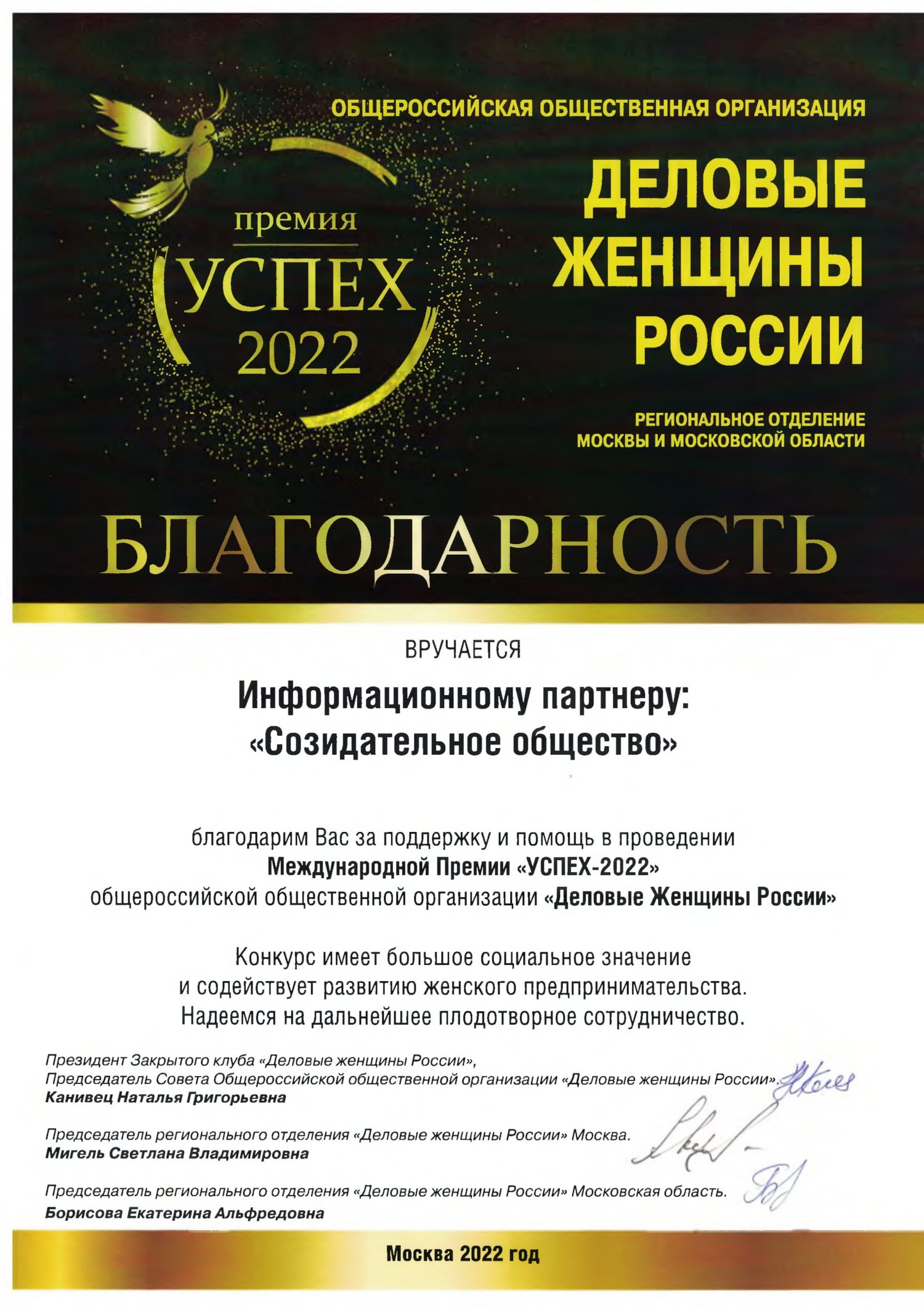
17. Letter of Gratitude for media support of a charitable Christmas tree event for children and the social project "Hugs Without Borders." "We value your contribution to the development of inclusive communities" (2023).
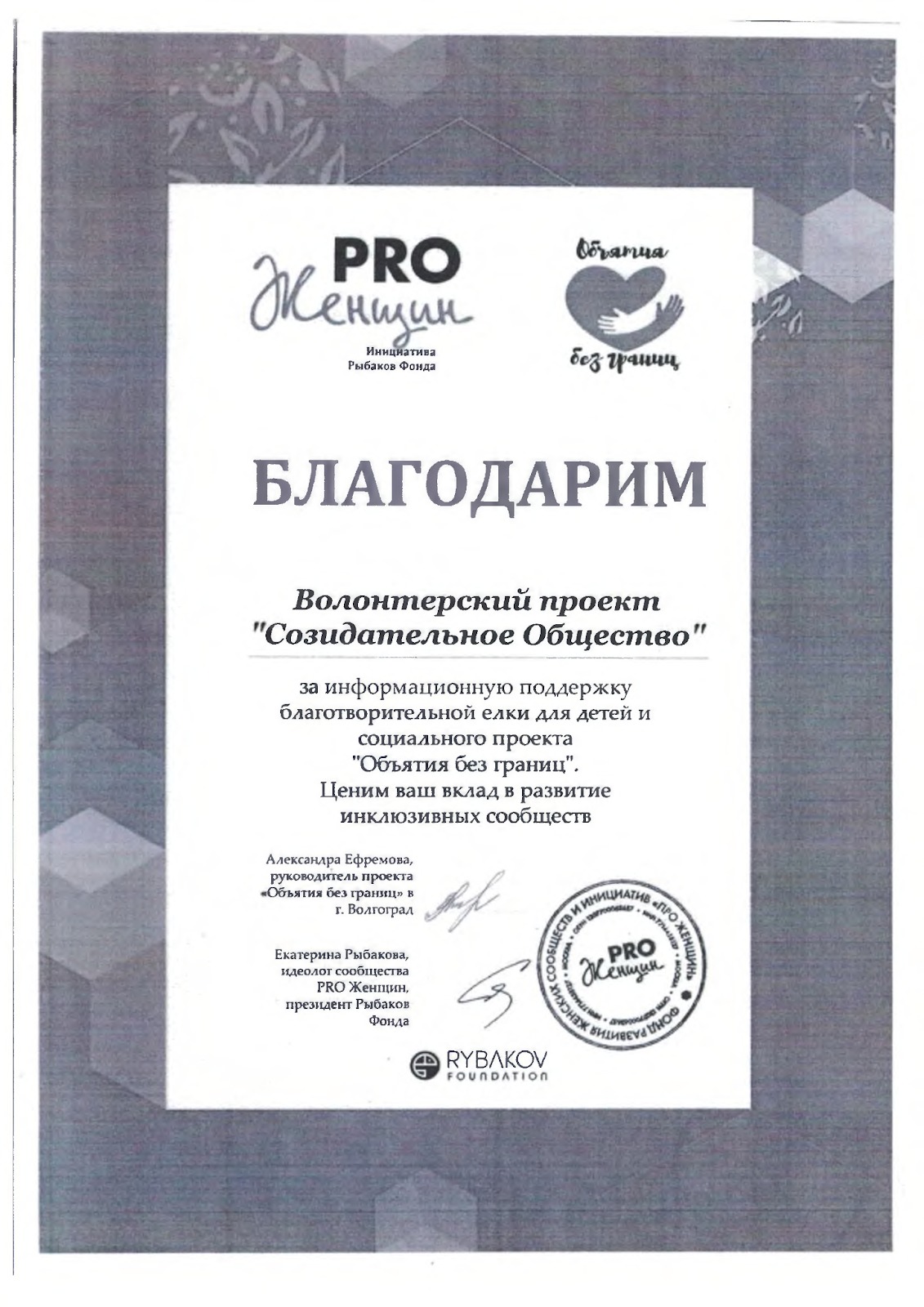
However, Justice of the Peace S.I. Pridannikov failed to properly evaluate the evidentiary materials presented by the defense. Likewise, Justice of the Peace S.I. Pridannikov did not fully consider the defense’s arguments that the activities of the Creative Society project are not religious in nature. In essence, the Creative Society is an international project; i.e. it’s an idea (not an organization or movement), the implementation of which is aimed at improving the quality of life for every individual.
Creative Society is an independent international (all-humanity's) project that brings together people from more than 180 countries on a voluntary basis, regardless of their race, skin color, sex, language, religion, political or other beliefs, national or social origin, property status, caste, or any other status. The project's activities have been carried out by volunteers in the Russian Federation in strict accordance with Russian laws (in particular, Articles 29 and 30 of the Constitution of the Russian Federation) and with respect for every individual and their choices. The project addresses socially significant issues, primarily those related to global climate change and, as a consequence, the sharp increase in natural disasters in recent years, as well as various societal crises (economic, environmental, and climate-related).
The volunteer TV channel of the Creative Society project in Russia cooperated with many public organizations, cultural and arts institutions, such as the Association of Social Supporters of the President of Russia, the International Forum "Golden Knight," research institutes, the Chamber of Commerce and Industry of the Russian Federation, as well as scientists. Project volunteers participated in high-profile public events, conducted public surveys, interviews, and forums to gather and share public opinion from around the world. Creative Society international project is an independent platform that brings together the efforts of people across the globe for peaceful and evolutionary transformation of our society.
Thus, given the above, the Creative Society project does not exhibit any religious character in its activities. However, Justice of the Peace S.I. Pridannikov failed to conduct a comprehensive examination of the Creative Society project’s activities.
Moreover, the defense submitted motions to summon and question the victim / witness N.A. Agafonova and the expert E.V. Shchetinina. Nonetheless, by rulings of Justice of the Peace S.I. Pridannikov, dated July 10, 2023, the defense’s motions were denied, namely:
- The motion to summon and question N.A. Agafonova as a witness was denied on the grounds of a report by precinct police officer A.S. Paderina, stating that Agafonova was not feeling well. However, this witness's health condition was not confirmed by any medical documents — no such certificates are present in the case files;
- The motion to summon and question E.V. Shchetinina as a witness was denied on the alleged grounds of her being allegedly on vacation outside Chelyabinsk Region. This claim wasn't supported by any credible evidence.
According to Part 2 of Article 25.6 of the CAO RF, a witness is obligated to appear when summoned by a judge, authority, or official handling the administrative offense case, and to provide truthful testimony: to disclose everything they know about the case, answer questions posed to them, and confirm the accuracy of their recorded testimony with their signature in a corresponding protocol. In accordance with Part 6 of Article 25.6 of CAO RF, a witness who refuses or evades the duties specified in Part 2 of Article 25.6 of the CAO RF bears administrative liability as established by the CAO RF.
Yet, despite the absence of proper evidence confirming valid reasons for failing to appear in court to give testimony, justice of the peace S.I. Pridannikov denied the defense's motions to summon and question N.A. Agafonova and E.V. Shchetinina.
In the court hearing transcript [Volume 2, p. 35, Photo 27], the following is stated regarding the inability to question the aforementioned witnesses:
"Justice of the Peace: 'E.V. Shchetinina was unable to come, as she is on vacation outside Chelyabinsk Region. She submitted copies of documents.'
"Justice of the Peace: 'Witness N.A. Agafonova.'
A.S. Paderina: 'Witness N.A. Agafonova is unable to appear due to health reasons (high blood pressure)'."
It appears that precinct police officer A.S. Paderina is also moonlighting as a physician or paramedic, since she personally diagnosed N.A. Agafonova. No medical documentation regarding Agafonova's health condition was submitted to the court. Nevertheless, Justice of the Peace S.I. Pridannikov accepted her word at face value and considered it sufficient evidence to issue a ruling denying the defense’s motion to summon and question N.A. Agafonova. This is inadmissible and constitutes a gross violation.
By his ruling partially granting the motion, dated July 10, 2023 [Volume 1, p. 115, Photo 53], justice of the peace S.I. Pridannikov denied the motion by attorney O.E. Stepanov in the part of summoning and questioning E.V. Shchetinina, citing her alleged inability to attend the court session for supposedly valid reasons. As justification for the refusal, the judge stated in the reasoning section of the ruling that, according to information from precinct police officer A.S. Paderina, E.V. Shchetinina was on vacation and had left the Chelyabinsk Region.
Furthermore, only AFTER the ruling was issued by justice of the peace S.I. Pridannikov on July 21, 2023, during the defense's review of the case materials, a certificate dated July 10, 2023 [Volume 1, p. 197, Photo 64] was discovered in the case files. It had been issued by E.V. Shchetinina, director of ANO "Center for Cultural and Religious Studies, Socio-Political Technologies, and Educational Programs," about herself, stating that she was on vacation from July 3 to July 28, 2023. The certificate was neither disclosed to the participants of the proceedings nor announced by the court during the hearings on July 10, 2023 or July 14, 2023 (it is absent from the protocols and audio records of July 10 and 14, 2023). It should be noted that this certificate does not constitute admissible evidence of a valid reason for failure to appear as a witness, since being on vacation did not prevent E.V. Shchetina from attending court. Moreover, vacation leave is formalized in accordance with labor legislation requirements by an order granting leave, whereas in this case only a certificate was submitted to the court.
Meanwhile, the certificate from ANO "Center for Cultural and Religious Studies, Socio-Political Technologies, and Educational Programs," addressed to Judicial Precinct No. 1 of Plast, Chelyabinsk Region, dated July 10, 2023 [Volume 1, p. 197, Photo 64], bears signatures of director E.V. Shchetina and chief accountant S.S. Bredikhin. This organization is located in the city of Chelyabinsk, as confirmed by the details indicated on the certificate letterhead. Thus, by signing the certificate as director, E.V. Shchetina was physically present in Chelyabinsk on July 10, 2023, that is, within the Chelyabinsk Region.
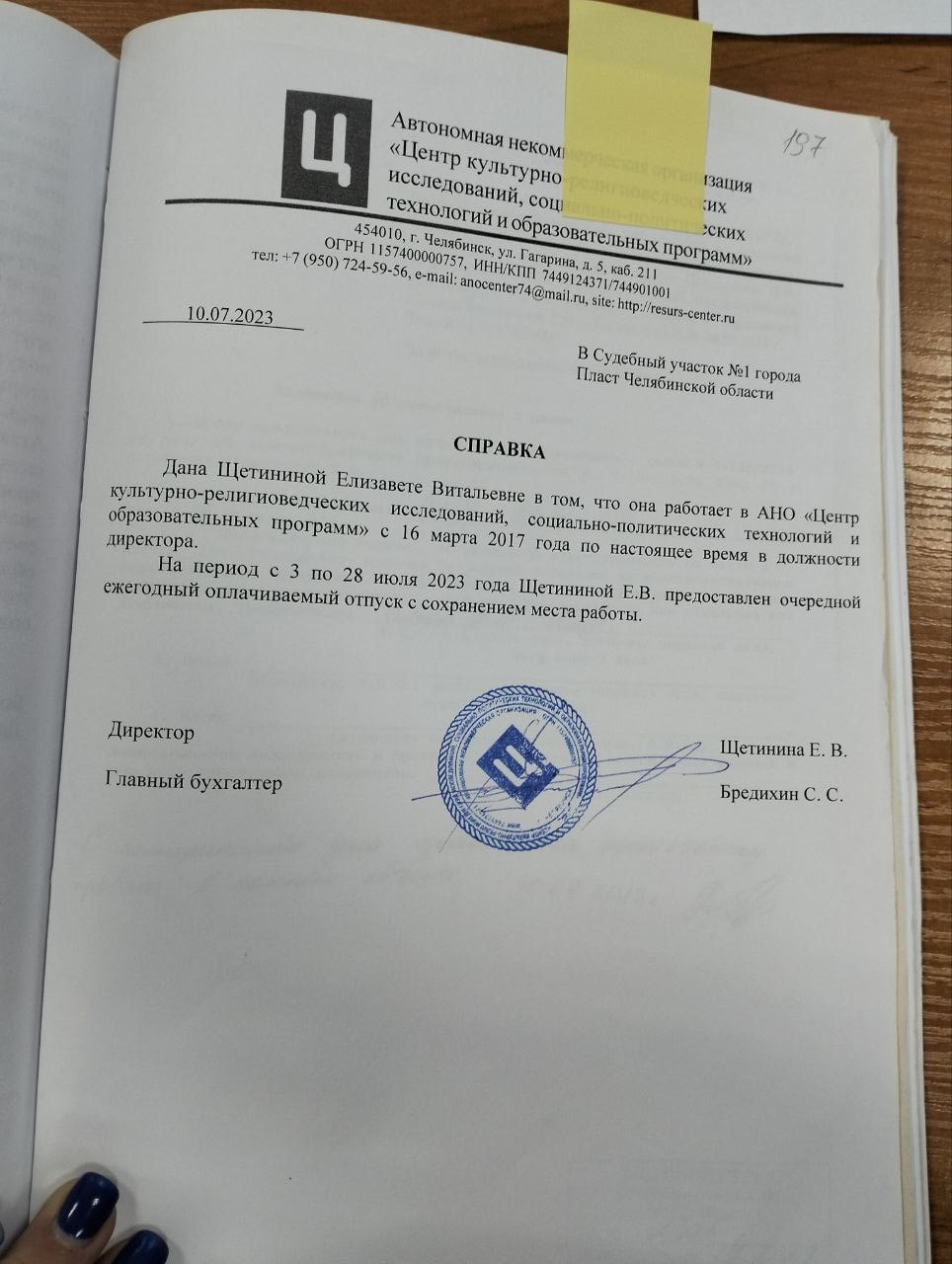
Photo 64: Certificate of ANO "Center for Cultural and Religious Studies, Socio-Political Technologies, and Educational Programs," addressed to Judicial Precinct No. 1 of Plast, Chelyabinsk Region, and dated July 10, 2023
Hence, when refusing to grant part of the motion submitted by lawyer O.E. Stepanov, justice of the peace S.I. Pridannikov did not critically assess the stated facts, based his ruling on unreliable information, and unlawfully denied the summons and questioning of E.V. Shchetinina.
The refusal to summon and question the actual witnesses in the case without valid reasons for their absence, and the granting of the prosecution’s motion to question persons as witnesses who do not meet the requirements of the CAO RF for witness status, constitutes a gross procedural violation, and indicates the bias of justice of the peace S.I. Pridannikov. Thus, by accepting inadmissible evidence and arguments from the prosecution and failing to fully and comprehensively verify the defense’s arguments and evidence, Justice of the Peace S.I. Pridannikov effectively created a situation where the procedural opportunities of the parties were unequal and the prosecution was placed in a preferential position with signs of vested interest in the outcome of the case, which violates the constitutional principles of adversarial proceedings and equality of the parties in the consideration of an administrative offense case.
7. Justice of the Peace S.I. Pridannikov misapplied and misinterpreted substantive law, specifically the provisions of Federal Law No. 125‑FZ “On Freedom of Conscience and on Religious Associations” dated September 26, 1997
Bringing citizens to administrative liability under Part 4 of Article 5.26 of the CAO RF requires consideration of all circumstances surrounding the offense committed. The imposition of an administrative penalty for violating certain rules established by a competent legislative or executive authority is permissible only when the general grounds for administrative liability, outlined in Article 2.1 of the CAO RF are met, which require proof of wrongful, guilty action (or omission) of a natural person or legal entity.
According to Article 26.11 of the CAO RF, as emphasized repeatedly by the Constitutional Court of the Russian Federation, a judge, members of a collegiate body, or official, trying a case concerning an administrative offence, shall evaluate evidence guided by their inner conviction based on comprehensive, full and unbiased examination of all the circumstances of the case in the aggregate. This implies issuing a reasoned decision in the case of an administrative offense (rulings No. 28-O-O of January 27, 2011, No. 71-O-O of January 25, 2012, No. 2118-O of November 22, 2012, No. 1088-O of May 21, 2015, No. 1723-O dated July 17, 2018, etc.).
Article 26.1 of the CAO RF establishes that in a case of administrative offense, it is necessary to determine the following: the occurrence of the administrative offense; the person who committed the unlawful act (or omission) for which administrative liability is provided under the present Code or the law of a constituent entity of the Russian Federation; the culpability of the person in committing the administrative offense and other circumstances relevant for the proper resolution of the case.
The objective element of the administrative offense under Part 4 of Article 5.26 of the CAO RF is represented by actions of individuals and legal entities that meet the characteristics of missionary activity, conducted in violation of the requirements established by legislation on freedom of conscience, freedom of religion, and religious associations (see: Ruling of the Third Court of Cassation of General Jurisdiction dated April 24, 2020, No. 16-1021/2020 “On the annulment of rulings imposing liability under Article 5.26 of the CAO RF”).
As repeatedly stated by the Constitutional Court of the Russian Federation, missionary activity of a religious association, as defined in the context of the legal relations governed by the provisions of the Federal Law “On Freedom of Conscience and on Religious Associations,” refers to activities that: first, are carried out by a specific group of persons (a religious association, its members, and other individuals or legal entities in accordance with established procedure); second, are aimed at disseminating information about their religious doctrine (its theological tenets) among persons who are not participants (members, followers) of the given religious association; third, are intended to involve such persons as participants (members, followers) of the religious association by appealing to their consciousness, will, and emotions, including through the expression by the person conducting the missionary activity of their own religious views and beliefs. (see rulings of the Constitutional Court of the Russian Federation, dated March 13, 2018 No. 579-O, October 15, 2018, No. 2514-O, October 10, 2019, No. 2683-O, and February 11, 2021, No. 179-O.)
It has also been noted that the defining, cornerstone criterion of missionary activity is the dissemination by individuals or their associations of information about a specific religious doctrine among persons who, not being its followers, are thereby drawn into that circle, including as members of a specific religious association. The absence of this feature in activities conducted in the field of religious relations indicates that such activity cannot be qualified as missionary activity within the meaning of Federal Law No. 125-FZ. Nor can public dissemination of information about a specific religious doctrine, aimed at neutral informing of the public about the religious association and its activities be regarded as missionary activity (see rulings of the Constitutional Court of the Russian Federation, dated March 13, 2018, No. 579-O, October 15, 2018, No. 2514-O, and October 10, 2019, No. 2683-O).
Thus, one of the legally significant factors in classifying actions as missionary in nature is the establishment of the semantic content of the disseminated information. Mere distribution of printed materials cannot, in and of itself, be classified as missionary activity. Any other interpretation would lead to an absurd outcome in which distribution by a NON-religious organization of even fairy tales by A.S. Pushkin would fall under the definition of missionary activity. At the same time, not every act of disseminating information, even by a religious association, is automatically considered missionary activity. To classify an activity as missionary, it is necessary to verify the presence of all its defining characteristics.
However, Justice of the Peace S.I. Pridannikov avoided determining and examining all the indicators of missionary activity in Vashchenkova M.Yu.’s actions, as required by Federal Law No. 125‑FZ “On Freedom of Conscience and on Religious Associations,” dated September 26, 1997. Instead he applied the “principle of objective imputation” (that is, holding a person administratively liable in the absence of fault).
The defense conducted and submitted to the court a comparative analysis aligning the 8 Pillars of the Creative Society with provisions of the Russian Constitution and international legal instruments to demonstrate their compatibility. The core value of the Creative Society format is Human Life, and everything is aimed at improving living conditions for people, overcoming the dead end of the current consumerist format of society, and resolving all crises. The fundamental principle of the Creative Society is the following: by improving life for society, you improve your own life.
By participating in the Project, individuals exercise their rights to freedom of association, belief, thought, expression, access to and transmission of information, freedom of conscience, freedom from discrimination, along with other inalienable human rights guaranteed by national legislation (in particular, the Constitution of the Russian Federation, Articles 29, 30, and 31) and norms of international law (in particular, the Universal Declaration of Human Rights, Articles 1, 2, 6, 17–20, and 28; the International Covenant on Civil and Political Rights, Articles 16, 18, 19, and 21; the Helsinki Final Act, Section VII, Respect for human rights and fundamental freedoms, including the freedom of thought, conscience, religion or belief).
The project’s activities were carried out by volunteers across the Russian Federation in strict compliance with Russian legislation and ratified international legal norms, while upholding respect for every individual and their choice. Informing the public about the Creative Society international project did not contradict but in fact aligned with the legal norms enshrined in the Constitution of the Russian Federation.
8 Pillars of the Creative Society
1. Human Life. Human life is the highest value. Life of any Human has to be protected as one's own. The goal of society is to ensure and guarantee the value of each Human's life. There is not and never can there be anything else more valuable than a Human's life. If one Human is valuable, then all People are valuable!
2. Human Freedom. Every human is born with the right to be a Human being. All People are born free and equal. Everyone has the right to choose. There can be no one and nothing on Earth superior to a Human, his freedom, and rights. The implementation of Human rights and freedoms must not violate the rights and freedoms of other people.
3. Human Safety. No one and nothing in society has the right to create threats to the life and freedom of a Human! Every Human is guaranteed free provision of essential life necessities, including food, housing, medical care, education and full social security. Scientific, industrial, and technological activities of the society should be aimed exclusively at improving the quality of human life. Guaranteed economic stability: no inflation or crises, the same stable prices around the world, one monetary unit, a fixed minimal taxation, or no taxation at all. The safety of Human and society from any kind of threats is ensured by the unified global service that deals with emergency situations.
4. Transparency and openness of information for all. Every Human has the right to receive reliable information about the movement and distribution of public funds. Each Human has access to information about the status of implementation of the society’s decisions. The mass media belong exclusively to the society and reflect information truthfully, openly, and honestly.
5. Creative ideology. Ideology should be aimed at popularizing the best human qualities and at the extinction of everything that is directed against a Human. The main priority is the priority of humaneness, high spiritual and moral aspirations of a Human, humanity, virtue, mutual respect, and strengthening of friendship. Creating conditions for the development and education of a Human with a capital “H”, cultivating moral values in each person and society. Prohibition of propaganda of violence, condemnation and denunciation of any form of division, aggression, and anti-humane manifestations.
6. Development of Personality. Every Human in the Creative society has the right to comprehensive development and personal fulfillment. Education should be free and equally accessible to all. Creating conditions and expanding opportunities for a Human to implement his or her creative abilities and talents.
7. Justice and Equality. All natural resources belong to a Human and are fairly distributed among all people. Monopolization of resources and their irrational use is prohibited. These resources are fairly distributed among the citizens of the entire Earth. A Human is guaranteed employment if he or she so desires. Pay for an identical position, specialization, or profession should be the same all over the world. Everyone has the right to private property and income, however, within the limits on personal wealth set by the society for an individual.
8. Self-governing Society.The concept of "power" in the Creative Society is absent, since the responsibility for society as a whole, its development, living conditions and harmonious format, lies with each Human. Everyone has the right to participate in the management of the affairs of the Creative Society and in the adoption of laws that improve Human life. The resolution of socially important, socially significant, and economic issues that affect the quality of a Human’s life is submitted for public discussion and vote (referendum).
The aforementioned 8 Pillars of the Creative Society align with the constitutional rights and freedoms of individuals and citizens, as well as with the constitutional guarantees enshrined in the Constitution of the Russian Federation.
- The human being, its rights and freedoms are the supreme value. The recognition, observance and protection of the rights and freedoms of man and citizen shall be the obligation of the State. (Article 2, Constitution of the Russian Federation)
- Everyone has the right to life. (Part 1, Article 20, Constitution of the Russian Federation).
- The dignity of the person is protected by the state. Nothing may serve as grounds for its impairment. (Part 1, Article 21, Constitution of the Russian Federation).
- The multinational people of the Russian Federation are the vehicle of sovereignty and the only source of power in the Russian Federation. (Part 1, Article 3, Constitution of the Russian Federation).
- The people of the Russian Federation exercise their power directly, and also through public authorities and local self-government bodies. (Part 2, Article 3, Constitution of the Russian Federation).
- The referendum and free elections are the supreme direct manifestation of the power of the people. (Part 3, Article 3, Constitution of the Russian Federation).
- Every citizen of the Russian Federation has all the rights and freedoms on its territory and bears equal duties, stipulated in the Constitution of the Russian Federation. (Part 2, Article 6, Constitution of the Russian Federation).
- The Russian Federation is a social state, whose policies are aimed at creating conditions which ensure dignified life and free development of the human being. (Part 1, Article 7, Constitution of the Russian Federation).
- Land and other natural resources are used and protected in the Russian Federation as the basis of life and activities of the peoples living on the corresponding territory. (Part 1, Article 9, Constitution of the Russian Federation).
- The exercise of human and civil rights and freedoms must not violate the rights and freedoms of other persons. (Part 3, Article 17, Constitution of the Russian Federation). All are equal before the law and the court. (Part 1, Article 19, Constitution of the Russian Federation).
- Everyone has the right to housing. No one may be arbitrarily deprived of housing. (Part 1, Article 40, Constitution of the Russian Federation).
- Everyone has the right to healthcare and medical assistance. Medical assistance is provided to citizens in state and municipal healthcare institutions free of charge, at the expense of the corresponding budget, insurance contributions and other revenues. (Part 1, Article 41, Constitution of the Russian Federation).
- Everyone has the right to a favourable environment, reliable information about its condition and to compensation for the damage caused to one’s health or property by environmental offences. (Article 42, Constitution of the Russian Federation).
- Everyone has the right to education. (Part 1, Article 43, Constitution of the Russian Federation).
- Everyone is guaranteed the right to freedom of thought and speech. (Part 1, Article 29, Constitution of the Russian Federation).
- No one may be coerced to express one's views and convictions or to renounce them. (Part 3, Article 29, Constitution of the Russian Federation).
- Everyone has the right to freely seek, receive, transfer, produce and disseminate information by any lawful means. (Part 4, Article 29, Constitution of the Russian Federation).
- Freedom of the mass media is guaranteed. Censorship is prohibited. (Part 5, Article 29, Constitution of the Russian Federation).
Article 19 of the Universal Declaration of Human Rights, adopted by the United Nations General Assembly on December 10, 1948, affirms: “Everyone has the right to freedom of opinion and expression; this right includes freedom to hold opinions without interference and to seek, receive and impart information and ideas through any media and regardless of frontiers.”
Thus, the aforementioned facts confirm not only that the 8 Pillars of the Creative Society project do not contradict the Constitution of the Russian Federation, but also that the project itself lacks any religious orientation.
Moreover, under Parts 1 and 4 of Article 1.5 of CAO RF, a person may only be held administratively liable if there is proof of their guilt. Any reasonable doubt regarding guilt must be resolved in favor of the individual. The subjective element of the administrative offense in the form of engaging in missionary activity in violation of the law on freedom of conscience, freedom of religion, and religious associations is characterized by direct intent.
However, the materials of the administrative offense case do not establish, nor did the court establish, that M.Yu. Vashchenkova was aware of and regarded her actions as missionary activity, that is, activity as defined in Article 24.1 of the Federal Law “On Freedom of Conscience and on Religious Associations,” specifically the activity of a religious association aimed at disseminating information about the doctrine of a religious association among persons who are not participants (followers) of said religious association with the purpose to involve those persons as members (followers) of the religious association.
The defense and the defendant herself insisted that they do not consider the Creative Society project a religious association (organization or group), since it lacks the purpose defined in Articles 6, 7, and 8 of the Federal Law “On Freedom of Conscience and on Religious Associations,” of jointly professing and spreading a faith, as well as the features necessary for such a definition: a religious creed; the performance of worship services, other religious rites and ceremonies; religious education and upbringing of followers; as well as a leader or governing body. This is a social international volunteer project, completely independent of and unrestricted by any doctrine of faith. Accordingly, no printed materials about the Creative Society project contain any religious information about it (the project) as a distinct religious teaching.
In accordance with subparagraph 3 of Article 29.1 of the CAO RF, when preparing for the administrative offense case hearing, Justice of the Peace S.I. Pridannikov was required to determine, among other things, whether the administrative offense report and other reports provided for by CAO RF were properly drawn up, as well as whether other case materials were properly prepared. Part 2 of Article 50 of the Constitution of the Russian Federation prohibits the use of evidence obtained in violation of federal law in the administration of justice. Part 3 of Article 26.2 of the CAO RF prohibits the use of evidence in an administrative offense case if it was obtained illegally.
As noted above, pursuant to paragraph 4, Part 1 of Article 29.4 of the CAO RF, when preparing to consider an administrative offense case, Justice of the Peace S.I. Pridannikov was required to issue a judicial ruling returning the administrative offense report and other materials to the body or official who had drawn up the report, due to the report and other case materials having been prepared by unauthorized persons, incorrect documentation of the report and other materials, or incompleteness of the submitted materials that could not be remedied during the case hearing.
These numerous procedural deficiencies committed by police officers in Chelyabinsk Region should not have been remedied by Justice of the Peace S.I. Pridannikov during the case hearing. As a result, the administrative offense report and the accompanying materials were subject to return to the official who had prepared the administrative offense report. However, this was not done. Justice of the Peace S.I. Pridannikov lost that opportunity, as returning the report for correction after the start of the administrative offense hearing is not provided for under CAO RF. It is impossible to correct the violation at the stage of hearing the case and appeals.
This violation of the requirements of the CAO RF is significant, as it affected the thoroughness, completeness, and objectivity of the case review, as well as the legality of the ruling issued. Under these circumstances, there are clear violations of the law, indicating that unlawful actions of the duty officer of the Department of the MIA A.I. Serkunov, precinct police officers S.S. Kartsev and A.S. Paderina, head of the Criminal Investigation Unit V.V. Toporkov, deputy chief of public order police A.A. Mikurov, head of Plast District Department of the MIA A.A. Demin, police chief of the Department of the MIA A.A. Asadullin, deputy head of the Center for Combating Extremism E.V. Ospinnikov, deputy head of the Department for Countering Extremism — false witness S.O. Manturov, head of the Center for Combating Extremism of MD MIA I.V. Yelesin, Justice of the Peace S.I. Pridannikov, false witness K.V. Putnik, and pseudo-expert E.V. Shchetinina, bear the hallmarks of crimes under Part 2 of Article 35 of the CC RF (Criminal Collusion), Article 285 of the CC RF (Abuse of Official Powers), Article 286 of the CC RF (Exceeding Official Powers), Article 292 of the CC RF (Official Forgery), Article 293 of the CC RF (Neglect of Duty), and Article 303 of the CC RF (Falsification of Evidence and Results of Operational-Search Activities). Additionally, in the unlawful actions of Justice of the Peace S.I. Pridannikov, there are indications of a crime under Article 305 of the CC RF (Knowingly Giving an Unjust Judgement, Decision, or any Other Juridical Act).
Article 49 of the Constitution of the Russian Federation establishes the presumption of innocence: anyone accused of a crime is considered not guilty until that person’s guilt is proven in the manner stipulated in federal law and established by an effective court sentence; the accused is not obliged to prove his or her innocence; insurmountable doubts regarding the guilt of a person are interpreted in favour of the accused. But apparently, this principle does not function in the Russian Federation…
Under Part 1 of Article 46 of the Russian Constitution, which guarantees everyone court protection of their rights and freedoms, and in line with corresponding provisions of international legal instruments, particularly Article 8 of the Universal Declaration of Human Rights, Paragraph 1 of Article 6 of the Convention for the Protection of Human Rights and Fundamental Freedoms, and paragraph 1 of Article 14 of the International Covenant on Civil and Political Rights, the state is obligated to ensure access to an effective remedy by the competent, fair, independent and impartial tribunal.
According to the Code of Judicial Ethics adopted at the VIII All-Russia Congress of Judges on December 19, 2012, judicial protection of human rights and freedoms can only be guaranteed by competent and independent justice, administered on principles of fairness and impartiality. Such justice requires each judge to comply with professional ethical standards, honestly and conscientiously fulfill their duties, and show due concern for preserving not only their personal honor and dignity but also the dignity and authority of the judiciary. Under Paragraph 1 of Article 4 of the Code of Judicial Ethics, a judge, in performing their duties of administering justice, must proceed from the understanding that judicial protection of human and civil rights and freedoms defines the meaning and content of judicial functions.
Thus, a formal approach by judges, as holders of judicial power, is impermissible when hearing cases, including those concerning administrative offenses. Any other approach obstructs the independent and impartial administration of justice, as required by Article 120 of the Constitution of the Russian Federation and the norms of ratified international treaties of the Russian Federation (particularly Article 14 of the International Covenant on Civil and Political Rights).
In view of the above, in circumstances where the court failed to establish the facts essential to the case, and the facts established by the court are not actually substantiated, the ruling issued by Justice of the Peace S.I. Pridannikov is unlawful, unfounded, and violates the constitutional rights of M.Yu. Vashchenkova, and therefore must have been overturned.
Table of Legal Violations Committed During the Pretrial Collection of Verification Materials, Formation of the Administrative Offense Case, and Judicial Proceedings Against ALLATRA IPM in Judicial District No. 1 of Plast, Chelyabinsk Region, Russia
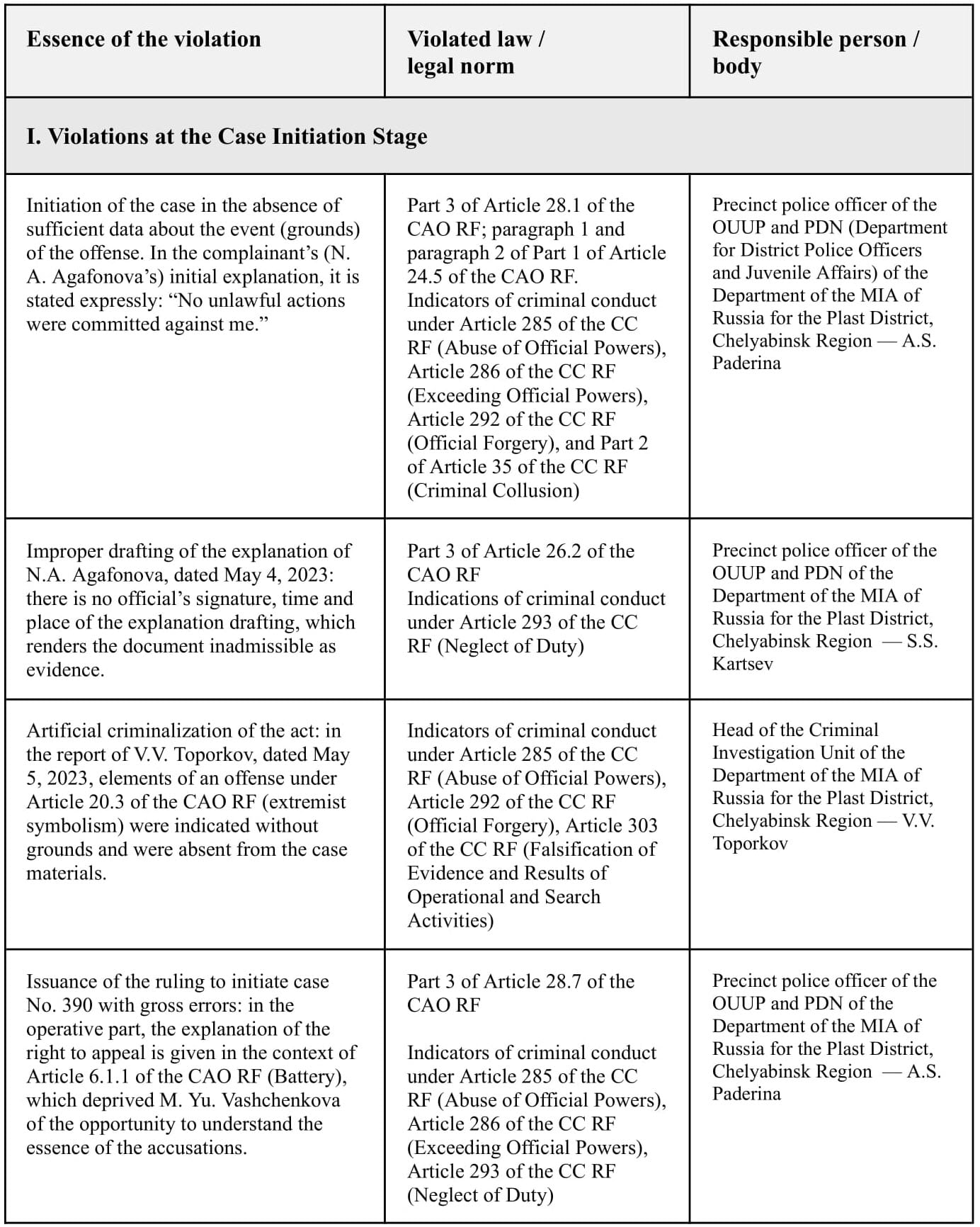
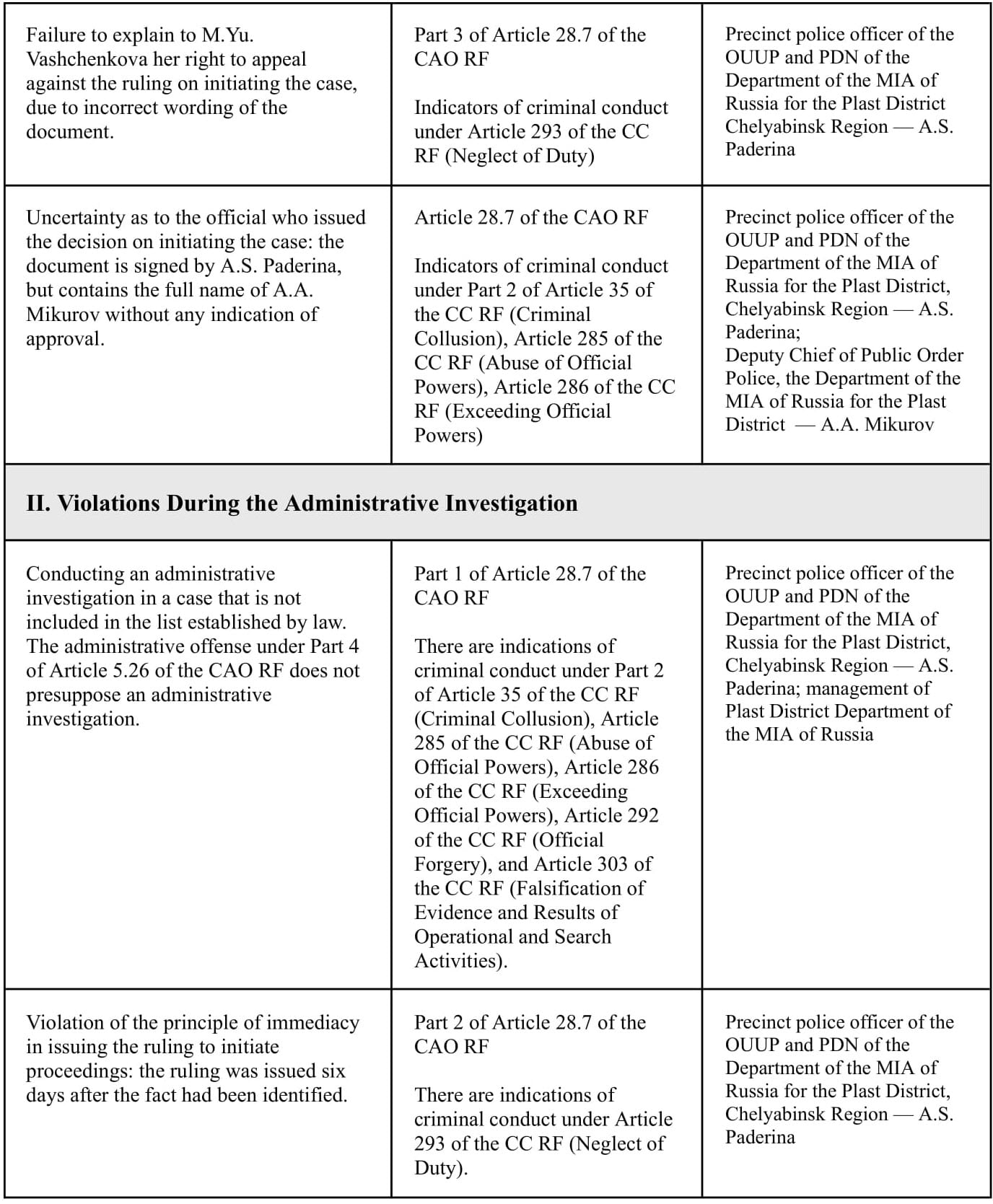
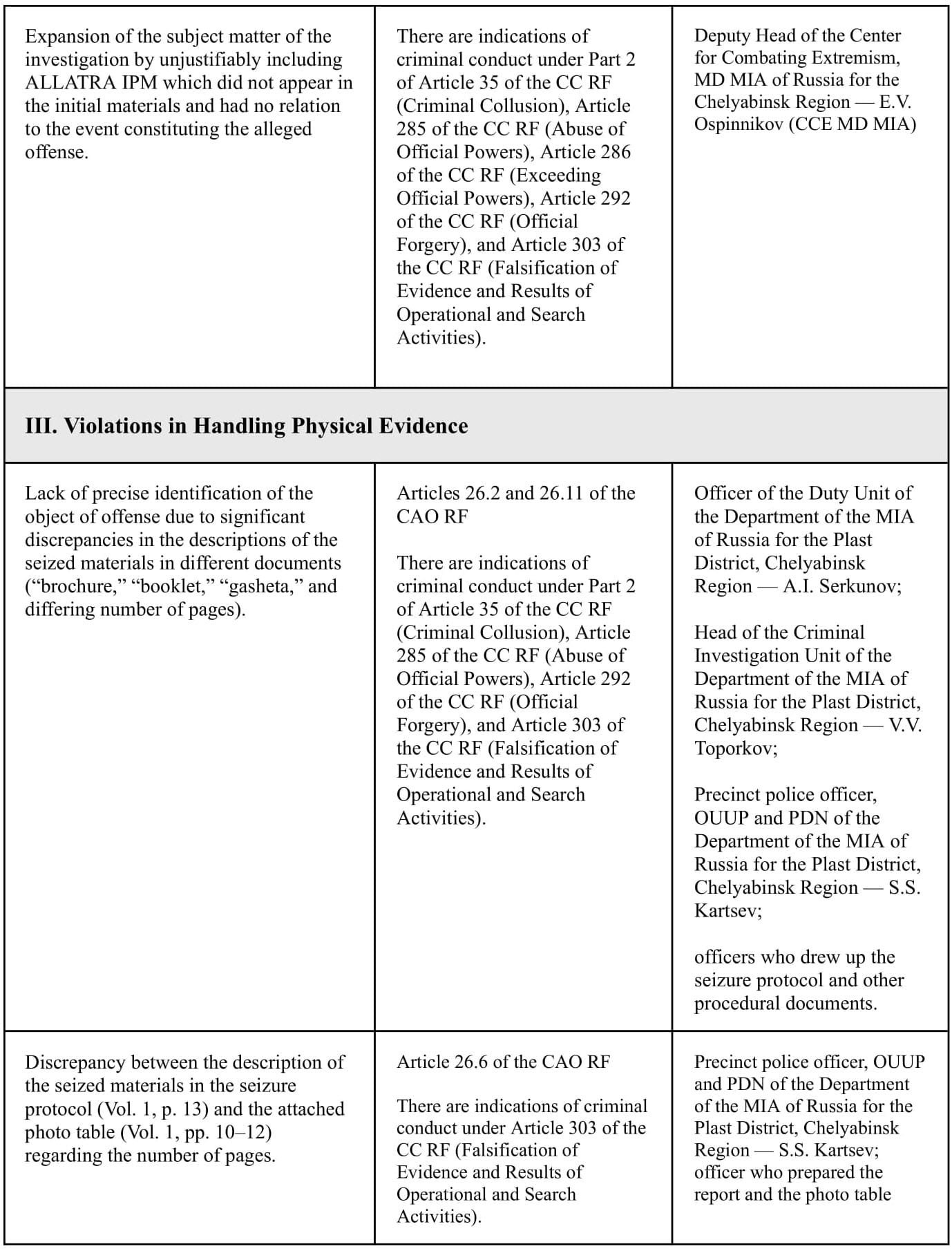
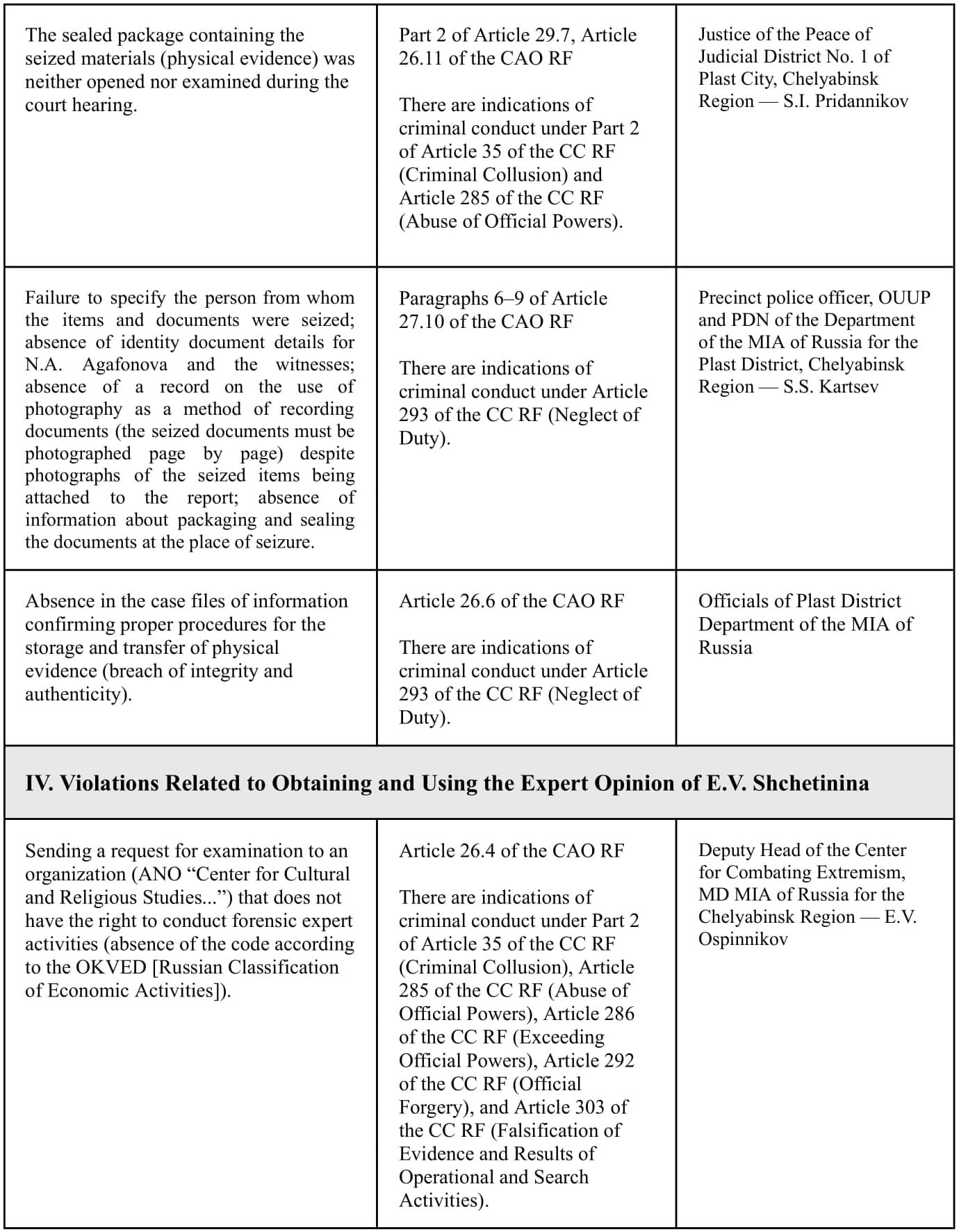
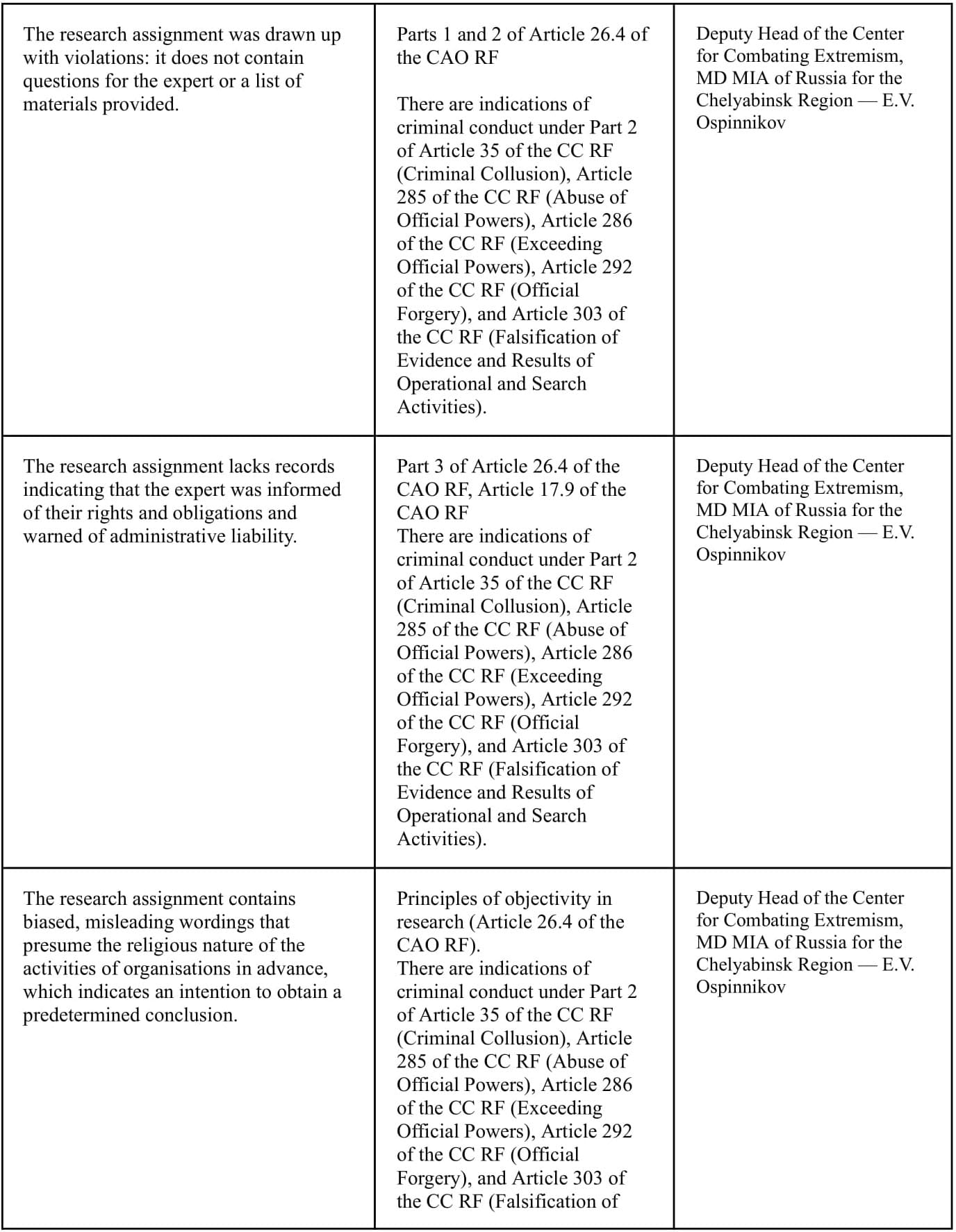
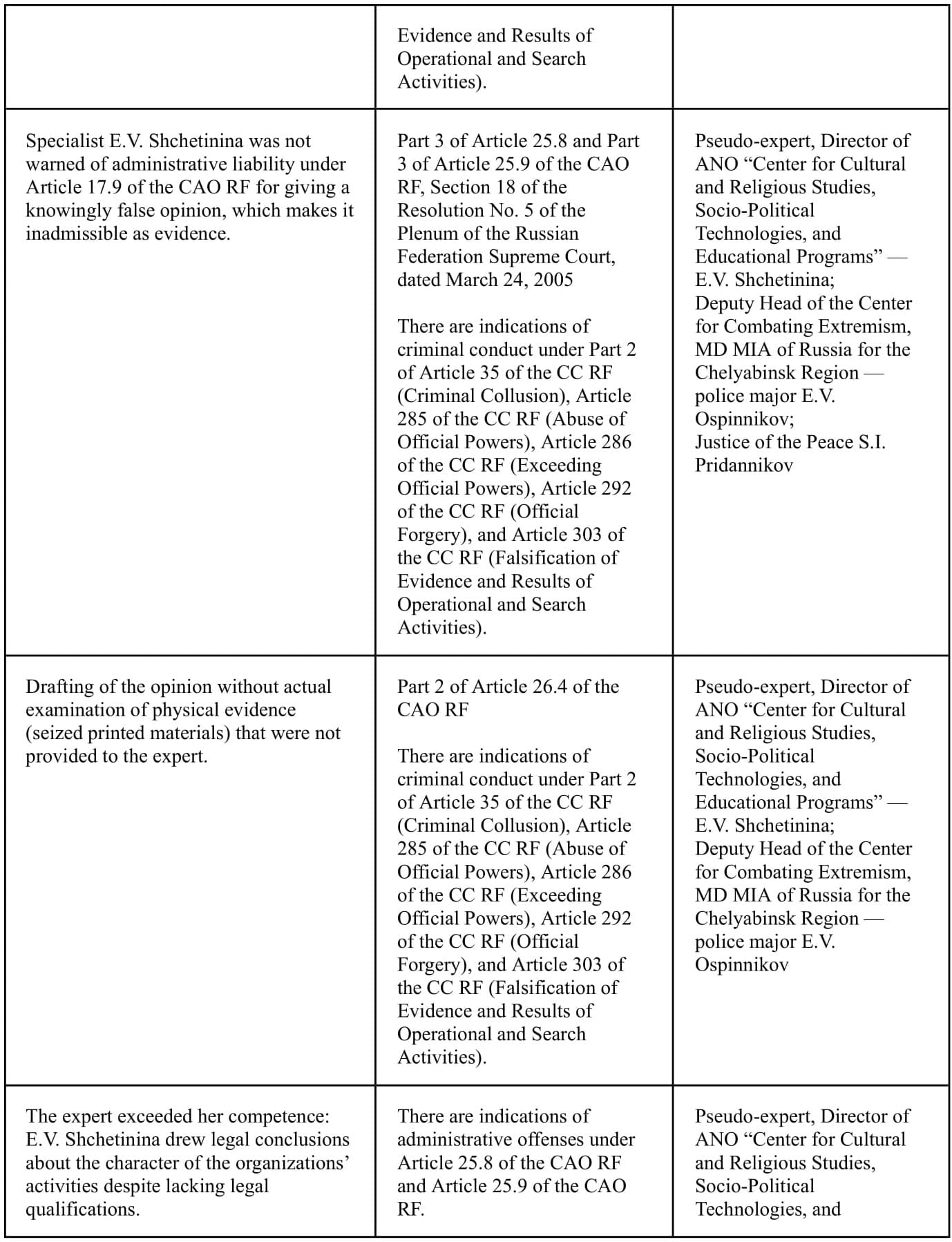
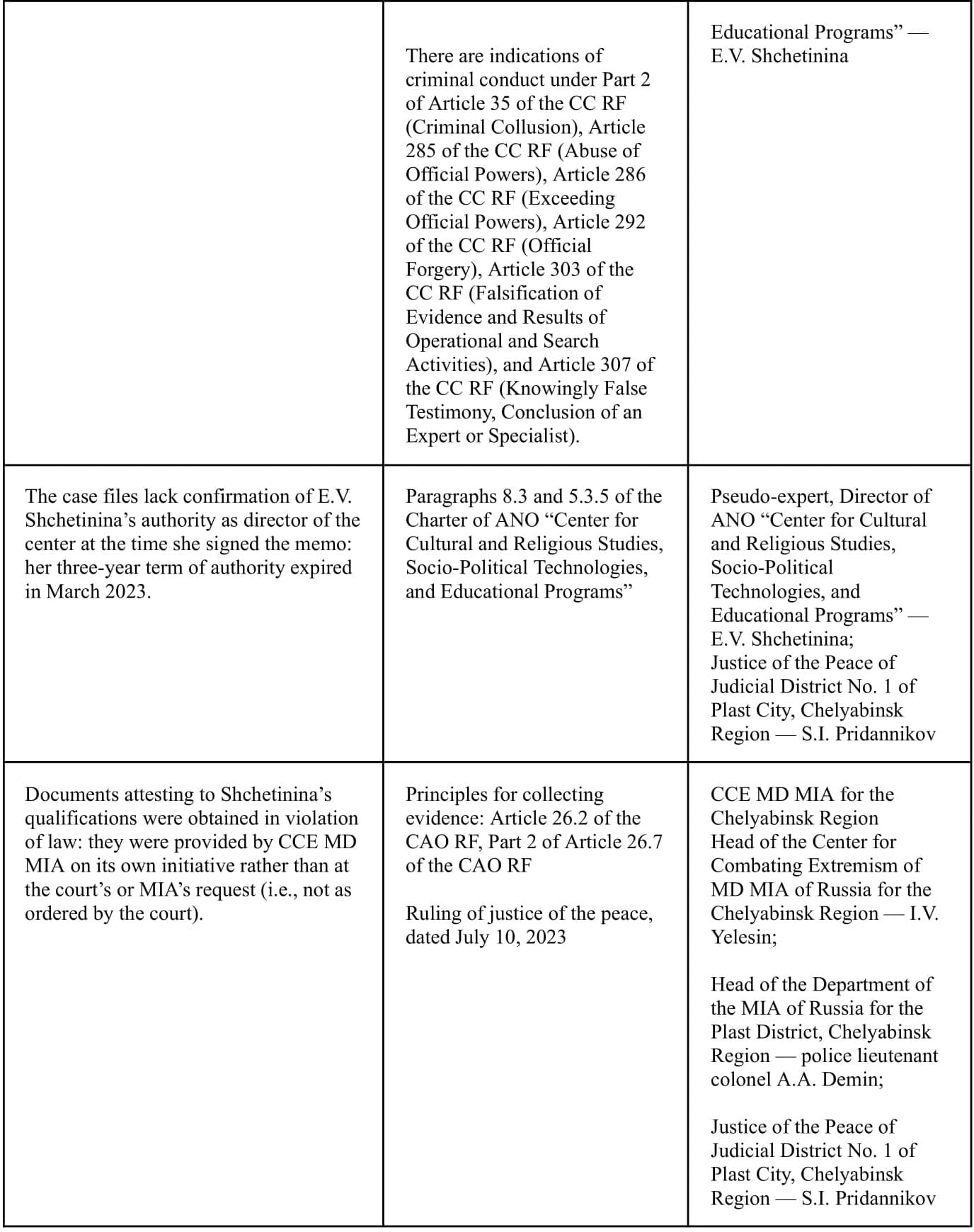
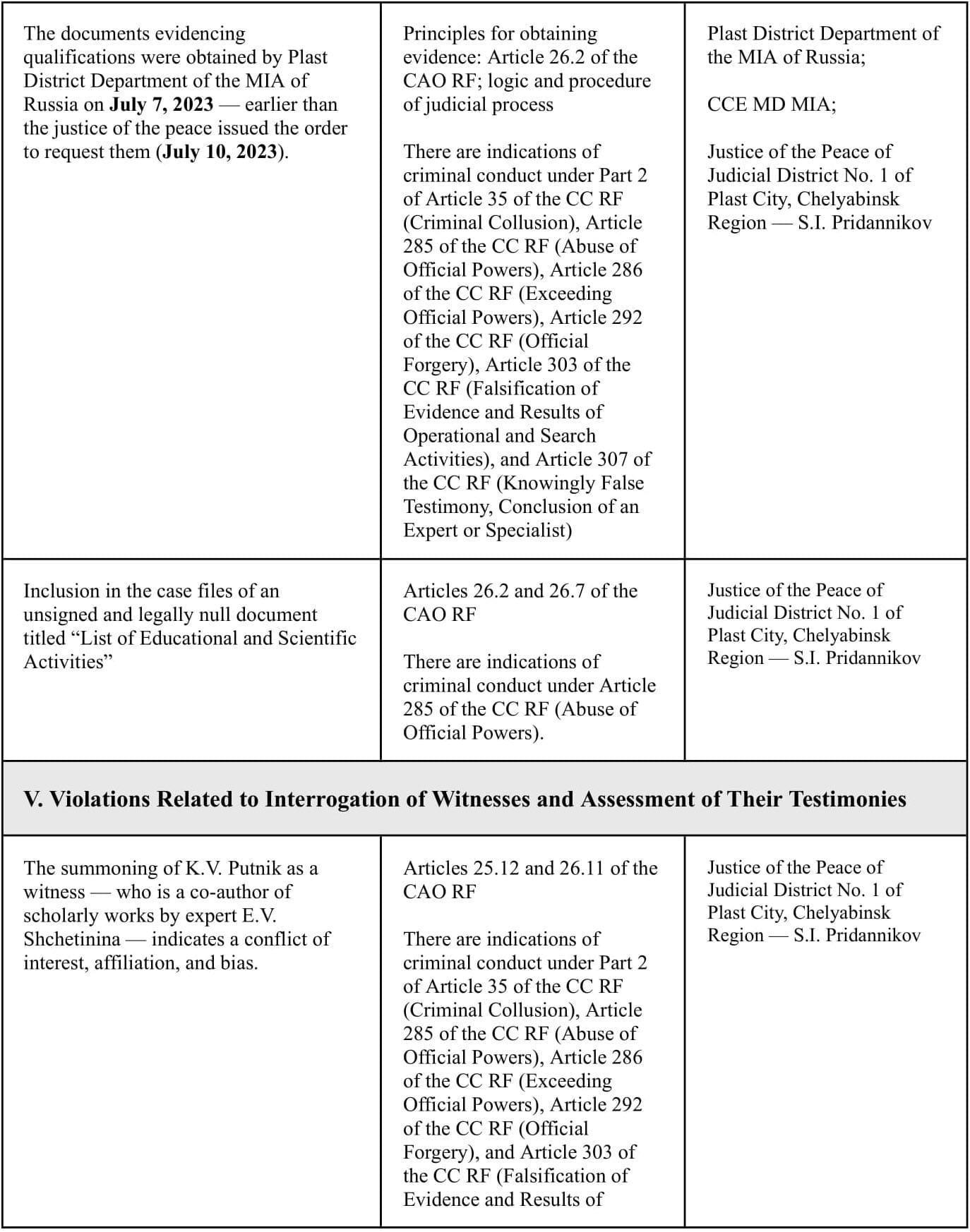
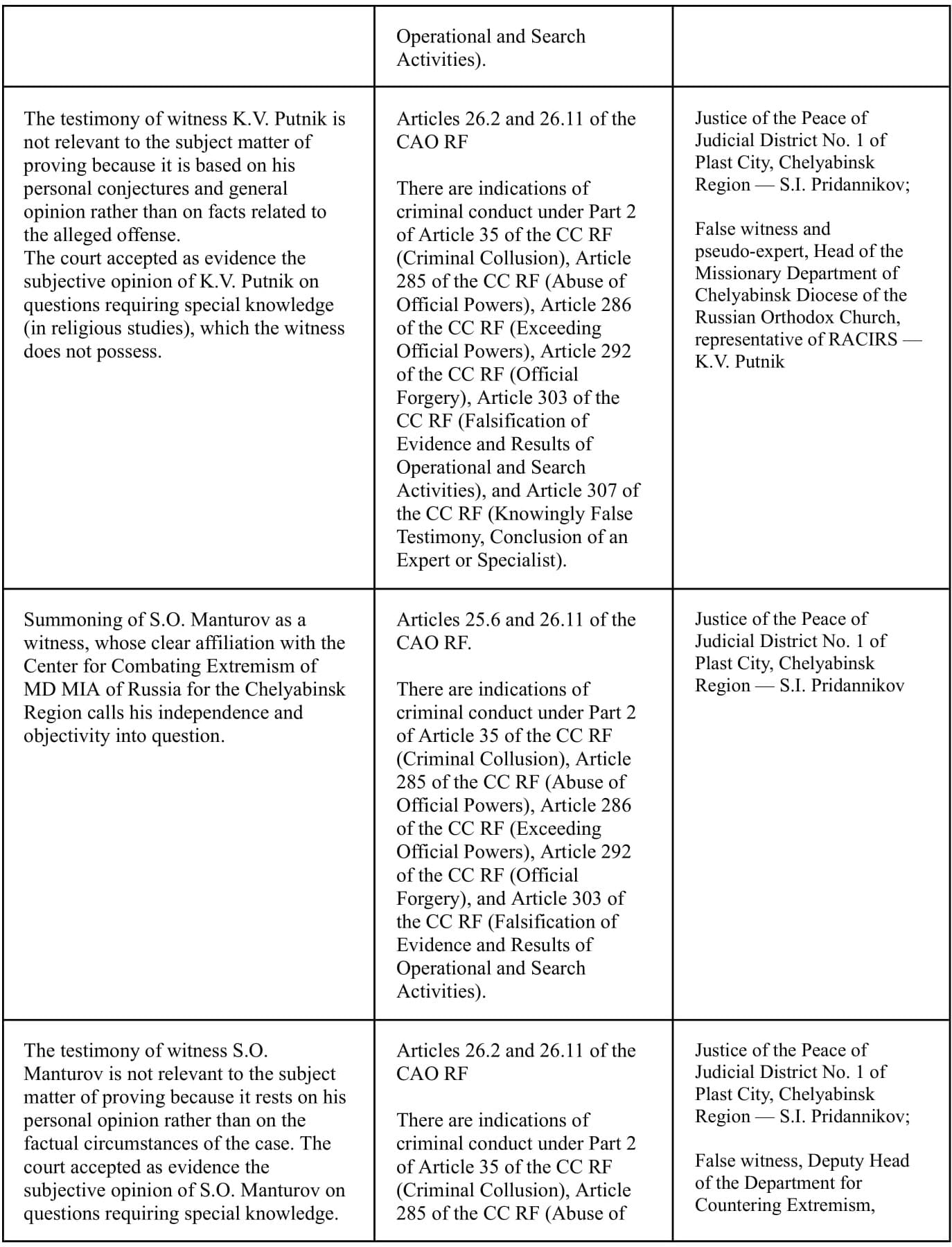
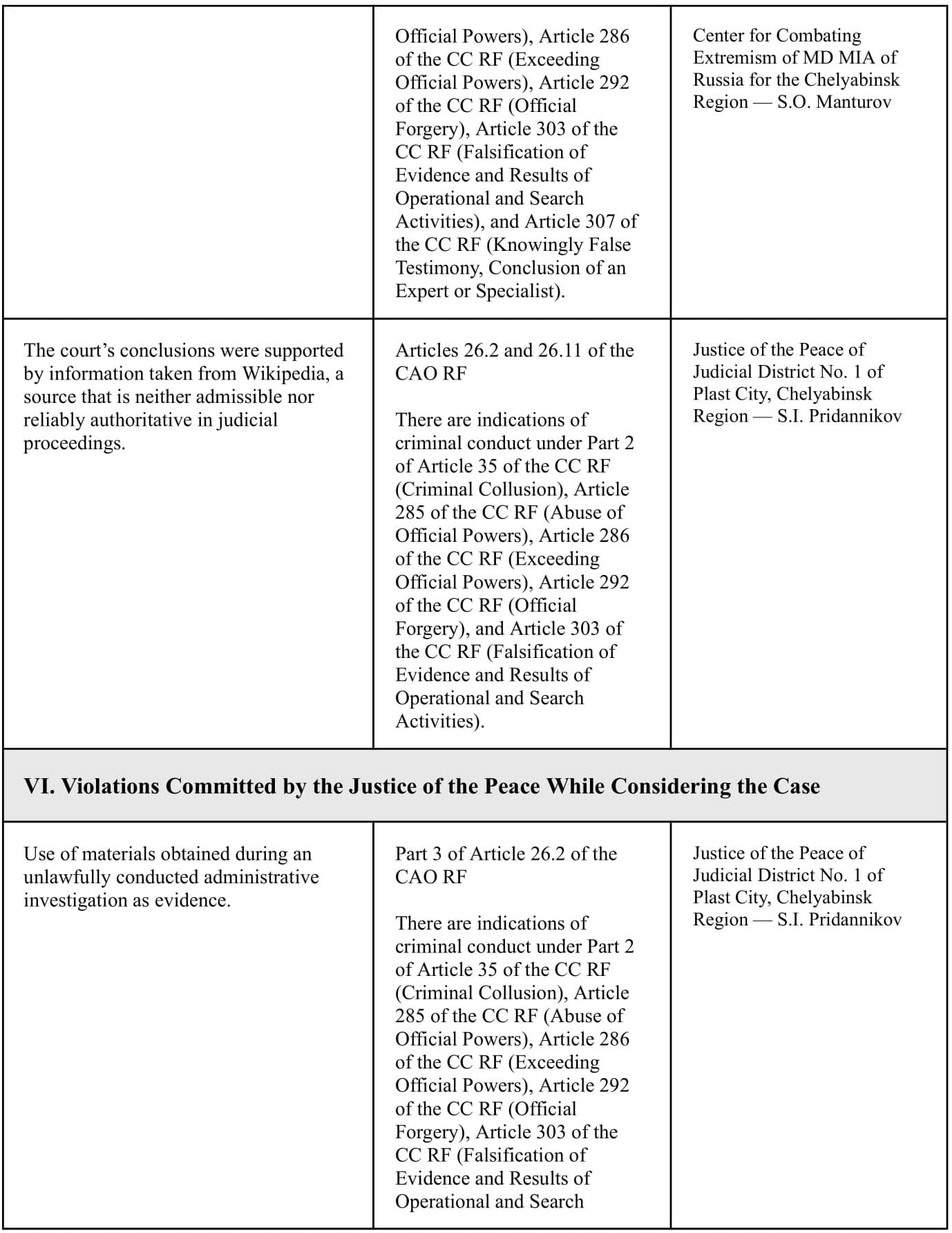
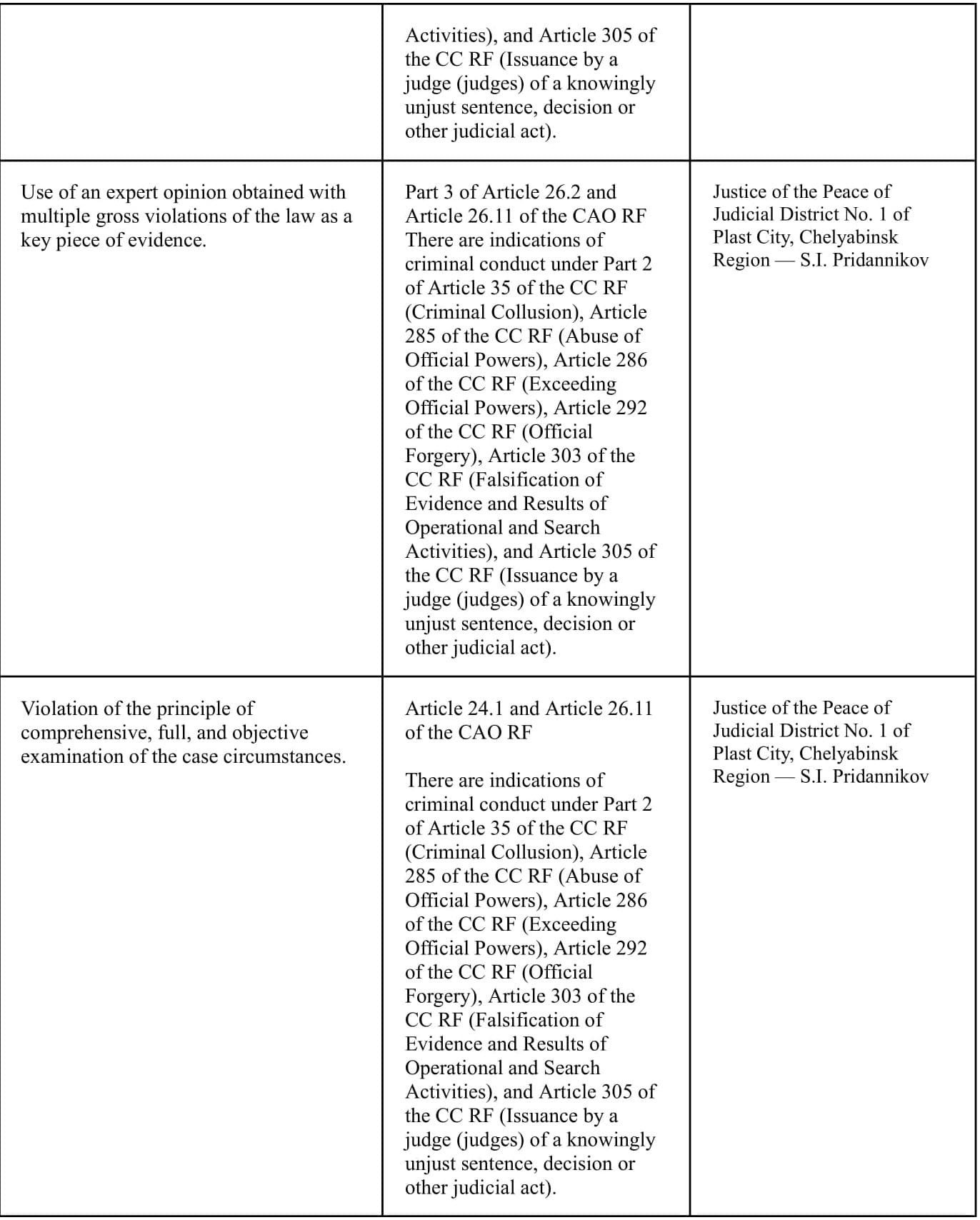
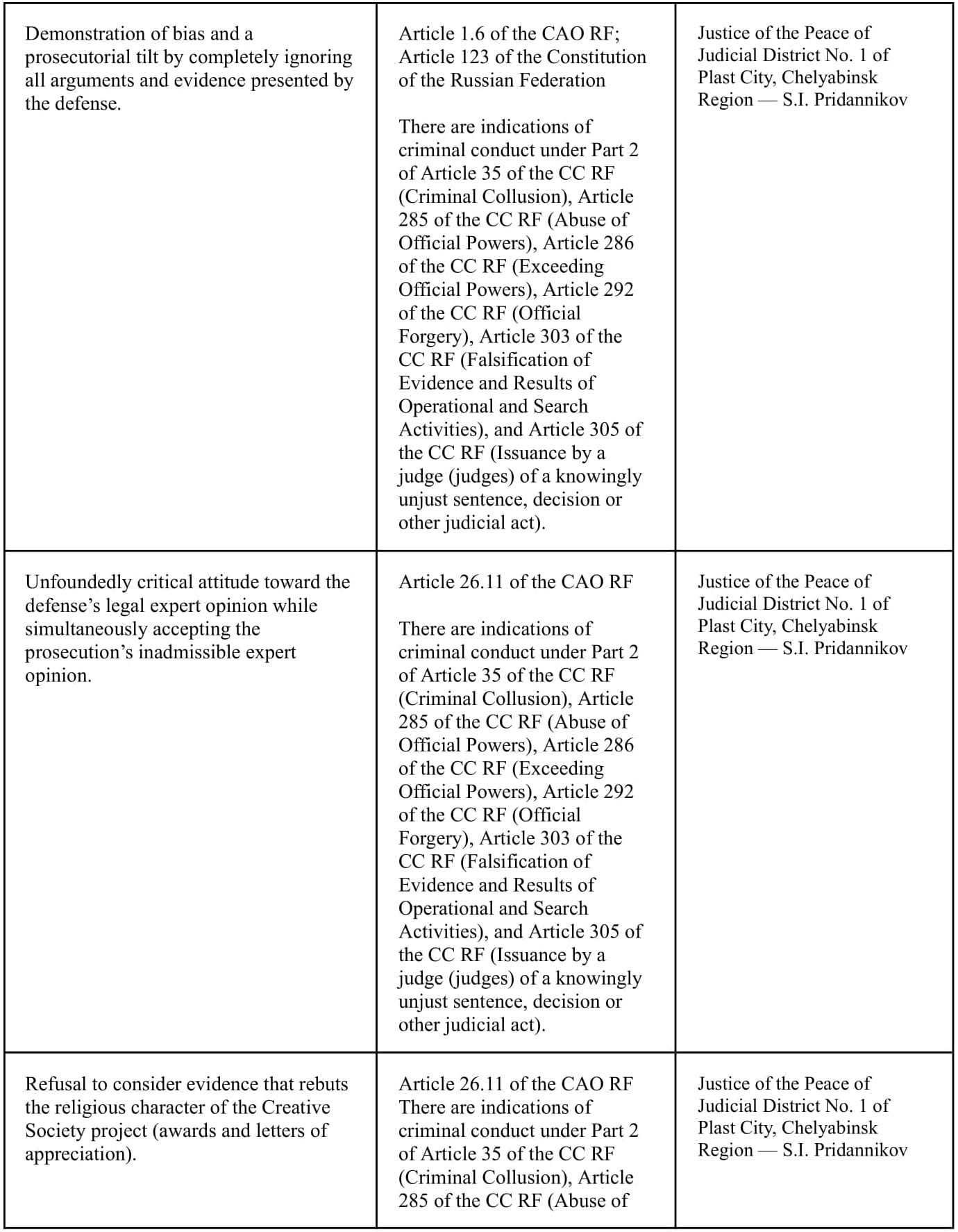
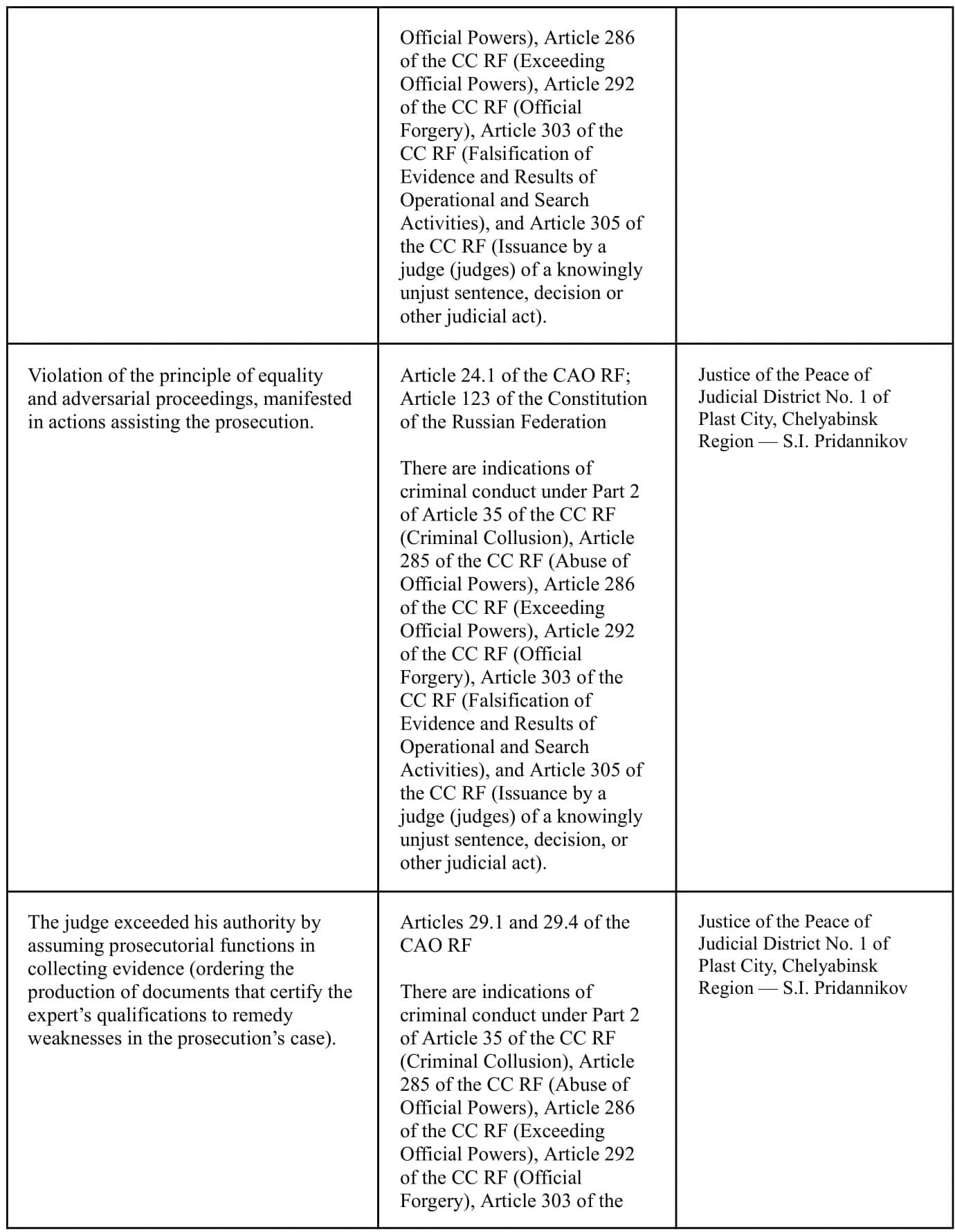
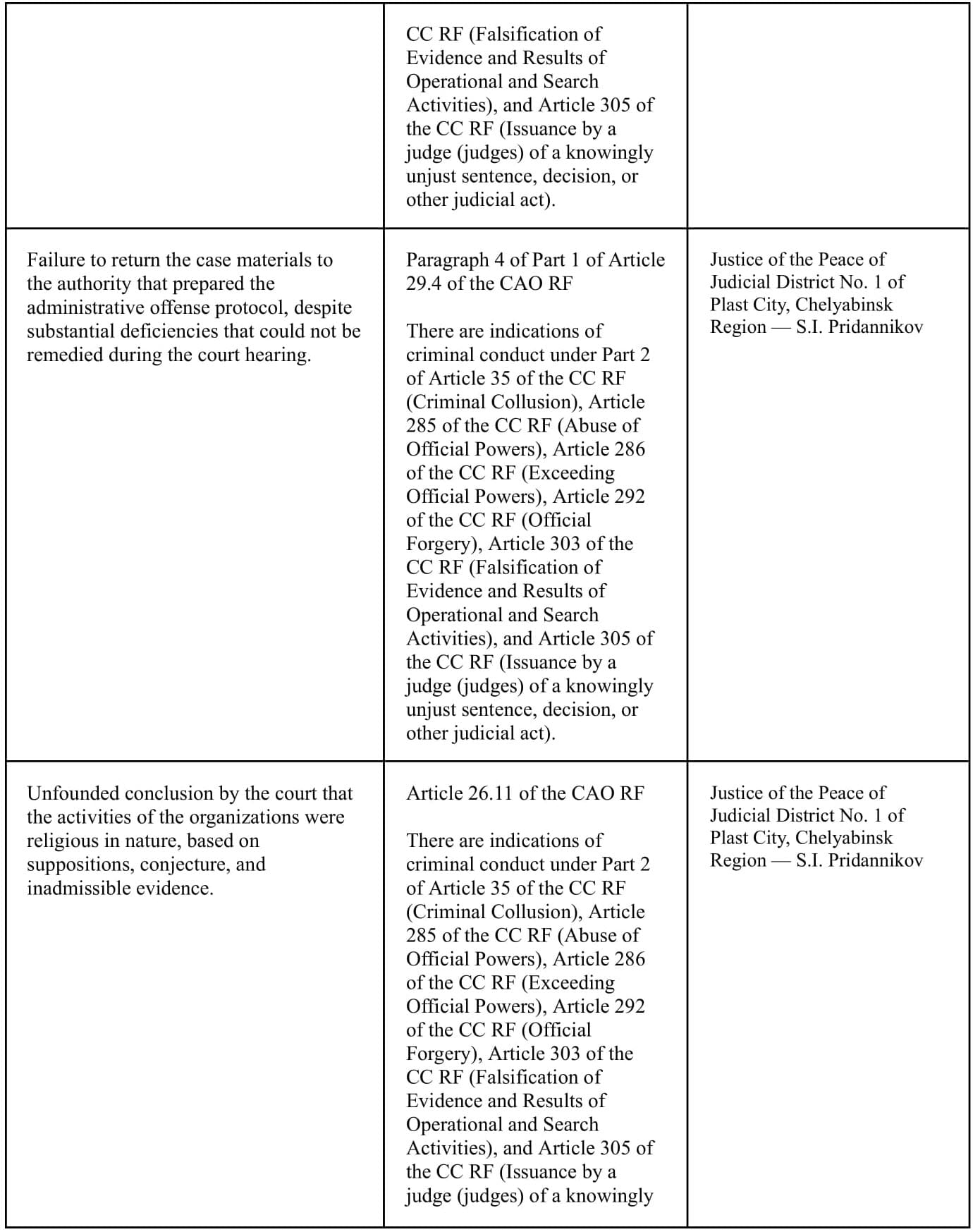
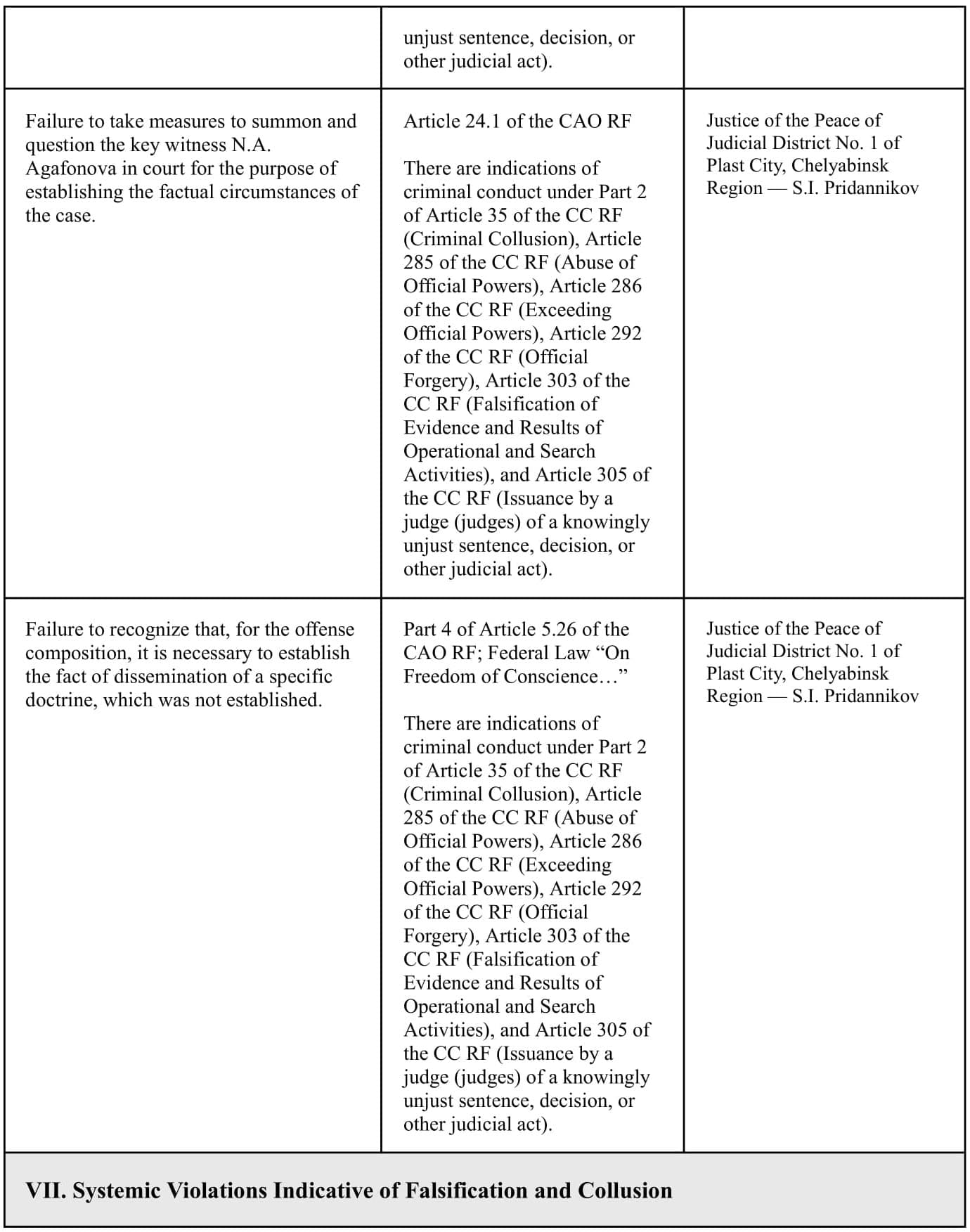
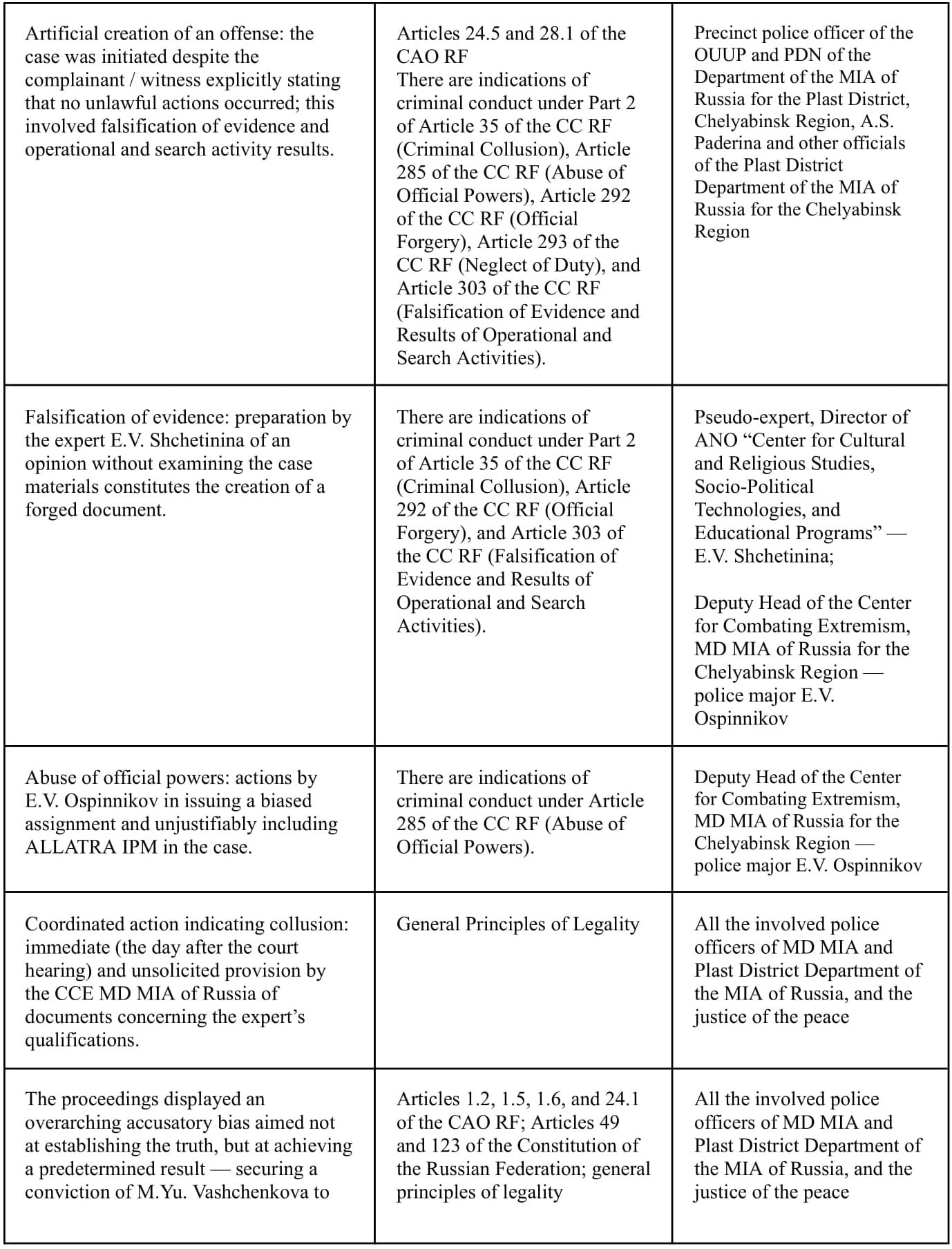
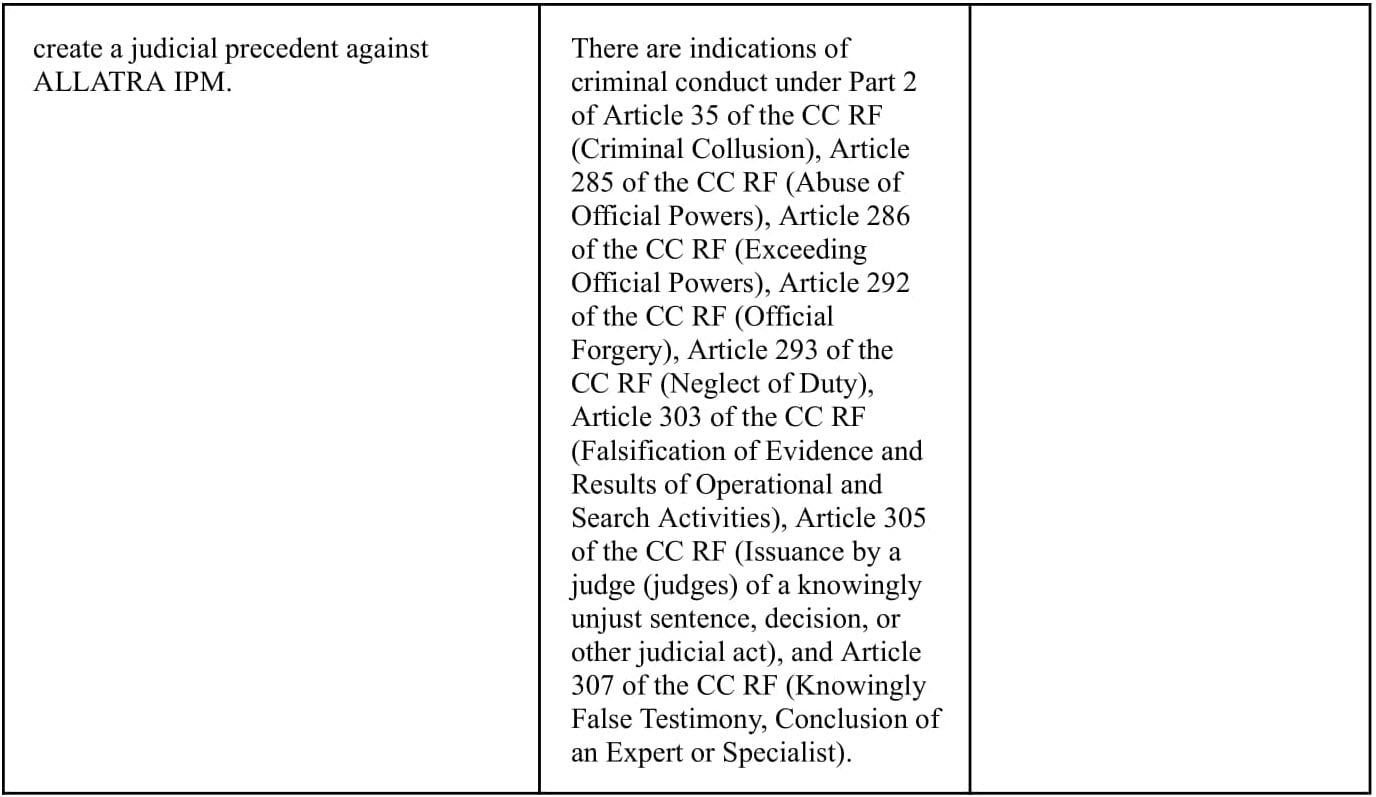
Indications of Prior Criminal Collusion to Falsify Evidence in the Case that Resulted in the Classification of ALLATRA International Public Movement as a Religious Organization
An analysis of the case materials in the administrative offense proceedings initiated against citizen M.Yu. Vashchenkova, who was accused of engaging in illegal missionary activity in the city of Plast, Chelyabinsk Region of the Russian Federation, shows that the prosecution was based on falsified evidence. This evidence was fabricated through coordinated and knowingly unlawful actions by a group of individuals who acted in collusion and with direct criminal intent. The goal of these actions was not to establish the objective truth in the case or to halt the alleged offense, but rather to artificially create formal grounds to classify ALLATRA International Public Movement as a religious organization — paving the way for its subsequent persecution and, ultimately, a ban and designation as extremist. In this context, citizen M.Yu. Vashchenkova was used solely as a formal pretext for triggering the repressive mechanism.
1. Analysis of the Coordinated Actions and Personal Interest of the Conspirators
The case materials reveal the following pattern of criminal collusion:
- Coordinating link: Alexander Dvorkin and the Russian Association of Centers for the Study of Religions and Sects (RACIRS) which he leads serve as initiators and coordinators of a systemic campaign aimed at discrediting and persecuting ALLATRA International Public Movement. This campaign of suppression was personally initiated in the Russian Federation by Dvorkin and was later expanded and propagated through a network of individuals and organizations affiliated with him, including those outside the Russian Federation, such as in Ukraine. All key prosecution witnesses have direct ties to RACIRS and its head, A.L. Dvorkin, which indicates that they have a vested interest in the outcome of the case and that their actions were organizationally motivated and biased in nature.
- Witness No. 1: Konstantin Putnik. The key prosecution witness. He heads the missionary department of the Chelyabinsk diocese of the ROC, which is the official regional unit of RACIRS in Chelyabinsk. In effect, Putnik is a trusted confidant and regional representative of Dvorkin. He regularly collaborates with the FSB of Russia, the Investigative Committee of the Russian Federation, and the Ministry of Internal Affairs (MIA) of the Russian Federation (specifically, the Main Directorate for Combating Extremism). In court, he also stated that S.O. Manturov is his student. The testimony of K.V. Putnik cannot be considered objective, as he is not acting as an independent witness to the alleged offense but rather as a representative of a party with a clear interest in the outcome of the case — one that, for the past eight years, has been initiating and advancing a campaign to discredit ALLATRA International Public Movement.
- Specialist / Expert: Elizaveta Shchetinina. Director of the Autonomous Nonprofit Organization “Center for Cultural and Religious Studies, Socio-Political Technologies, and Educational Programs,” who prepared Memo No. 35 dated May 22, 2023, which was included in the case materials. The document claims that ALLATRA International Public Movement and the international Creative Society project allegedly exhibit characteristics of a religious organization. It has been established that E.V. Shchetinina is a student and academic co-author of K.V. Putnik, the key witness in the case. In addition, E.V. Shchetinina maintains ongoing collaboration with the FSB of Russia, the Investigative Committee of the Russian Federation, and the MIA of the Russian Federation (specifically, the Main Directorate for Combating Extremism). This direct professional and personal dependence disqualifies her as an impartial party. Therefore, her involvement as an “expert” constitutes a gross violation of Articles 25.8 and 25.9 of the CAO RF.
- Witness No. 2: Sergey Manturov. Deputy Head of the Center for Combating Extremism (CCE) of the MD MIA of Russia for the Chelyabinsk Region. It has been established that Konstantin Putnik has repeatedly conducted lectures at the Professional Training Center of the Main Directorate of the MIA of Russia for the Chelyabinsk Region, where staff receive initial and advanced training, including employees of the Center for Combating Extremism, where S.O. Manturov serves. This fact indicates the existence of stable informational and organizational ties between the missionary department headed by K.V. Putnik and regional divisions of the MIA of Russia. It was S.O. Manturov who brought K.V. Putnik to court so he could “say something about Allatra.”
- Scientific Experts. The testimony of S.O. Manturov relies on the work of a number of so-called “scientific experts”: O.A. Griva, D.V. Goryunov, I.S. Bersenev, and A.N. Starostin, whom he directly cites in support of his position. An analysis of open sources reveals that O.A. Griva and D.V. Goryunov are both part of a group affiliated with Alexander Dvorkin. They regularly participate in joint events aimed at combating so-called “sects” and display full ideological and methodological alignment with his approaches.
In particular, open sources show that O.A. Griva, along with A.L. Dvorkin, participated in the international conference “The Church and Its History in Science and Education.” The academic forum was held as part of the Christmas Readings at the State Public Historical Library of Russia. As for D.V. Goryunov, he, together with A.L. Dvorkin, took part in the conference “Totalitarian Sects as a Threat to the Individual, the Family, and the State,” organized by the Pereslavl Diocese of the Russian Orthodox Church with the support of the administration of the city of Pereslavl-Zalessky, as part of the diocesan stage of the 26th International Educational Christmas Readings.
A.N. Starostin, in collaboration with I.S. Bersenev and R.A. Kushnerik, authored pseudo-scientific articles that defame the honor, dignity, and good name of ALLATRA IPM and its participants (I.S. Bersenyev, A.N. Starostin “ALLATRA International Public Movement as a New-Type Religious Movement.” International Cooperation of Eurasian States: Politics, Economics, Law, No. 1, 2023, pp. 47–66; R.A. Kushnerik, A.N. Starostin “The Illusion of ‘Creating’ Peace by AllatRa International Public Movement.” International Cooperation of Eurasian States: Politics, Economics, Law, No. 3, 2023, pp. 48–53).
Griva and Goryunov also authored pseudo-scientific articles defaming the honor, dignity, and good name of ALLATRA IPM and its participants (O.A. Griva “On Illegal Missionary Activity of New Religious Movements (Using the Example of Allatra IPM).” Religion. Society. Human: Academic Anthology, compiled by Yu.V. Normanskaya. Simferopol: IT “Arial,” 2019, p. 157; A.P. Goryunov “The Radicalism of ALLATRA in the Paradigm of Islam.” Scientific Bulletin of the Omsk Academy of the MIA, No. 3 (82), 2021).
As for A.N. Starostin, he is also recruited as an “expert” in other cases initiated against participants of ALLATRA International Public Movement within the Russian Federation. In his pseudo-expert analyses, Starostin repeatedly cites his own pseudo-scientific articles coauthored with I.S. Bersenev, in which they deliberately tarnish the good name of ALLATRA International Public Movement. The pseudo-scientific articles of D.V. Goryunov and A.N. Starostin are frequently published by RACIRS (on the website of the Center for Religious Studies in the Name of Hieromartyr Irenaeus of Lyons). These pseudo-experts regularly cooperate with law enforcement agencies and security services, indicating their involvement in a persistent network of individuals invested in the systematic persecution of the Movement and its members.
Signs of Criminal Collusion Among Officials at Various Stages of the Administrative Proceedings and Their Liability Under the Criminal Code of the Russian Federation
Based on the factual circumstances outlined in the case materials, as well as additional information regarding the relationships between the participants in the process, it can be concluded that, in the course of administrative proceedings No. 3-148/2023 against M.Yu. Vashchenkova, a body of evidence was constructed that bears signs of deliberate falsification.
It has been established that a number of officials from internal affairs agencies, along with involved specialists/experts and witnesses, acted in coordination — within the framework of a single criminal intent aimed at artificially creating (falsifying) evidence to classify the secular organization ALLATRA as a religious one. Assigning a religious status to the Movement was a conscious first step in a broader strategy to shift the campaign of discrediting ALLATRA IPM from the informational domain into the legal domain, with the goal of drawing the Movement into a religious framework controlled by the initiators of the persecution. This, in turn, enabled them to activate administrative resources and legal mechanisms for the systematic persecution of the Movement, with the ultimate goal of banning it in Russia and subsequently forcing its dissolution in Ukraine under the guise of a legitimate legal process.
1. The key participants in this scheme include:
- Officials: S.O. Manturov (Deputy Head of the Center for Combating Extremism, MD MIA), E.V. Ospinnikov (officer of the Center for Combating Extremism, MD MIA).
- Involved parties: E.V. Shchetinina (director of the ANO, specialist/expert), K.V. Putnik (witness).
- Ideologically affiliated individuals: A.L. Dvorkin (head of RACIRS), O.A. Griva, D.V. Goryunov, A.N. Starostin (authors of works used as the basis for the accusation).
The actions of these individuals form a closed chain, in which each subsequent participant relies on knowingly false or biased information provided by the previous one. This pattern indicates the presence of prior collusion.
2. Legal qualification of the actions of officials (S.O. Manturov and E.V. Ospinnikov)
The actions of S.O. Manturov, Deputy Head of the Center for Combating Extremism of the MD MIA of Russia, Chelyabinsk Region, and E.V. Ospinnikov, an officer of the same Center, must be assessed for the presence of criminal elements under Articles 35, 285, 286, and 303 of the Criminal Code of the Russian Federation.
2.1. Abuse of official powers (Article 285 of the Criminal Code of the Russian Federation)
- Objective element: The use by officials of their official powers (the right to issue requests, conduct investigations, and participate in proceedings) in a manner contrary to the interests of service. The interests of service require objectivity and adherence to the law, whereas the actions of S.O. Manturov and E.V. Ospinnikov were aimed at achieving a predetermined, unlawful outcome.
- Subjective element: Intent (direct or indirect) and the presence of other personal interest. This interest is reflected in their desire to appease certain ideological groups (RACIRS) and its hierarchical leader (A.L. Dvorkin) and to follow the plan of the collusion.
- Consequences: Significant violations of the rights and legal interests of citizen M.Yu. Vashchenkova (unlawful prosecution) and the ALLATRA organization (discreditation and the creation of an artificial basis for further unlawful persecution using the tools of state power and law enforcement structures).
2.2. Exceeding official powers (Article 286 of the Criminal Code of the Russian Federation)
- Objective element: The commission of actions that clearly exceed the scope of official authority. In particular, E.V. Ospinnikov, by sending a request to the specialist E.V. Shchetinina, effectively and unilaterally appointed an expert examination, despite not having the case under his jurisdiction or receiving such an assignment. Moreover, he included a reference to ALLATRA IPM in the request, even though it was not present in the original case materials. This action exceeded the limits of verifying a specific fact and constituted an artificial expansion of the scope of evidence.
- Subjective element: Direct intent. The official knowingly acted outside the bounds of his competence and the materials provided.
- Aggravating factor: The actions were committed by a group of persons in prior collusion (subparagraph “a,” Part 3, Article 286 of the Criminal Code of the Russian Federation), and possibly out of other personal interest (subparagraph “e,” Part 3, Article 286 of the Criminal Code of the Russian Federation).
2.3. Falsification of evidence (Article 303 of the Criminal Code of the Russian Federation)
- Crime element: Falsification of evidence in an administrative offense case (Part 1, Article 303 of the Criminal Code of the Russian Federation).
- Actions: S.O. Manturov and E.V. Ospinnikov deliberately introduced falsified evidence into the case materials, specifically Memo No. 35 dated May 22, 2023, signed by E.V. Shchetinina. They were aware of its biased and unsubstantiated nature (it was prepared in one day — the same day the request for expert examination was received — without reviewing any case materials, and by an affiliated individual), yet they used it to support the accusation.
3. Legal qualification of the actions of private individuals (E.V. Shchetinina and K.V. Putnik)
The actions of the specialist E.V. Shchetinina and witness K.V. Putnik, who were involved in the case, contain elements of the crime defined in Article 307 of the Criminal Code of the Russian Federation.
- E.V. Shchetinina (specialist/expert): By signing and submitting Memo No. 35, which was not the result of an objective examination but rather formalized a pre-determined conclusion, she committed acts falling under Part 1 of Article 307 of the Criminal Code of the Russian Federation — Knowingly False Testimony, Opinion of an Expert or Specialist. The knowing falsity is confirmed by the short time taken to prepare the memorandum and her professional affiliation with the key witness, K.V. Putnik.
- K.V. Putnik (witness): When questioned as a witness, he did not testify to the facts of the case — which he did not witness — but rather expressed the ideological position of RACIRS aimed at accusing the ALLATRA Movement. Such testimony is knowingly false within the meaning of Part 1 of Article 307 of the Criminal Code of the Russian Federation, as a witness is obligated to present factual information to the court—not personal opinions, evaluations, or ideological positions.
4. Analysis of the actions of a group acting in prior collusion
The body of facts points to the existence of a stable group of individuals who acted in prior collusion (Part 2, Article 35 of the Criminal Code of the Russian Federation), with clearly defined roles:
- Organizer (Part 3, Article 33 of the Criminal Code of the Russian Federation): A.L. Dvorkin, as head of RACIRS, exercised ideological leadership and coordinated the actions of individuals affiliated with him (K.V. Putnik, O.A. Griva, D.V. Goryunov), developing a general strategy for discrediting ALLATRA IPM and its partner project, the Creative Society.
- Perpetrators (Part 2, Article 33 of the Criminal Code of the Russian Federation):
- S.O. Manturov and E.V. Ospinnikov directly committed crimes by abusing their official positions (Articles 303, 285, and 286 of the Criminal Code of the Russian Federation).
- E.V. Shchetinina and K.V. Putnik directly committed crimes by submitting false expert conclusions and witness statements (Article 307 of the Criminal Code of the Russian Federation).
- Informational Cover: The works of O.A. Griva, D.V. Goryunov, and A.N. Starostin — also part of Dvorkin’s affiliated network — were used by S.O. Manturov as a supposed “expert” basis to legitimize a biased stance, which constitutes part of the shared criminal intent.
Based on the conducted analysis, the actions of the listed individuals, considering their specific roles and participation in organizing and conducting these legal proceedings, show signs of the following offenses under the Criminal Code of the Russian Federation:
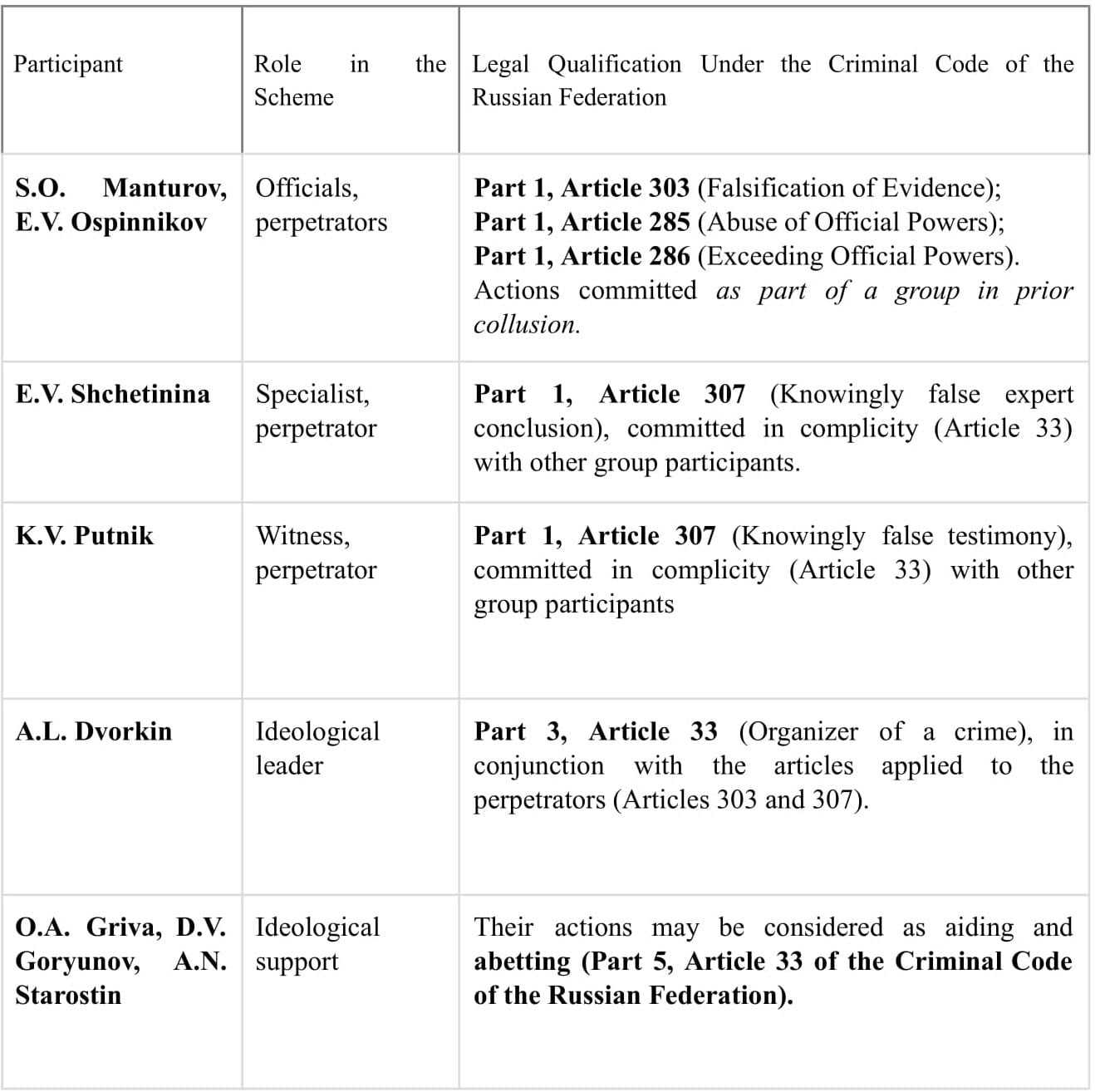
Thus, the coordinated and interrelated actions of the aforementioned group of individuals do not indicate isolated errors or separate violations, but rather deliberate activity aimed at falsifying evidence — activity that exhibits characteristics of a series of intentional crimes against justice.
The fact that all witnesses and the so-called “experts” involved in the case are in a stable network of connections, adhere to the same accusatory position, and act out of personal interest rather than in the interest of the law, was obvious and should have been subject to legal assessment by the court. The court’s deliberate disregard of these circumstances points to the possible coordination of its actions with this group. In situations where a judge effectively ignores signs of criminal collusion and relies on knowingly falsified and inadmissible evidence, the judge becomes a participant in that collusion, acting with shared intent: the fabrication of charges and the unlawful prosecution of individuals. This indicates the presence of an organized group that includes both representatives of the prosecution and the judge, acting in concert and in violation of the law.
On the Systemic Social and Legal Danger Posed by the Activities of the RACIRS Network in the Russian Federation and Beyond
The falsification of evidence and the coordinated abuse of authority by officials and affiliated “experts” operating within a stable criminal collusion and acting in the interests of RACIRS in the present case point to the operation of an organized mechanism for targeted legal persecution. This is not merely about the fabrication of a case against the ALLATRA Movement, but rather the implementation of a well-rehearsed scheme: first, the organization is labeled “religious,” accompanied by accusations of “illegal missionary activity” against its members; next, grounds are created for subsequently designating it as “extremist.”
This approach has already been employed by RACIRS against other independent associations and represents yet another link in a chain of repressive practices, in which the law is used as a tool for forcibly eliminating dissenting initiatives. In such cases, the investigative and judicial procedures — having been set in motion through prior collusion — cease to serve the function of protecting rights and instead operate as components of a single repressive scenario, initiated and orchestrated by an interested group of individuals.
The refinement of this mechanism makes it applicable to any independent entity, regardless of its actual activities or legal status. It is sufficient to fabricate evidence, obtain testimony from affiliated “experts,” and secure the court’s loyalty by invoking the authority of law enforcement or security agencies — then any civic or educational organization can be successively designated as religious, then as violating missionary law, and ultimately as extremist or even terrorist. This demonstrates the complete arbitrariness of law enforcement, where legal categories are replaced by political and ideological expediency, and protection from repression becomes fundamentally unattainable.
The activities of a structured criminal community led by RACIRS, incorporated into state mechanisms, are leading to the irreversible erosion of the rule of law. This demonstrates the state's inability to protect the rights and freedoms of its citizens and creates critical conditions for the usurpation of power by organized groups capable of manipulating law enforcement and judicial systems for their criminal purposes.
Such a merging of the interests of a private association with the state apparatus constitutes a form of institutional decay of the legal system, violating the principle of separation of powers and undermining the foundations of constitutional order. Given the ideological methods employed by RACIRS and by A.L. Dvorkin personally are rooted in the Nazi practices of the 20th century — including approaches used by Nazi ideologist Walter Künneth and his followers — a new type of threat is emerging: hybrid in form, totalitarian in essence, yet outwardly legitimized through legal mechanisms.
A direct threat to international security is posed by the fact that such a system is being implemented in a state with significant military, economic, and technological resources, including nuclear weapons. This generates not only a domestic, but also a transnational threat to human rights, freedom of association, and the very foundation of international legal stability.
Particularly concerning is the international nature of this anti-cult network. It has been established that individuals acting in the interests of A.L. Dvorkin are carrying out similar activities in other countries, including democratic jurisdictions. This indicates the existence of a transboundary threat, in which mechanisms of legal persecution can be exported and applied against civil society in other states. Thus, a new model of totalitarian influence is taking shape, disguised as religious studies or expert activity, but with the subversive aim of discrediting, dismantling, and banning independent public movements. This poses a threat to the rule of law and institutions of democracy on a global scale.
- The next part will provide a legal analysis of the hearing of this administrative offense case in the courts of appeal and cassation.
To be continued…
